Greeks antiquities Stock Photos and Images
 Manual of Egyptian archæology and guide to the study of antiquities in EgyptFor the use of students and travellers . ned, such as beneath thetemple porticoes and in the antechambers of tombs,the colouring is soft and subdued. Painting in Egyptwas only the humble handmaid of architecture andsculpture. To compare it with our own, or even witlithat of the Greeks, is not to be thought of, but if weaccept it for what it is in the secondary positionassigned to it, we must admit that it possesses someunusual merits. It excelled for large decorativeschemes, and if the fashion of painting our mansionsa Stock Photohttps://www.alamy.com/image-license-details/?v=1https://www.alamy.com/manual-of-egyptian-archology-and-guide-to-the-study-of-antiquities-in-egyptfor-the-use-of-students-and-travellers-ned-such-as-beneath-thetemple-porticoes-and-in-the-antechambers-of-tombsthe-colouring-is-soft-and-subdued-painting-in-egyptwas-only-the-humble-handmaid-of-architecture-andsculpture-to-compare-it-with-our-own-or-even-witlithat-of-the-greeks-is-not-to-be-thought-of-but-if-weaccept-it-for-what-it-is-in-the-secondary-positionassigned-to-it-we-must-admit-that-it-possesses-someunusual-merits-it-excelled-for-large-decorativeschemes-and-if-the-fashion-of-painting-our-mansionsa-image343346336.html
Manual of Egyptian archæology and guide to the study of antiquities in EgyptFor the use of students and travellers . ned, such as beneath thetemple porticoes and in the antechambers of tombs,the colouring is soft and subdued. Painting in Egyptwas only the humble handmaid of architecture andsculpture. To compare it with our own, or even witlithat of the Greeks, is not to be thought of, but if weaccept it for what it is in the secondary positionassigned to it, we must admit that it possesses someunusual merits. It excelled for large decorativeschemes, and if the fashion of painting our mansionsa Stock Photohttps://www.alamy.com/image-license-details/?v=1https://www.alamy.com/manual-of-egyptian-archology-and-guide-to-the-study-of-antiquities-in-egyptfor-the-use-of-students-and-travellers-ned-such-as-beneath-thetemple-porticoes-and-in-the-antechambers-of-tombsthe-colouring-is-soft-and-subdued-painting-in-egyptwas-only-the-humble-handmaid-of-architecture-andsculpture-to-compare-it-with-our-own-or-even-witlithat-of-the-greeks-is-not-to-be-thought-of-but-if-weaccept-it-for-what-it-is-in-the-secondary-positionassigned-to-it-we-must-admit-that-it-possesses-someunusual-merits-it-excelled-for-large-decorativeschemes-and-if-the-fashion-of-painting-our-mansionsa-image343346336.htmlRM2AXGNN4–Manual of Egyptian archæology and guide to the study of antiquities in EgyptFor the use of students and travellers . ned, such as beneath thetemple porticoes and in the antechambers of tombs,the colouring is soft and subdued. Painting in Egyptwas only the humble handmaid of architecture andsculpture. To compare it with our own, or even witlithat of the Greeks, is not to be thought of, but if weaccept it for what it is in the secondary positionassigned to it, we must admit that it possesses someunusual merits. It excelled for large decorativeschemes, and if the fashion of painting our mansionsa
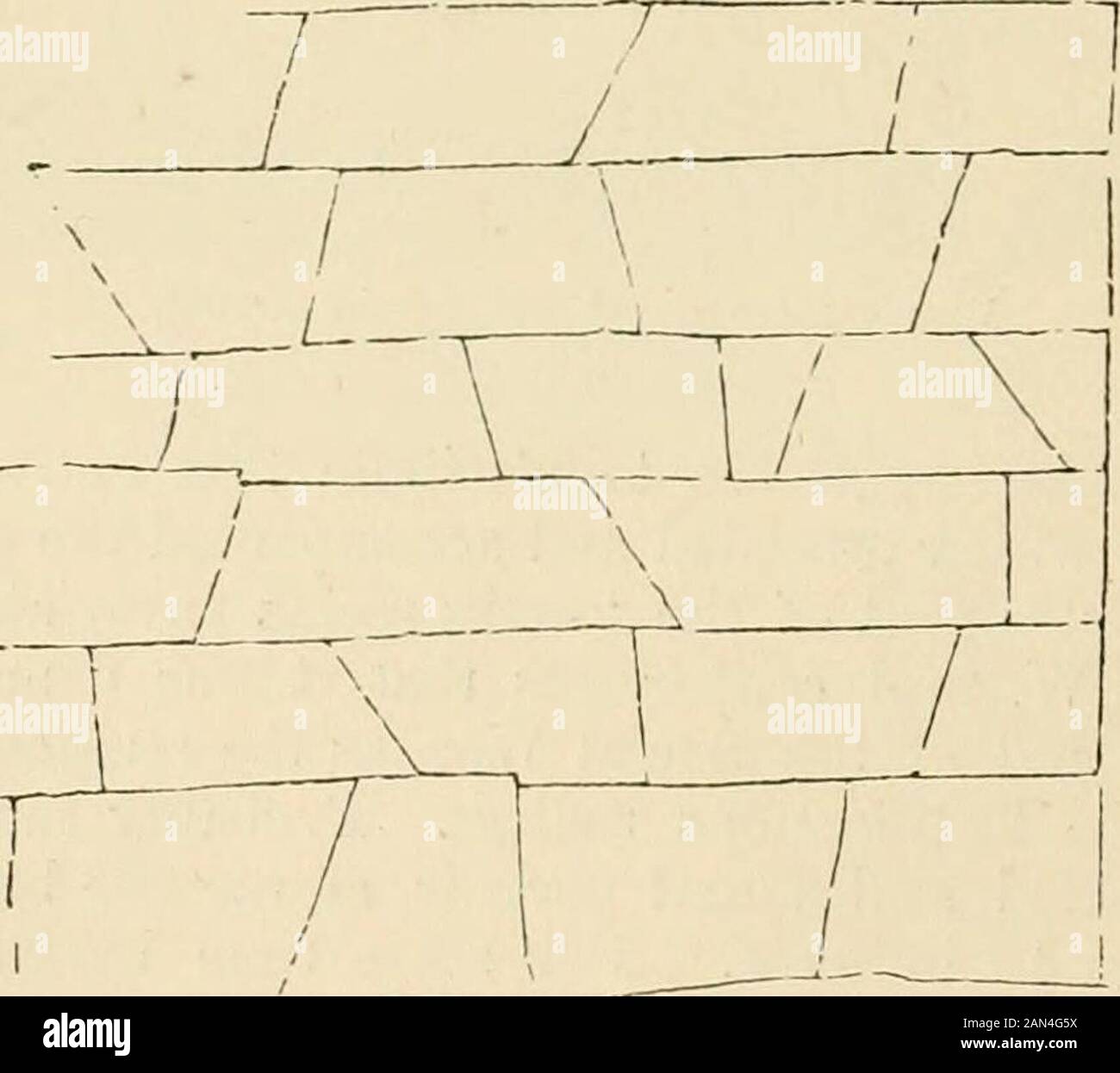 Pompeii, its history, buildings, and antiquities : an account of the destruction of the city with a full description of the remains, and of the recent excavations, and also an itinerary for visitors . Masonry of Pompeii. Isoctamorj, or regular masonry of theGreeks. modern than that of the lower part; being composed of theisodomon, or regular masonry of the Greeks, above the moreancient basis. Some portions, however, of the upper wallconsist, as we have already observed, of masonry of that. Greek wall, similar in construction to the walls of Pompeii. kind called by the ancients opus incertum, c Stock Photohttps://www.alamy.com/image-license-details/?v=1https://www.alamy.com/pompeii-its-history-buildings-and-antiquities-an-account-of-the-destruction-of-the-city-with-a-full-description-of-the-remains-and-of-the-recent-excavations-and-also-an-itinerary-for-visitors-masonry-of-pompeii-isoctamorj-or-regular-masonry-of-thegreeks-modern-than-that-of-the-lower-part-being-composed-of-theisodomon-or-regular-masonry-of-the-greeks-above-the-moreancient-basis-some-portions-however-of-the-upper-wallconsist-as-we-have-already-observed-of-masonry-of-that-greek-wall-similar-in-construction-to-the-walls-of-pompeii-kind-called-by-the-ancients-opus-incertum-c-image340005286.html
Pompeii, its history, buildings, and antiquities : an account of the destruction of the city with a full description of the remains, and of the recent excavations, and also an itinerary for visitors . Masonry of Pompeii. Isoctamorj, or regular masonry of theGreeks. modern than that of the lower part; being composed of theisodomon, or regular masonry of the Greeks, above the moreancient basis. Some portions, however, of the upper wallconsist, as we have already observed, of masonry of that. Greek wall, similar in construction to the walls of Pompeii. kind called by the ancients opus incertum, c Stock Photohttps://www.alamy.com/image-license-details/?v=1https://www.alamy.com/pompeii-its-history-buildings-and-antiquities-an-account-of-the-destruction-of-the-city-with-a-full-description-of-the-remains-and-of-the-recent-excavations-and-also-an-itinerary-for-visitors-masonry-of-pompeii-isoctamorj-or-regular-masonry-of-thegreeks-modern-than-that-of-the-lower-part-being-composed-of-theisodomon-or-regular-masonry-of-the-greeks-above-the-moreancient-basis-some-portions-however-of-the-upper-wallconsist-as-we-have-already-observed-of-masonry-of-that-greek-wall-similar-in-construction-to-the-walls-of-pompeii-kind-called-by-the-ancients-opus-incertum-c-image340005286.htmlRM2AN4G5X–Pompeii, its history, buildings, and antiquities : an account of the destruction of the city with a full description of the remains, and of the recent excavations, and also an itinerary for visitors . Masonry of Pompeii. Isoctamorj, or regular masonry of theGreeks. modern than that of the lower part; being composed of theisodomon, or regular masonry of the Greeks, above the moreancient basis. Some portions, however, of the upper wallconsist, as we have already observed, of masonry of that. Greek wall, similar in construction to the walls of Pompeii. kind called by the ancients opus incertum, c
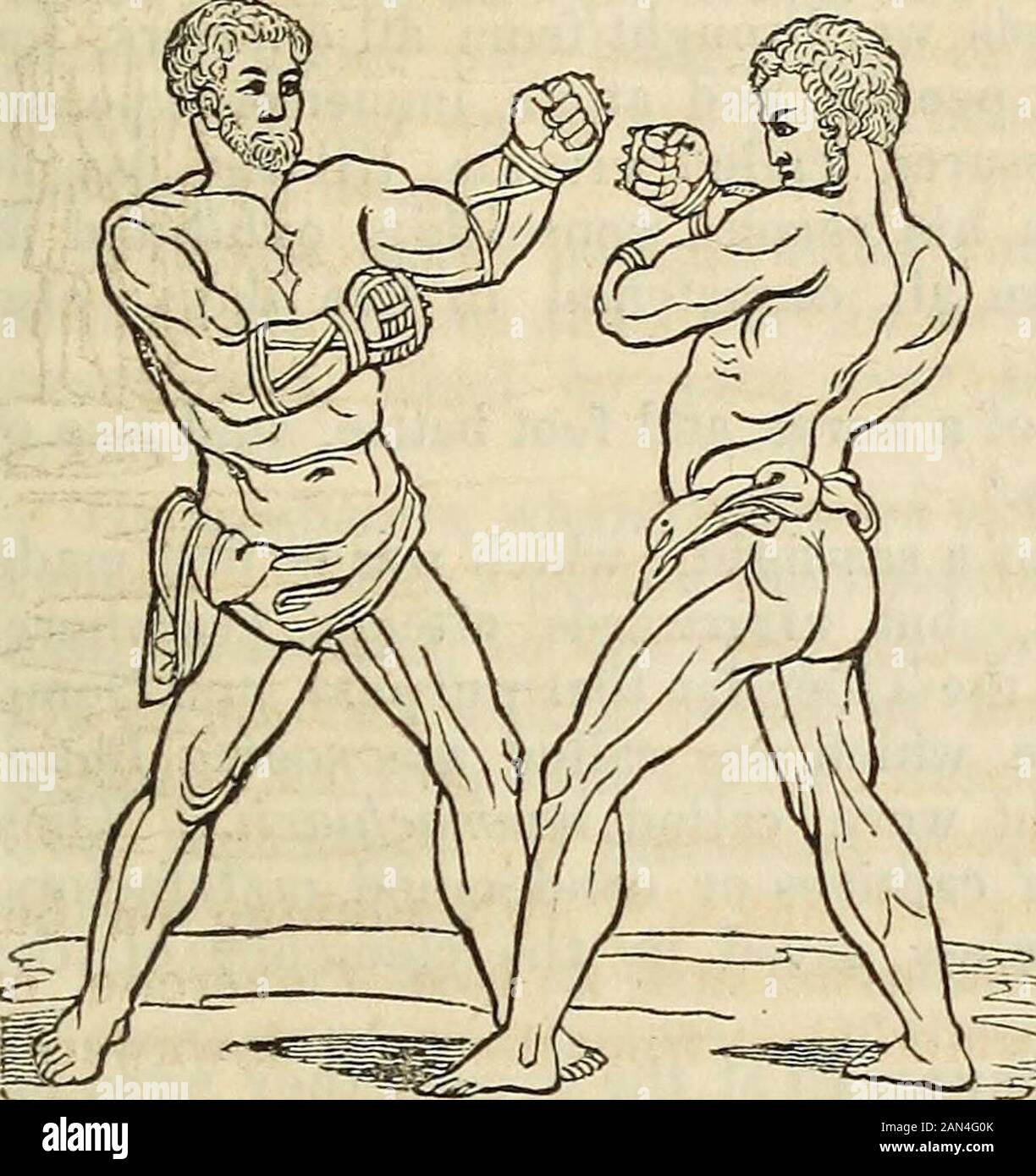 Roman antiquities: or, An account of the manners and customs of the Romans; . lexandria, he was cal-led gymnasiarcha by Augustus.^ Pal.estra was properly a school for wrestling,^ but is put forany place of exercise, or the exercise itself; hence pal(sstramdiscere, to learn the exercise ; unctce dona palcBstrds, exercises.^These gymnastic games ^^ were very hurtful to morals. The athletic games among- the Greeks were called iselastic,^^because the victors,^^ drawn by Avhite horses, and wearingcrowns on their heads; of olive, if victors at the Olympicgames; of laurel, at the Pythian; parsley, at Stock Photohttps://www.alamy.com/image-license-details/?v=1https://www.alamy.com/roman-antiquities-or-an-account-of-the-manners-and-customs-of-the-romans-lexandria-he-was-cal-led-gymnasiarcha-by-augustus-palestra-was-properly-a-school-for-wrestling-but-is-put-forany-place-of-exercise-or-the-exercise-itself-hence-palsstramdiscere-to-learn-the-exercise-unctce-dona-palcbstrds-exercisesthese-gymnastic-games-were-very-hurtful-to-morals-the-athletic-games-among-the-greeks-were-called-iselasticbecause-the-victors-drawn-by-avhite-horses-and-wearingcrowns-on-their-heads-of-olive-if-victors-at-the-olympicgames-of-laurel-at-the-pythian-parsley-at-image340005139.html
Roman antiquities: or, An account of the manners and customs of the Romans; . lexandria, he was cal-led gymnasiarcha by Augustus.^ Pal.estra was properly a school for wrestling,^ but is put forany place of exercise, or the exercise itself; hence pal(sstramdiscere, to learn the exercise ; unctce dona palcBstrds, exercises.^These gymnastic games ^^ were very hurtful to morals. The athletic games among- the Greeks were called iselastic,^^because the victors,^^ drawn by Avhite horses, and wearingcrowns on their heads; of olive, if victors at the Olympicgames; of laurel, at the Pythian; parsley, at Stock Photohttps://www.alamy.com/image-license-details/?v=1https://www.alamy.com/roman-antiquities-or-an-account-of-the-manners-and-customs-of-the-romans-lexandria-he-was-cal-led-gymnasiarcha-by-augustus-palestra-was-properly-a-school-for-wrestling-but-is-put-forany-place-of-exercise-or-the-exercise-itself-hence-palsstramdiscere-to-learn-the-exercise-unctce-dona-palcbstrds-exercisesthese-gymnastic-games-were-very-hurtful-to-morals-the-athletic-games-among-the-greeks-were-called-iselasticbecause-the-victors-drawn-by-avhite-horses-and-wearingcrowns-on-their-heads-of-olive-if-victors-at-the-olympicgames-of-laurel-at-the-pythian-parsley-at-image340005139.htmlRM2AN4G0K–Roman antiquities: or, An account of the manners and customs of the Romans; . lexandria, he was cal-led gymnasiarcha by Augustus.^ Pal.estra was properly a school for wrestling,^ but is put forany place of exercise, or the exercise itself; hence pal(sstramdiscere, to learn the exercise ; unctce dona palcBstrds, exercises.^These gymnastic games ^^ were very hurtful to morals. The athletic games among- the Greeks were called iselastic,^^because the victors,^^ drawn by Avhite horses, and wearingcrowns on their heads; of olive, if victors at the Olympicgames; of laurel, at the Pythian; parsley, at
 Pompeii, its history, buildings, and antiquities : an account of the destruction of the city with a full description of the remains, and of the recent excavations, and also an itinerary for visitors . Comic Scene from a Painting at Pompeii. Devoted as the Greeks were to beauty, an ugly or plebeianPrometheus, or Agamemnon, or Achilles, would have beenintolerable, but an ugly Apollo would inevitably have beenhooted off the stage. Many imitations of masks carved in THE THEATRES. 201 marble still exist, which display great beauty and excellenceof workmanship. We know much less of the minutiae of t Stock Photohttps://www.alamy.com/image-license-details/?v=1https://www.alamy.com/pompeii-its-history-buildings-and-antiquities-an-account-of-the-destruction-of-the-city-with-a-full-description-of-the-remains-and-of-the-recent-excavations-and-also-an-itinerary-for-visitors-comic-scene-from-a-painting-at-pompeii-devoted-as-the-greeks-were-to-beauty-an-ugly-or-plebeianprometheus-or-agamemnon-or-achilles-would-have-beenintolerable-but-an-ugly-apollo-would-inevitably-have-beenhooted-off-the-stage-many-imitations-of-masks-carved-in-the-theatres-201-marble-still-exist-which-display-great-beauty-and-excellenceof-workmanship-we-know-much-less-of-the-minutiae-of-t-image339984895.html
Pompeii, its history, buildings, and antiquities : an account of the destruction of the city with a full description of the remains, and of the recent excavations, and also an itinerary for visitors . Comic Scene from a Painting at Pompeii. Devoted as the Greeks were to beauty, an ugly or plebeianPrometheus, or Agamemnon, or Achilles, would have beenintolerable, but an ugly Apollo would inevitably have beenhooted off the stage. Many imitations of masks carved in THE THEATRES. 201 marble still exist, which display great beauty and excellenceof workmanship. We know much less of the minutiae of t Stock Photohttps://www.alamy.com/image-license-details/?v=1https://www.alamy.com/pompeii-its-history-buildings-and-antiquities-an-account-of-the-destruction-of-the-city-with-a-full-description-of-the-remains-and-of-the-recent-excavations-and-also-an-itinerary-for-visitors-comic-scene-from-a-painting-at-pompeii-devoted-as-the-greeks-were-to-beauty-an-ugly-or-plebeianprometheus-or-agamemnon-or-achilles-would-have-beenintolerable-but-an-ugly-apollo-would-inevitably-have-beenhooted-off-the-stage-many-imitations-of-masks-carved-in-the-theatres-201-marble-still-exist-which-display-great-beauty-and-excellenceof-workmanship-we-know-much-less-of-the-minutiae-of-t-image339984895.htmlRM2AN3J5K–Pompeii, its history, buildings, and antiquities : an account of the destruction of the city with a full description of the remains, and of the recent excavations, and also an itinerary for visitors . Comic Scene from a Painting at Pompeii. Devoted as the Greeks were to beauty, an ugly or plebeianPrometheus, or Agamemnon, or Achilles, would have beenintolerable, but an ugly Apollo would inevitably have beenhooted off the stage. Many imitations of masks carved in THE THEATRES. 201 marble still exist, which display great beauty and excellenceof workmanship. We know much less of the minutiae of t
 School dictionary of Greek and Roman antiquities . horse-soldiers, whowere accustomed to precede an army onmarch, in order to choose a suitable placefor the camp, and to make the necessaryprovisions for the army. They do not ap-pear to have been merely scouts, like thespeculatores. ANTEFIXA, terra-cottas, which ex-hibited various ornamental designs, andwere used in architecture to cover thefrieze {zophorus) of the entablature. These terra-cottas do not appear to have been used among the Greeks, but wereprobably Etruscan in their origin, and werethence taken for the decoration of Romanbuildings Stock Photohttps://www.alamy.com/image-license-details/?v=1https://www.alamy.com/school-dictionary-of-greek-and-roman-antiquities-horse-soldiers-whowere-accustomed-to-precede-an-army-onmarch-in-order-to-choose-a-suitable-placefor-the-camp-and-to-make-the-necessaryprovisions-for-the-army-they-do-not-ap-pear-to-have-been-merely-scouts-like-thespeculatores-antefixa-terra-cottas-which-ex-hibited-various-ornamental-designs-andwere-used-in-architecture-to-cover-thefrieze-zophorus-of-the-entablature-these-terra-cottas-do-not-appear-to-have-been-used-among-the-greeks-but-wereprobably-etruscan-in-their-origin-and-werethence-taken-for-the-decoration-of-romanbuildings-image338499279.html
School dictionary of Greek and Roman antiquities . horse-soldiers, whowere accustomed to precede an army onmarch, in order to choose a suitable placefor the camp, and to make the necessaryprovisions for the army. They do not ap-pear to have been merely scouts, like thespeculatores. ANTEFIXA, terra-cottas, which ex-hibited various ornamental designs, andwere used in architecture to cover thefrieze {zophorus) of the entablature. These terra-cottas do not appear to have been used among the Greeks, but wereprobably Etruscan in their origin, and werethence taken for the decoration of Romanbuildings Stock Photohttps://www.alamy.com/image-license-details/?v=1https://www.alamy.com/school-dictionary-of-greek-and-roman-antiquities-horse-soldiers-whowere-accustomed-to-precede-an-army-onmarch-in-order-to-choose-a-suitable-placefor-the-camp-and-to-make-the-necessaryprovisions-for-the-army-they-do-not-ap-pear-to-have-been-merely-scouts-like-thespeculatores-antefixa-terra-cottas-which-ex-hibited-various-ornamental-designs-andwere-used-in-architecture-to-cover-thefrieze-zophorus-of-the-entablature-these-terra-cottas-do-not-appear-to-have-been-used-among-the-greeks-but-wereprobably-etruscan-in-their-origin-and-werethence-taken-for-the-decoration-of-romanbuildings-image338499279.htmlRM2AJKY7Y–School dictionary of Greek and Roman antiquities . horse-soldiers, whowere accustomed to precede an army onmarch, in order to choose a suitable placefor the camp, and to make the necessaryprovisions for the army. They do not ap-pear to have been merely scouts, like thespeculatores. ANTEFIXA, terra-cottas, which ex-hibited various ornamental designs, andwere used in architecture to cover thefrieze {zophorus) of the entablature. These terra-cottas do not appear to have been used among the Greeks, but wereprobably Etruscan in their origin, and werethence taken for the decoration of Romanbuildings
 School dictionary of Greek and Roman antiquities . halnevm. or caldalavatio), which is also called piscina or ca-lida piscina, labrum and solium, appears tohave been a capacious marble vase, some-times standing upon the floor, like that inthe preceding cut, and sometimes eitherpartly elevated abovf> the floor, as it was atPompeii, or entirely sunk into it. After having gone through the regularcourse of perspiration, the Romans madeuse of instruments called strigiles or strigles,to scrape off the perspiration. The strigilwas also used by the Greeks, who called itstlengis (arXiy^is) or xystra Stock Photohttps://www.alamy.com/image-license-details/?v=1https://www.alamy.com/school-dictionary-of-greek-and-roman-antiquities-halnevm-or-caldalavatio-which-is-also-called-piscina-or-ca-lida-piscina-labrum-and-solium-appears-tohave-been-a-capacious-marble-vase-some-times-standing-upon-the-floor-like-that-inthe-preceding-cut-and-sometimes-eitherpartly-elevated-abovfgt-the-floor-as-it-was-atpompeii-or-entirely-sunk-into-it-after-having-gone-through-the-regularcourse-of-perspiration-the-romans-madeuse-of-instruments-called-strigiles-or-striglesto-scrape-off-the-perspiration-the-strigilwas-also-used-by-the-greeks-who-called-itstlengis-arxiyis-or-xystra-image338495333.html
School dictionary of Greek and Roman antiquities . halnevm. or caldalavatio), which is also called piscina or ca-lida piscina, labrum and solium, appears tohave been a capacious marble vase, some-times standing upon the floor, like that inthe preceding cut, and sometimes eitherpartly elevated abovf> the floor, as it was atPompeii, or entirely sunk into it. After having gone through the regularcourse of perspiration, the Romans madeuse of instruments called strigiles or strigles,to scrape off the perspiration. The strigilwas also used by the Greeks, who called itstlengis (arXiy^is) or xystra Stock Photohttps://www.alamy.com/image-license-details/?v=1https://www.alamy.com/school-dictionary-of-greek-and-roman-antiquities-halnevm-or-caldalavatio-which-is-also-called-piscina-or-ca-lida-piscina-labrum-and-solium-appears-tohave-been-a-capacious-marble-vase-some-times-standing-upon-the-floor-like-that-inthe-preceding-cut-and-sometimes-eitherpartly-elevated-abovfgt-the-floor-as-it-was-atpompeii-or-entirely-sunk-into-it-after-having-gone-through-the-regularcourse-of-perspiration-the-romans-madeuse-of-instruments-called-strigiles-or-striglesto-scrape-off-the-perspiration-the-strigilwas-also-used-by-the-greeks-who-called-itstlengis-arxiyis-or-xystra-image338495333.htmlRM2AJKP71–School dictionary of Greek and Roman antiquities . halnevm. or caldalavatio), which is also called piscina or ca-lida piscina, labrum and solium, appears tohave been a capacious marble vase, some-times standing upon the floor, like that inthe preceding cut, and sometimes eitherpartly elevated abovf> the floor, as it was atPompeii, or entirely sunk into it. After having gone through the regularcourse of perspiration, the Romans madeuse of instruments called strigiles or strigles,to scrape off the perspiration. The strigilwas also used by the Greeks, who called itstlengis (arXiy^is) or xystra
 School dictionary of Greek and Roman antiquities . als, which were sonumerous among the Greeks, dancingformed a very prominent part. We findfrom the earliest times that the worship ofApollo was connected with a religious dance,called i7y/jorc/iema(u7rJpx^jna). All the reli-gious dances, with the exception of theBacchic and the Corybantlan, were verysimple, and consisted of gentle movementsof the body, with various turnings andwindings around the altar: such a dance SALTATIO. 319 was the Geranus (yepauos), which Thc>eusis said to have performed at Delos on hisreturn from Crete. The Dionysiac Stock Photohttps://www.alamy.com/image-license-details/?v=1https://www.alamy.com/school-dictionary-of-greek-and-roman-antiquities-als-which-were-sonumerous-among-the-greeks-dancingformed-a-very-prominent-part-we-findfrom-the-earliest-times-that-the-worship-ofapollo-was-connected-with-a-religious-dancecalled-i7yjorciemau7rjpxjna-all-the-reli-gious-dances-with-the-exception-of-thebacchic-and-the-corybantlan-were-verysimple-and-consisted-of-gentle-movementsof-the-body-with-various-turnings-andwindings-around-the-altar-such-a-dance-saltatio-319-was-the-geranus-yepauos-which-thcgteusis-said-to-have-performed-at-delos-on-hisreturn-from-crete-the-dionysiac-image338465624.html
School dictionary of Greek and Roman antiquities . als, which were sonumerous among the Greeks, dancingformed a very prominent part. We findfrom the earliest times that the worship ofApollo was connected with a religious dance,called i7y/jorc/iema(u7rJpx^jna). All the reli-gious dances, with the exception of theBacchic and the Corybantlan, were verysimple, and consisted of gentle movementsof the body, with various turnings andwindings around the altar: such a dance SALTATIO. 319 was the Geranus (yepauos), which Thc>eusis said to have performed at Delos on hisreturn from Crete. The Dionysiac Stock Photohttps://www.alamy.com/image-license-details/?v=1https://www.alamy.com/school-dictionary-of-greek-and-roman-antiquities-als-which-were-sonumerous-among-the-greeks-dancingformed-a-very-prominent-part-we-findfrom-the-earliest-times-that-the-worship-ofapollo-was-connected-with-a-religious-dancecalled-i7yjorciemau7rjpxjna-all-the-reli-gious-dances-with-the-exception-of-thebacchic-and-the-corybantlan-were-verysimple-and-consisted-of-gentle-movementsof-the-body-with-various-turnings-andwindings-around-the-altar-such-a-dance-saltatio-319-was-the-geranus-yepauos-which-thcgteusis-said-to-have-performed-at-delos-on-hisreturn-from-crete-the-dionysiac-image338465624.htmlRM2AJJCA0–School dictionary of Greek and Roman antiquities . als, which were sonumerous among the Greeks, dancingformed a very prominent part. We findfrom the earliest times that the worship ofApollo was connected with a religious dance,called i7y/jorc/iema(u7rJpx^jna). All the reli-gious dances, with the exception of theBacchic and the Corybantlan, were verysimple, and consisted of gentle movementsof the body, with various turnings andwindings around the altar: such a dance SALTATIO. 319 was the Geranus (yepauos), which Thc>eusis said to have performed at Delos on hisreturn from Crete. The Dionysiac
![School dictionary of Greek and Roman antiquities . The senate house was called Bouleuterion{fiovXeuTTjpiov). The prytanes also had a building to holdtheir meetings in, where they were enter-tained at the public expense during theirprytany. This was called the Prytaneion,and was used for a variety of purposes.[Prytaneion.] BOW. [Arcus.] BOXING. [PUGILATUS.] BRACAE, or BRACCAE (az/a|upf8es),trowsers, pantaloons, were common to ali. BRACAE, TROWSERS. BUCCINA. the nations which encircled the Grqek andRoman population, extending from theIndian to the Atlantic ocean, but were notworn l)y the Greeks Stock Photo School dictionary of Greek and Roman antiquities . The senate house was called Bouleuterion{fiovXeuTTjpiov). The prytanes also had a building to holdtheir meetings in, where they were enter-tained at the public expense during theirprytany. This was called the Prytaneion,and was used for a variety of purposes.[Prytaneion.] BOW. [Arcus.] BOXING. [PUGILATUS.] BRACAE, or BRACCAE (az/a|upf8es),trowsers, pantaloons, were common to ali. BRACAE, TROWSERS. BUCCINA. the nations which encircled the Grqek andRoman population, extending from theIndian to the Atlantic ocean, but were notworn l)y the Greeks Stock Photo](https://c8.alamy.com/comp/2AJKNNJ/school-dictionary-of-greek-and-roman-antiquities-the-senate-house-was-called-bouleuterionfiovxeuttjpiov-the-prytanes-also-had-a-building-to-holdtheir-meetings-in-where-they-were-enter-tained-at-the-public-expense-during-theirprytany-this-was-called-the-prytaneionand-was-used-for-a-variety-of-purposes-prytaneion-bow-arcus-boxing-pugilatus-bracae-or-braccae-azaupf8estrowsers-pantaloons-were-common-to-ali-bracae-trowsers-buccina-the-nations-which-encircled-the-grqek-androman-population-extending-from-theindian-to-the-atlantic-ocean-but-were-notworn-ly-the-greeks-2AJKNNJ.jpg) School dictionary of Greek and Roman antiquities . The senate house was called Bouleuterion{fiovXeuTTjpiov). The prytanes also had a building to holdtheir meetings in, where they were enter-tained at the public expense during theirprytany. This was called the Prytaneion,and was used for a variety of purposes.[Prytaneion.] BOW. [Arcus.] BOXING. [PUGILATUS.] BRACAE, or BRACCAE (az/a|upf8es),trowsers, pantaloons, were common to ali. BRACAE, TROWSERS. BUCCINA. the nations which encircled the Grqek andRoman population, extending from theIndian to the Atlantic ocean, but were notworn l)y the Greeks Stock Photohttps://www.alamy.com/image-license-details/?v=1https://www.alamy.com/school-dictionary-of-greek-and-roman-antiquities-the-senate-house-was-called-bouleuterionfiovxeuttjpiov-the-prytanes-also-had-a-building-to-holdtheir-meetings-in-where-they-were-enter-tained-at-the-public-expense-during-theirprytany-this-was-called-the-prytaneionand-was-used-for-a-variety-of-purposes-prytaneion-bow-arcus-boxing-pugilatus-bracae-or-braccae-azaupf8estrowsers-pantaloons-were-common-to-ali-bracae-trowsers-buccina-the-nations-which-encircled-the-grqek-androman-population-extending-from-theindian-to-the-atlantic-ocean-but-were-notworn-ly-the-greeks-image338494958.html
School dictionary of Greek and Roman antiquities . The senate house was called Bouleuterion{fiovXeuTTjpiov). The prytanes also had a building to holdtheir meetings in, where they were enter-tained at the public expense during theirprytany. This was called the Prytaneion,and was used for a variety of purposes.[Prytaneion.] BOW. [Arcus.] BOXING. [PUGILATUS.] BRACAE, or BRACCAE (az/a|upf8es),trowsers, pantaloons, were common to ali. BRACAE, TROWSERS. BUCCINA. the nations which encircled the Grqek andRoman population, extending from theIndian to the Atlantic ocean, but were notworn l)y the Greeks Stock Photohttps://www.alamy.com/image-license-details/?v=1https://www.alamy.com/school-dictionary-of-greek-and-roman-antiquities-the-senate-house-was-called-bouleuterionfiovxeuttjpiov-the-prytanes-also-had-a-building-to-holdtheir-meetings-in-where-they-were-enter-tained-at-the-public-expense-during-theirprytany-this-was-called-the-prytaneionand-was-used-for-a-variety-of-purposes-prytaneion-bow-arcus-boxing-pugilatus-bracae-or-braccae-azaupf8estrowsers-pantaloons-were-common-to-ali-bracae-trowsers-buccina-the-nations-which-encircled-the-grqek-androman-population-extending-from-theindian-to-the-atlantic-ocean-but-were-notworn-ly-the-greeks-image338494958.htmlRM2AJKNNJ–School dictionary of Greek and Roman antiquities . The senate house was called Bouleuterion{fiovXeuTTjpiov). The prytanes also had a building to holdtheir meetings in, where they were enter-tained at the public expense during theirprytany. This was called the Prytaneion,and was used for a variety of purposes.[Prytaneion.] BOW. [Arcus.] BOXING. [PUGILATUS.] BRACAE, or BRACCAE (az/a|upf8es),trowsers, pantaloons, were common to ali. BRACAE, TROWSERS. BUCCINA. the nations which encircled the Grqek andRoman population, extending from theIndian to the Atlantic ocean, but were notworn l)y the Greeks
RM2AFRF8W–. The illustrated companion to the Latin dictionary and Greek lexicon; forming a glossary of all the words representing visible objects connected with the arts, manufactures, and every-day life of the Greeks and Romans, with representations of nearly two thousand objects from the antique. these have been found in excavations,and may be seen in the various collec- PUTEUS. PYCNOSTYLOS. 539 tions of antiquities, oftentimes richlydecorated with figures or other devicesin relief (the putealia sigillata of Cic.Att. i. 10.) ; and the annexed woodcutshows one of the same descriptionstill covering the
 School dictionary of Greek and Roman antiquities . AMPHOHAE. The most common use of the amphora,both among the Greeks and the Romans,was for keeping wine. The cork was coveredwith pitch or gypsum, and (among theRomans) on the outside the title of thewine was painted, the date of the vintagebeing marked by the names of the consulsthen in office; or, when the jars were of AMPYX. 25 glass, little tickets (pittoria, tesserae) weresuspended from them, indicating these par-ticulars.. MODE OP FILLINa AMPHOBAE FROM A WIME-CART. The Greek amphoreus and the Romanamphora were also names of fixed measures Stock Photohttps://www.alamy.com/image-license-details/?v=1https://www.alamy.com/school-dictionary-of-greek-and-roman-antiquities-amphohae-the-most-common-use-of-the-amphoraboth-among-the-greeks-and-the-romanswas-for-keeping-wine-the-cork-was-coveredwith-pitch-or-gypsum-and-among-theromans-on-the-outside-the-title-of-thewine-was-painted-the-date-of-the-vintagebeing-marked-by-the-names-of-the-consulsthen-in-office-or-when-the-jars-were-of-ampyx-25-glass-little-tickets-pittoria-tesserae-weresuspended-from-them-indicating-these-par-ticulars-mode-op-fillina-amphobae-from-a-wime-cart-the-greek-amphoreus-and-the-romanamphora-were-also-names-of-fixed-measures-image338500853.html
School dictionary of Greek and Roman antiquities . AMPHOHAE. The most common use of the amphora,both among the Greeks and the Romans,was for keeping wine. The cork was coveredwith pitch or gypsum, and (among theRomans) on the outside the title of thewine was painted, the date of the vintagebeing marked by the names of the consulsthen in office; or, when the jars were of AMPYX. 25 glass, little tickets (pittoria, tesserae) weresuspended from them, indicating these par-ticulars.. MODE OP FILLINa AMPHOBAE FROM A WIME-CART. The Greek amphoreus and the Romanamphora were also names of fixed measures Stock Photohttps://www.alamy.com/image-license-details/?v=1https://www.alamy.com/school-dictionary-of-greek-and-roman-antiquities-amphohae-the-most-common-use-of-the-amphoraboth-among-the-greeks-and-the-romanswas-for-keeping-wine-the-cork-was-coveredwith-pitch-or-gypsum-and-among-theromans-on-the-outside-the-title-of-thewine-was-painted-the-date-of-the-vintagebeing-marked-by-the-names-of-the-consulsthen-in-office-or-when-the-jars-were-of-ampyx-25-glass-little-tickets-pittoria-tesserae-weresuspended-from-them-indicating-these-par-ticulars-mode-op-fillina-amphobae-from-a-wime-cart-the-greek-amphoreus-and-the-romanamphora-were-also-names-of-fixed-measures-image338500853.htmlRM2AJM185–School dictionary of Greek and Roman antiquities . AMPHOHAE. The most common use of the amphora,both among the Greeks and the Romans,was for keeping wine. The cork was coveredwith pitch or gypsum, and (among theRomans) on the outside the title of thewine was painted, the date of the vintagebeing marked by the names of the consulsthen in office; or, when the jars were of AMPYX. 25 glass, little tickets (pittoria, tesserae) weresuspended from them, indicating these par-ticulars.. MODE OP FILLINa AMPHOBAE FROM A WIME-CART. The Greek amphoreus and the Romanamphora were also names of fixed measures
 Antiquities of the Orient unveiled, containing a concise description of the remarkable ruins of King Solomon's temple, and store cities ,together with those of all the most ancient and renowned cities of the East, including Babylon, Nineveh, Damascus, and Shushan . situdes that passedover the district in which it is situated: conqueredby the Saracens, retaken by the Greeks, again in thehands of the Moslems; during the wars of theCrusaders the scene of terrible battles, sieges, andbrilliant exploits; again taken from the Moslems, andfinally retaken by them. In 1822 Antioch contained a populatio Stock Photohttps://www.alamy.com/image-license-details/?v=1https://www.alamy.com/antiquities-of-the-orient-unveiled-containing-a-concise-description-of-the-remarkable-ruins-of-king-solomons-temple-and-store-cities-together-with-those-of-all-the-most-ancient-and-renowned-cities-of-the-east-including-babylon-nineveh-damascus-and-shushan-situdes-that-passedover-the-district-in-which-it-is-situated-conqueredby-the-saracens-retaken-by-the-greeks-again-in-thehands-of-the-moslems-during-the-wars-of-thecrusaders-the-scene-of-terrible-battles-sieges-andbrilliant-exploits-again-taken-from-the-moslems-andfinally-retaken-by-them-in-1822-antioch-contained-a-populatio-image339134440.html
Antiquities of the Orient unveiled, containing a concise description of the remarkable ruins of King Solomon's temple, and store cities ,together with those of all the most ancient and renowned cities of the East, including Babylon, Nineveh, Damascus, and Shushan . situdes that passedover the district in which it is situated: conqueredby the Saracens, retaken by the Greeks, again in thehands of the Moslems; during the wars of theCrusaders the scene of terrible battles, sieges, andbrilliant exploits; again taken from the Moslems, andfinally retaken by them. In 1822 Antioch contained a populatio Stock Photohttps://www.alamy.com/image-license-details/?v=1https://www.alamy.com/antiquities-of-the-orient-unveiled-containing-a-concise-description-of-the-remarkable-ruins-of-king-solomons-temple-and-store-cities-together-with-those-of-all-the-most-ancient-and-renowned-cities-of-the-east-including-babylon-nineveh-damascus-and-shushan-situdes-that-passedover-the-district-in-which-it-is-situated-conqueredby-the-saracens-retaken-by-the-greeks-again-in-thehands-of-the-moslems-during-the-wars-of-thecrusaders-the-scene-of-terrible-battles-sieges-andbrilliant-exploits-again-taken-from-the-moslems-andfinally-retaken-by-them-in-1822-antioch-contained-a-populatio-image339134440.htmlRM2AKMWC8–Antiquities of the Orient unveiled, containing a concise description of the remarkable ruins of King Solomon's temple, and store cities ,together with those of all the most ancient and renowned cities of the East, including Babylon, Nineveh, Damascus, and Shushan . situdes that passedover the district in which it is situated: conqueredby the Saracens, retaken by the Greeks, again in thehands of the Moslems; during the wars of theCrusaders the scene of terrible battles, sieges, andbrilliant exploits; again taken from the Moslems, andfinally retaken by them. In 1822 Antioch contained a populatio
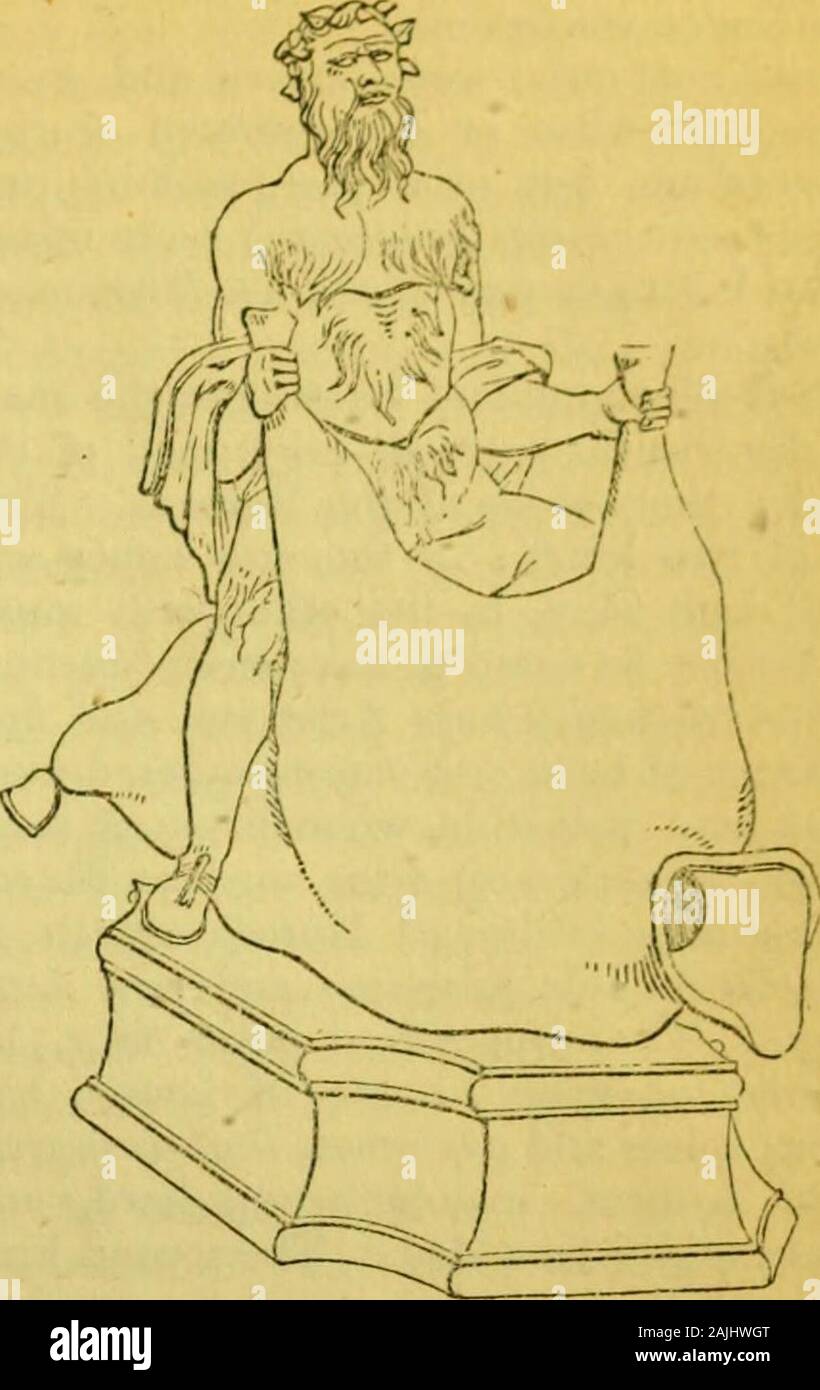 School dictionary of Greek and Roman antiquities . n pressed, andIhe product employed for an inferiorpussum called secundarium. The passum ofCrete was most prized, and next in rankwere those of Cilicia, Africa, Italy, andthe neighbouring provinces. The kindsknown as Psythiiim and Melampsythiumpossessed the peculiar flavour of the grapeand not that of wine. The grapes mostsuitable for passum were those whichripened early, especially the varietiesApiana, Scirpula, and Psithia. The Greeks recognised three colours inwines; red (iJ.4as), ichite, i. e. pale straw-colour (Aeufcos), and brown or ambe Stock Photohttps://www.alamy.com/image-license-details/?v=1https://www.alamy.com/school-dictionary-of-greek-and-roman-antiquities-n-pressed-andihe-product-employed-for-an-inferiorpussum-called-secundarium-the-passum-ofcrete-was-most-prized-and-next-in-rankwere-those-of-cilicia-africa-italy-andthe-neighbouring-provinces-the-kindsknown-as-psythiiim-and-melampsythiumpossessed-the-peculiar-flavour-of-the-grapeand-not-that-of-wine-the-grapes-mostsuitable-for-passum-were-those-whichripened-early-especially-the-varietiesapiana-scirpula-and-psithia-the-greeks-recognised-three-colours-inwines-red-ij4as-ichite-i-e-pale-straw-colour-aeufcos-and-brown-or-ambe-image338454056.html
School dictionary of Greek and Roman antiquities . n pressed, andIhe product employed for an inferiorpussum called secundarium. The passum ofCrete was most prized, and next in rankwere those of Cilicia, Africa, Italy, andthe neighbouring provinces. The kindsknown as Psythiiim and Melampsythiumpossessed the peculiar flavour of the grapeand not that of wine. The grapes mostsuitable for passum were those whichripened early, especially the varietiesApiana, Scirpula, and Psithia. The Greeks recognised three colours inwines; red (iJ.4as), ichite, i. e. pale straw-colour (Aeufcos), and brown or ambe Stock Photohttps://www.alamy.com/image-license-details/?v=1https://www.alamy.com/school-dictionary-of-greek-and-roman-antiquities-n-pressed-andihe-product-employed-for-an-inferiorpussum-called-secundarium-the-passum-ofcrete-was-most-prized-and-next-in-rankwere-those-of-cilicia-africa-italy-andthe-neighbouring-provinces-the-kindsknown-as-psythiiim-and-melampsythiumpossessed-the-peculiar-flavour-of-the-grapeand-not-that-of-wine-the-grapes-mostsuitable-for-passum-were-those-whichripened-early-especially-the-varietiesapiana-scirpula-and-psithia-the-greeks-recognised-three-colours-inwines-red-ij4as-ichite-i-e-pale-straw-colour-aeufcos-and-brown-or-ambe-image338454056.htmlRM2AJHWGT–School dictionary of Greek and Roman antiquities . n pressed, andIhe product employed for an inferiorpussum called secundarium. The passum ofCrete was most prized, and next in rankwere those of Cilicia, Africa, Italy, andthe neighbouring provinces. The kindsknown as Psythiiim and Melampsythiumpossessed the peculiar flavour of the grapeand not that of wine. The grapes mostsuitable for passum were those whichripened early, especially the varietiesApiana, Scirpula, and Psithia. The Greeks recognised three colours inwines; red (iJ.4as), ichite, i. e. pale straw-colour (Aeufcos), and brown or ambe
 School dictionary of Greek and Roman antiquities . omans, and fidaavos bythe Greeks. The executioner was calledtortor, and among the instruments employedfor the purpose were the Avheel and theecu/ens. Among both the Greeks andRomans, no freemen were put to the tor-ture, but only slaves, whose evidence wasfor that reason often considered of morevalue than that of freemen. TORQUES or TORQUIS (arpeinSs),an ornament of gold, twisted spirally andbent into a circular form, which was wornround the neck by men of distinction amongthe Persians, the Gauls, and other Asiaticand northern nations. It was b Stock Photohttps://www.alamy.com/image-license-details/?v=1https://www.alamy.com/school-dictionary-of-greek-and-roman-antiquities-omans-and-fidaavos-bythe-greeks-the-executioner-was-calledtortor-and-among-the-instruments-employedfor-the-purpose-were-the-avheel-and-theecuens-among-both-the-greeks-andromans-no-freemen-were-put-to-the-tor-ture-but-only-slaves-whose-evidence-wasfor-that-reason-often-considered-of-morevalue-than-that-of-freemen-torques-or-torquis-arpeinssan-ornament-of-gold-twisted-spirally-andbent-into-a-circular-form-which-was-wornround-the-neck-by-men-of-distinction-amongthe-persians-the-gauls-and-other-asiaticand-northern-nations-it-was-b-image338457515.html
School dictionary of Greek and Roman antiquities . omans, and fidaavos bythe Greeks. The executioner was calledtortor, and among the instruments employedfor the purpose were the Avheel and theecu/ens. Among both the Greeks andRomans, no freemen were put to the tor-ture, but only slaves, whose evidence wasfor that reason often considered of morevalue than that of freemen. TORQUES or TORQUIS (arpeinSs),an ornament of gold, twisted spirally andbent into a circular form, which was wornround the neck by men of distinction amongthe Persians, the Gauls, and other Asiaticand northern nations. It was b Stock Photohttps://www.alamy.com/image-license-details/?v=1https://www.alamy.com/school-dictionary-of-greek-and-roman-antiquities-omans-and-fidaavos-bythe-greeks-the-executioner-was-calledtortor-and-among-the-instruments-employedfor-the-purpose-were-the-avheel-and-theecuens-among-both-the-greeks-andromans-no-freemen-were-put-to-the-tor-ture-but-only-slaves-whose-evidence-wasfor-that-reason-often-considered-of-morevalue-than-that-of-freemen-torques-or-torquis-arpeinssan-ornament-of-gold-twisted-spirally-andbent-into-a-circular-form-which-was-wornround-the-neck-by-men-of-distinction-amongthe-persians-the-gauls-and-other-asiaticand-northern-nations-it-was-b-image338457515.htmlRM2AJJ20B–School dictionary of Greek and Roman antiquities . omans, and fidaavos bythe Greeks. The executioner was calledtortor, and among the instruments employedfor the purpose were the Avheel and theecu/ens. Among both the Greeks andRomans, no freemen were put to the tor-ture, but only slaves, whose evidence wasfor that reason often considered of morevalue than that of freemen. TORQUES or TORQUIS (arpeinSs),an ornament of gold, twisted spirally andbent into a circular form, which was wornround the neck by men of distinction amongthe Persians, the Gauls, and other Asiaticand northern nations. It was b
 . Daily Bible illustrations : being original readings for a year, on subjects from sacred history, biography, georgaphy, antiquities, and theology : Especially designed for the family circle. sents Zeus under that aspect—as tutelary or guardian deity(Jupiter Custos)—in which he was worshipped by the Lys- 280 FOUTY-EJGHTH WEEK TUESDAY.. trians. Their image of him, to which they found a resem-blance in Barnabas, must have been like this. Having con-cluded that Barnabas was Jupiter, it was easy to conceive thatPaul was Mercurius, the Hermes ofthe Greeks. And the reason is, in thisinstance, given. Stock Photohttps://www.alamy.com/image-license-details/?v=1https://www.alamy.com/daily-bible-illustrations-being-original-readings-for-a-year-on-subjects-from-sacred-history-biography-georgaphy-antiquities-and-theology-especially-designed-for-the-family-circle-sents-zeus-under-that-aspectas-tutelary-or-guardian-deityjupiter-custosin-which-he-was-worshipped-by-the-lys-280-fouty-ejghth-week-tuesday-trians-their-image-of-him-to-which-they-found-a-resem-blance-in-barnabas-must-have-been-like-this-having-con-cluded-that-barnabas-was-jupiter-it-was-easy-to-conceive-thatpaul-was-mercurius-the-hermes-ofthe-greeks-and-the-reason-is-in-thisinstance-given-image336860506.html
. Daily Bible illustrations : being original readings for a year, on subjects from sacred history, biography, georgaphy, antiquities, and theology : Especially designed for the family circle. sents Zeus under that aspect—as tutelary or guardian deity(Jupiter Custos)—in which he was worshipped by the Lys- 280 FOUTY-EJGHTH WEEK TUESDAY.. trians. Their image of him, to which they found a resem-blance in Barnabas, must have been like this. Having con-cluded that Barnabas was Jupiter, it was easy to conceive thatPaul was Mercurius, the Hermes ofthe Greeks. And the reason is, in thisinstance, given. Stock Photohttps://www.alamy.com/image-license-details/?v=1https://www.alamy.com/daily-bible-illustrations-being-original-readings-for-a-year-on-subjects-from-sacred-history-biography-georgaphy-antiquities-and-theology-especially-designed-for-the-family-circle-sents-zeus-under-that-aspectas-tutelary-or-guardian-deityjupiter-custosin-which-he-was-worshipped-by-the-lys-280-fouty-ejghth-week-tuesday-trians-their-image-of-him-to-which-they-found-a-resem-blance-in-barnabas-must-have-been-like-this-having-con-cluded-that-barnabas-was-jupiter-it-was-easy-to-conceive-thatpaul-was-mercurius-the-hermes-ofthe-greeks-and-the-reason-is-in-thisinstance-given-image336860506.htmlRM2AG190A–. Daily Bible illustrations : being original readings for a year, on subjects from sacred history, biography, georgaphy, antiquities, and theology : Especially designed for the family circle. sents Zeus under that aspect—as tutelary or guardian deity(Jupiter Custos)—in which he was worshipped by the Lys- 280 FOUTY-EJGHTH WEEK TUESDAY.. trians. Their image of him, to which they found a resem-blance in Barnabas, must have been like this. Having con-cluded that Barnabas was Jupiter, it was easy to conceive thatPaul was Mercurius, the Hermes ofthe Greeks. And the reason is, in thisinstance, given.
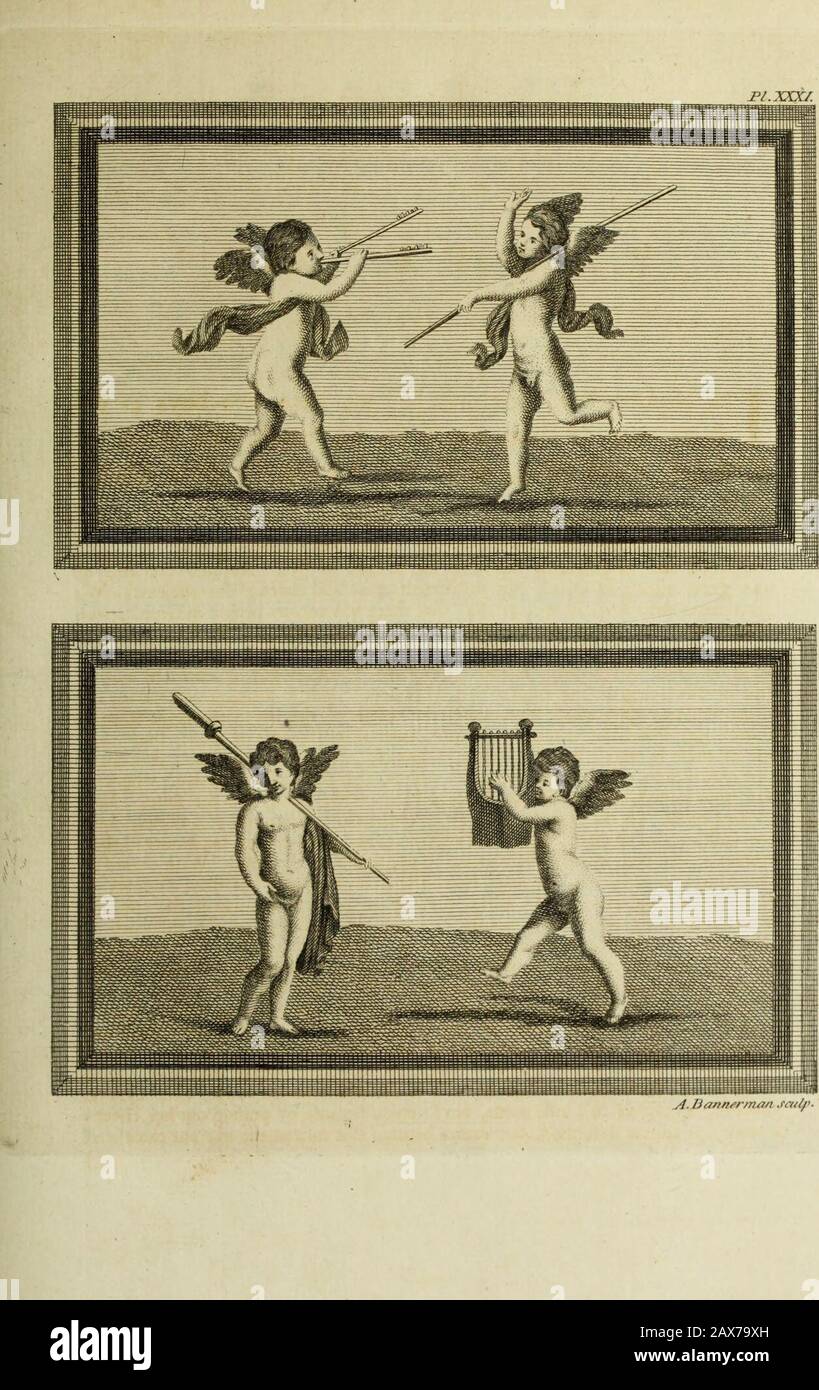 The antiquities of Herculaneum . o, in Alcibiade, and from Arijlotle, deRep. viii. 6, that among the Greeks, playing on the flute was one of the arts thatwere learned by their noble youth: though the cuftom, by the influence ofAlcibiades, was afterwards abolifhed in Athens. Thus Gellius, xv. 17. Alcibiades having been educated by his uncle Pericles in all genteel accompliftiments, among others, Antigonidas, a famous mafter on the flute, was fent for to teach him on that inftrument, which was then much in requeft : but, having put the flute to his mouth and blowed, obferving how it diftorted hi Stock Photohttps://www.alamy.com/image-license-details/?v=1https://www.alamy.com/the-antiquities-of-herculaneum-o-in-alcibiade-and-from-arijlotle-derep-viii-6-that-among-the-greeks-playing-on-the-flute-was-one-of-the-arts-thatwere-learned-by-their-noble-youth-though-the-cuftom-by-the-influence-ofalcibiades-was-afterwards-abolifhed-in-athens-thus-gellius-xv-17-alcibiades-having-been-educated-by-his-uncle-pericles-in-all-genteel-accompliftiments-among-others-antigonidas-a-famous-mafter-on-the-flute-was-fent-for-to-teach-him-on-that-inftrument-which-was-then-much-in-requeft-but-having-put-the-flute-to-his-mouth-and-blowed-obferving-how-it-diftorted-hi-image343139513.html
The antiquities of Herculaneum . o, in Alcibiade, and from Arijlotle, deRep. viii. 6, that among the Greeks, playing on the flute was one of the arts thatwere learned by their noble youth: though the cuftom, by the influence ofAlcibiades, was afterwards abolifhed in Athens. Thus Gellius, xv. 17. Alcibiades having been educated by his uncle Pericles in all genteel accompliftiments, among others, Antigonidas, a famous mafter on the flute, was fent for to teach him on that inftrument, which was then much in requeft : but, having put the flute to his mouth and blowed, obferving how it diftorted hi Stock Photohttps://www.alamy.com/image-license-details/?v=1https://www.alamy.com/the-antiquities-of-herculaneum-o-in-alcibiade-and-from-arijlotle-derep-viii-6-that-among-the-greeks-playing-on-the-flute-was-one-of-the-arts-thatwere-learned-by-their-noble-youth-though-the-cuftom-by-the-influence-ofalcibiades-was-afterwards-abolifhed-in-athens-thus-gellius-xv-17-alcibiades-having-been-educated-by-his-uncle-pericles-in-all-genteel-accompliftiments-among-others-antigonidas-a-famous-mafter-on-the-flute-was-fent-for-to-teach-him-on-that-inftrument-which-was-then-much-in-requeft-but-having-put-the-flute-to-his-mouth-and-blowed-obferving-how-it-diftorted-hi-image343139513.htmlRM2AX79XH–The antiquities of Herculaneum . o, in Alcibiade, and from Arijlotle, deRep. viii. 6, that among the Greeks, playing on the flute was one of the arts thatwere learned by their noble youth: though the cuftom, by the influence ofAlcibiades, was afterwards abolifhed in Athens. Thus Gellius, xv. 17. Alcibiades having been educated by his uncle Pericles in all genteel accompliftiments, among others, Antigonidas, a famous mafter on the flute, was fent for to teach him on that inftrument, which was then much in requeft : but, having put the flute to his mouth and blowed, obferving how it diftorted hi
 Antiquities of the Orient unveiled, containing a concise description of the remarkable ruins of King Solomon's temple, and store cities ,together with those of all the most ancient and renowned cities of the East, including Babylon, Nineveh, Damascus, and Shushan . ants were Greeks and Romans, andforeign customs prevailed to such an extent as to giveoffence to the stricter Jews. Herod Antipas builthere a palace, and established a race-course. In theJewish war, which ended in the destruction of Jeru-salem, Tiberias bore a conspicuous part, especiallyduring the command of Josephus, in Galilee, w Stock Photohttps://www.alamy.com/image-license-details/?v=1https://www.alamy.com/antiquities-of-the-orient-unveiled-containing-a-concise-description-of-the-remarkable-ruins-of-king-solomons-temple-and-store-cities-together-with-those-of-all-the-most-ancient-and-renowned-cities-of-the-east-including-babylon-nineveh-damascus-and-shushan-ants-were-greeks-and-romans-andforeign-customs-prevailed-to-such-an-extent-as-to-giveoffence-to-the-stricter-jews-herod-antipas-builthere-a-palace-and-established-a-race-course-in-thejewish-war-which-ended-in-the-destruction-of-jeru-salem-tiberias-bore-a-conspicuous-part-especiallyduring-the-command-of-josephus-in-galilee-w-image339135650.html
Antiquities of the Orient unveiled, containing a concise description of the remarkable ruins of King Solomon's temple, and store cities ,together with those of all the most ancient and renowned cities of the East, including Babylon, Nineveh, Damascus, and Shushan . ants were Greeks and Romans, andforeign customs prevailed to such an extent as to giveoffence to the stricter Jews. Herod Antipas builthere a palace, and established a race-course. In theJewish war, which ended in the destruction of Jeru-salem, Tiberias bore a conspicuous part, especiallyduring the command of Josephus, in Galilee, w Stock Photohttps://www.alamy.com/image-license-details/?v=1https://www.alamy.com/antiquities-of-the-orient-unveiled-containing-a-concise-description-of-the-remarkable-ruins-of-king-solomons-temple-and-store-cities-together-with-those-of-all-the-most-ancient-and-renowned-cities-of-the-east-including-babylon-nineveh-damascus-and-shushan-ants-were-greeks-and-romans-andforeign-customs-prevailed-to-such-an-extent-as-to-giveoffence-to-the-stricter-jews-herod-antipas-builthere-a-palace-and-established-a-race-course-in-thejewish-war-which-ended-in-the-destruction-of-jeru-salem-tiberias-bore-a-conspicuous-part-especiallyduring-the-command-of-josephus-in-galilee-w-image339135650.htmlRM2AKMXYE–Antiquities of the Orient unveiled, containing a concise description of the remarkable ruins of King Solomon's temple, and store cities ,together with those of all the most ancient and renowned cities of the East, including Babylon, Nineveh, Damascus, and Shushan . ants were Greeks and Romans, andforeign customs prevailed to such an extent as to giveoffence to the stricter Jews. Herod Antipas builthere a palace, and established a race-course. In theJewish war, which ended in the destruction of Jeru-salem, Tiberias bore a conspicuous part, especiallyduring the command of Josephus, in Galilee, w
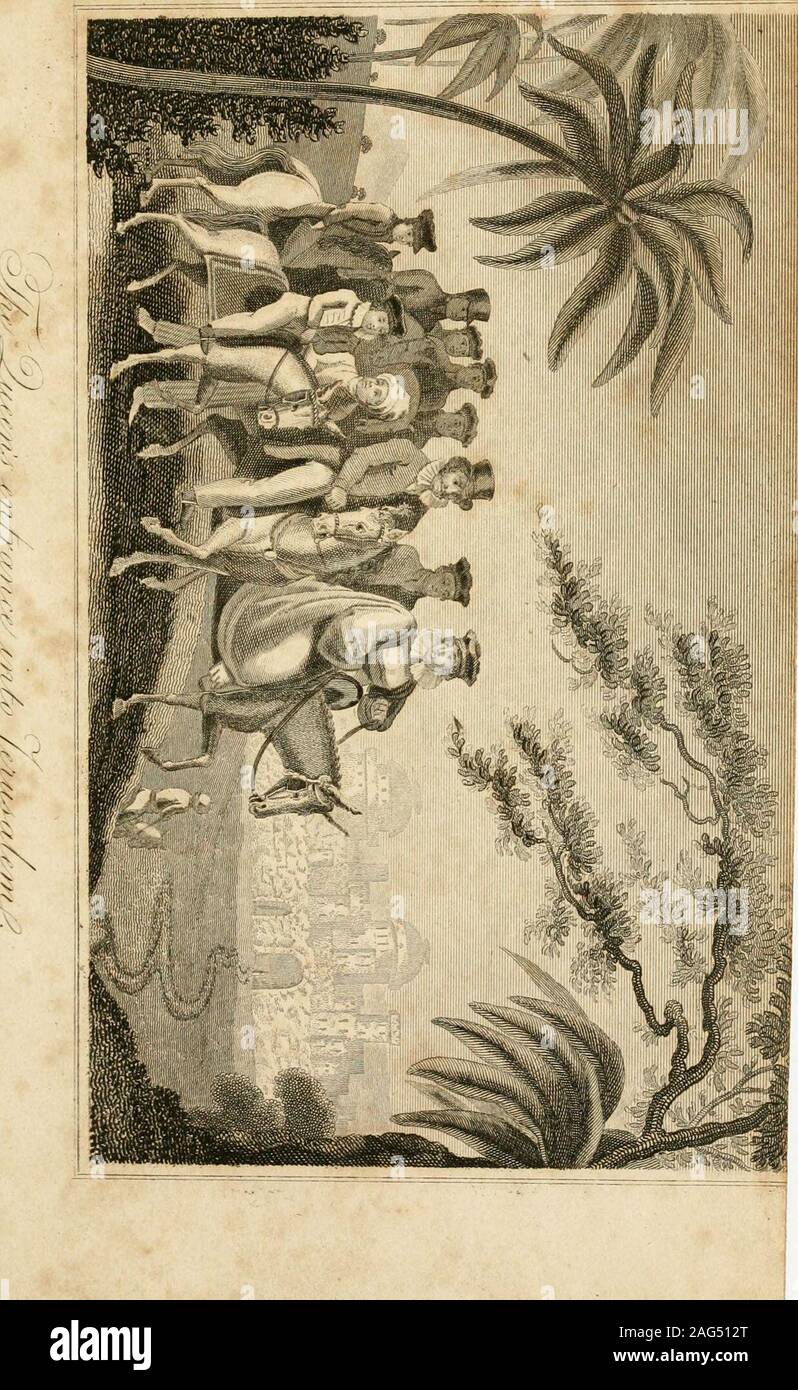 . Voyages and travels of Her Majesty, Caroline, queen of Great Britain : including visits to various parts of Germany, France, Italy, Greece, Palestine, &c. &c., and comprising the latest description of those interesting countries : with remarks on the state of society, religion, manners, customs, antiquities, arts, literature, natural curiosities, &c. &c.. an involuntary manner, as if entering aplace of worship. The Greeks and Catholics shedtorrents of tears; and beginning to cross them-selves with unfeigned devotion, requested per-mission to take oif the covering from their feet,and proceed Stock Photohttps://www.alamy.com/image-license-details/?v=1https://www.alamy.com/voyages-and-travels-of-her-majesty-caroline-queen-of-great-britain-including-visits-to-various-parts-of-germany-france-italy-greece-palestine-c-c-and-comprising-the-latest-description-of-those-interesting-countries-with-remarks-on-the-state-of-society-religion-manners-customs-antiquities-arts-literature-natural-curiosities-c-c-an-involuntary-manner-as-if-entering-aplace-of-worship-the-greeks-and-catholics-shedtorrents-of-tears-and-beginning-to-cross-them-selves-with-unfeigned-devotion-requested-per-mission-to-take-oif-the-covering-from-their-feetand-proceed-image336942112.html
. Voyages and travels of Her Majesty, Caroline, queen of Great Britain : including visits to various parts of Germany, France, Italy, Greece, Palestine, &c. &c., and comprising the latest description of those interesting countries : with remarks on the state of society, religion, manners, customs, antiquities, arts, literature, natural curiosities, &c. &c.. an involuntary manner, as if entering aplace of worship. The Greeks and Catholics shedtorrents of tears; and beginning to cross them-selves with unfeigned devotion, requested per-mission to take oif the covering from their feet,and proceed Stock Photohttps://www.alamy.com/image-license-details/?v=1https://www.alamy.com/voyages-and-travels-of-her-majesty-caroline-queen-of-great-britain-including-visits-to-various-parts-of-germany-france-italy-greece-palestine-c-c-and-comprising-the-latest-description-of-those-interesting-countries-with-remarks-on-the-state-of-society-religion-manners-customs-antiquities-arts-literature-natural-curiosities-c-c-an-involuntary-manner-as-if-entering-aplace-of-worship-the-greeks-and-catholics-shedtorrents-of-tears-and-beginning-to-cross-them-selves-with-unfeigned-devotion-requested-per-mission-to-take-oif-the-covering-from-their-feetand-proceed-image336942112.htmlRM2AG512T–. Voyages and travels of Her Majesty, Caroline, queen of Great Britain : including visits to various parts of Germany, France, Italy, Greece, Palestine, &c. &c., and comprising the latest description of those interesting countries : with remarks on the state of society, religion, manners, customs, antiquities, arts, literature, natural curiosities, &c. &c.. an involuntary manner, as if entering aplace of worship. The Greeks and Catholics shedtorrents of tears; and beginning to cross them-selves with unfeigned devotion, requested per-mission to take oif the covering from their feet,and proceed
 Pompeii, its history, buildings, and antiquities : an account of the destruction of the city with a full description of the remains, and of the recent excavations, and also an itinerary for visitors . On the next page we have something like a wine-basket,made of clay, called dyyo^/c?/, or eyyvo&rjicri, by the Greeks.and incitega by the Eomans, containing two glass vessels, ofthe kind called oivftacfjov, because, being narrow in the neck,the liquor came out drop by drop. DOMESTIC UTENSILS. 559 There is no doubt but that the Eomans possessed glass iusufficient plenty to apply it to purposes of h Stock Photohttps://www.alamy.com/image-license-details/?v=1https://www.alamy.com/pompeii-its-history-buildings-and-antiquities-an-account-of-the-destruction-of-the-city-with-a-full-description-of-the-remains-and-of-the-recent-excavations-and-also-an-itinerary-for-visitors-on-the-next-page-we-have-something-like-a-wine-basketmade-of-clay-called-dyyoc-or-eyyvorjicri-by-the-greeksand-incitega-by-the-eomans-containing-two-glass-vessels-ofthe-kind-called-oivftacfjov-because-being-narrow-in-the-neckthe-liquor-came-out-drop-by-drop-domestic-utensils-559-there-is-no-doubt-but-that-the-eomans-possessed-glass-iusufficient-plenty-to-apply-it-to-purposes-of-h-image339903555.html
Pompeii, its history, buildings, and antiquities : an account of the destruction of the city with a full description of the remains, and of the recent excavations, and also an itinerary for visitors . On the next page we have something like a wine-basket,made of clay, called dyyo^/c?/, or eyyvo&rjicri, by the Greeks.and incitega by the Eomans, containing two glass vessels, ofthe kind called oivftacfjov, because, being narrow in the neck,the liquor came out drop by drop. DOMESTIC UTENSILS. 559 There is no doubt but that the Eomans possessed glass iusufficient plenty to apply it to purposes of h Stock Photohttps://www.alamy.com/image-license-details/?v=1https://www.alamy.com/pompeii-its-history-buildings-and-antiquities-an-account-of-the-destruction-of-the-city-with-a-full-description-of-the-remains-and-of-the-recent-excavations-and-also-an-itinerary-for-visitors-on-the-next-page-we-have-something-like-a-wine-basketmade-of-clay-called-dyyoc-or-eyyvorjicri-by-the-greeksand-incitega-by-the-eomans-containing-two-glass-vessels-ofthe-kind-called-oivftacfjov-because-being-narrow-in-the-neckthe-liquor-came-out-drop-by-drop-domestic-utensils-559-there-is-no-doubt-but-that-the-eomans-possessed-glass-iusufficient-plenty-to-apply-it-to-purposes-of-h-image339903555.htmlRM2AMYXCK–Pompeii, its history, buildings, and antiquities : an account of the destruction of the city with a full description of the remains, and of the recent excavations, and also an itinerary for visitors . On the next page we have something like a wine-basket,made of clay, called dyyo^/c?/, or eyyvo&rjicri, by the Greeks.and incitega by the Eomans, containing two glass vessels, ofthe kind called oivftacfjov, because, being narrow in the neck,the liquor came out drop by drop. DOMESTIC UTENSILS. 559 There is no doubt but that the Eomans possessed glass iusufficient plenty to apply it to purposes of h
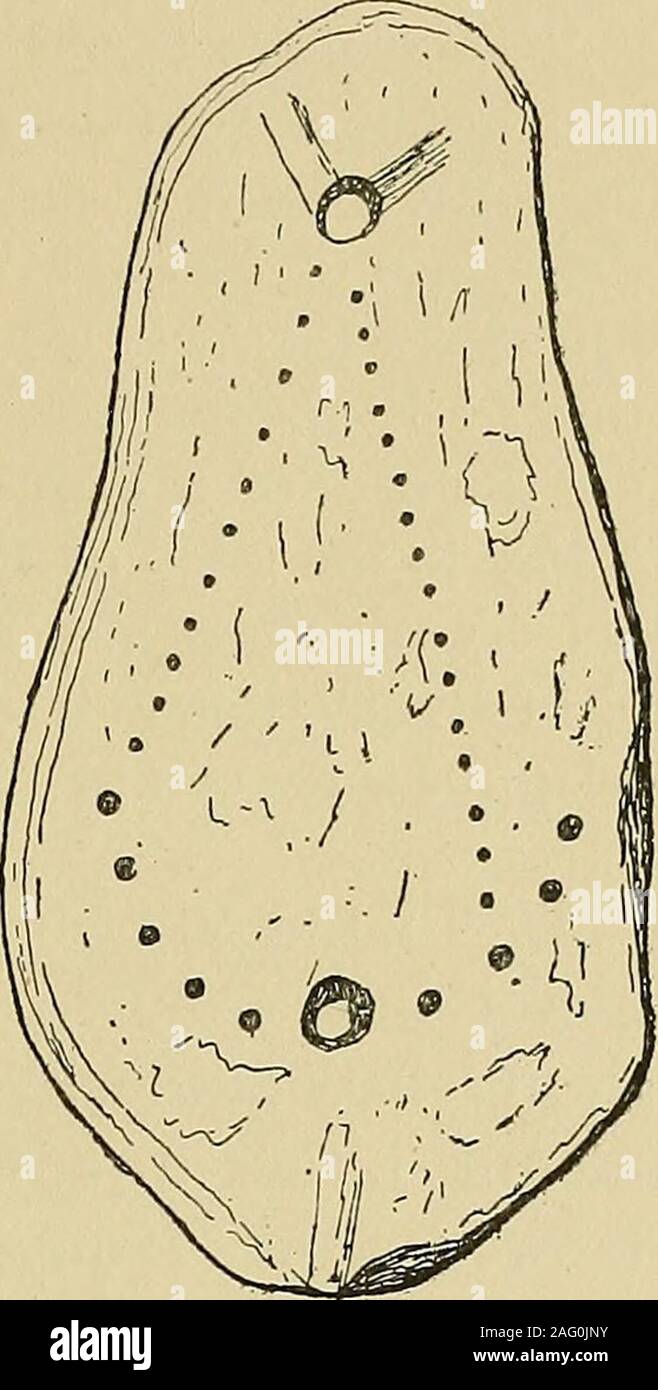 . Archæology and false antiquities. of modern civilisationthe inhabitants of the Old World were savages. (2) From this archaic stratum of humanity some tribes THE DISPUTED OBJECTS 249 found their way to the West of Scotland, and others toAustralia. (3) Their divergence from the common stock took placebefore the rise of the civilisations of the Greeks, Egyptians,and Babylonians, that is, at least 5000 B.C. (4) The immigrants to the Clyde became graduallymore civilised while still retainingreminiscences of their primitivecult. (5) At a time subsequent to400 A.D.,1 long after the Neolithicperiod Stock Photohttps://www.alamy.com/image-license-details/?v=1https://www.alamy.com/archology-and-false-antiquities-of-modern-civilisationthe-inhabitants-of-the-old-world-were-savages-2-from-this-archaic-stratum-of-humanity-some-tribes-the-disputed-objects-249-found-their-way-to-the-west-of-scotland-and-others-toaustralia-3-their-divergence-from-the-common-stock-took-placebefore-the-rise-of-the-civilisations-of-the-greeks-egyptiansand-babylonians-that-is-at-least-5000-bc-4-the-immigrants-to-the-clyde-became-graduallymore-civilised-while-still-retainingreminiscences-of-their-primitivecult-5-at-a-time-subsequent-to400-ad1-long-after-the-neolithicperiod-image336846215.html
. Archæology and false antiquities. of modern civilisationthe inhabitants of the Old World were savages. (2) From this archaic stratum of humanity some tribes THE DISPUTED OBJECTS 249 found their way to the West of Scotland, and others toAustralia. (3) Their divergence from the common stock took placebefore the rise of the civilisations of the Greeks, Egyptians,and Babylonians, that is, at least 5000 B.C. (4) The immigrants to the Clyde became graduallymore civilised while still retainingreminiscences of their primitivecult. (5) At a time subsequent to400 A.D.,1 long after the Neolithicperiod Stock Photohttps://www.alamy.com/image-license-details/?v=1https://www.alamy.com/archology-and-false-antiquities-of-modern-civilisationthe-inhabitants-of-the-old-world-were-savages-2-from-this-archaic-stratum-of-humanity-some-tribes-the-disputed-objects-249-found-their-way-to-the-west-of-scotland-and-others-toaustralia-3-their-divergence-from-the-common-stock-took-placebefore-the-rise-of-the-civilisations-of-the-greeks-egyptiansand-babylonians-that-is-at-least-5000-bc-4-the-immigrants-to-the-clyde-became-graduallymore-civilised-while-still-retainingreminiscences-of-their-primitivecult-5-at-a-time-subsequent-to400-ad1-long-after-the-neolithicperiod-image336846215.htmlRM2AG0JNY–. Archæology and false antiquities. of modern civilisationthe inhabitants of the Old World were savages. (2) From this archaic stratum of humanity some tribes THE DISPUTED OBJECTS 249 found their way to the West of Scotland, and others toAustralia. (3) Their divergence from the common stock took placebefore the rise of the civilisations of the Greeks, Egyptians,and Babylonians, that is, at least 5000 B.C. (4) The immigrants to the Clyde became graduallymore civilised while still retainingreminiscences of their primitivecult. (5) At a time subsequent to400 A.D.,1 long after the Neolithicperiod
 The museum of classical antiquities : being a series of essays on ancient art . f whatever nature it might have been, as designed by Phidias.NO. IV. F F 402 EASTERN PEDIMENT OF THE PARTHENON. ethical as contrasted with her physical nature,—and assert thepre-eminence in wisdom of the Athenians over the other Greeks,by reason of the power and attributes of the virgin goddess. This soaring attitude of Minerva, raised from the groundand rising upwards with extended arms, is in perfect analogywith the subject of this pediment as distinguished from thewestern. In the one all is conflict and contenti Stock Photohttps://www.alamy.com/image-license-details/?v=1https://www.alamy.com/the-museum-of-classical-antiquities-being-a-series-of-essays-on-ancient-art-f-whatever-nature-it-might-have-been-as-designed-by-phidiasno-iv-f-f-402-eastern-pediment-of-the-parthenon-ethical-as-contrasted-with-her-physical-natureand-assert-thepre-eminence-in-wisdom-of-the-athenians-over-the-other-greeksby-reason-of-the-power-and-attributes-of-the-virgin-goddess-this-soaring-attitude-of-minerva-raised-from-the-groundand-rising-upwards-with-extended-arms-is-in-perfect-analogywith-the-subject-of-this-pediment-as-distinguished-from-thewestern-in-the-one-all-is-conflict-and-contenti-image342684453.html
The museum of classical antiquities : being a series of essays on ancient art . f whatever nature it might have been, as designed by Phidias.NO. IV. F F 402 EASTERN PEDIMENT OF THE PARTHENON. ethical as contrasted with her physical nature,—and assert thepre-eminence in wisdom of the Athenians over the other Greeks,by reason of the power and attributes of the virgin goddess. This soaring attitude of Minerva, raised from the groundand rising upwards with extended arms, is in perfect analogywith the subject of this pediment as distinguished from thewestern. In the one all is conflict and contenti Stock Photohttps://www.alamy.com/image-license-details/?v=1https://www.alamy.com/the-museum-of-classical-antiquities-being-a-series-of-essays-on-ancient-art-f-whatever-nature-it-might-have-been-as-designed-by-phidiasno-iv-f-f-402-eastern-pediment-of-the-parthenon-ethical-as-contrasted-with-her-physical-natureand-assert-thepre-eminence-in-wisdom-of-the-athenians-over-the-other-greeksby-reason-of-the-power-and-attributes-of-the-virgin-goddess-this-soaring-attitude-of-minerva-raised-from-the-groundand-rising-upwards-with-extended-arms-is-in-perfect-analogywith-the-subject-of-this-pediment-as-distinguished-from-thewestern-in-the-one-all-is-conflict-and-contenti-image342684453.htmlRM2AWEHED–The museum of classical antiquities : being a series of essays on ancient art . f whatever nature it might have been, as designed by Phidias.NO. IV. F F 402 EASTERN PEDIMENT OF THE PARTHENON. ethical as contrasted with her physical nature,—and assert thepre-eminence in wisdom of the Athenians over the other Greeks,by reason of the power and attributes of the virgin goddess. This soaring attitude of Minerva, raised from the groundand rising upwards with extended arms, is in perfect analogywith the subject of this pediment as distinguished from thewestern. In the one all is conflict and contenti
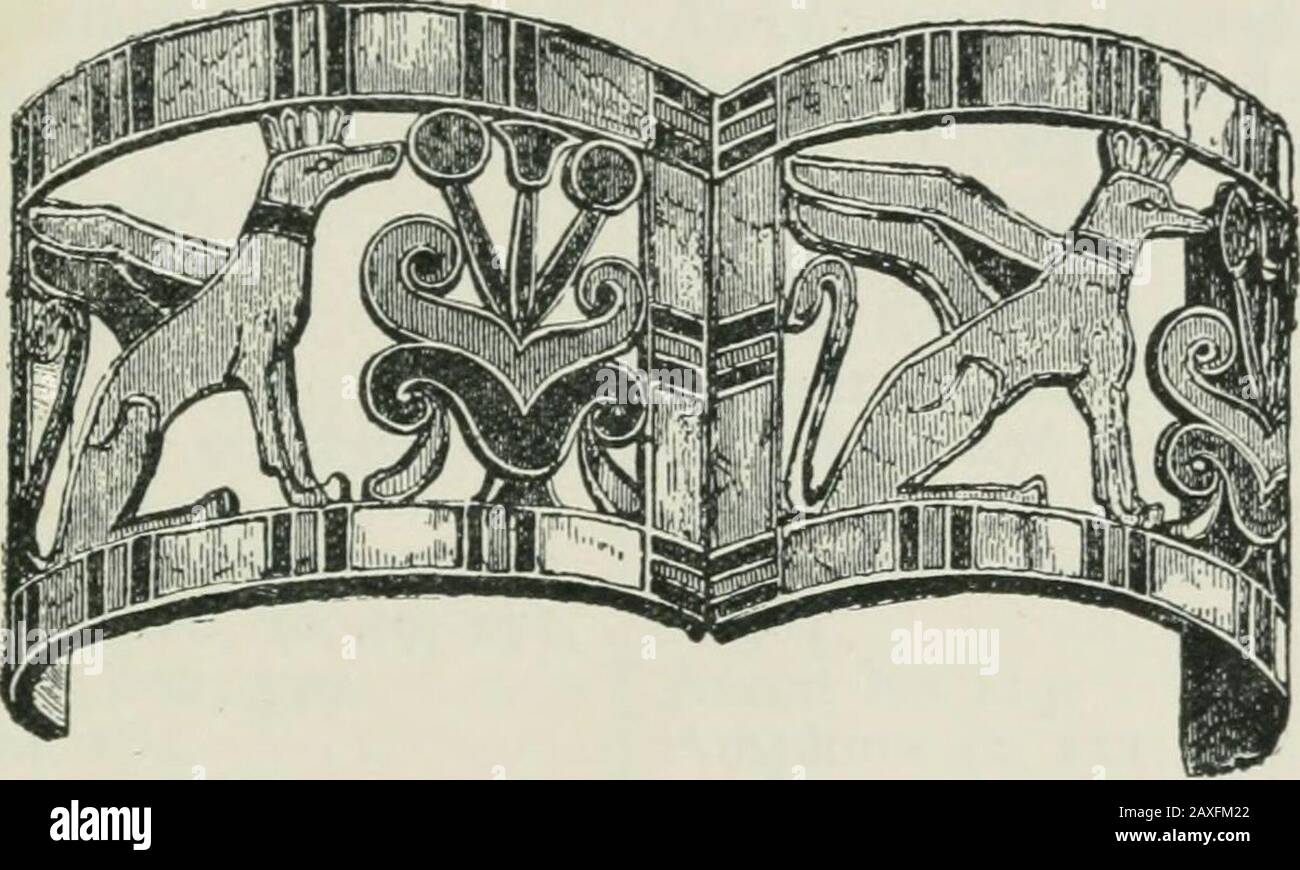 Manual of Egyptian archæology and guide to the study of antiquities in EgyptFor the use of students and travellers . arged and deformed. Theywere found attached to the wig on the head of themummy. The bracelets of the high-priest Pinotem III.,found on the arms of the mummy, are mere circlesof gold rounded and encrusted with coloured glassand carnelian, similar to those still made by theSudanese blacks. The settlement of Greeks inEgypt only very gradually modified the style ofEgyptian gold work, although eventually Greek typeswere substituted for native art. The gold jewels DECADENCE OF JEWELLE Stock Photohttps://www.alamy.com/image-license-details/?v=1https://www.alamy.com/manual-of-egyptian-archology-and-guide-to-the-study-of-antiquities-in-egyptfor-the-use-of-students-and-travellers-arged-and-deformed-theywere-found-attached-to-the-wig-on-the-head-of-themummy-the-bracelets-of-the-high-priest-pinotem-iiifound-on-the-arms-of-the-mummy-are-mere-circlesof-gold-rounded-and-encrusted-with-coloured-glassand-carnelian-similar-to-those-still-made-by-thesudanese-blacks-the-settlement-of-greeks-inegypt-only-very-gradually-modified-the-style-ofegyptian-gold-work-although-eventually-greek-typeswere-substituted-for-native-art-the-gold-jewels-decadence-of-jewelle-image343323066.html
Manual of Egyptian archæology and guide to the study of antiquities in EgyptFor the use of students and travellers . arged and deformed. Theywere found attached to the wig on the head of themummy. The bracelets of the high-priest Pinotem III.,found on the arms of the mummy, are mere circlesof gold rounded and encrusted with coloured glassand carnelian, similar to those still made by theSudanese blacks. The settlement of Greeks inEgypt only very gradually modified the style ofEgyptian gold work, although eventually Greek typeswere substituted for native art. The gold jewels DECADENCE OF JEWELLE Stock Photohttps://www.alamy.com/image-license-details/?v=1https://www.alamy.com/manual-of-egyptian-archology-and-guide-to-the-study-of-antiquities-in-egyptfor-the-use-of-students-and-travellers-arged-and-deformed-theywere-found-attached-to-the-wig-on-the-head-of-themummy-the-bracelets-of-the-high-priest-pinotem-iiifound-on-the-arms-of-the-mummy-are-mere-circlesof-gold-rounded-and-encrusted-with-coloured-glassand-carnelian-similar-to-those-still-made-by-thesudanese-blacks-the-settlement-of-greeks-inegypt-only-very-gradually-modified-the-style-ofegyptian-gold-work-although-eventually-greek-typeswere-substituted-for-native-art-the-gold-jewels-decadence-of-jewelle-image343323066.htmlRM2AXFM22–Manual of Egyptian archæology and guide to the study of antiquities in EgyptFor the use of students and travellers . arged and deformed. Theywere found attached to the wig on the head of themummy. The bracelets of the high-priest Pinotem III.,found on the arms of the mummy, are mere circlesof gold rounded and encrusted with coloured glassand carnelian, similar to those still made by theSudanese blacks. The settlement of Greeks inEgypt only very gradually modified the style ofEgyptian gold work, although eventually Greek typeswere substituted for native art. The gold jewels DECADENCE OF JEWELLE
 Roman antiquities: or, An account of the manners and customs of the Romans; . ged, luxury seizedall ranks.^ The pleasures of the table became the chief objectof attention. Every thing was ransacked to gratify the appetite.^The Romans at first sat at meals,* as did also the Greeks.Homers heroes sat on different seats ^ around the Avail, with asmall table before each, on which the meat and drink were set.So the Germans and Spaniards.^ The custom of reclining ^ on couches (lecti vel tori) Avas introduced from the nations of the East, and at first was adopted only by the men, but afterwards allowe Stock Photohttps://www.alamy.com/image-license-details/?v=1https://www.alamy.com/roman-antiquities-or-an-account-of-the-manners-and-customs-of-the-romans-ged-luxury-seizedall-ranks-the-pleasures-of-the-table-became-the-chief-objectof-attention-every-thing-was-ransacked-to-gratify-the-appetitethe-romans-at-first-sat-at-meals-as-did-also-the-greekshomers-heroes-sat-on-different-seats-around-the-avail-with-asmall-table-before-each-on-which-the-meat-and-drink-were-setso-the-germans-and-spaniards-the-custom-of-reclining-on-couches-lecti-vel-tori-avas-introduced-from-the-nations-of-the-east-and-at-first-was-adopted-only-by-the-men-but-afterwards-allowe-image339997727.html
Roman antiquities: or, An account of the manners and customs of the Romans; . ged, luxury seizedall ranks.^ The pleasures of the table became the chief objectof attention. Every thing was ransacked to gratify the appetite.^The Romans at first sat at meals,* as did also the Greeks.Homers heroes sat on different seats ^ around the Avail, with asmall table before each, on which the meat and drink were set.So the Germans and Spaniards.^ The custom of reclining ^ on couches (lecti vel tori) Avas introduced from the nations of the East, and at first was adopted only by the men, but afterwards allowe Stock Photohttps://www.alamy.com/image-license-details/?v=1https://www.alamy.com/roman-antiquities-or-an-account-of-the-manners-and-customs-of-the-romans-ged-luxury-seizedall-ranks-the-pleasures-of-the-table-became-the-chief-objectof-attention-every-thing-was-ransacked-to-gratify-the-appetitethe-romans-at-first-sat-at-meals-as-did-also-the-greekshomers-heroes-sat-on-different-seats-around-the-avail-with-asmall-table-before-each-on-which-the-meat-and-drink-were-setso-the-germans-and-spaniards-the-custom-of-reclining-on-couches-lecti-vel-tori-avas-introduced-from-the-nations-of-the-east-and-at-first-was-adopted-only-by-the-men-but-afterwards-allowe-image339997727.htmlRM2AN46FY–Roman antiquities: or, An account of the manners and customs of the Romans; . ged, luxury seizedall ranks.^ The pleasures of the table became the chief objectof attention. Every thing was ransacked to gratify the appetite.^The Romans at first sat at meals,* as did also the Greeks.Homers heroes sat on different seats ^ around the Avail, with asmall table before each, on which the meat and drink were set.So the Germans and Spaniards.^ The custom of reclining ^ on couches (lecti vel tori) Avas introduced from the nations of the East, and at first was adopted only by the men, but afterwards allowe
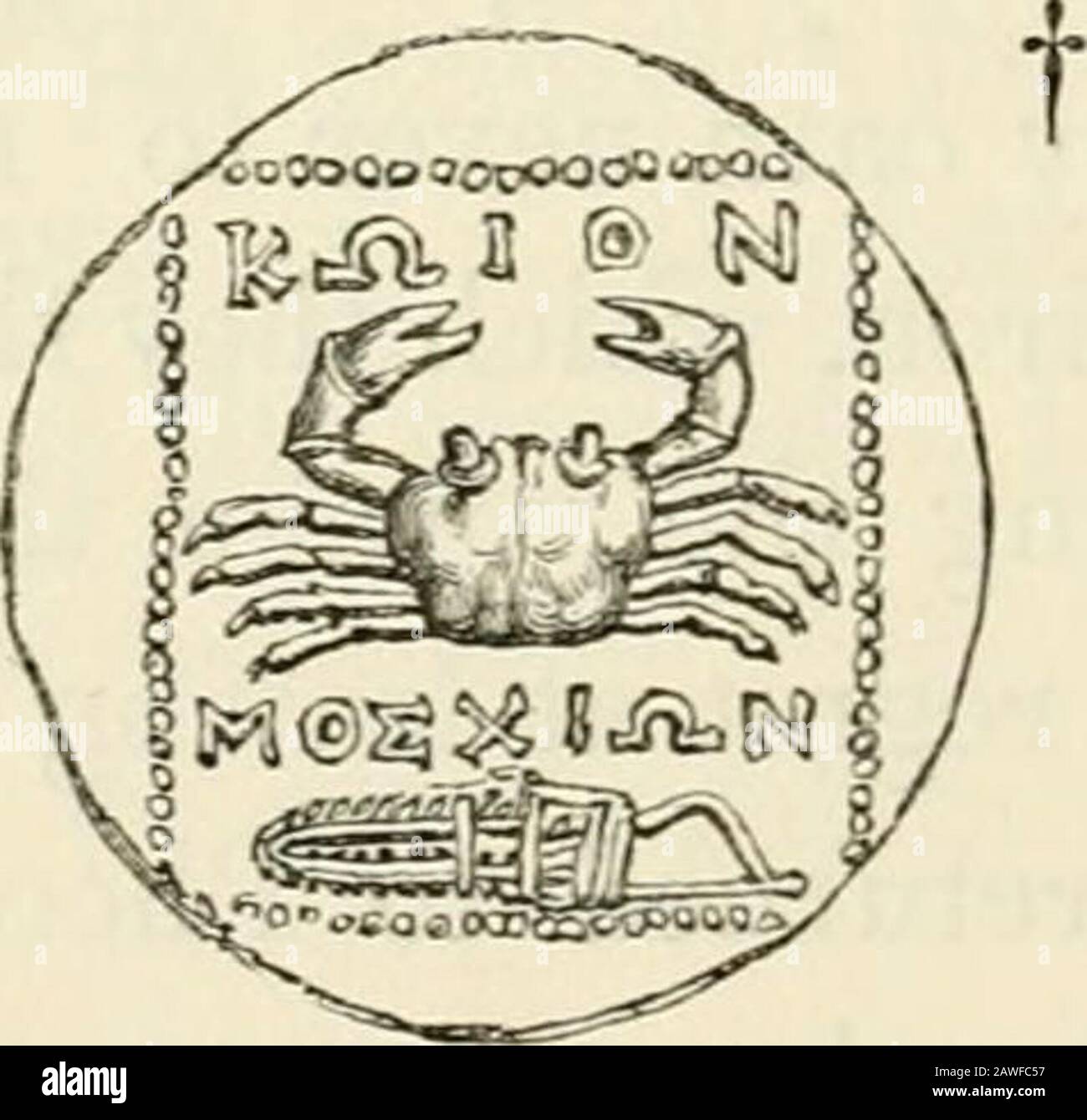 The museum of classical antiquities : being a series of essays on ancient art . ocas followed thefounders; and Sistinus shows that this fish is the dog-fish,which abounds in those seas. The wolf is said to have beenregarded by the Egyptians as the emblem of the course of thesun, and the animal was also dedicated to Apollo, or the sun,by the Greeks. Macrobius says the year was anciently calledby the Greeks Xu/cajSaiTa, which Pier. Yaleriano derives fromXw)(^w, signifying a wolf. The letter L occurs on several medals, and has been mostlytaken as a numeral by the older numismatists; but as theGre Stock Photohttps://www.alamy.com/image-license-details/?v=1https://www.alamy.com/the-museum-of-classical-antiquities-being-a-series-of-essays-on-ancient-art-ocas-followed-thefounders-and-sistinus-shows-that-this-fish-is-the-dog-fishwhich-abounds-in-those-seas-the-wolf-is-said-to-have-beenregarded-by-the-egyptians-as-the-emblem-of-the-course-of-thesun-and-the-animal-was-also-dedicated-to-apollo-or-the-sunby-the-greeks-macrobius-says-the-year-was-anciently-calledby-the-greeks-xucajsaita-which-pier-yaleriano-derives-fromxww-signifying-a-wolf-the-letter-l-occurs-on-several-medals-and-has-been-mostlytaken-as-a-numeral-by-the-older-numismatists-but-as-thegre-image342702227.html
The museum of classical antiquities : being a series of essays on ancient art . ocas followed thefounders; and Sistinus shows that this fish is the dog-fish,which abounds in those seas. The wolf is said to have beenregarded by the Egyptians as the emblem of the course of thesun, and the animal was also dedicated to Apollo, or the sun,by the Greeks. Macrobius says the year was anciently calledby the Greeks Xu/cajSaiTa, which Pier. Yaleriano derives fromXw)(^w, signifying a wolf. The letter L occurs on several medals, and has been mostlytaken as a numeral by the older numismatists; but as theGre Stock Photohttps://www.alamy.com/image-license-details/?v=1https://www.alamy.com/the-museum-of-classical-antiquities-being-a-series-of-essays-on-ancient-art-ocas-followed-thefounders-and-sistinus-shows-that-this-fish-is-the-dog-fishwhich-abounds-in-those-seas-the-wolf-is-said-to-have-beenregarded-by-the-egyptians-as-the-emblem-of-the-course-of-thesun-and-the-animal-was-also-dedicated-to-apollo-or-the-sunby-the-greeks-macrobius-says-the-year-was-anciently-calledby-the-greeks-xucajsaita-which-pier-yaleriano-derives-fromxww-signifying-a-wolf-the-letter-l-occurs-on-several-medals-and-has-been-mostlytaken-as-a-numeral-by-the-older-numismatists-but-as-thegre-image342702227.htmlRM2AWFC57–The museum of classical antiquities : being a series of essays on ancient art . ocas followed thefounders; and Sistinus shows that this fish is the dog-fish,which abounds in those seas. The wolf is said to have beenregarded by the Egyptians as the emblem of the course of thesun, and the animal was also dedicated to Apollo, or the sun,by the Greeks. Macrobius says the year was anciently calledby the Greeks Xu/cajSaiTa, which Pier. Yaleriano derives fromXw)(^w, signifying a wolf. The letter L occurs on several medals, and has been mostlytaken as a numeral by the older numismatists; but as theGre
 The Book of Job : translated from the Hebrew on the basis of the authorized version : explained in a large body of notes, critical and exegetical, and illustrated by extracts from various works on antiquities, geography, science, etc., also by eighty woodcuts and a map ; with six preliminary dissertations, an analytical paraphrase, and Meisner's and Doederlein's selection of the various readings of the Hebrew text from the collations of Kennicott and De Rossi . as generally sup-posed, by approaching the fore-finger to the lips ; and the Greeks erroneously concluded that the youthful Harpocrate Stock Photohttps://www.alamy.com/image-license-details/?v=1https://www.alamy.com/the-book-of-job-translated-from-the-hebrew-on-the-basis-of-the-authorized-version-explained-in-a-large-body-of-notes-critical-and-exegetical-and-illustrated-by-extracts-from-various-works-on-antiquities-geography-science-etc-also-by-eighty-woodcuts-and-a-map-with-six-preliminary-dissertations-an-analytical-paraphrase-and-meisners-and-doederleins-selection-of-the-various-readings-of-the-hebrew-text-from-the-collations-of-kennicott-and-de-rossi-as-generally-sup-posed-by-approaching-the-fore-finger-to-the-lips-and-the-greeks-erroneously-concluded-that-the-youthful-harpocrate-image340203972.html
The Book of Job : translated from the Hebrew on the basis of the authorized version : explained in a large body of notes, critical and exegetical, and illustrated by extracts from various works on antiquities, geography, science, etc., also by eighty woodcuts and a map ; with six preliminary dissertations, an analytical paraphrase, and Meisner's and Doederlein's selection of the various readings of the Hebrew text from the collations of Kennicott and De Rossi . as generally sup-posed, by approaching the fore-finger to the lips ; and the Greeks erroneously concluded that the youthful Harpocrate Stock Photohttps://www.alamy.com/image-license-details/?v=1https://www.alamy.com/the-book-of-job-translated-from-the-hebrew-on-the-basis-of-the-authorized-version-explained-in-a-large-body-of-notes-critical-and-exegetical-and-illustrated-by-extracts-from-various-works-on-antiquities-geography-science-etc-also-by-eighty-woodcuts-and-a-map-with-six-preliminary-dissertations-an-analytical-paraphrase-and-meisners-and-doederleins-selection-of-the-various-readings-of-the-hebrew-text-from-the-collations-of-kennicott-and-de-rossi-as-generally-sup-posed-by-approaching-the-fore-finger-to-the-lips-and-the-greeks-erroneously-concluded-that-the-youthful-harpocrate-image340203972.htmlRM2ANDHHT–The Book of Job : translated from the Hebrew on the basis of the authorized version : explained in a large body of notes, critical and exegetical, and illustrated by extracts from various works on antiquities, geography, science, etc., also by eighty woodcuts and a map ; with six preliminary dissertations, an analytical paraphrase, and Meisner's and Doederlein's selection of the various readings of the Hebrew text from the collations of Kennicott and De Rossi . as generally sup-posed, by approaching the fore-finger to the lips ; and the Greeks erroneously concluded that the youthful Harpocrate
![The seven great monarchies of the ancient eastern world: or, The history, geography and antiquities of Chaldæa, Assyria, Babylon, Media, Persia, Parthia, and Sassanian or New Persian empire . The solid castings are comparatively rare, and representednone but animal forms. Lions, which seem to have beenused as weights, occur most frequently, i^ [PI. LXXIV., Fig. 1.]None are of any great size; nor have we any evidence that theAssyrians could cast large masses of metal. They seem tohave used castings, not (as the Greeks and the moderns) for thegreater works of art, but only for the smaller. The f Stock Photo The seven great monarchies of the ancient eastern world: or, The history, geography and antiquities of Chaldæa, Assyria, Babylon, Media, Persia, Parthia, and Sassanian or New Persian empire . The solid castings are comparatively rare, and representednone but animal forms. Lions, which seem to have beenused as weights, occur most frequently, i^ [PI. LXXIV., Fig. 1.]None are of any great size; nor have we any evidence that theAssyrians could cast large masses of metal. They seem tohave used castings, not (as the Greeks and the moderns) for thegreater works of art, but only for the smaller. The f Stock Photo](https://c8.alamy.com/comp/2AN16T6/the-seven-great-monarchies-of-the-ancient-eastern-world-or-the-history-geography-and-antiquities-of-chalda-assyria-babylon-media-persia-parthia-and-sassanian-or-new-persian-empire-the-solid-castings-are-comparatively-rare-and-representednone-but-animal-forms-lions-which-seem-to-have-beenused-as-weights-occur-most-frequently-i-pi-lxxiv-fig-1-none-are-of-any-great-size-nor-have-we-any-evidence-that-theassyrians-could-cast-large-masses-of-metal-they-seem-tohave-used-castings-not-as-the-greeks-and-the-moderns-for-thegreater-works-of-art-but-only-for-the-smaller-the-f-2AN16T6.jpg) The seven great monarchies of the ancient eastern world: or, The history, geography and antiquities of Chaldæa, Assyria, Babylon, Media, Persia, Parthia, and Sassanian or New Persian empire . The solid castings are comparatively rare, and representednone but animal forms. Lions, which seem to have beenused as weights, occur most frequently, i^ [PI. LXXIV., Fig. 1.]None are of any great size; nor have we any evidence that theAssyrians could cast large masses of metal. They seem tohave used castings, not (as the Greeks and the moderns) for thegreater works of art, but only for the smaller. The f Stock Photohttps://www.alamy.com/image-license-details/?v=1https://www.alamy.com/the-seven-great-monarchies-of-the-ancient-eastern-world-or-the-history-geography-and-antiquities-of-chalda-assyria-babylon-media-persia-parthia-and-sassanian-or-new-persian-empire-the-solid-castings-are-comparatively-rare-and-representednone-but-animal-forms-lions-which-seem-to-have-beenused-as-weights-occur-most-frequently-i-pi-lxxiv-fig-1-none-are-of-any-great-size-nor-have-we-any-evidence-that-theassyrians-could-cast-large-masses-of-metal-they-seem-tohave-used-castings-not-as-the-greeks-and-the-moderns-for-thegreater-works-of-art-but-only-for-the-smaller-the-f-image339932102.html
The seven great monarchies of the ancient eastern world: or, The history, geography and antiquities of Chaldæa, Assyria, Babylon, Media, Persia, Parthia, and Sassanian or New Persian empire . The solid castings are comparatively rare, and representednone but animal forms. Lions, which seem to have beenused as weights, occur most frequently, i^ [PI. LXXIV., Fig. 1.]None are of any great size; nor have we any evidence that theAssyrians could cast large masses of metal. They seem tohave used castings, not (as the Greeks and the moderns) for thegreater works of art, but only for the smaller. The f Stock Photohttps://www.alamy.com/image-license-details/?v=1https://www.alamy.com/the-seven-great-monarchies-of-the-ancient-eastern-world-or-the-history-geography-and-antiquities-of-chalda-assyria-babylon-media-persia-parthia-and-sassanian-or-new-persian-empire-the-solid-castings-are-comparatively-rare-and-representednone-but-animal-forms-lions-which-seem-to-have-beenused-as-weights-occur-most-frequently-i-pi-lxxiv-fig-1-none-are-of-any-great-size-nor-have-we-any-evidence-that-theassyrians-could-cast-large-masses-of-metal-they-seem-tohave-used-castings-not-as-the-greeks-and-the-moderns-for-thegreater-works-of-art-but-only-for-the-smaller-the-f-image339932102.htmlRM2AN16T6–The seven great monarchies of the ancient eastern world: or, The history, geography and antiquities of Chaldæa, Assyria, Babylon, Media, Persia, Parthia, and Sassanian or New Persian empire . The solid castings are comparatively rare, and representednone but animal forms. Lions, which seem to have beenused as weights, occur most frequently, i^ [PI. LXXIV., Fig. 1.]None are of any great size; nor have we any evidence that theAssyrians could cast large masses of metal. They seem tohave used castings, not (as the Greeks and the moderns) for thegreater works of art, but only for the smaller. The f
 School dictionary of Greek and Roman antiquities . n amount, in the form of alegacy to any person, than the heres or he-redes should take. This provision securedsomething to the heres or heredes, but stillthe provision was ineflfectual, and the objectof the lex was only accomplished by the LexFalcidia, b. c. 44, which enacted that atestator should not give more than three-fourths in legacies, thus securing a fourthto the heres. LIBER (Pi€lov) a book. The mostcommon material on which books werewritten by the Greeks and Romans, was thethin coats or rind (liber, whence the Latinname for a book) Stock Photohttps://www.alamy.com/image-license-details/?v=1https://www.alamy.com/school-dictionary-of-greek-and-roman-antiquities-n-amount-in-the-form-of-alegacy-to-any-person-than-the-heres-or-he-redes-should-take-this-provision-securedsomething-to-the-heres-or-heredes-but-stillthe-provision-was-ineflfectual-and-the-objectof-the-lex-was-only-accomplished-by-the-lexfalcidia-b-c-44-which-enacted-that-atestator-should-not-give-more-than-three-fourths-in-legacies-thus-securing-a-fourthto-the-heres-liber-pilov-a-book-the-mostcommon-material-on-which-books-werewritten-by-the-greeks-and-romans-was-thethin-coats-or-rind-liber-whence-the-latinname-for-a-book-image338476186.html
School dictionary of Greek and Roman antiquities . n amount, in the form of alegacy to any person, than the heres or he-redes should take. This provision securedsomething to the heres or heredes, but stillthe provision was ineflfectual, and the objectof the lex was only accomplished by the LexFalcidia, b. c. 44, which enacted that atestator should not give more than three-fourths in legacies, thus securing a fourthto the heres. LIBER (Pi€lov) a book. The mostcommon material on which books werewritten by the Greeks and Romans, was thethin coats or rind (liber, whence the Latinname for a book) Stock Photohttps://www.alamy.com/image-license-details/?v=1https://www.alamy.com/school-dictionary-of-greek-and-roman-antiquities-n-amount-in-the-form-of-alegacy-to-any-person-than-the-heres-or-he-redes-should-take-this-provision-securedsomething-to-the-heres-or-heredes-but-stillthe-provision-was-ineflfectual-and-the-objectof-the-lex-was-only-accomplished-by-the-lexfalcidia-b-c-44-which-enacted-that-atestator-should-not-give-more-than-three-fourths-in-legacies-thus-securing-a-fourthto-the-heres-liber-pilov-a-book-the-mostcommon-material-on-which-books-werewritten-by-the-greeks-and-romans-was-thethin-coats-or-rind-liber-whence-the-latinname-for-a-book-image338476186.htmlRM2AJJWR6–School dictionary of Greek and Roman antiquities . n amount, in the form of alegacy to any person, than the heres or he-redes should take. This provision securedsomething to the heres or heredes, but stillthe provision was ineflfectual, and the objectof the lex was only accomplished by the LexFalcidia, b. c. 44, which enacted that atestator should not give more than three-fourths in legacies, thus securing a fourthto the heres. LIBER (Pi€lov) a book. The mostcommon material on which books werewritten by the Greeks and Romans, was thethin coats or rind (liber, whence the Latinname for a book)
![School dictionary of Greek and Roman antiquities . uished Romans werealso the projectors of states and cities, whichwere in a certain relation of subjection or CLIPEUS. dependence to Rome. In the timeCicero we also find patronus in the sens(of adviser, advocate, or defender, opposecto cliens in the sense of the person defendecor the consultor,—a use of the word whiclimust be referred to the original characteiof the patronus. CLIENTELA. [Cliens.] CLFPEUS (aairls), the large shieUworn by the Greeks and Romans, whichwas originally of a circular form, and iasaid to have been first used by Proetus Stock Photo School dictionary of Greek and Roman antiquities . uished Romans werealso the projectors of states and cities, whichwere in a certain relation of subjection or CLIPEUS. dependence to Rome. In the timeCicero we also find patronus in the sens(of adviser, advocate, or defender, opposecto cliens in the sense of the person defendecor the consultor,—a use of the word whiclimust be referred to the original characteiof the patronus. CLIENTELA. [Cliens.] CLFPEUS (aairls), the large shieUworn by the Greeks and Romans, whichwas originally of a circular form, and iasaid to have been first used by Proetus Stock Photo](https://c8.alamy.com/comp/2AJKB90/school-dictionary-of-greek-and-roman-antiquities-uished-romans-werealso-the-projectors-of-states-and-cities-whichwere-in-a-certain-relation-of-subjection-or-clipeus-dependence-to-rome-in-the-timecicero-we-also-find-patronus-in-the-sensof-adviser-advocate-or-defender-opposecto-cliens-in-the-sense-of-the-person-defendecor-the-consultora-use-of-the-word-whiclimust-be-referred-to-the-original-characteiof-the-patronus-clientela-cliens-clfpeus-aairls-the-large-shieuworn-by-the-greeks-and-romans-whichwas-originally-of-a-circular-form-and-iasaid-to-have-been-first-used-by-proetus-2AJKB90.jpg) School dictionary of Greek and Roman antiquities . uished Romans werealso the projectors of states and cities, whichwere in a certain relation of subjection or CLIPEUS. dependence to Rome. In the timeCicero we also find patronus in the sens(of adviser, advocate, or defender, opposecto cliens in the sense of the person defendecor the consultor,—a use of the word whiclimust be referred to the original characteiof the patronus. CLIENTELA. [Cliens.] CLFPEUS (aairls), the large shieUworn by the Greeks and Romans, whichwas originally of a circular form, and iasaid to have been first used by Proetus Stock Photohttps://www.alamy.com/image-license-details/?v=1https://www.alamy.com/school-dictionary-of-greek-and-roman-antiquities-uished-romans-werealso-the-projectors-of-states-and-cities-whichwere-in-a-certain-relation-of-subjection-or-clipeus-dependence-to-rome-in-the-timecicero-we-also-find-patronus-in-the-sensof-adviser-advocate-or-defender-opposecto-cliens-in-the-sense-of-the-person-defendecor-the-consultora-use-of-the-word-whiclimust-be-referred-to-the-original-characteiof-the-patronus-clientela-cliens-clfpeus-aairls-the-large-shieuworn-by-the-greeks-and-romans-whichwas-originally-of-a-circular-form-and-iasaid-to-have-been-first-used-by-proetus-image338486764.html
School dictionary of Greek and Roman antiquities . uished Romans werealso the projectors of states and cities, whichwere in a certain relation of subjection or CLIPEUS. dependence to Rome. In the timeCicero we also find patronus in the sens(of adviser, advocate, or defender, opposecto cliens in the sense of the person defendecor the consultor,—a use of the word whiclimust be referred to the original characteiof the patronus. CLIENTELA. [Cliens.] CLFPEUS (aairls), the large shieUworn by the Greeks and Romans, whichwas originally of a circular form, and iasaid to have been first used by Proetus Stock Photohttps://www.alamy.com/image-license-details/?v=1https://www.alamy.com/school-dictionary-of-greek-and-roman-antiquities-uished-romans-werealso-the-projectors-of-states-and-cities-whichwere-in-a-certain-relation-of-subjection-or-clipeus-dependence-to-rome-in-the-timecicero-we-also-find-patronus-in-the-sensof-adviser-advocate-or-defender-opposecto-cliens-in-the-sense-of-the-person-defendecor-the-consultora-use-of-the-word-whiclimust-be-referred-to-the-original-characteiof-the-patronus-clientela-cliens-clfpeus-aairls-the-large-shieuworn-by-the-greeks-and-romans-whichwas-originally-of-a-circular-form-and-iasaid-to-have-been-first-used-by-proetus-image338486764.htmlRM2AJKB90–School dictionary of Greek and Roman antiquities . uished Romans werealso the projectors of states and cities, whichwere in a certain relation of subjection or CLIPEUS. dependence to Rome. In the timeCicero we also find patronus in the sens(of adviser, advocate, or defender, opposecto cliens in the sense of the person defendecor the consultor,—a use of the word whiclimust be referred to the original characteiof the patronus. CLIENTELA. [Cliens.] CLFPEUS (aairls), the large shieUworn by the Greeks and Romans, whichwas originally of a circular form, and iasaid to have been first used by Proetus
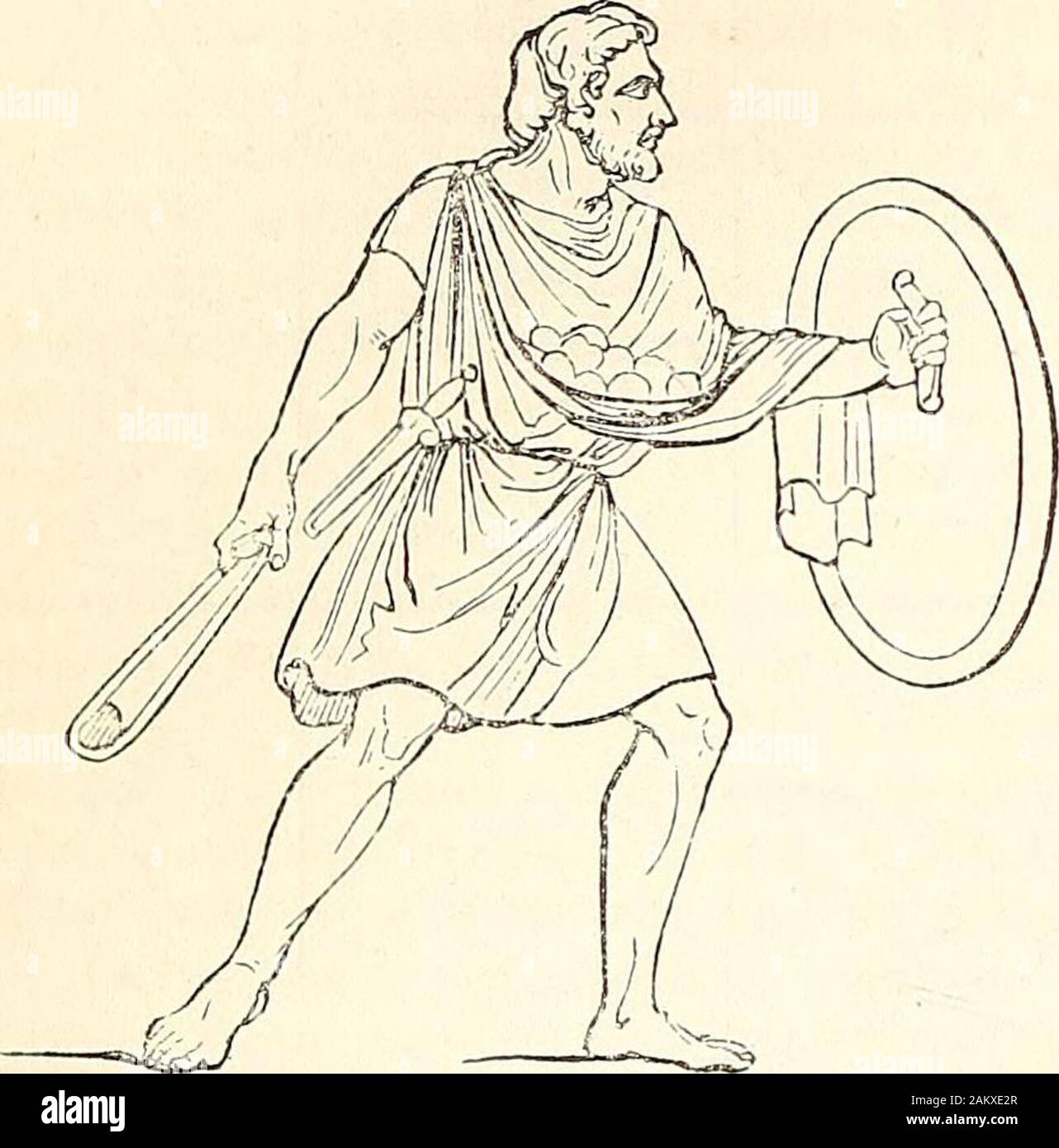 A dictionary of Greek and Roman antiquities.. . readof slingers in these wars. Among the Greeks theAcarnanians in early times attained to the greatestexpertness in the use of this weapon (Thuc. ii. 81);and at a later time the Achaeans, especially the in-habitants of Agium, Patrae, and Dymae, were cele-brated as expert slingers. The slings of these Achae-ans were made of three thongs of leather, and not ofone only, like those of other nations. (Liv. xxxviii.29.) The people, however, who enjoyed the greatestcelebrity as slingers were the natives of the Balearicislands. Their skill in the use of Stock Photohttps://www.alamy.com/image-license-details/?v=1https://www.alamy.com/a-dictionary-of-greek-and-roman-antiquities-readof-slingers-in-these-wars-among-the-greeks-theacarnanians-in-early-times-attained-to-the-greatestexpertness-in-the-use-of-this-weapon-thuc-ii-81and-at-a-later-time-the-achaeans-especially-the-in-habitants-of-agium-patrae-and-dymae-were-cele-brated-as-expert-slingers-the-slings-of-these-achae-ans-were-made-of-three-thongs-of-leather-and-not-ofone-only-like-those-of-other-nations-liv-xxxviii29-the-people-however-who-enjoyed-the-greatestcelebrity-as-slingers-were-the-natives-of-the-balearicislands-their-skill-in-the-use-of-image339257263.html
A dictionary of Greek and Roman antiquities.. . readof slingers in these wars. Among the Greeks theAcarnanians in early times attained to the greatestexpertness in the use of this weapon (Thuc. ii. 81);and at a later time the Achaeans, especially the in-habitants of Agium, Patrae, and Dymae, were cele-brated as expert slingers. The slings of these Achae-ans were made of three thongs of leather, and not ofone only, like those of other nations. (Liv. xxxviii.29.) The people, however, who enjoyed the greatestcelebrity as slingers were the natives of the Balearicislands. Their skill in the use of Stock Photohttps://www.alamy.com/image-license-details/?v=1https://www.alamy.com/a-dictionary-of-greek-and-roman-antiquities-readof-slingers-in-these-wars-among-the-greeks-theacarnanians-in-early-times-attained-to-the-greatestexpertness-in-the-use-of-this-weapon-thuc-ii-81and-at-a-later-time-the-achaeans-especially-the-in-habitants-of-agium-patrae-and-dymae-were-cele-brated-as-expert-slingers-the-slings-of-these-achae-ans-were-made-of-three-thongs-of-leather-and-not-ofone-only-like-those-of-other-nations-liv-xxxviii29-the-people-however-who-enjoyed-the-greatestcelebrity-as-slingers-were-the-natives-of-the-balearicislands-their-skill-in-the-use-of-image339257263.htmlRM2AKXE2R–A dictionary of Greek and Roman antiquities.. . readof slingers in these wars. Among the Greeks theAcarnanians in early times attained to the greatestexpertness in the use of this weapon (Thuc. ii. 81);and at a later time the Achaeans, especially the in-habitants of Agium, Patrae, and Dymae, were cele-brated as expert slingers. The slings of these Achae-ans were made of three thongs of leather, and not ofone only, like those of other nations. (Liv. xxxviii.29.) The people, however, who enjoyed the greatestcelebrity as slingers were the natives of the Balearicislands. Their skill in the use of
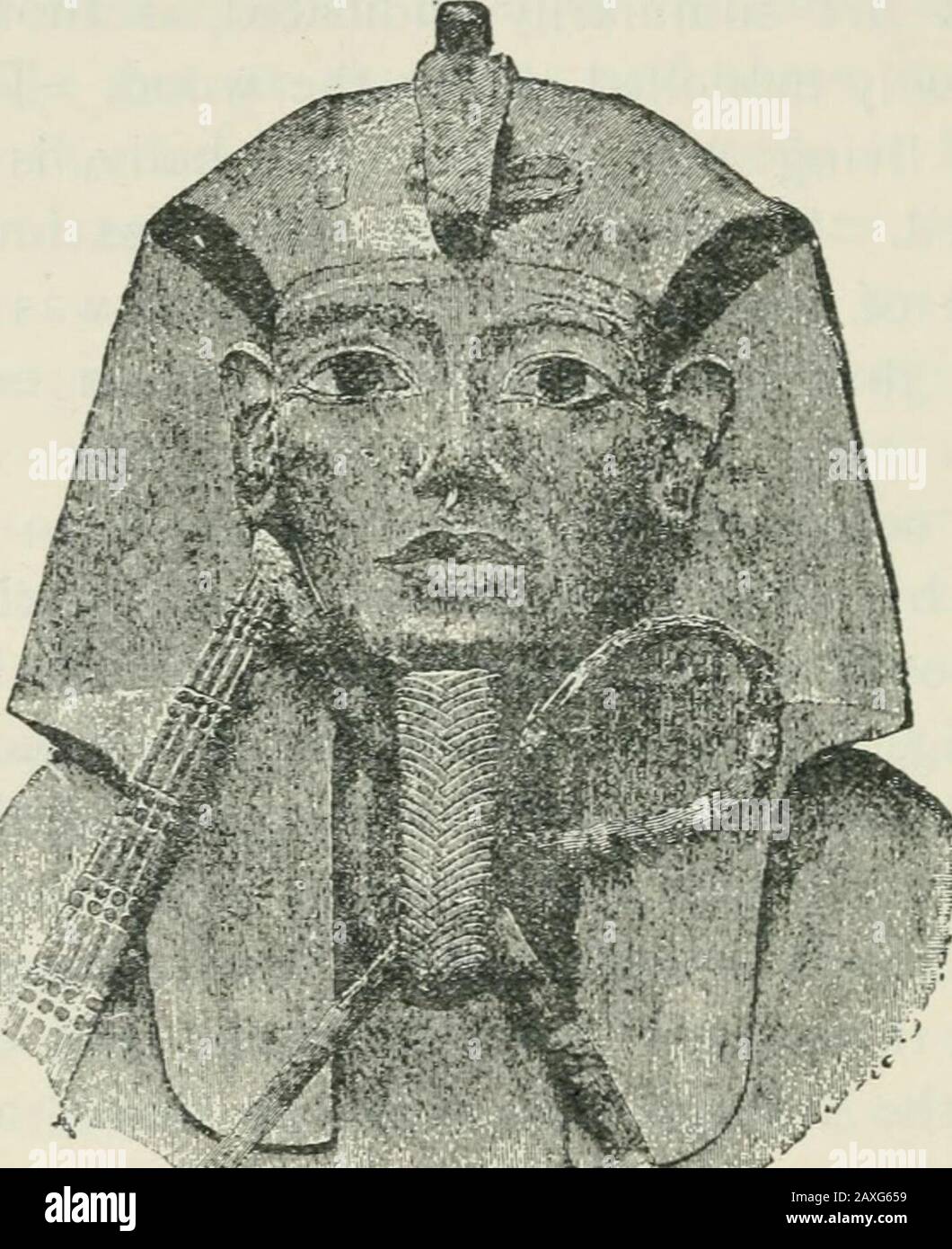 Manual of Egyptian archæology and guide to the study of antiquities in EgyptFor the use of students and travellers . ial, the petti-coat with its symmetrical folds covers his legs, on hisfeet are elegant sandals, and his hands clasp variousemblems, the aiikJi, the girdle tie, the dad, or in thecase of the wife of Sennetmu at Cairo, a wreathof ivy. This sort of mummiform casing is rare under theMemphites. Menkaura, the Mycerinus of the Greeks,has, however, left us a noteworthy example. Theywere very common under the Eleventh Dynasty, butat that time they were often little more than thehollowed Stock Photohttps://www.alamy.com/image-license-details/?v=1https://www.alamy.com/manual-of-egyptian-archology-and-guide-to-the-study-of-antiquities-in-egyptfor-the-use-of-students-and-travellers-ial-the-petti-coat-with-its-symmetrical-folds-covers-his-legs-on-hisfeet-are-elegant-sandals-and-his-hands-clasp-variousemblems-the-aiikji-the-girdle-tie-the-dad-or-in-thecase-of-the-wife-of-sennetmu-at-cairo-a-wreathof-ivy-this-sort-of-mummiform-casing-is-rare-under-thememphites-menkaura-the-mycerinus-of-the-greekshas-however-left-us-a-noteworthy-example-theywere-very-common-under-the-eleventh-dynasty-butat-that-time-they-were-often-little-more-than-thehollowed-image343334133.html
Manual of Egyptian archæology and guide to the study of antiquities in EgyptFor the use of students and travellers . ial, the petti-coat with its symmetrical folds covers his legs, on hisfeet are elegant sandals, and his hands clasp variousemblems, the aiikJi, the girdle tie, the dad, or in thecase of the wife of Sennetmu at Cairo, a wreathof ivy. This sort of mummiform casing is rare under theMemphites. Menkaura, the Mycerinus of the Greeks,has, however, left us a noteworthy example. Theywere very common under the Eleventh Dynasty, butat that time they were often little more than thehollowed Stock Photohttps://www.alamy.com/image-license-details/?v=1https://www.alamy.com/manual-of-egyptian-archology-and-guide-to-the-study-of-antiquities-in-egyptfor-the-use-of-students-and-travellers-ial-the-petti-coat-with-its-symmetrical-folds-covers-his-legs-on-hisfeet-are-elegant-sandals-and-his-hands-clasp-variousemblems-the-aiikji-the-girdle-tie-the-dad-or-in-thecase-of-the-wife-of-sennetmu-at-cairo-a-wreathof-ivy-this-sort-of-mummiform-casing-is-rare-under-thememphites-menkaura-the-mycerinus-of-the-greekshas-however-left-us-a-noteworthy-example-theywere-very-common-under-the-eleventh-dynasty-butat-that-time-they-were-often-little-more-than-thehollowed-image343334133.htmlRM2AXG659–Manual of Egyptian archæology and guide to the study of antiquities in EgyptFor the use of students and travellers . ial, the petti-coat with its symmetrical folds covers his legs, on hisfeet are elegant sandals, and his hands clasp variousemblems, the aiikJi, the girdle tie, the dad, or in thecase of the wife of Sennetmu at Cairo, a wreathof ivy. This sort of mummiform casing is rare under theMemphites. Menkaura, the Mycerinus of the Greeks,has, however, left us a noteworthy example. Theywere very common under the Eleventh Dynasty, butat that time they were often little more than thehollowed
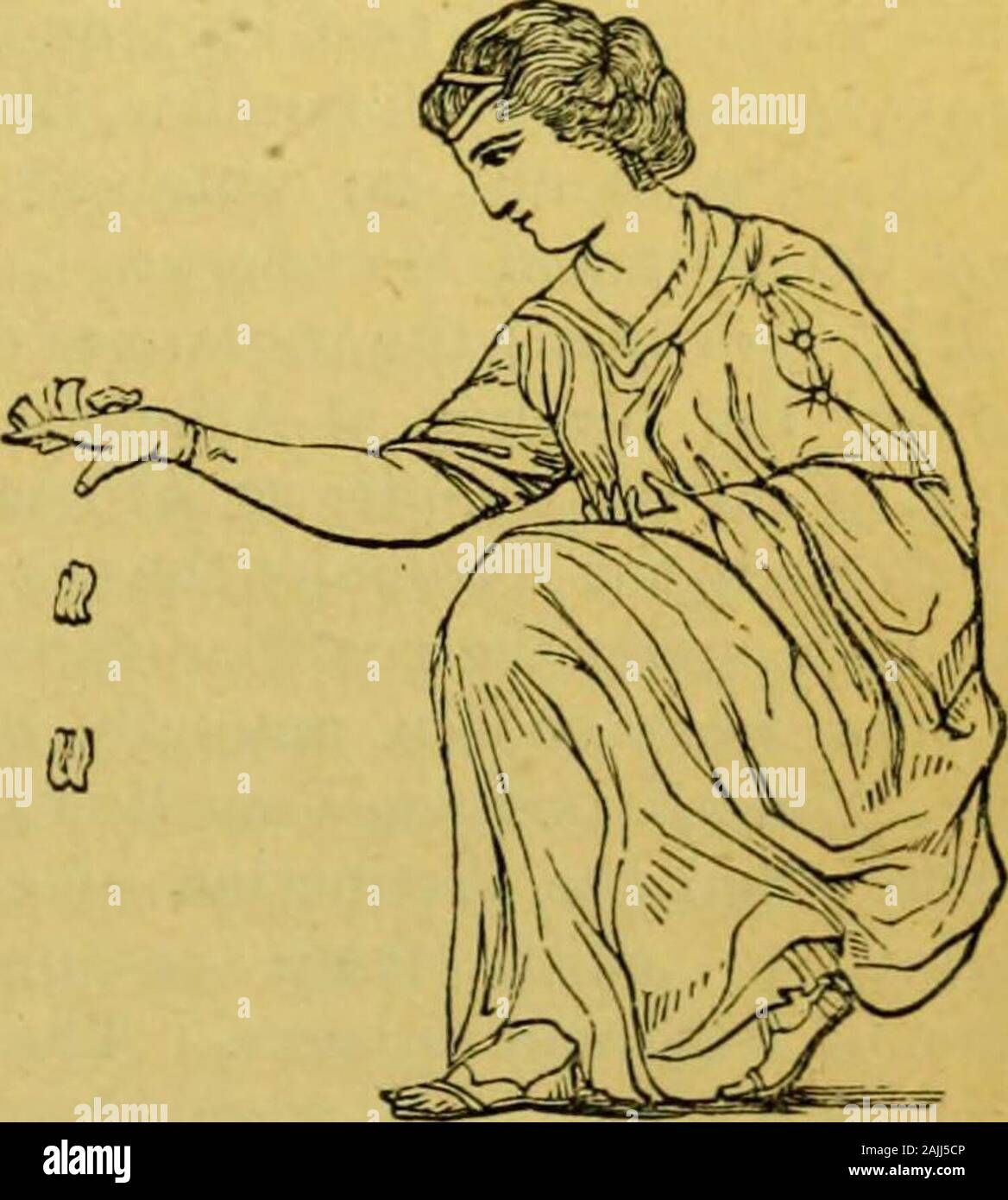 School dictionary of Greek and Roman antiquities . used by the Greeks ofItaly and Sicily. This is the talent alwaysmeant when the word occurs in Homer.This small talent explains the use of theterm great talent {magnum talentum), whichwe find in Latin authors, for the silverAttic talent was great in comparison withthis. But the use of the word by the Ro-mans is altogether very inexact. TALUS. 353 Where talents are mentioned in the clas-sical writers without any specification ofthe standard, we must generally understandthe Attic. TALUS (aaTpdyaXos), a huckle-bone.The huckle-bones of sheep and go Stock Photohttps://www.alamy.com/image-license-details/?v=1https://www.alamy.com/school-dictionary-of-greek-and-roman-antiquities-used-by-the-greeks-ofitaly-and-sicily-this-is-the-talent-alwaysmeant-when-the-word-occurs-in-homerthis-small-talent-explains-the-use-of-theterm-great-talent-magnum-talentum-whichwe-find-in-latin-authors-for-the-silverattic-talent-was-great-in-comparison-withthis-but-the-use-of-the-word-by-the-ro-mans-is-altogether-very-inexact-talus-353-where-talents-are-mentioned-in-the-clas-sical-writers-without-any-specification-ofthe-standard-we-must-generally-understandthe-attic-talus-aatpdyaxos-a-huckle-bonethe-huckle-bones-of-sheep-and-go-image338460214.html
School dictionary of Greek and Roman antiquities . used by the Greeks ofItaly and Sicily. This is the talent alwaysmeant when the word occurs in Homer.This small talent explains the use of theterm great talent {magnum talentum), whichwe find in Latin authors, for the silverAttic talent was great in comparison withthis. But the use of the word by the Ro-mans is altogether very inexact. TALUS. 353 Where talents are mentioned in the clas-sical writers without any specification ofthe standard, we must generally understandthe Attic. TALUS (aaTpdyaXos), a huckle-bone.The huckle-bones of sheep and go Stock Photohttps://www.alamy.com/image-license-details/?v=1https://www.alamy.com/school-dictionary-of-greek-and-roman-antiquities-used-by-the-greeks-ofitaly-and-sicily-this-is-the-talent-alwaysmeant-when-the-word-occurs-in-homerthis-small-talent-explains-the-use-of-theterm-great-talent-magnum-talentum-whichwe-find-in-latin-authors-for-the-silverattic-talent-was-great-in-comparison-withthis-but-the-use-of-the-word-by-the-ro-mans-is-altogether-very-inexact-talus-353-where-talents-are-mentioned-in-the-clas-sical-writers-without-any-specification-ofthe-standard-we-must-generally-understandthe-attic-talus-aatpdyaxos-a-huckle-bonethe-huckle-bones-of-sheep-and-go-image338460214.htmlRM2AJJ5CP–School dictionary of Greek and Roman antiquities . used by the Greeks ofItaly and Sicily. This is the talent alwaysmeant when the word occurs in Homer.This small talent explains the use of theterm great talent {magnum talentum), whichwe find in Latin authors, for the silverAttic talent was great in comparison withthis. But the use of the word by the Ro-mans is altogether very inexact. TALUS. 353 Where talents are mentioned in the clas-sical writers without any specification ofthe standard, we must generally understandthe Attic. TALUS (aaTpdyaXos), a huckle-bone.The huckle-bones of sheep and go
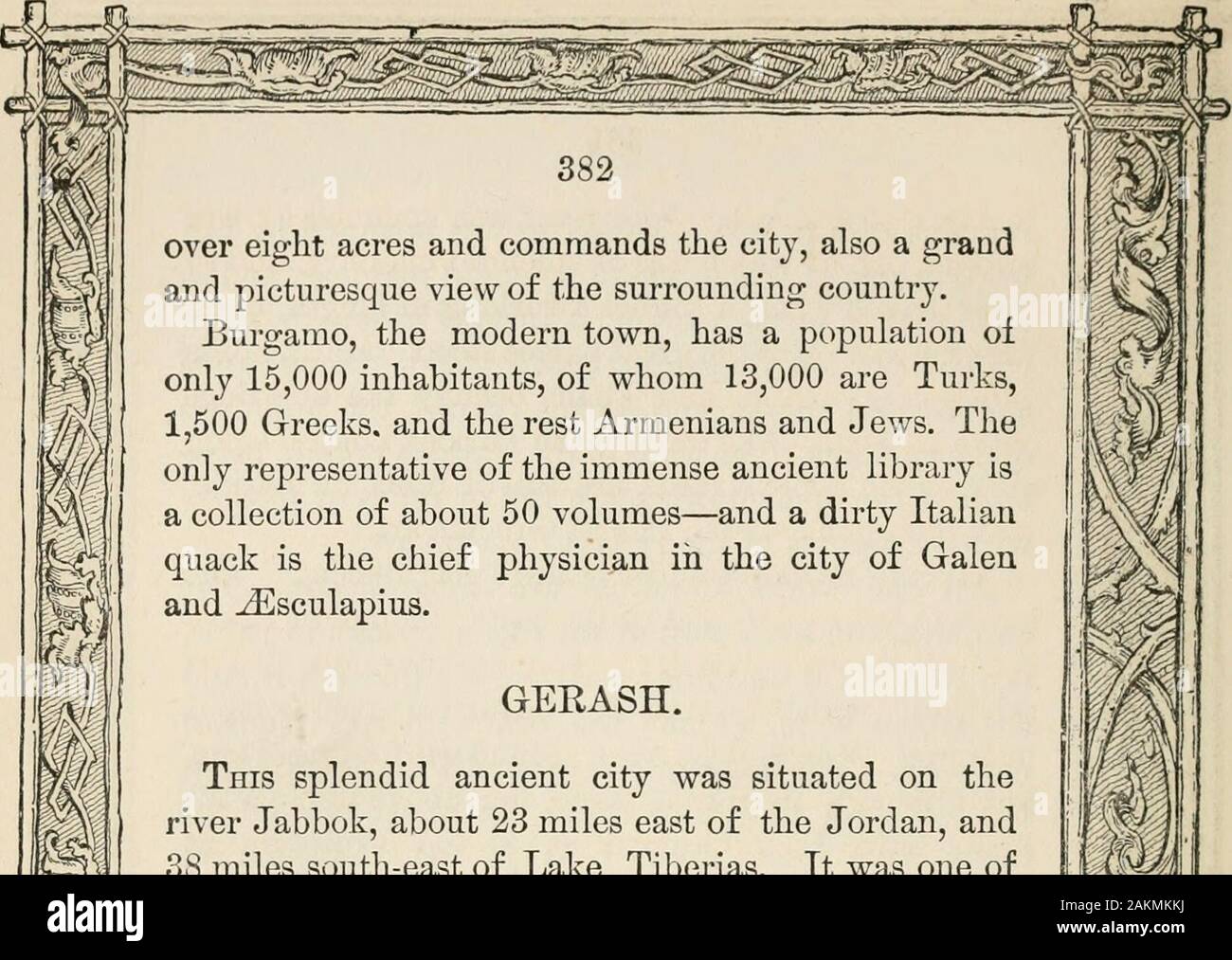 Antiquities of the Orient unveiled, containing a concise description of the remarkable ruins of King Solomon's temple, and store cities ,together with those of all the most ancient and renowned cities of the East, including Babylon, Nineveh, Damascus, and Shushan . over eight acres and commands the city, also a grandand picturesque view of the surrounding country. Burgamo, the modern town, has a population ofonly 15,000 inhabitants, of whom 13,000 are Turks,1,500 Greeks, and the rest Armenians and Jews. Theonly representative of the immense ancient library isa collection of about 50 volumes—an Stock Photohttps://www.alamy.com/image-license-details/?v=1https://www.alamy.com/antiquities-of-the-orient-unveiled-containing-a-concise-description-of-the-remarkable-ruins-of-king-solomons-temple-and-store-cities-together-with-those-of-all-the-most-ancient-and-renowned-cities-of-the-east-including-babylon-nineveh-damascus-and-shushan-over-eight-acres-and-commands-the-city-also-a-grandand-picturesque-view-of-the-surrounding-country-burgamo-the-modern-town-has-a-population-ofonly-15000-inhabitants-of-whom-13000-are-turks1500-greeks-and-the-rest-armenians-and-jews-theonly-representative-of-the-immense-ancient-library-isa-collection-of-about-50-volumesan-image339129942.html
Antiquities of the Orient unveiled, containing a concise description of the remarkable ruins of King Solomon's temple, and store cities ,together with those of all the most ancient and renowned cities of the East, including Babylon, Nineveh, Damascus, and Shushan . over eight acres and commands the city, also a grandand picturesque view of the surrounding country. Burgamo, the modern town, has a population ofonly 15,000 inhabitants, of whom 13,000 are Turks,1,500 Greeks, and the rest Armenians and Jews. Theonly representative of the immense ancient library isa collection of about 50 volumes—an Stock Photohttps://www.alamy.com/image-license-details/?v=1https://www.alamy.com/antiquities-of-the-orient-unveiled-containing-a-concise-description-of-the-remarkable-ruins-of-king-solomons-temple-and-store-cities-together-with-those-of-all-the-most-ancient-and-renowned-cities-of-the-east-including-babylon-nineveh-damascus-and-shushan-over-eight-acres-and-commands-the-city-also-a-grandand-picturesque-view-of-the-surrounding-country-burgamo-the-modern-town-has-a-population-ofonly-15000-inhabitants-of-whom-13000-are-turks1500-greeks-and-the-rest-armenians-and-jews-theonly-representative-of-the-immense-ancient-library-isa-collection-of-about-50-volumesan-image339129942.htmlRM2AKMKKJ–Antiquities of the Orient unveiled, containing a concise description of the remarkable ruins of King Solomon's temple, and store cities ,together with those of all the most ancient and renowned cities of the East, including Babylon, Nineveh, Damascus, and Shushan . over eight acres and commands the city, also a grandand picturesque view of the surrounding country. Burgamo, the modern town, has a population ofonly 15,000 inhabitants, of whom 13,000 are Turks,1,500 Greeks, and the rest Armenians and Jews. Theonly representative of the immense ancient library isa collection of about 50 volumes—an
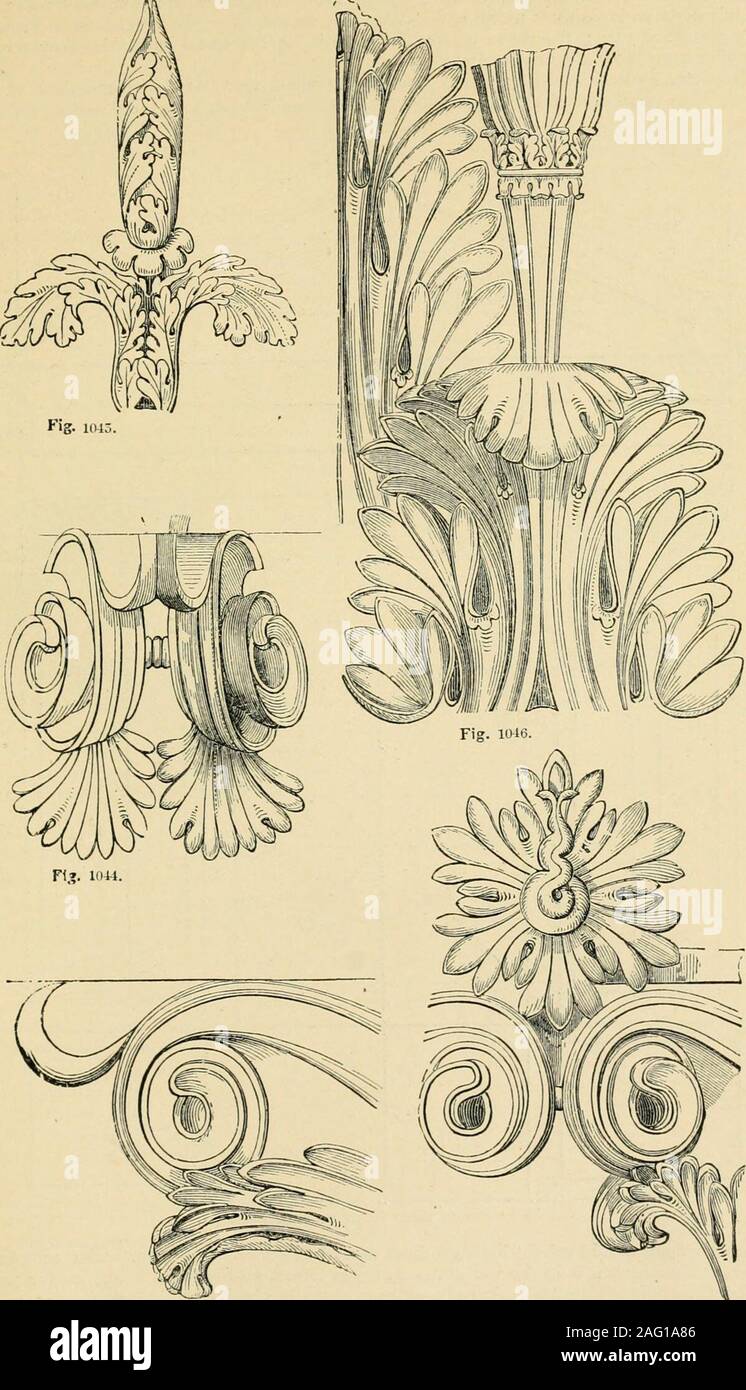 . An encyclopaedia of architecture, historical, theoretical, & practical. New ed., rev., portions rewritten, and with additions by Wyatt Papworth. CAI-ITALS OF THK PANTHEON. Chaf. II. PIlINCirLES OF PK or OUT I ON 957 elegant arrangement of the ornaments: further details will be found in Taylor &Cresys Architectural Antiquities of R&me, whence the dt tails here given have been selected.. Fig 1045. CAPITALS OF PANTHEON. Fig. 1047. Although the llomtJis did not improve the arts wiiich the Greeks had spread amongfi^era, by the introduction of the arch they materially altered the character of the Stock Photohttps://www.alamy.com/image-license-details/?v=1https://www.alamy.com/an-encyclopaedia-of-architecture-historical-theoretical-practical-new-ed-rev-portions-rewritten-and-with-additions-by-wyatt-papworth-cai-itals-of-thk-pantheon-chaf-ii-pilincirles-of-pk-or-out-i-on-957-elegant-arrangement-of-the-ornaments-further-details-will-be-found-in-taylor-cresys-architectural-antiquities-of-rme-whence-the-dt-tails-here-given-have-been-selected-fig-1045-capitals-of-pantheon-fig-1047-although-the-llomtjis-did-not-improve-the-arts-wiiich-the-greeks-had-spread-amongfiera-by-the-introduction-of-the-arch-they-materially-altered-the-character-of-the-image336861510.html
. An encyclopaedia of architecture, historical, theoretical, & practical. New ed., rev., portions rewritten, and with additions by Wyatt Papworth. CAI-ITALS OF THK PANTHEON. Chaf. II. PIlINCirLES OF PK or OUT I ON 957 elegant arrangement of the ornaments: further details will be found in Taylor &Cresys Architectural Antiquities of R&me, whence the dt tails here given have been selected.. Fig 1045. CAPITALS OF PANTHEON. Fig. 1047. Although the llomtJis did not improve the arts wiiich the Greeks had spread amongfi^era, by the introduction of the arch they materially altered the character of the Stock Photohttps://www.alamy.com/image-license-details/?v=1https://www.alamy.com/an-encyclopaedia-of-architecture-historical-theoretical-practical-new-ed-rev-portions-rewritten-and-with-additions-by-wyatt-papworth-cai-itals-of-thk-pantheon-chaf-ii-pilincirles-of-pk-or-out-i-on-957-elegant-arrangement-of-the-ornaments-further-details-will-be-found-in-taylor-cresys-architectural-antiquities-of-rme-whence-the-dt-tails-here-given-have-been-selected-fig-1045-capitals-of-pantheon-fig-1047-although-the-llomtjis-did-not-improve-the-arts-wiiich-the-greeks-had-spread-amongfiera-by-the-introduction-of-the-arch-they-materially-altered-the-character-of-the-image336861510.htmlRM2AG1A86–. An encyclopaedia of architecture, historical, theoretical, & practical. New ed., rev., portions rewritten, and with additions by Wyatt Papworth. CAI-ITALS OF THK PANTHEON. Chaf. II. PIlINCirLES OF PK or OUT I ON 957 elegant arrangement of the ornaments: further details will be found in Taylor &Cresys Architectural Antiquities of R&me, whence the dt tails here given have been selected.. Fig 1045. CAPITALS OF PANTHEON. Fig. 1047. Although the llomtJis did not improve the arts wiiich the Greeks had spread amongfi^era, by the introduction of the arch they materially altered the character of the
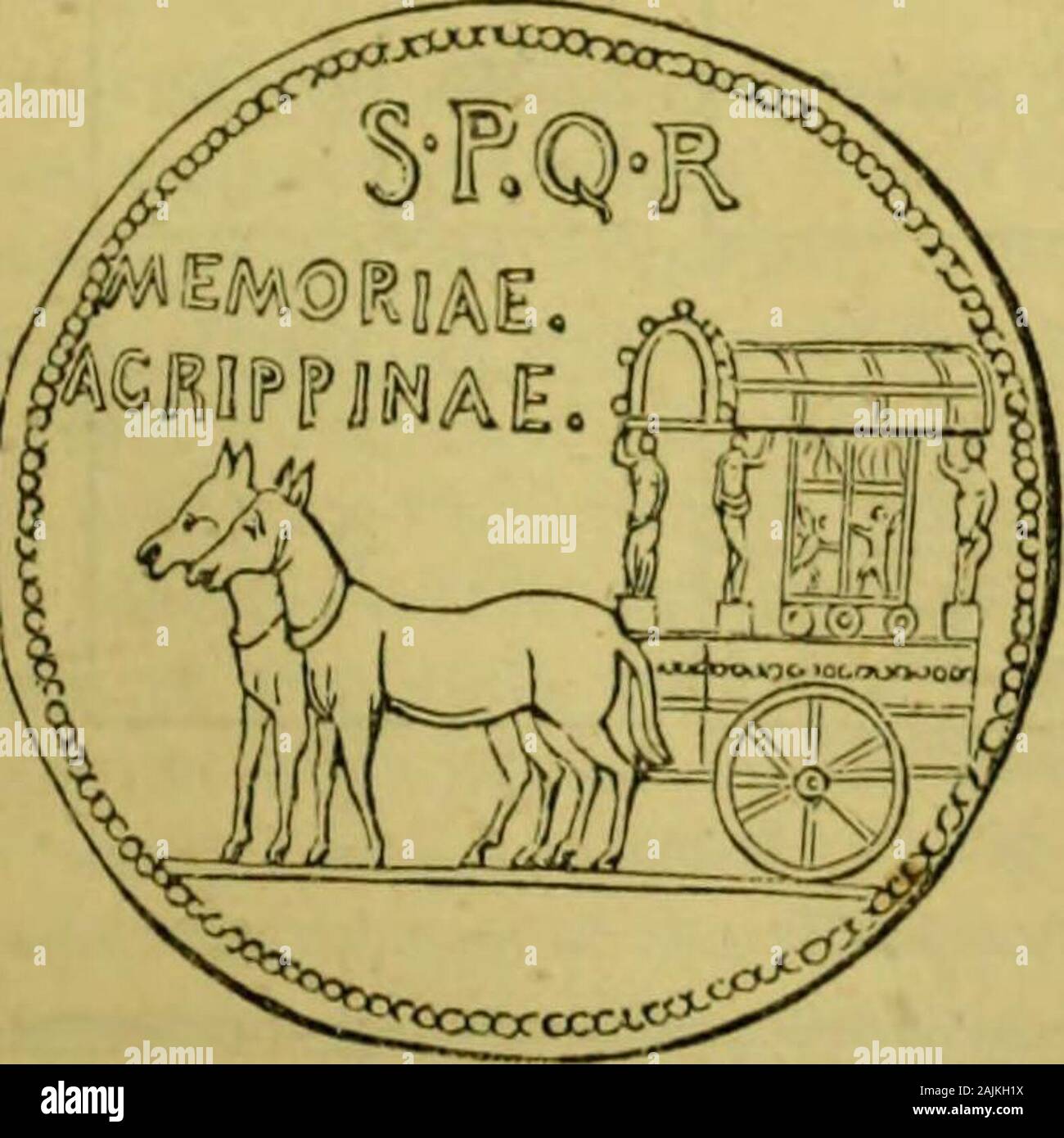 School dictionary of Greek and Roman antiquities . allowed totake the field against an enemy, we mustremember that tliis restriction was not pe-culiar to the Carneia, but common to allthe great festivals of the Greeks: traces ofit are found even in Homer. CARNIFEX, the public executionerat Rome, who executed slaves and foreign-ers, but not citizens, who were punished ina manner different from slaves. It was alsohis busmess to administer the torture. ThisoflKce was considered so disgraceful, thathe was not allowed to reside within thecity, but lived without the Porta Metia orEsquilina, near the Stock Photohttps://www.alamy.com/image-license-details/?v=1https://www.alamy.com/school-dictionary-of-greek-and-roman-antiquities-allowed-totake-the-field-against-an-enemy-we-mustremember-that-tliis-restriction-was-not-pe-culiar-to-the-carneia-but-common-to-allthe-great-festivals-of-the-greeks-traces-ofit-are-found-even-in-homer-carnifex-the-public-executionerat-rome-who-executed-slaves-and-foreign-ers-but-not-citizens-who-were-punished-ina-manner-different-from-slaves-it-was-alsohis-busmess-to-administer-the-torture-thisoflkce-was-considered-so-disgraceful-thathe-was-not-allowed-to-reside-within-thecity-but-lived-without-the-porta-metia-oresquilina-near-the-image338491270.html
School dictionary of Greek and Roman antiquities . allowed totake the field against an enemy, we mustremember that tliis restriction was not pe-culiar to the Carneia, but common to allthe great festivals of the Greeks: traces ofit are found even in Homer. CARNIFEX, the public executionerat Rome, who executed slaves and foreign-ers, but not citizens, who were punished ina manner different from slaves. It was alsohis busmess to administer the torture. ThisoflKce was considered so disgraceful, thathe was not allowed to reside within thecity, but lived without the Porta Metia orEsquilina, near the Stock Photohttps://www.alamy.com/image-license-details/?v=1https://www.alamy.com/school-dictionary-of-greek-and-roman-antiquities-allowed-totake-the-field-against-an-enemy-we-mustremember-that-tliis-restriction-was-not-pe-culiar-to-the-carneia-but-common-to-allthe-great-festivals-of-the-greeks-traces-ofit-are-found-even-in-homer-carnifex-the-public-executionerat-rome-who-executed-slaves-and-foreign-ers-but-not-citizens-who-were-punished-ina-manner-different-from-slaves-it-was-alsohis-busmess-to-administer-the-torture-thisoflkce-was-considered-so-disgraceful-thathe-was-not-allowed-to-reside-within-thecity-but-lived-without-the-porta-metia-oresquilina-near-the-image338491270.htmlRM2AJKH1X–School dictionary of Greek and Roman antiquities . allowed totake the field against an enemy, we mustremember that tliis restriction was not pe-culiar to the Carneia, but common to allthe great festivals of the Greeks: traces ofit are found even in Homer. CARNIFEX, the public executionerat Rome, who executed slaves and foreign-ers, but not citizens, who were punished ina manner different from slaves. It was alsohis busmess to administer the torture. ThisoflKce was considered so disgraceful, thathe was not allowed to reside within thecity, but lived without the Porta Metia orEsquilina, near the
![A dictionary of Greek and Roman antiquities.. . When not used, the bow was put into a case(ro£o6r]Kri, yoopvros, Corytus), which was made ofleather, and sometimes ornamented (cpaeivos, Horn.Od. xxi. 54). The bow-case is very conspicuousin the sculptured bas-reliefs of Persepolis. Itfrequently held the arrows as well as the bow,and on this account is often confounded with thePharetra or quiver. Though its use was com-paratively rare among the Greeks and Romans,we find it exhibited in a bas-relief in the MuseoPio-Clementino (vol. iv. tav. 43), which is copiedin the annexed cut.. ARDALION (apMXio Stock Photo A dictionary of Greek and Roman antiquities.. . When not used, the bow was put into a case(ro£o6r]Kri, yoopvros, Corytus), which was made ofleather, and sometimes ornamented (cpaeivos, Horn.Od. xxi. 54). The bow-case is very conspicuousin the sculptured bas-reliefs of Persepolis. Itfrequently held the arrows as well as the bow,and on this account is often confounded with thePharetra or quiver. Though its use was com-paratively rare among the Greeks and Romans,we find it exhibited in a bas-relief in the MuseoPio-Clementino (vol. iv. tav. 43), which is copiedin the annexed cut.. ARDALION (apMXio Stock Photo](https://c8.alamy.com/comp/2AM268A/a-dictionary-of-greek-and-roman-antiquities-when-not-used-the-bow-was-put-into-a-caseroo6r-kri-yoopvros-corytus-which-was-made-ofleather-and-sometimes-ornamented-cpaeivos-hornod-xxi-54-the-bow-case-is-very-conspicuousin-the-sculptured-bas-reliefs-of-persepolis-itfrequently-held-the-arrows-as-well-as-the-bowand-on-this-account-is-often-confounded-with-thepharetra-or-quiver-though-its-use-was-com-paratively-rare-among-the-greeks-and-romanswe-find-it-exhibited-in-a-bas-relief-in-the-museopio-clementino-vol-iv-tav-43-which-is-copiedin-the-annexed-cut-ardalion-apmxio-2AM268A.jpg) A dictionary of Greek and Roman antiquities.. . When not used, the bow was put into a case(ro£o6r]Kri, yoopvros, Corytus), which was made ofleather, and sometimes ornamented (cpaeivos, Horn.Od. xxi. 54). The bow-case is very conspicuousin the sculptured bas-reliefs of Persepolis. Itfrequently held the arrows as well as the bow,and on this account is often confounded with thePharetra or quiver. Though its use was com-paratively rare among the Greeks and Romans,we find it exhibited in a bas-relief in the MuseoPio-Clementino (vol. iv. tav. 43), which is copiedin the annexed cut.. ARDALION (apMXio Stock Photohttps://www.alamy.com/image-license-details/?v=1https://www.alamy.com/a-dictionary-of-greek-and-roman-antiquities-when-not-used-the-bow-was-put-into-a-caseroo6r-kri-yoopvros-corytus-which-was-made-ofleather-and-sometimes-ornamented-cpaeivos-hornod-xxi-54-the-bow-case-is-very-conspicuousin-the-sculptured-bas-reliefs-of-persepolis-itfrequently-held-the-arrows-as-well-as-the-bowand-on-this-account-is-often-confounded-with-thepharetra-or-quiver-though-its-use-was-com-paratively-rare-among-the-greeks-and-romanswe-find-it-exhibited-in-a-bas-relief-in-the-museopio-clementino-vol-iv-tav-43-which-is-copiedin-the-annexed-cut-ardalion-apmxio-image339338954.html
A dictionary of Greek and Roman antiquities.. . When not used, the bow was put into a case(ro£o6r]Kri, yoopvros, Corytus), which was made ofleather, and sometimes ornamented (cpaeivos, Horn.Od. xxi. 54). The bow-case is very conspicuousin the sculptured bas-reliefs of Persepolis. Itfrequently held the arrows as well as the bow,and on this account is often confounded with thePharetra or quiver. Though its use was com-paratively rare among the Greeks and Romans,we find it exhibited in a bas-relief in the MuseoPio-Clementino (vol. iv. tav. 43), which is copiedin the annexed cut.. ARDALION (apMXio Stock Photohttps://www.alamy.com/image-license-details/?v=1https://www.alamy.com/a-dictionary-of-greek-and-roman-antiquities-when-not-used-the-bow-was-put-into-a-caseroo6r-kri-yoopvros-corytus-which-was-made-ofleather-and-sometimes-ornamented-cpaeivos-hornod-xxi-54-the-bow-case-is-very-conspicuousin-the-sculptured-bas-reliefs-of-persepolis-itfrequently-held-the-arrows-as-well-as-the-bowand-on-this-account-is-often-confounded-with-thepharetra-or-quiver-though-its-use-was-com-paratively-rare-among-the-greeks-and-romanswe-find-it-exhibited-in-a-bas-relief-in-the-museopio-clementino-vol-iv-tav-43-which-is-copiedin-the-annexed-cut-ardalion-apmxio-image339338954.htmlRM2AM268A–A dictionary of Greek and Roman antiquities.. . When not used, the bow was put into a case(ro£o6r]Kri, yoopvros, Corytus), which was made ofleather, and sometimes ornamented (cpaeivos, Horn.Od. xxi. 54). The bow-case is very conspicuousin the sculptured bas-reliefs of Persepolis. Itfrequently held the arrows as well as the bow,and on this account is often confounded with thePharetra or quiver. Though its use was com-paratively rare among the Greeks and Romans,we find it exhibited in a bas-relief in the MuseoPio-Clementino (vol. iv. tav. 43), which is copiedin the annexed cut.. ARDALION (apMXio
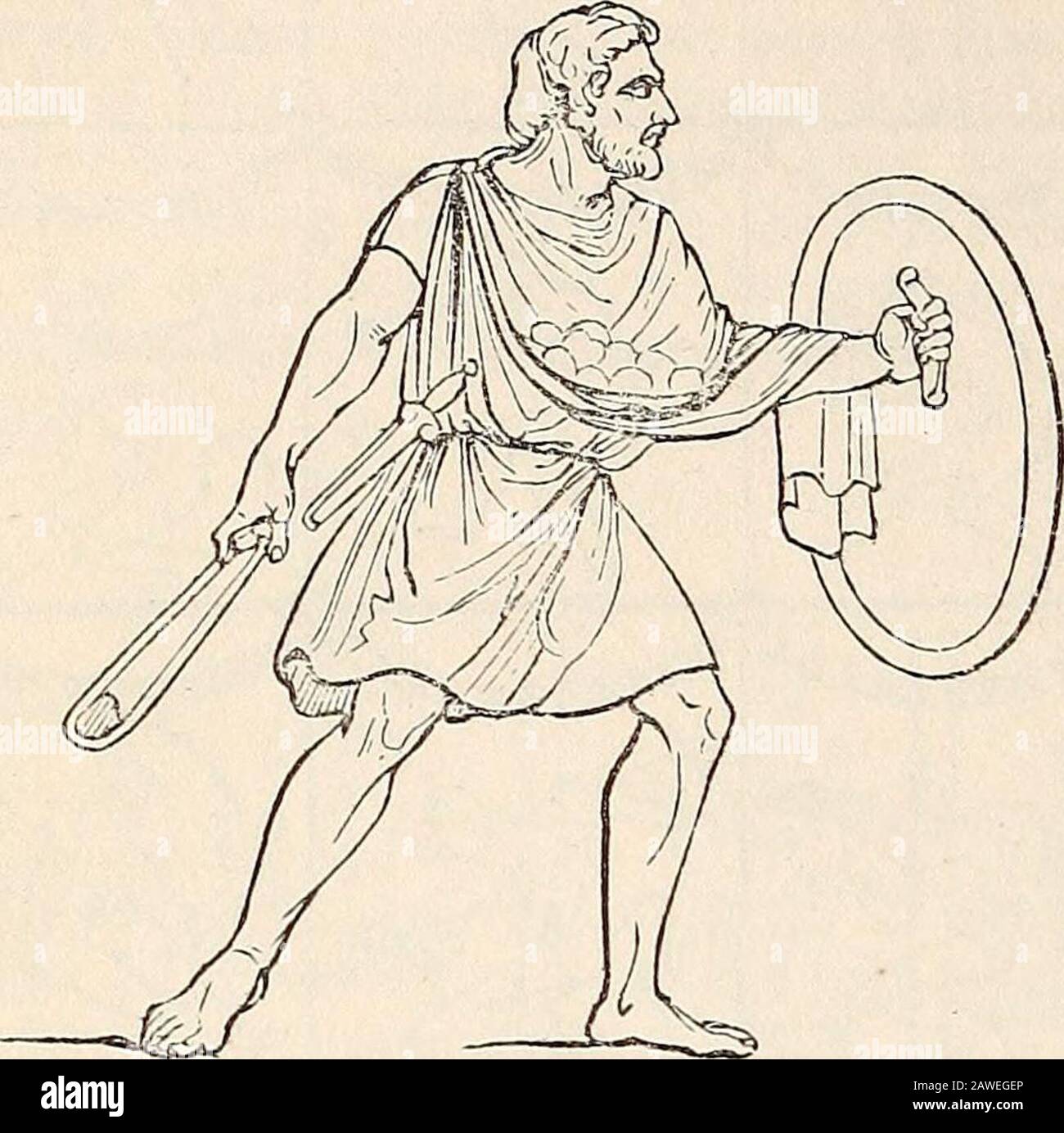 A dictionary of Greek and Roman antiquities.. . y readof slingers hi these wars. Among the Greeks theAcarnanians in early times attained to the greatestexpertness in the use of this weapon (Thuc. ii. 81);and at a later time the Achaeans, especially the in-habitants of Agium, Patrae, and Dymae, were cele-brated as expert slingers. The slings of these Achae-ans were made of three thongs of leather, and not ofone only, like those of other nations. (Liv. xxxviii.29.) The people, however, who enjoyed the greatestcelebrity as slingers were the natives of the Balearicislands. Their skill in the use o Stock Photohttps://www.alamy.com/image-license-details/?v=1https://www.alamy.com/a-dictionary-of-greek-and-roman-antiquities-y-readof-slingers-hi-these-wars-among-the-greeks-theacarnanians-in-early-times-attained-to-the-greatestexpertness-in-the-use-of-this-weapon-thuc-ii-81and-at-a-later-time-the-achaeans-especially-the-in-habitants-of-agium-patrae-and-dymae-were-cele-brated-as-expert-slingers-the-slings-of-these-achae-ans-were-made-of-three-thongs-of-leather-and-not-ofone-only-like-those-of-other-nations-liv-xxxviii29-the-people-however-who-enjoyed-the-greatestcelebrity-as-slingers-were-the-natives-of-the-balearicislands-their-skill-in-the-use-o-image342683678.html
A dictionary of Greek and Roman antiquities.. . y readof slingers hi these wars. Among the Greeks theAcarnanians in early times attained to the greatestexpertness in the use of this weapon (Thuc. ii. 81);and at a later time the Achaeans, especially the in-habitants of Agium, Patrae, and Dymae, were cele-brated as expert slingers. The slings of these Achae-ans were made of three thongs of leather, and not ofone only, like those of other nations. (Liv. xxxviii.29.) The people, however, who enjoyed the greatestcelebrity as slingers were the natives of the Balearicislands. Their skill in the use o Stock Photohttps://www.alamy.com/image-license-details/?v=1https://www.alamy.com/a-dictionary-of-greek-and-roman-antiquities-y-readof-slingers-hi-these-wars-among-the-greeks-theacarnanians-in-early-times-attained-to-the-greatestexpertness-in-the-use-of-this-weapon-thuc-ii-81and-at-a-later-time-the-achaeans-especially-the-in-habitants-of-agium-patrae-and-dymae-were-cele-brated-as-expert-slingers-the-slings-of-these-achae-ans-were-made-of-three-thongs-of-leather-and-not-ofone-only-like-those-of-other-nations-liv-xxxviii29-the-people-however-who-enjoyed-the-greatestcelebrity-as-slingers-were-the-natives-of-the-balearicislands-their-skill-in-the-use-o-image342683678.htmlRM2AWEGEP–A dictionary of Greek and Roman antiquities.. . y readof slingers hi these wars. Among the Greeks theAcarnanians in early times attained to the greatestexpertness in the use of this weapon (Thuc. ii. 81);and at a later time the Achaeans, especially the in-habitants of Agium, Patrae, and Dymae, were cele-brated as expert slingers. The slings of these Achae-ans were made of three thongs of leather, and not ofone only, like those of other nations. (Liv. xxxviii.29.) The people, however, who enjoyed the greatestcelebrity as slingers were the natives of the Balearicislands. Their skill in the use o
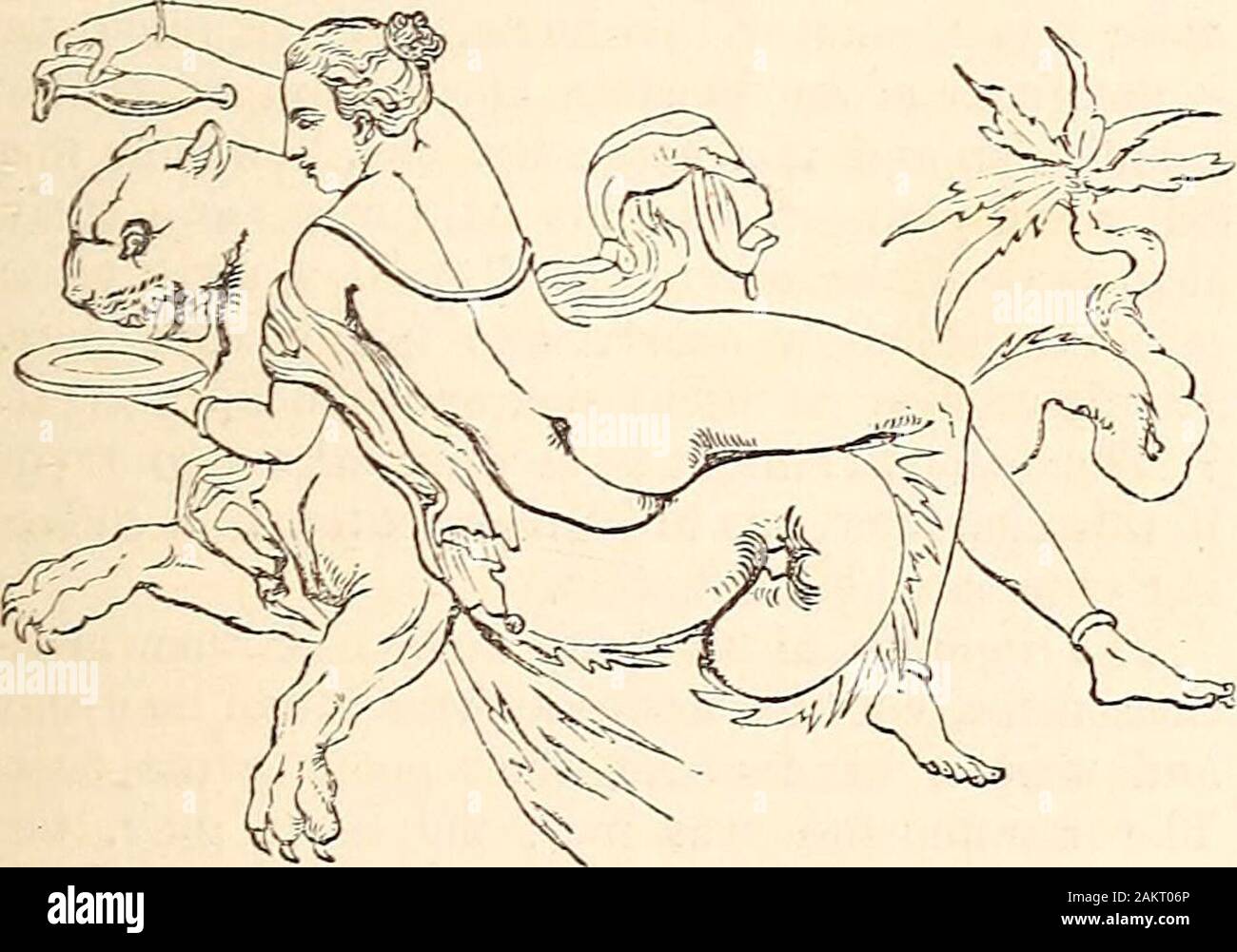 A dictionary of Greek and Roman antiquities.. . ue meaning of this word.The etymology points out merely that it was some-thing worn round the leg (7repi cr/ceAos), but fromthe context of the passage in Horace where it isfound we must at once infer that it was a trinket.The Scholiast explains it as ornamentum pediscircum crura,1 and hence we can scarcely doubtthat it denotes an anklet or bangle, especially sincewe know that these were commonly worn not onlyby the Orientals, the Egyptians, and the Greeks,but by the Roman ladies also. (Plin. H. N. xxxiii.3. s. 12 ; compare Wilkinsons Ancient Egyp Stock Photohttps://www.alamy.com/image-license-details/?v=1https://www.alamy.com/a-dictionary-of-greek-and-roman-antiquities-ue-meaning-of-this-wordthe-etymology-points-out-merely-that-it-was-some-thing-worn-round-the-leg-7repi-crceaos-but-fromthe-context-of-the-passage-in-horace-where-it-isfound-we-must-at-once-infer-that-it-was-a-trinketthe-scholiast-explains-it-as-ornamentum-pediscircum-crura1-and-hence-we-can-scarcely-doubtthat-it-denotes-an-anklet-or-bangle-especially-sincewe-know-that-these-were-commonly-worn-not-onlyby-the-orientals-the-egyptians-and-the-greeksbut-by-the-roman-ladies-also-plin-h-n-xxxiii3-s-12-compare-wilkinsons-ancient-egyp-image339202494.html
A dictionary of Greek and Roman antiquities.. . ue meaning of this word.The etymology points out merely that it was some-thing worn round the leg (7repi cr/ceAos), but fromthe context of the passage in Horace where it isfound we must at once infer that it was a trinket.The Scholiast explains it as ornamentum pediscircum crura,1 and hence we can scarcely doubtthat it denotes an anklet or bangle, especially sincewe know that these were commonly worn not onlyby the Orientals, the Egyptians, and the Greeks,but by the Roman ladies also. (Plin. H. N. xxxiii.3. s. 12 ; compare Wilkinsons Ancient Egyp Stock Photohttps://www.alamy.com/image-license-details/?v=1https://www.alamy.com/a-dictionary-of-greek-and-roman-antiquities-ue-meaning-of-this-wordthe-etymology-points-out-merely-that-it-was-some-thing-worn-round-the-leg-7repi-crceaos-but-fromthe-context-of-the-passage-in-horace-where-it-isfound-we-must-at-once-infer-that-it-was-a-trinketthe-scholiast-explains-it-as-ornamentum-pediscircum-crura1-and-hence-we-can-scarcely-doubtthat-it-denotes-an-anklet-or-bangle-especially-sincewe-know-that-these-were-commonly-worn-not-onlyby-the-orientals-the-egyptians-and-the-greeksbut-by-the-roman-ladies-also-plin-h-n-xxxiii3-s-12-compare-wilkinsons-ancient-egyp-image339202494.htmlRM2AKT06P–A dictionary of Greek and Roman antiquities.. . ue meaning of this word.The etymology points out merely that it was some-thing worn round the leg (7repi cr/ceAos), but fromthe context of the passage in Horace where it isfound we must at once infer that it was a trinket.The Scholiast explains it as ornamentum pediscircum crura,1 and hence we can scarcely doubtthat it denotes an anklet or bangle, especially sincewe know that these were commonly worn not onlyby the Orientals, the Egyptians, and the Greeks,but by the Roman ladies also. (Plin. H. N. xxxiii.3. s. 12 ; compare Wilkinsons Ancient Egyp
![A dictionary of Greek and Roman antiquities.. . victorious generals was like-wise in use among the Greeks, for they were pro-fusely lavished upon Alexander after his conquestof Dareius (Athen. xii. p. 539, a) ; and theRomans probably borrowed the custom from theGreeks. [Aurum Coronarium.] VII. Corona Ovalis was another crown of lessestimation, appropriated solely to commanders. Itwas given to those who merely deserved an ovation, which happened when the war was not duly de-clared, or was carried on against a very inferiorforce, or with persons not considered by the lawsof nations as lawful ene Stock Photo A dictionary of Greek and Roman antiquities.. . victorious generals was like-wise in use among the Greeks, for they were pro-fusely lavished upon Alexander after his conquestof Dareius (Athen. xii. p. 539, a) ; and theRomans probably borrowed the custom from theGreeks. [Aurum Coronarium.] VII. Corona Ovalis was another crown of lessestimation, appropriated solely to commanders. Itwas given to those who merely deserved an ovation, which happened when the war was not duly de-clared, or was carried on against a very inferiorforce, or with persons not considered by the lawsof nations as lawful ene Stock Photo](https://c8.alamy.com/comp/2AWFKF7/a-dictionary-of-greek-and-roman-antiquities-victorious-generals-was-like-wise-in-use-among-the-greeks-for-they-were-pro-fusely-lavished-upon-alexander-after-his-conquestof-dareius-athen-xii-p-539-a-and-theromans-probably-borrowed-the-custom-from-thegreeks-aurum-coronarium-vii-corona-ovalis-was-another-crown-of-lessestimation-appropriated-solely-to-commanders-itwas-given-to-those-who-merely-deserved-an-ovation-which-happened-when-the-war-was-not-duly-de-clared-or-was-carried-on-against-a-very-inferiorforce-or-with-persons-not-considered-by-the-lawsof-nations-as-lawful-ene-2AWFKF7.jpg) A dictionary of Greek and Roman antiquities.. . victorious generals was like-wise in use among the Greeks, for they were pro-fusely lavished upon Alexander after his conquestof Dareius (Athen. xii. p. 539, a) ; and theRomans probably borrowed the custom from theGreeks. [Aurum Coronarium.] VII. Corona Ovalis was another crown of lessestimation, appropriated solely to commanders. Itwas given to those who merely deserved an ovation, which happened when the war was not duly de-clared, or was carried on against a very inferiorforce, or with persons not considered by the lawsof nations as lawful ene Stock Photohttps://www.alamy.com/image-license-details/?v=1https://www.alamy.com/a-dictionary-of-greek-and-roman-antiquities-victorious-generals-was-like-wise-in-use-among-the-greeks-for-they-were-pro-fusely-lavished-upon-alexander-after-his-conquestof-dareius-athen-xii-p-539-a-and-theromans-probably-borrowed-the-custom-from-thegreeks-aurum-coronarium-vii-corona-ovalis-was-another-crown-of-lessestimation-appropriated-solely-to-commanders-itwas-given-to-those-who-merely-deserved-an-ovation-which-happened-when-the-war-was-not-duly-de-clared-or-was-carried-on-against-a-very-inferiorforce-or-with-persons-not-considered-by-the-lawsof-nations-as-lawful-ene-image342707995.html
A dictionary of Greek and Roman antiquities.. . victorious generals was like-wise in use among the Greeks, for they were pro-fusely lavished upon Alexander after his conquestof Dareius (Athen. xii. p. 539, a) ; and theRomans probably borrowed the custom from theGreeks. [Aurum Coronarium.] VII. Corona Ovalis was another crown of lessestimation, appropriated solely to commanders. Itwas given to those who merely deserved an ovation, which happened when the war was not duly de-clared, or was carried on against a very inferiorforce, or with persons not considered by the lawsof nations as lawful ene Stock Photohttps://www.alamy.com/image-license-details/?v=1https://www.alamy.com/a-dictionary-of-greek-and-roman-antiquities-victorious-generals-was-like-wise-in-use-among-the-greeks-for-they-were-pro-fusely-lavished-upon-alexander-after-his-conquestof-dareius-athen-xii-p-539-a-and-theromans-probably-borrowed-the-custom-from-thegreeks-aurum-coronarium-vii-corona-ovalis-was-another-crown-of-lessestimation-appropriated-solely-to-commanders-itwas-given-to-those-who-merely-deserved-an-ovation-which-happened-when-the-war-was-not-duly-de-clared-or-was-carried-on-against-a-very-inferiorforce-or-with-persons-not-considered-by-the-lawsof-nations-as-lawful-ene-image342707995.htmlRM2AWFKF7–A dictionary of Greek and Roman antiquities.. . victorious generals was like-wise in use among the Greeks, for they were pro-fusely lavished upon Alexander after his conquestof Dareius (Athen. xii. p. 539, a) ; and theRomans probably borrowed the custom from theGreeks. [Aurum Coronarium.] VII. Corona Ovalis was another crown of lessestimation, appropriated solely to commanders. Itwas given to those who merely deserved an ovation, which happened when the war was not duly de-clared, or was carried on against a very inferiorforce, or with persons not considered by the lawsof nations as lawful ene
![A dictionary of Greek and Roman antiquities.. . shapes were used by numerous nationsbefore the adoption of them by the Greeks. Theround target or cetra was a species of the Pelta,and was used especially by the people of Spainand Mauritania. [Cetra.] The Pelta is alsosaid to have been quadrangular. (Schol. in Tliueyd.ii. 29.) A light shield of similar construction waspart of the national armour of Thrace (Thucvd.ii. 29; Eurip. Alces. 516, Bhes. 407; Max. Tyr.Diss, vii.) and of various parts of Asia, and was onthis account attributed to the Amazons, in whosehands it appears on the works of ancie Stock Photo A dictionary of Greek and Roman antiquities.. . shapes were used by numerous nationsbefore the adoption of them by the Greeks. Theround target or cetra was a species of the Pelta,and was used especially by the people of Spainand Mauritania. [Cetra.] The Pelta is alsosaid to have been quadrangular. (Schol. in Tliueyd.ii. 29.) A light shield of similar construction waspart of the national armour of Thrace (Thucvd.ii. 29; Eurip. Alces. 516, Bhes. 407; Max. Tyr.Diss, vii.) and of various parts of Asia, and was onthis account attributed to the Amazons, in whosehands it appears on the works of ancie Stock Photo](https://c8.alamy.com/comp/2AKT3JG/a-dictionary-of-greek-and-roman-antiquities-shapes-were-used-by-numerous-nationsbefore-the-adoption-of-them-by-the-greeks-theround-target-or-cetra-was-a-species-of-the-peltaand-was-used-especially-by-the-people-of-spainand-mauritania-cetra-the-pelta-is-alsosaid-to-have-been-quadrangular-schol-in-tliueydii-29-a-light-shield-of-similar-construction-waspart-of-the-national-armour-of-thrace-thucvdii-29-eurip-alces-516-bhes-407-max-tyrdiss-vii-and-of-various-parts-of-asia-and-was-onthis-account-attributed-to-the-amazons-in-whosehands-it-appears-on-the-works-of-ancie-2AKT3JG.jpg) A dictionary of Greek and Roman antiquities.. . shapes were used by numerous nationsbefore the adoption of them by the Greeks. Theround target or cetra was a species of the Pelta,and was used especially by the people of Spainand Mauritania. [Cetra.] The Pelta is alsosaid to have been quadrangular. (Schol. in Tliueyd.ii. 29.) A light shield of similar construction waspart of the national armour of Thrace (Thucvd.ii. 29; Eurip. Alces. 516, Bhes. 407; Max. Tyr.Diss, vii.) and of various parts of Asia, and was onthis account attributed to the Amazons, in whosehands it appears on the works of ancie Stock Photohttps://www.alamy.com/image-license-details/?v=1https://www.alamy.com/a-dictionary-of-greek-and-roman-antiquities-shapes-were-used-by-numerous-nationsbefore-the-adoption-of-them-by-the-greeks-theround-target-or-cetra-was-a-species-of-the-peltaand-was-used-especially-by-the-people-of-spainand-mauritania-cetra-the-pelta-is-alsosaid-to-have-been-quadrangular-schol-in-tliueydii-29-a-light-shield-of-similar-construction-waspart-of-the-national-armour-of-thrace-thucvdii-29-eurip-alces-516-bhes-407-max-tyrdiss-vii-and-of-various-parts-of-asia-and-was-onthis-account-attributed-to-the-amazons-in-whosehands-it-appears-on-the-works-of-ancie-image339205176.html
A dictionary of Greek and Roman antiquities.. . shapes were used by numerous nationsbefore the adoption of them by the Greeks. Theround target or cetra was a species of the Pelta,and was used especially by the people of Spainand Mauritania. [Cetra.] The Pelta is alsosaid to have been quadrangular. (Schol. in Tliueyd.ii. 29.) A light shield of similar construction waspart of the national armour of Thrace (Thucvd.ii. 29; Eurip. Alces. 516, Bhes. 407; Max. Tyr.Diss, vii.) and of various parts of Asia, and was onthis account attributed to the Amazons, in whosehands it appears on the works of ancie Stock Photohttps://www.alamy.com/image-license-details/?v=1https://www.alamy.com/a-dictionary-of-greek-and-roman-antiquities-shapes-were-used-by-numerous-nationsbefore-the-adoption-of-them-by-the-greeks-theround-target-or-cetra-was-a-species-of-the-peltaand-was-used-especially-by-the-people-of-spainand-mauritania-cetra-the-pelta-is-alsosaid-to-have-been-quadrangular-schol-in-tliueydii-29-a-light-shield-of-similar-construction-waspart-of-the-national-armour-of-thrace-thucvdii-29-eurip-alces-516-bhes-407-max-tyrdiss-vii-and-of-various-parts-of-asia-and-was-onthis-account-attributed-to-the-amazons-in-whosehands-it-appears-on-the-works-of-ancie-image339205176.htmlRM2AKT3JG–A dictionary of Greek and Roman antiquities.. . shapes were used by numerous nationsbefore the adoption of them by the Greeks. Theround target or cetra was a species of the Pelta,and was used especially by the people of Spainand Mauritania. [Cetra.] The Pelta is alsosaid to have been quadrangular. (Schol. in Tliueyd.ii. 29.) A light shield of similar construction waspart of the national armour of Thrace (Thucvd.ii. 29; Eurip. Alces. 516, Bhes. 407; Max. Tyr.Diss, vii.) and of various parts of Asia, and was onthis account attributed to the Amazons, in whosehands it appears on the works of ancie
RM2AG3PM4–. The illustrated companion to the Latin dictionary and Greek lexicon; forming a glossary of all the words representing visible objects connected with the arts, manufactures, and every-day life of the Greeks and Romans, with representations of nearly two thousand objects from the antique. ndother antiquities in the British Mu-seum, but originally employed as asepulchral urn, which was discoveredin the year 1817 amongst severalothers in the form of temples, hel-mets, &c, at Marino, near the ancientAlba Longa, imbedded in a sort ofwhite earth under a thick stratum ofvolcanic lava (the Italian pe
![A dictionary of Greek and Roman antiquities.. . (alsocalled lectica funebris, lecticula, lectus funebris,feretrum or capulum), in which the dead were car-ried to the grave, seems to have been used amongthe Greeks and Romans from very early times. Inthe beauty and costliness of their ornaments theselecticae varied according to the rank and circum-stances of the deceased. [Funus, p. 55.9 a.] Thelectica on which the body of Augustus was carriedto the grave, was made of ivory and gold, and wascovered with costly drapery worked of purple andgold. (Dion Cass. lvi. 34 ; compare Dionys. Ant.Rom. iv. 7 Stock Photo A dictionary of Greek and Roman antiquities.. . (alsocalled lectica funebris, lecticula, lectus funebris,feretrum or capulum), in which the dead were car-ried to the grave, seems to have been used amongthe Greeks and Romans from very early times. Inthe beauty and costliness of their ornaments theselecticae varied according to the rank and circum-stances of the deceased. [Funus, p. 55.9 a.] Thelectica on which the body of Augustus was carriedto the grave, was made of ivory and gold, and wascovered with costly drapery worked of purple andgold. (Dion Cass. lvi. 34 ; compare Dionys. Ant.Rom. iv. 7 Stock Photo](https://c8.alamy.com/comp/2AKWN7X/a-dictionary-of-greek-and-roman-antiquities-alsocalled-lectica-funebris-lecticula-lectus-funebrisferetrum-or-capulum-in-which-the-dead-were-car-ried-to-the-grave-seems-to-have-been-used-amongthe-greeks-and-romans-from-very-early-times-inthe-beauty-and-costliness-of-their-ornaments-theselecticae-varied-according-to-the-rank-and-circum-stances-of-the-deceased-funus-p-559-a-thelectica-on-which-the-body-of-augustus-was-carriedto-the-grave-was-made-of-ivory-and-gold-and-wascovered-with-costly-drapery-worked-of-purple-andgold-dion-cass-lvi-34-compare-dionys-antrom-iv-7-2AKWN7X.jpg) A dictionary of Greek and Roman antiquities.. . (alsocalled lectica funebris, lecticula, lectus funebris,feretrum or capulum), in which the dead were car-ried to the grave, seems to have been used amongthe Greeks and Romans from very early times. Inthe beauty and costliness of their ornaments theselecticae varied according to the rank and circum-stances of the deceased. [Funus, p. 55.9 a.] Thelectica on which the body of Augustus was carriedto the grave, was made of ivory and gold, and wascovered with costly drapery worked of purple andgold. (Dion Cass. lvi. 34 ; compare Dionys. Ant.Rom. iv. 7 Stock Photohttps://www.alamy.com/image-license-details/?v=1https://www.alamy.com/a-dictionary-of-greek-and-roman-antiquities-alsocalled-lectica-funebris-lecticula-lectus-funebrisferetrum-or-capulum-in-which-the-dead-were-car-ried-to-the-grave-seems-to-have-been-used-amongthe-greeks-and-romans-from-very-early-times-inthe-beauty-and-costliness-of-their-ornaments-theselecticae-varied-according-to-the-rank-and-circum-stances-of-the-deceased-funus-p-559-a-thelectica-on-which-the-body-of-augustus-was-carriedto-the-grave-was-made-of-ivory-and-gold-and-wascovered-with-costly-drapery-worked-of-purple-andgold-dion-cass-lvi-34-compare-dionys-antrom-iv-7-image339240942.html
A dictionary of Greek and Roman antiquities.. . (alsocalled lectica funebris, lecticula, lectus funebris,feretrum or capulum), in which the dead were car-ried to the grave, seems to have been used amongthe Greeks and Romans from very early times. Inthe beauty and costliness of their ornaments theselecticae varied according to the rank and circum-stances of the deceased. [Funus, p. 55.9 a.] Thelectica on which the body of Augustus was carriedto the grave, was made of ivory and gold, and wascovered with costly drapery worked of purple andgold. (Dion Cass. lvi. 34 ; compare Dionys. Ant.Rom. iv. 7 Stock Photohttps://www.alamy.com/image-license-details/?v=1https://www.alamy.com/a-dictionary-of-greek-and-roman-antiquities-alsocalled-lectica-funebris-lecticula-lectus-funebrisferetrum-or-capulum-in-which-the-dead-were-car-ried-to-the-grave-seems-to-have-been-used-amongthe-greeks-and-romans-from-very-early-times-inthe-beauty-and-costliness-of-their-ornaments-theselecticae-varied-according-to-the-rank-and-circum-stances-of-the-deceased-funus-p-559-a-thelectica-on-which-the-body-of-augustus-was-carriedto-the-grave-was-made-of-ivory-and-gold-and-wascovered-with-costly-drapery-worked-of-purple-andgold-dion-cass-lvi-34-compare-dionys-antrom-iv-7-image339240942.htmlRM2AKWN7X–A dictionary of Greek and Roman antiquities.. . (alsocalled lectica funebris, lecticula, lectus funebris,feretrum or capulum), in which the dead were car-ried to the grave, seems to have been used amongthe Greeks and Romans from very early times. Inthe beauty and costliness of their ornaments theselecticae varied according to the rank and circum-stances of the deceased. [Funus, p. 55.9 a.] Thelectica on which the body of Augustus was carriedto the grave, was made of ivory and gold, and wascovered with costly drapery worked of purple andgold. (Dion Cass. lvi. 34 ; compare Dionys. Ant.Rom. iv. 7
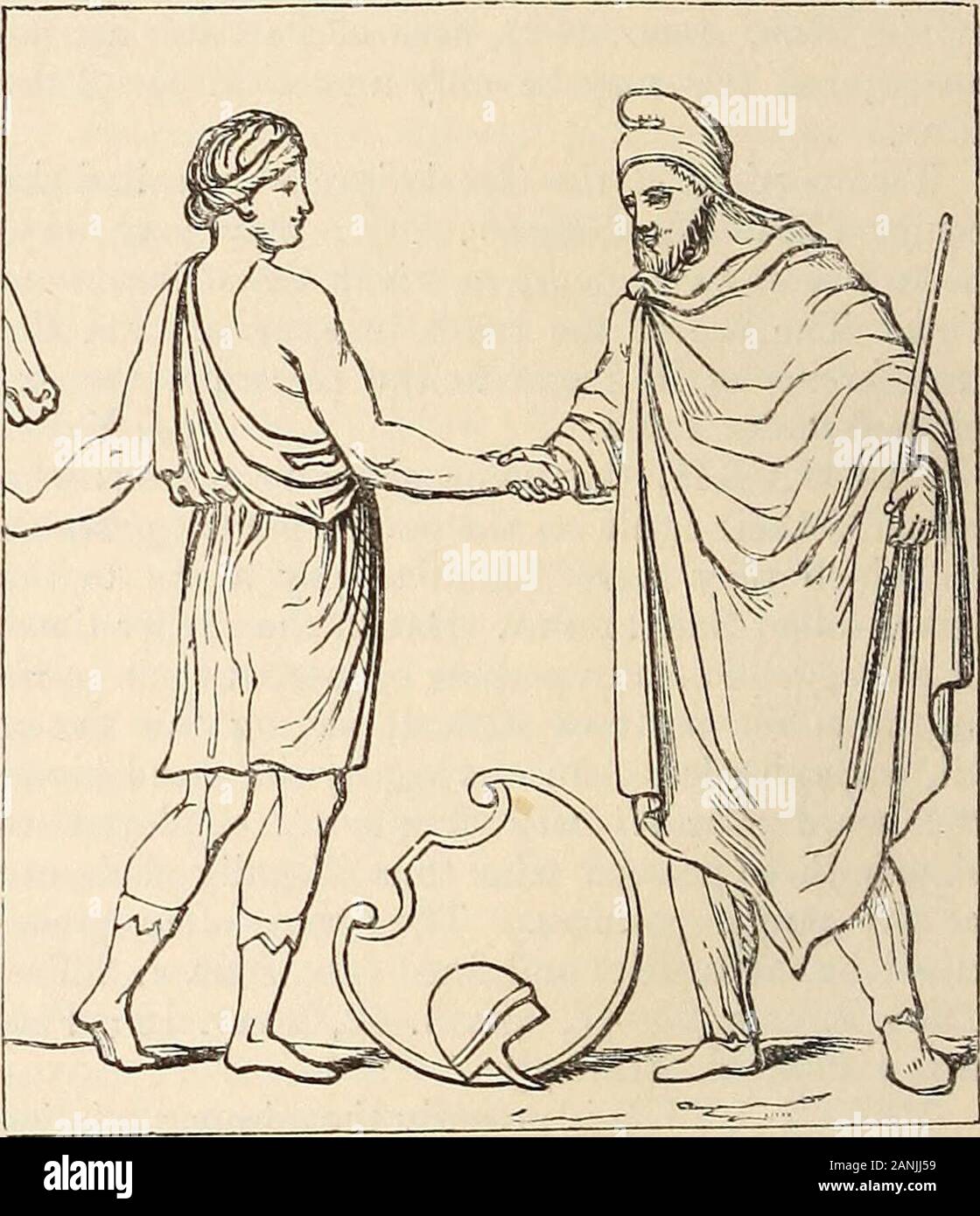 A dictionary of Greek and Roman antiquities.. . shapes were used by numerous nationsbefore the adoption of them by the Greeks. Theround target or cetra was a species of the Pelta,and was used especially by the people of Spainand Mauritania. [Cetra.J The Pelta is alsosaid to have been quadrangular. (Schol. in Thucyd.ii. 29.) A light shield of similar construction waspart of the national armour of Thrace (Thuc3rd.ii. 29; Eurip. Alces. 516, Rhes. 407; Max. Tyr.Diss, vii.) and of various parts of Asia, and was onthis account attributed to the Amazons, in whosehands it appears on the works of ancie Stock Photohttps://www.alamy.com/image-license-details/?v=1https://www.alamy.com/a-dictionary-of-greek-and-roman-antiquities-shapes-were-used-by-numerous-nationsbefore-the-adoption-of-them-by-the-greeks-theround-target-or-cetra-was-a-species-of-the-peltaand-was-used-especially-by-the-people-of-spainand-mauritania-cetraj-the-pelta-is-alsosaid-to-have-been-quadrangular-schol-in-thucydii-29-a-light-shield-of-similar-construction-waspart-of-the-national-armour-of-thrace-thuc3rdii-29-eurip-alces-516-rhes-407-max-tyrdiss-vii-and-of-various-parts-of-asia-and-was-onthis-account-attributed-to-the-amazons-in-whosehands-it-appears-on-the-works-of-ancie-image340314165.html
A dictionary of Greek and Roman antiquities.. . shapes were used by numerous nationsbefore the adoption of them by the Greeks. Theround target or cetra was a species of the Pelta,and was used especially by the people of Spainand Mauritania. [Cetra.J The Pelta is alsosaid to have been quadrangular. (Schol. in Thucyd.ii. 29.) A light shield of similar construction waspart of the national armour of Thrace (Thuc3rd.ii. 29; Eurip. Alces. 516, Rhes. 407; Max. Tyr.Diss, vii.) and of various parts of Asia, and was onthis account attributed to the Amazons, in whosehands it appears on the works of ancie Stock Photohttps://www.alamy.com/image-license-details/?v=1https://www.alamy.com/a-dictionary-of-greek-and-roman-antiquities-shapes-were-used-by-numerous-nationsbefore-the-adoption-of-them-by-the-greeks-theround-target-or-cetra-was-a-species-of-the-peltaand-was-used-especially-by-the-people-of-spainand-mauritania-cetraj-the-pelta-is-alsosaid-to-have-been-quadrangular-schol-in-thucydii-29-a-light-shield-of-similar-construction-waspart-of-the-national-armour-of-thrace-thuc3rdii-29-eurip-alces-516-rhes-407-max-tyrdiss-vii-and-of-various-parts-of-asia-and-was-onthis-account-attributed-to-the-amazons-in-whosehands-it-appears-on-the-works-of-ancie-image340314165.htmlRM2ANJJ59–A dictionary of Greek and Roman antiquities.. . shapes were used by numerous nationsbefore the adoption of them by the Greeks. Theround target or cetra was a species of the Pelta,and was used especially by the people of Spainand Mauritania. [Cetra.J The Pelta is alsosaid to have been quadrangular. (Schol. in Thucyd.ii. 29.) A light shield of similar construction waspart of the national armour of Thrace (Thuc3rd.ii. 29; Eurip. Alces. 516, Rhes. 407; Max. Tyr.Diss, vii.) and of various parts of Asia, and was onthis account attributed to the Amazons, in whosehands it appears on the works of ancie
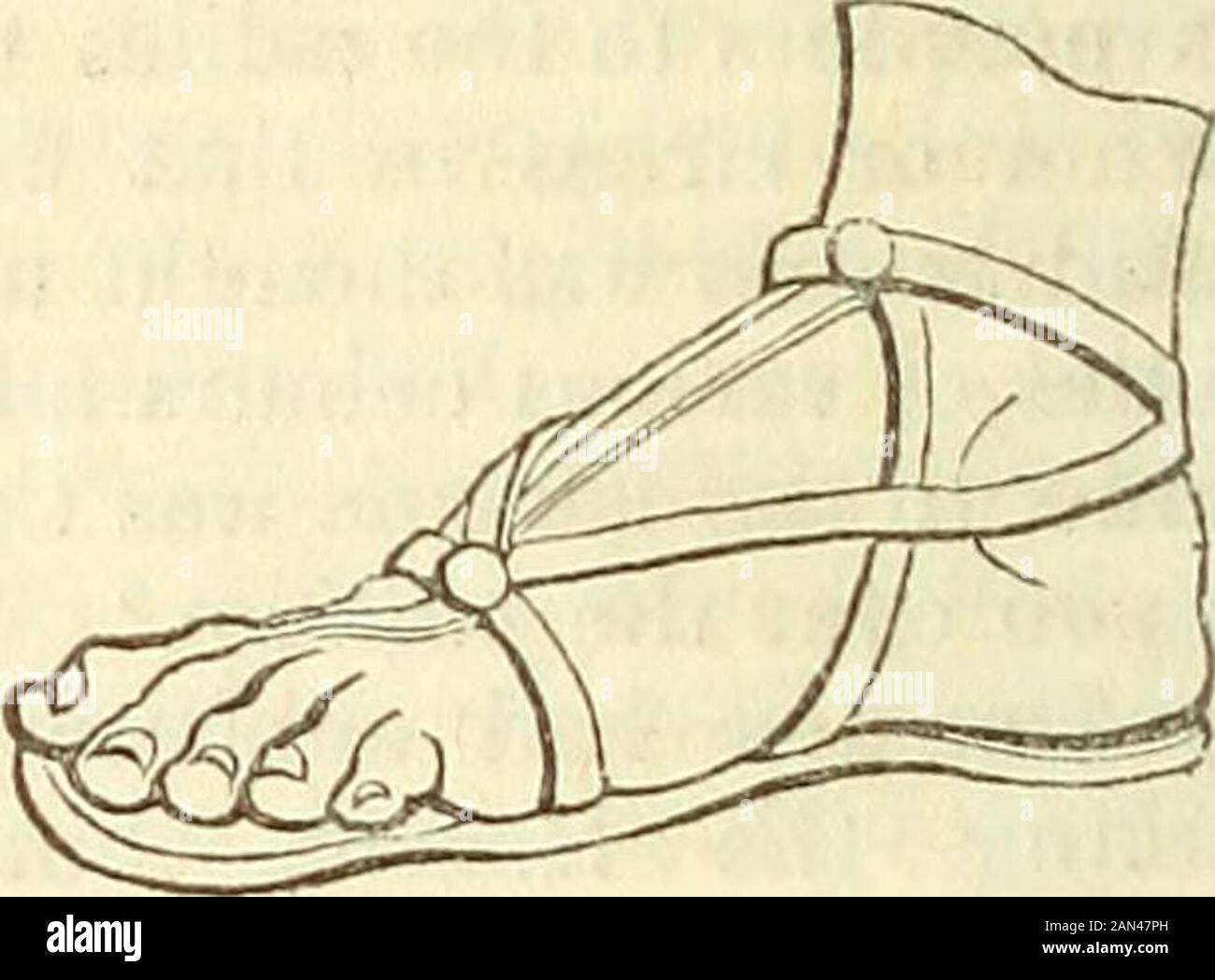 Roman antiquities: or, An account of the manners and customs of the Romans; . Sole^.fastened on with leathern thongs or strings,^ hence called vin-cuLA. Of the latter kind there were various sorts : crepid.!e,vel -DULE, GALLic.E, &c, ; and those who wore them were said tobe discalceali (auvTroortroi) pedibus intectis, unshod, with feetuncovered.- The Greeks wore a kind of shoes called ph.ecasia.^ The calcei were always worn with the toga when a personwent abroad ; whence he put them off,^^ and put on ^^ slippers,when he went on a journey. Caligula permitted those whochose, to wear slippers in Stock Photohttps://www.alamy.com/image-license-details/?v=1https://www.alamy.com/roman-antiquities-or-an-account-of-the-manners-and-customs-of-the-romans-solefastened-on-with-leathern-thongs-or-strings-hence-called-vin-cula-of-the-latter-kind-there-were-various-sorts-crepid!evel-dule-gallice-c-and-those-who-wore-them-were-said-tobe-discalceali-auvtroortroi-pedibus-intectis-unshod-with-feetuncovered-the-greeks-wore-a-kind-of-shoes-called-phecasia-the-calcei-were-always-worn-with-the-toga-when-a-personwent-abroad-whence-he-put-them-off-and-put-on-slipperswhen-he-went-on-a-journey-caligula-permitted-those-whochose-to-wear-slippers-in-image339998697.html
Roman antiquities: or, An account of the manners and customs of the Romans; . Sole^.fastened on with leathern thongs or strings,^ hence called vin-cuLA. Of the latter kind there were various sorts : crepid.!e,vel -DULE, GALLic.E, &c, ; and those who wore them were said tobe discalceali (auvTroortroi) pedibus intectis, unshod, with feetuncovered.- The Greeks wore a kind of shoes called ph.ecasia.^ The calcei were always worn with the toga when a personwent abroad ; whence he put them off,^^ and put on ^^ slippers,when he went on a journey. Caligula permitted those whochose, to wear slippers in Stock Photohttps://www.alamy.com/image-license-details/?v=1https://www.alamy.com/roman-antiquities-or-an-account-of-the-manners-and-customs-of-the-romans-solefastened-on-with-leathern-thongs-or-strings-hence-called-vin-cula-of-the-latter-kind-there-were-various-sorts-crepid!evel-dule-gallice-c-and-those-who-wore-them-were-said-tobe-discalceali-auvtroortroi-pedibus-intectis-unshod-with-feetuncovered-the-greeks-wore-a-kind-of-shoes-called-phecasia-the-calcei-were-always-worn-with-the-toga-when-a-personwent-abroad-whence-he-put-them-off-and-put-on-slipperswhen-he-went-on-a-journey-caligula-permitted-those-whochose-to-wear-slippers-in-image339998697.htmlRM2AN47PH–Roman antiquities: or, An account of the manners and customs of the Romans; . Sole^.fastened on with leathern thongs or strings,^ hence called vin-cuLA. Of the latter kind there were various sorts : crepid.!e,vel -DULE, GALLic.E, &c, ; and those who wore them were said tobe discalceali (auvTroortroi) pedibus intectis, unshod, with feetuncovered.- The Greeks wore a kind of shoes called ph.ecasia.^ The calcei were always worn with the toga when a personwent abroad ; whence he put them off,^^ and put on ^^ slippers,when he went on a journey. Caligula permitted those whochose, to wear slippers in
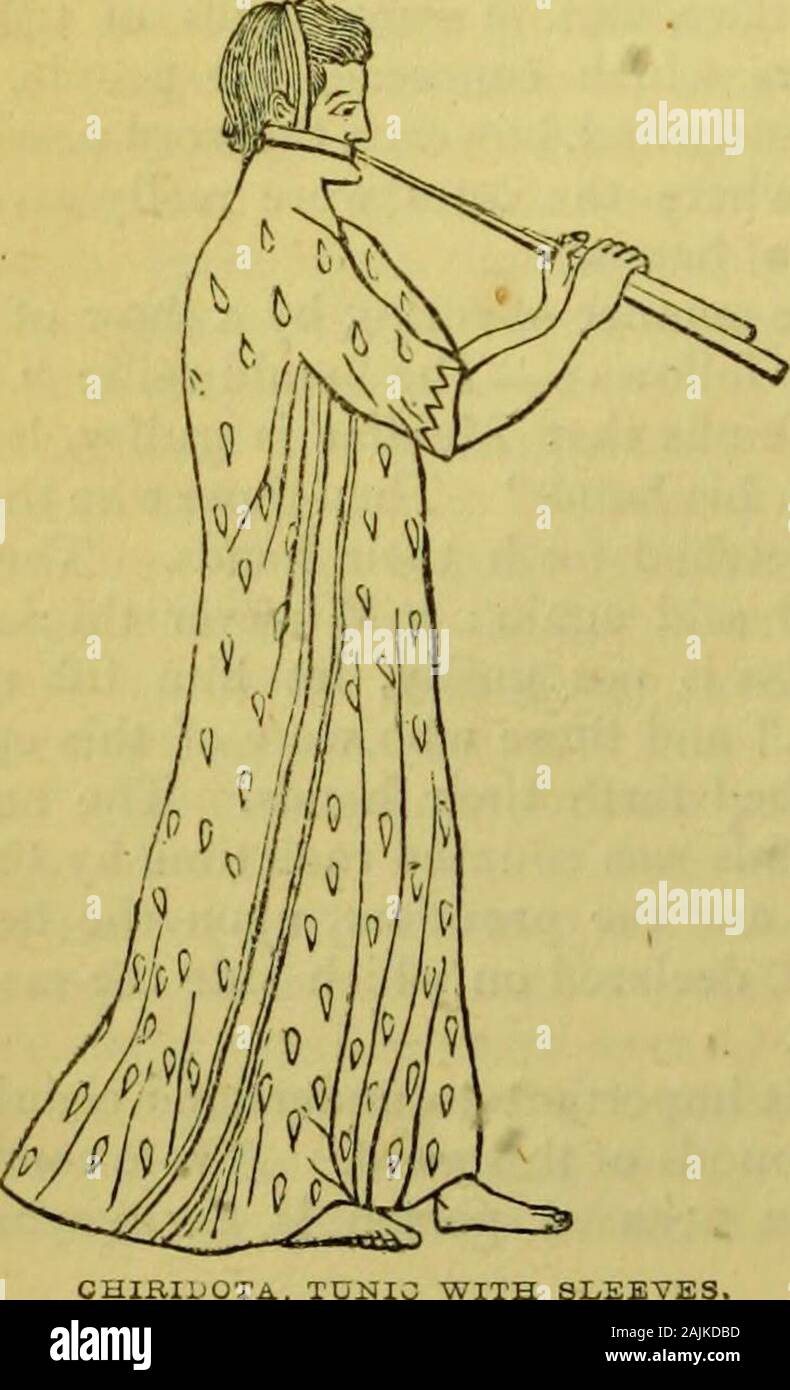 School dictionary of Greek and Roman antiquities . ly of each pry-tany on the conduct of the magistrates ; inthese cases, those who voted for the confirm-ation of the law, or for the continuance inoffice of the magistrate, were said iirix^i-poTovelv, those on the other side atrox^i--poroveTu : Siax^tporouia is a vote for one oftwo alternatives; aurix^iporoveiu, to voteagainst a proposition. The compounds ofxj^ricpL^scrOai have similar meanings. CHIRIDOTA (xetpiScoTos, from x^-P^^fmanica), a tunic with sleeves. The tunicof the Egyptians, Greeks, and Romans wasoriginally without sleeves, or they Stock Photohttps://www.alamy.com/image-license-details/?v=1https://www.alamy.com/school-dictionary-of-greek-and-roman-antiquities-ly-of-each-pry-tany-on-the-conduct-of-the-magistrates-inthese-cases-those-who-voted-for-the-confirm-ation-of-the-law-or-for-the-continuance-inoffice-of-the-magistrate-were-said-iirixi-potovelv-those-on-the-other-side-atroxi-porovetu-siaxtporouia-is-a-vote-for-one-oftwo-alternatives-aurixiporoveiu-to-voteagainst-a-proposition-the-compounds-ofxjricplscroai-have-similar-meanings-chiridota-xetpiscotos-from-x-pfmanica-a-tunic-with-sleeves-the-tunicof-the-egyptians-greeks-and-romans-wasoriginally-without-sleeves-or-they-image338488401.html
School dictionary of Greek and Roman antiquities . ly of each pry-tany on the conduct of the magistrates ; inthese cases, those who voted for the confirm-ation of the law, or for the continuance inoffice of the magistrate, were said iirix^i-poTovelv, those on the other side atrox^i--poroveTu : Siax^tporouia is a vote for one oftwo alternatives; aurix^iporoveiu, to voteagainst a proposition. The compounds ofxj^ricpL^scrOai have similar meanings. CHIRIDOTA (xetpiScoTos, from x^-P^^fmanica), a tunic with sleeves. The tunicof the Egyptians, Greeks, and Romans wasoriginally without sleeves, or they Stock Photohttps://www.alamy.com/image-license-details/?v=1https://www.alamy.com/school-dictionary-of-greek-and-roman-antiquities-ly-of-each-pry-tany-on-the-conduct-of-the-magistrates-inthese-cases-those-who-voted-for-the-confirm-ation-of-the-law-or-for-the-continuance-inoffice-of-the-magistrate-were-said-iirixi-potovelv-those-on-the-other-side-atroxi-porovetu-siaxtporouia-is-a-vote-for-one-oftwo-alternatives-aurixiporoveiu-to-voteagainst-a-proposition-the-compounds-ofxjricplscroai-have-similar-meanings-chiridota-xetpiscotos-from-x-pfmanica-a-tunic-with-sleeves-the-tunicof-the-egyptians-greeks-and-romans-wasoriginally-without-sleeves-or-they-image338488401.htmlRM2AJKDBD–School dictionary of Greek and Roman antiquities . ly of each pry-tany on the conduct of the magistrates ; inthese cases, those who voted for the confirm-ation of the law, or for the continuance inoffice of the magistrate, were said iirix^i-poTovelv, those on the other side atrox^i--poroveTu : Siax^tporouia is a vote for one oftwo alternatives; aurix^iporoveiu, to voteagainst a proposition. The compounds ofxj^ricpL^scrOai have similar meanings. CHIRIDOTA (xetpiScoTos, from x^-P^^fmanica), a tunic with sleeves. The tunicof the Egyptians, Greeks, and Romans wasoriginally without sleeves, or they
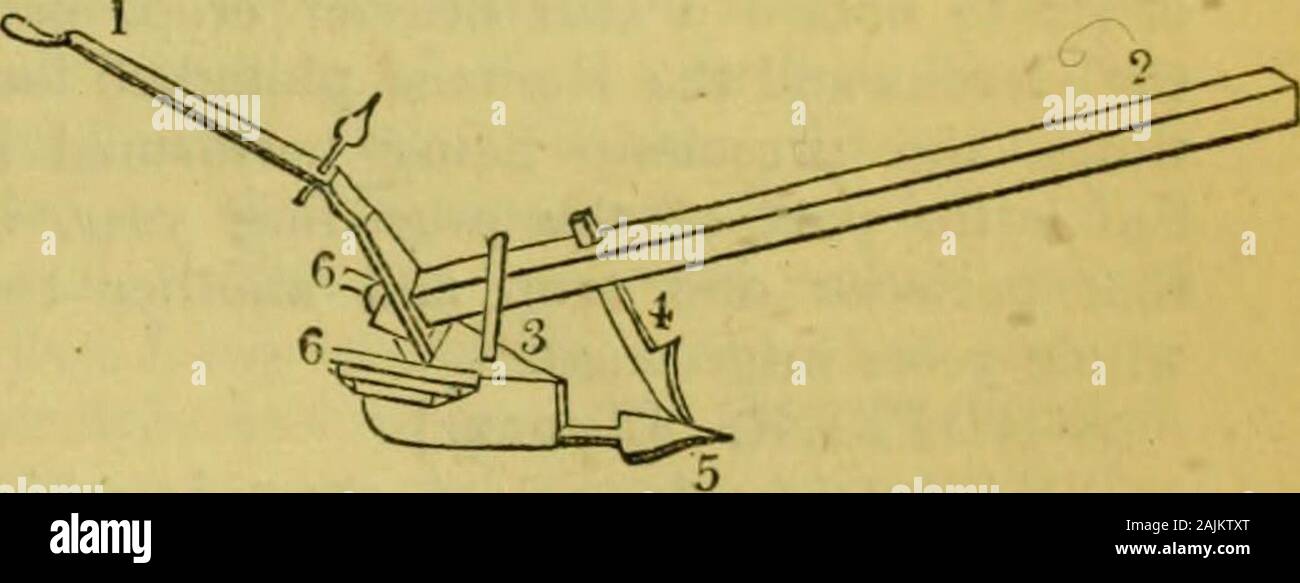 School dictionary of Greek and Roman antiquities . ARATRUM, PiOOGH. beam (3), the huris or plough-tail (4), andthe handle or stiva (5). It correspondsin all essential particulars with the ploughnow used about Mantua and Venice, ofwhich an engraving is cjiven below.. ARATRUM, PLOUGH. 1. Buris. 2. Temo. 3. Dentale. 4. Culter.5. Vomer. 6G. Aures. The Greeks and Romans usually ploughedtheir land three times for each crop. Thefirst ploughing was called proscindere, ornovate (veovadai, vid^eaOai); the secondoffringere, or iterate; and the third, lirare,or tertiare. The field which underwent the pros Stock Photohttps://www.alamy.com/image-license-details/?v=1https://www.alamy.com/school-dictionary-of-greek-and-roman-antiquities-aratrum-pioogh-beam-3-the-huris-or-plough-tail-4-andthe-handle-or-stiva-5-it-correspondsin-all-essential-particulars-with-the-ploughnow-used-about-mantua-and-venice-ofwhich-an-engraving-is-cjiven-below-aratrum-plough-1-buris-2-temo-3-dentale-4-culter5-vomer-6g-aures-the-greeks-and-romans-usually-ploughedtheir-land-three-times-for-each-crop-thefirst-ploughing-was-called-proscindere-ornovate-veovadai-videaoai-the-secondoffringere-or-iterate-and-the-third-lirareor-tertiare-the-field-which-underwent-the-pros-image338497456.html
School dictionary of Greek and Roman antiquities . ARATRUM, PiOOGH. beam (3), the huris or plough-tail (4), andthe handle or stiva (5). It correspondsin all essential particulars with the ploughnow used about Mantua and Venice, ofwhich an engraving is cjiven below.. ARATRUM, PLOUGH. 1. Buris. 2. Temo. 3. Dentale. 4. Culter.5. Vomer. 6G. Aures. The Greeks and Romans usually ploughedtheir land three times for each crop. Thefirst ploughing was called proscindere, ornovate (veovadai, vid^eaOai); the secondoffringere, or iterate; and the third, lirare,or tertiare. The field which underwent the pros Stock Photohttps://www.alamy.com/image-license-details/?v=1https://www.alamy.com/school-dictionary-of-greek-and-roman-antiquities-aratrum-pioogh-beam-3-the-huris-or-plough-tail-4-andthe-handle-or-stiva-5-it-correspondsin-all-essential-particulars-with-the-ploughnow-used-about-mantua-and-venice-ofwhich-an-engraving-is-cjiven-below-aratrum-plough-1-buris-2-temo-3-dentale-4-culter5-vomer-6g-aures-the-greeks-and-romans-usually-ploughedtheir-land-three-times-for-each-crop-thefirst-ploughing-was-called-proscindere-ornovate-veovadai-videaoai-the-secondoffringere-or-iterate-and-the-third-lirareor-tertiare-the-field-which-underwent-the-pros-image338497456.htmlRM2AJKTXT–School dictionary of Greek and Roman antiquities . ARATRUM, PiOOGH. beam (3), the huris or plough-tail (4), andthe handle or stiva (5). It correspondsin all essential particulars with the ploughnow used about Mantua and Venice, ofwhich an engraving is cjiven below.. ARATRUM, PLOUGH. 1. Buris. 2. Temo. 3. Dentale. 4. Culter.5. Vomer. 6G. Aures. The Greeks and Romans usually ploughedtheir land three times for each crop. Thefirst ploughing was called proscindere, ornovate (veovadai, vid^eaOai); the secondoffringere, or iterate; and the third, lirare,or tertiare. The field which underwent the pros
![School dictionary of Greek and Roman antiquities . ACEKBA, INCENSE-BOS. The acerra was also a small moveabhaltar placed before the dead, on which per- ACROPOLIS. fumes were burnt. The use of acerrae atfunerals was forbidden by a law of theTwelve Tables as an unnecessary expense. ACIES. [ExEUciTus.] ACINACES (aKwoLKris), a Persiansword, whence Horace speaks of the Medusacinnces. The acinaces was a short andstraight weapon, and thus differed fromthe Roman sica, which was curved. Itwas worn on the right side of the body,whereas the Greeks and Romans usuallyhad their swords suspended on the leftsi Stock Photo School dictionary of Greek and Roman antiquities . ACEKBA, INCENSE-BOS. The acerra was also a small moveabhaltar placed before the dead, on which per- ACROPOLIS. fumes were burnt. The use of acerrae atfunerals was forbidden by a law of theTwelve Tables as an unnecessary expense. ACIES. [ExEUciTus.] ACINACES (aKwoLKris), a Persiansword, whence Horace speaks of the Medusacinnces. The acinaces was a short andstraight weapon, and thus differed fromthe Roman sica, which was curved. Itwas worn on the right side of the body,whereas the Greeks and Romans usuallyhad their swords suspended on the leftsi Stock Photo](https://c8.alamy.com/comp/2AJM3WA/school-dictionary-of-greek-and-roman-antiquities-acekba-incense-bos-the-acerra-was-also-a-small-moveabhaltar-placed-before-the-dead-on-which-per-acropolis-fumes-were-burnt-the-use-of-acerrae-atfunerals-was-forbidden-by-a-law-of-thetwelve-tables-as-an-unnecessary-expense-acies-exeucitus-acinaces-akwolkris-a-persiansword-whence-horace-speaks-of-the-medusacinnces-the-acinaces-was-a-short-andstraight-weapon-and-thus-differed-fromthe-roman-sica-which-was-curved-itwas-worn-on-the-right-side-of-the-bodywhereas-the-greeks-and-romans-usuallyhad-their-swords-suspended-on-the-leftsi-2AJM3WA.jpg) School dictionary of Greek and Roman antiquities . ACEKBA, INCENSE-BOS. The acerra was also a small moveabhaltar placed before the dead, on which per- ACROPOLIS. fumes were burnt. The use of acerrae atfunerals was forbidden by a law of theTwelve Tables as an unnecessary expense. ACIES. [ExEUciTus.] ACINACES (aKwoLKris), a Persiansword, whence Horace speaks of the Medusacinnces. The acinaces was a short andstraight weapon, and thus differed fromthe Roman sica, which was curved. Itwas worn on the right side of the body,whereas the Greeks and Romans usuallyhad their swords suspended on the leftsi Stock Photohttps://www.alamy.com/image-license-details/?v=1https://www.alamy.com/school-dictionary-of-greek-and-roman-antiquities-acekba-incense-bos-the-acerra-was-also-a-small-moveabhaltar-placed-before-the-dead-on-which-per-acropolis-fumes-were-burnt-the-use-of-acerrae-atfunerals-was-forbidden-by-a-law-of-thetwelve-tables-as-an-unnecessary-expense-acies-exeucitus-acinaces-akwolkris-a-persiansword-whence-horace-speaks-of-the-medusacinnces-the-acinaces-was-a-short-andstraight-weapon-and-thus-differed-fromthe-roman-sica-which-was-curved-itwas-worn-on-the-right-side-of-the-bodywhereas-the-greeks-and-romans-usuallyhad-their-swords-suspended-on-the-leftsi-image338502902.html
School dictionary of Greek and Roman antiquities . ACEKBA, INCENSE-BOS. The acerra was also a small moveabhaltar placed before the dead, on which per- ACROPOLIS. fumes were burnt. The use of acerrae atfunerals was forbidden by a law of theTwelve Tables as an unnecessary expense. ACIES. [ExEUciTus.] ACINACES (aKwoLKris), a Persiansword, whence Horace speaks of the Medusacinnces. The acinaces was a short andstraight weapon, and thus differed fromthe Roman sica, which was curved. Itwas worn on the right side of the body,whereas the Greeks and Romans usuallyhad their swords suspended on the leftsi Stock Photohttps://www.alamy.com/image-license-details/?v=1https://www.alamy.com/school-dictionary-of-greek-and-roman-antiquities-acekba-incense-bos-the-acerra-was-also-a-small-moveabhaltar-placed-before-the-dead-on-which-per-acropolis-fumes-were-burnt-the-use-of-acerrae-atfunerals-was-forbidden-by-a-law-of-thetwelve-tables-as-an-unnecessary-expense-acies-exeucitus-acinaces-akwolkris-a-persiansword-whence-horace-speaks-of-the-medusacinnces-the-acinaces-was-a-short-andstraight-weapon-and-thus-differed-fromthe-roman-sica-which-was-curved-itwas-worn-on-the-right-side-of-the-bodywhereas-the-greeks-and-romans-usuallyhad-their-swords-suspended-on-the-leftsi-image338502902.htmlRM2AJM3WA–School dictionary of Greek and Roman antiquities . ACEKBA, INCENSE-BOS. The acerra was also a small moveabhaltar placed before the dead, on which per- ACROPOLIS. fumes were burnt. The use of acerrae atfunerals was forbidden by a law of theTwelve Tables as an unnecessary expense. ACIES. [ExEUciTus.] ACINACES (aKwoLKris), a Persiansword, whence Horace speaks of the Medusacinnces. The acinaces was a short andstraight weapon, and thus differed fromthe Roman sica, which was curved. Itwas worn on the right side of the body,whereas the Greeks and Romans usuallyhad their swords suspended on the leftsi
![School dictionary of Greek and Roman antiquities . OLIPBaS, SHIELD CLOACA. In the Homeric times, the Greeks merelyused a leather strap (reKafxwv) to supportthe shield, but subsecjuently a handle(uxayov or oxdvr]), the use and form ofwhich are exhibited in the annexed cut. CODEX. 97. r2»4^i),««««*- ^-—3^ CLIPBUS, SHIELD. When the census was instituted by Ser-vius Tullius at Rome, the first class onlyused the clipeus, and the second were armedwith the scutum [Scutuji] ; but after theRoman soldiery received pay, the clipeus wasdiscontinued altogether for the scutum. CLOACA, a sewer, a drain. Rome Stock Photo School dictionary of Greek and Roman antiquities . OLIPBaS, SHIELD CLOACA. In the Homeric times, the Greeks merelyused a leather strap (reKafxwv) to supportthe shield, but subsecjuently a handle(uxayov or oxdvr]), the use and form ofwhich are exhibited in the annexed cut. CODEX. 97. r2»4^i),««««*- ^-—3^ CLIPBUS, SHIELD. When the census was instituted by Ser-vius Tullius at Rome, the first class onlyused the clipeus, and the second were armedwith the scutum [Scutuji] ; but after theRoman soldiery received pay, the clipeus wasdiscontinued altogether for the scutum. CLOACA, a sewer, a drain. Rome Stock Photo](https://c8.alamy.com/comp/2AJKB31/school-dictionary-of-greek-and-roman-antiquities-olipbas-shield-cloaca-in-the-homeric-times-the-greeks-merelyused-a-leather-strap-rekafxwv-to-supportthe-shield-but-subsecjuently-a-handleuxayov-or-oxdvr-the-use-and-form-ofwhich-are-exhibited-in-the-annexed-cut-codex-97-r24i-3-clipbus-shield-when-the-census-was-instituted-by-ser-vius-tullius-at-rome-the-first-class-onlyused-the-clipeus-and-the-second-were-armedwith-the-scutum-scutuji-but-after-theroman-soldiery-received-pay-the-clipeus-wasdiscontinued-altogether-for-the-scutum-cloaca-a-sewer-a-drain-rome-2AJKB31.jpg) School dictionary of Greek and Roman antiquities . OLIPBaS, SHIELD CLOACA. In the Homeric times, the Greeks merelyused a leather strap (reKafxwv) to supportthe shield, but subsecjuently a handle(uxayov or oxdvr]), the use and form ofwhich are exhibited in the annexed cut. CODEX. 97. r2»4^i),««««*- ^-—3^ CLIPBUS, SHIELD. When the census was instituted by Ser-vius Tullius at Rome, the first class onlyused the clipeus, and the second were armedwith the scutum [Scutuji] ; but after theRoman soldiery received pay, the clipeus wasdiscontinued altogether for the scutum. CLOACA, a sewer, a drain. Rome Stock Photohttps://www.alamy.com/image-license-details/?v=1https://www.alamy.com/school-dictionary-of-greek-and-roman-antiquities-olipbas-shield-cloaca-in-the-homeric-times-the-greeks-merelyused-a-leather-strap-rekafxwv-to-supportthe-shield-but-subsecjuently-a-handleuxayov-or-oxdvr-the-use-and-form-ofwhich-are-exhibited-in-the-annexed-cut-codex-97-r24i-3-clipbus-shield-when-the-census-was-instituted-by-ser-vius-tullius-at-rome-the-first-class-onlyused-the-clipeus-and-the-second-were-armedwith-the-scutum-scutuji-but-after-theroman-soldiery-received-pay-the-clipeus-wasdiscontinued-altogether-for-the-scutum-cloaca-a-sewer-a-drain-rome-image338486597.html
School dictionary of Greek and Roman antiquities . OLIPBaS, SHIELD CLOACA. In the Homeric times, the Greeks merelyused a leather strap (reKafxwv) to supportthe shield, but subsecjuently a handle(uxayov or oxdvr]), the use and form ofwhich are exhibited in the annexed cut. CODEX. 97. r2»4^i),««««*- ^-—3^ CLIPBUS, SHIELD. When the census was instituted by Ser-vius Tullius at Rome, the first class onlyused the clipeus, and the second were armedwith the scutum [Scutuji] ; but after theRoman soldiery received pay, the clipeus wasdiscontinued altogether for the scutum. CLOACA, a sewer, a drain. Rome Stock Photohttps://www.alamy.com/image-license-details/?v=1https://www.alamy.com/school-dictionary-of-greek-and-roman-antiquities-olipbas-shield-cloaca-in-the-homeric-times-the-greeks-merelyused-a-leather-strap-rekafxwv-to-supportthe-shield-but-subsecjuently-a-handleuxayov-or-oxdvr-the-use-and-form-ofwhich-are-exhibited-in-the-annexed-cut-codex-97-r24i-3-clipbus-shield-when-the-census-was-instituted-by-ser-vius-tullius-at-rome-the-first-class-onlyused-the-clipeus-and-the-second-were-armedwith-the-scutum-scutuji-but-after-theroman-soldiery-received-pay-the-clipeus-wasdiscontinued-altogether-for-the-scutum-cloaca-a-sewer-a-drain-rome-image338486597.htmlRM2AJKB31–School dictionary of Greek and Roman antiquities . OLIPBaS, SHIELD CLOACA. In the Homeric times, the Greeks merelyused a leather strap (reKafxwv) to supportthe shield, but subsecjuently a handle(uxayov or oxdvr]), the use and form ofwhich are exhibited in the annexed cut. CODEX. 97. r2»4^i),««««*- ^-—3^ CLIPBUS, SHIELD. When the census was instituted by Ser-vius Tullius at Rome, the first class onlyused the clipeus, and the second were armedwith the scutum [Scutuji] ; but after theRoman soldiery received pay, the clipeus wasdiscontinued altogether for the scutum. CLOACA, a sewer, a drain. Rome
![A dictionary of Greek and Roman antiquities.. . cae (alsicalled lectica funebris, lecticula, lectus funebris.feretrum or capulum), in which the dead were car-ried to the grave, seems to have been used amongthe Greeks and Romans from very early times. Inthe beauty and costliness of their ornaments theselecticae varied according to the rank and circum-stances of the deceased. [Funus, p. 559 a.] Thelectica on which the body of Augustus was carriedto the grave, was made of ivory and gold, and wascovered with costly drapery worked of purple andgold. (Dion Cass. lvi. 34 ; compare Dionys. Ant.Rom. iv Stock Photo A dictionary of Greek and Roman antiquities.. . cae (alsicalled lectica funebris, lecticula, lectus funebris.feretrum or capulum), in which the dead were car-ried to the grave, seems to have been used amongthe Greeks and Romans from very early times. Inthe beauty and costliness of their ornaments theselecticae varied according to the rank and circum-stances of the deceased. [Funus, p. 559 a.] Thelectica on which the body of Augustus was carriedto the grave, was made of ivory and gold, and wascovered with costly drapery worked of purple andgold. (Dion Cass. lvi. 34 ; compare Dionys. Ant.Rom. iv Stock Photo](https://c8.alamy.com/comp/2AWDW4F/a-dictionary-of-greek-and-roman-antiquities-cae-alsicalled-lectica-funebris-lecticula-lectus-funebrisferetrum-or-capulum-in-which-the-dead-were-car-ried-to-the-grave-seems-to-have-been-used-amongthe-greeks-and-romans-from-very-early-times-inthe-beauty-and-costliness-of-their-ornaments-theselecticae-varied-according-to-the-rank-and-circum-stances-of-the-deceased-funus-p-559-a-thelectica-on-which-the-body-of-augustus-was-carriedto-the-grave-was-made-of-ivory-and-gold-and-wascovered-with-costly-drapery-worked-of-purple-andgold-dion-cass-lvi-34-compare-dionys-antrom-iv-2AWDW4F.jpg) A dictionary of Greek and Roman antiquities.. . cae (alsicalled lectica funebris, lecticula, lectus funebris.feretrum or capulum), in which the dead were car-ried to the grave, seems to have been used amongthe Greeks and Romans from very early times. Inthe beauty and costliness of their ornaments theselecticae varied according to the rank and circum-stances of the deceased. [Funus, p. 559 a.] Thelectica on which the body of Augustus was carriedto the grave, was made of ivory and gold, and wascovered with costly drapery worked of purple andgold. (Dion Cass. lvi. 34 ; compare Dionys. Ant.Rom. iv Stock Photohttps://www.alamy.com/image-license-details/?v=1https://www.alamy.com/a-dictionary-of-greek-and-roman-antiquities-cae-alsicalled-lectica-funebris-lecticula-lectus-funebrisferetrum-or-capulum-in-which-the-dead-were-car-ried-to-the-grave-seems-to-have-been-used-amongthe-greeks-and-romans-from-very-early-times-inthe-beauty-and-costliness-of-their-ornaments-theselecticae-varied-according-to-the-rank-and-circum-stances-of-the-deceased-funus-p-559-a-thelectica-on-which-the-body-of-augustus-was-carriedto-the-grave-was-made-of-ivory-and-gold-and-wascovered-with-costly-drapery-worked-of-purple-andgold-dion-cass-lvi-34-compare-dionys-antrom-iv-image342668495.html
A dictionary of Greek and Roman antiquities.. . cae (alsicalled lectica funebris, lecticula, lectus funebris.feretrum or capulum), in which the dead were car-ried to the grave, seems to have been used amongthe Greeks and Romans from very early times. Inthe beauty and costliness of their ornaments theselecticae varied according to the rank and circum-stances of the deceased. [Funus, p. 559 a.] Thelectica on which the body of Augustus was carriedto the grave, was made of ivory and gold, and wascovered with costly drapery worked of purple andgold. (Dion Cass. lvi. 34 ; compare Dionys. Ant.Rom. iv Stock Photohttps://www.alamy.com/image-license-details/?v=1https://www.alamy.com/a-dictionary-of-greek-and-roman-antiquities-cae-alsicalled-lectica-funebris-lecticula-lectus-funebrisferetrum-or-capulum-in-which-the-dead-were-car-ried-to-the-grave-seems-to-have-been-used-amongthe-greeks-and-romans-from-very-early-times-inthe-beauty-and-costliness-of-their-ornaments-theselecticae-varied-according-to-the-rank-and-circum-stances-of-the-deceased-funus-p-559-a-thelectica-on-which-the-body-of-augustus-was-carriedto-the-grave-was-made-of-ivory-and-gold-and-wascovered-with-costly-drapery-worked-of-purple-andgold-dion-cass-lvi-34-compare-dionys-antrom-iv-image342668495.htmlRM2AWDW4F–A dictionary of Greek and Roman antiquities.. . cae (alsicalled lectica funebris, lecticula, lectus funebris.feretrum or capulum), in which the dead were car-ried to the grave, seems to have been used amongthe Greeks and Romans from very early times. Inthe beauty and costliness of their ornaments theselecticae varied according to the rank and circum-stances of the deceased. [Funus, p. 559 a.] Thelectica on which the body of Augustus was carriedto the grave, was made of ivory and gold, and wascovered with costly drapery worked of purple andgold. (Dion Cass. lvi. 34 ; compare Dionys. Ant.Rom. iv
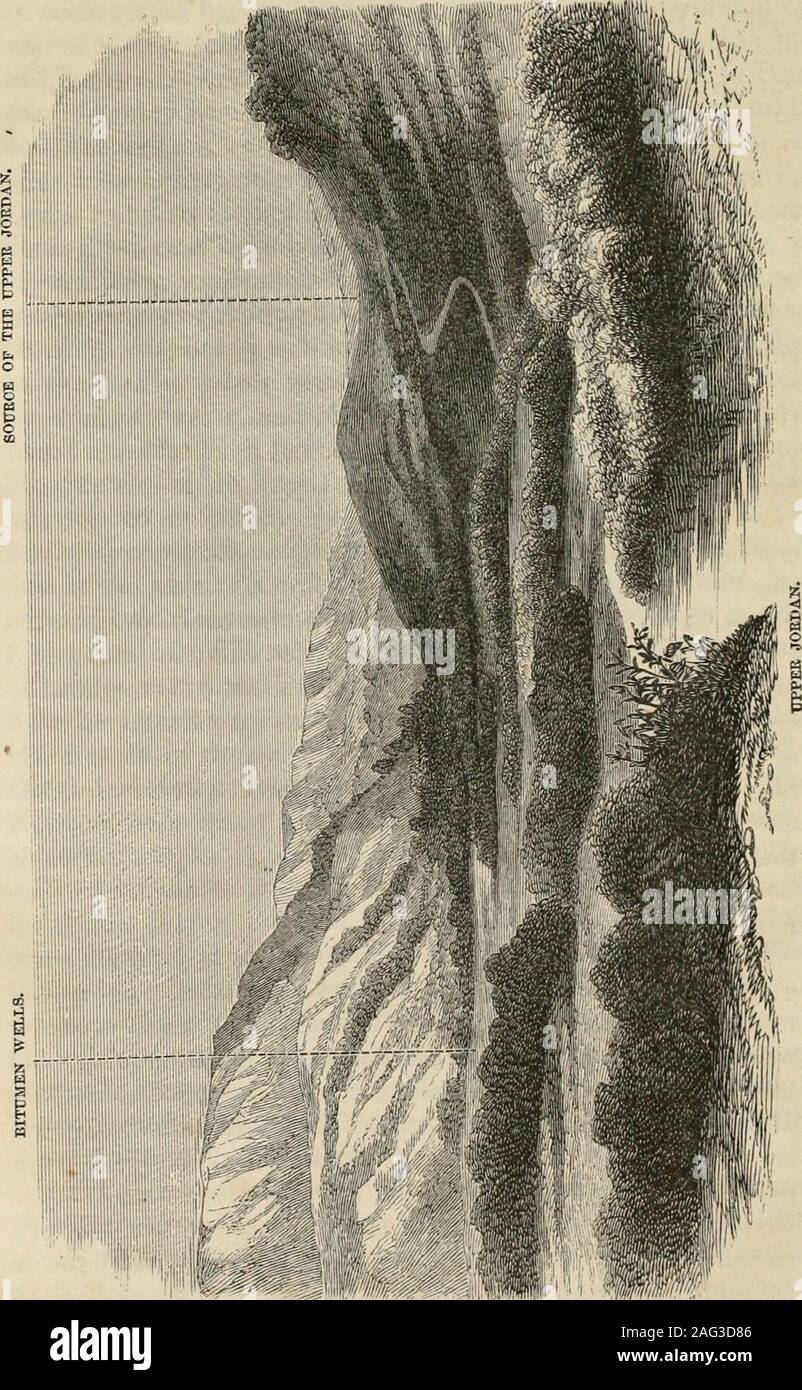 . 'From Dan to Beersheba'; or, The Land of promise as it now appears : including a description of the boundaries, topography, agriculture, antiquities, cities, and present inhabitants of that wonderful land .... ce of the cliff aGreek inscription records the sacred history of the cave. TheRomans succeeding the Greeks, Herod the Great erected asplendid temple of white marble to Augustus near the placecalled Paniuin? Destroyed by some unknown jDower, the ru-ins of this temple are entombed in the cave, excepting a frag-ment clinging to the rocks above, and now dedicated to a Mos-lem saint. Near t Stock Photohttps://www.alamy.com/image-license-details/?v=1https://www.alamy.com/from-dan-to-beersheba-or-the-land-of-promise-as-it-now-appears-including-a-description-of-the-boundaries-topography-agriculture-antiquities-cities-and-present-inhabitants-of-that-wonderful-land-ce-of-the-cliff-agreek-inscription-records-the-sacred-history-of-the-cave-theromans-succeeding-the-greeks-herod-the-great-erected-asplendid-temple-of-white-marble-to-augustus-near-the-placecalled-paniuin-destroyed-by-some-unknown-jdower-the-ru-ins-of-this-temple-are-entombed-in-the-cave-excepting-a-frag-ment-clinging-to-the-rocks-above-and-now-dedicated-to-a-mos-lem-saint-near-t-image336907766.html
. 'From Dan to Beersheba'; or, The Land of promise as it now appears : including a description of the boundaries, topography, agriculture, antiquities, cities, and present inhabitants of that wonderful land .... ce of the cliff aGreek inscription records the sacred history of the cave. TheRomans succeeding the Greeks, Herod the Great erected asplendid temple of white marble to Augustus near the placecalled Paniuin? Destroyed by some unknown jDower, the ru-ins of this temple are entombed in the cave, excepting a frag-ment clinging to the rocks above, and now dedicated to a Mos-lem saint. Near t Stock Photohttps://www.alamy.com/image-license-details/?v=1https://www.alamy.com/from-dan-to-beersheba-or-the-land-of-promise-as-it-now-appears-including-a-description-of-the-boundaries-topography-agriculture-antiquities-cities-and-present-inhabitants-of-that-wonderful-land-ce-of-the-cliff-agreek-inscription-records-the-sacred-history-of-the-cave-theromans-succeeding-the-greeks-herod-the-great-erected-asplendid-temple-of-white-marble-to-augustus-near-the-placecalled-paniuin-destroyed-by-some-unknown-jdower-the-ru-ins-of-this-temple-are-entombed-in-the-cave-excepting-a-frag-ment-clinging-to-the-rocks-above-and-now-dedicated-to-a-mos-lem-saint-near-t-image336907766.htmlRM2AG3D86–. 'From Dan to Beersheba'; or, The Land of promise as it now appears : including a description of the boundaries, topography, agriculture, antiquities, cities, and present inhabitants of that wonderful land .... ce of the cliff aGreek inscription records the sacred history of the cave. TheRomans succeeding the Greeks, Herod the Great erected asplendid temple of white marble to Augustus near the placecalled Paniuin? Destroyed by some unknown jDower, the ru-ins of this temple are entombed in the cave, excepting a frag-ment clinging to the rocks above, and now dedicated to a Mos-lem saint. Near t
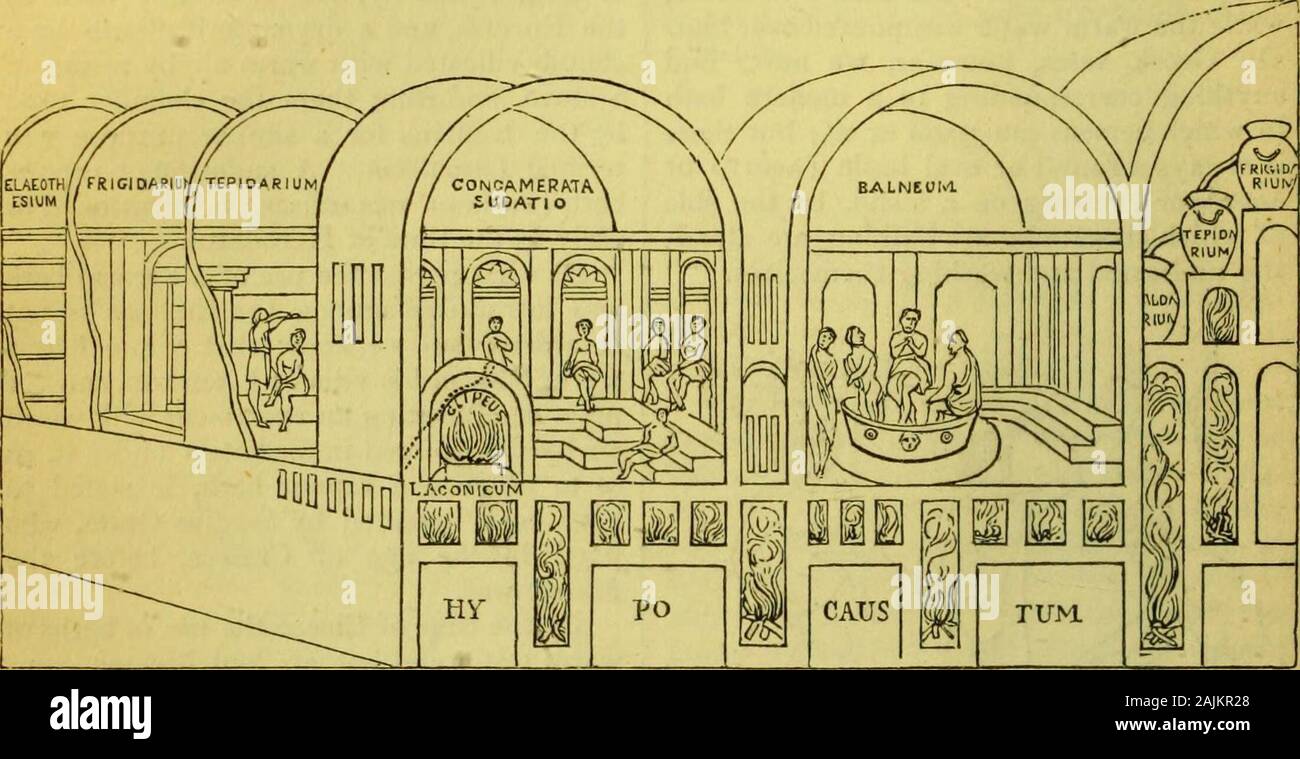 School dictionary of Greek and Roman antiquities . the bath after exercise, and before thec 3 54 BALNEUM. principal meal {coena) of the day ; but thedebauchees of the empire bathed also aftereating as well as before, in order to promotedigestion, and to acquir? a new appetite forfresh delicacies. Upon quitting the bath,the Romans as well as the Greeks wereanointed with oil. The Romans did not content themselveswith a single bath of hot or cold water ;but they went through a course of baths insuccession, in which the agency of air aswell as water was applied. It is difficult BALNEUM. to ascerta Stock Photohttps://www.alamy.com/image-license-details/?v=1https://www.alamy.com/school-dictionary-of-greek-and-roman-antiquities-the-bath-after-exercise-and-before-thec-3-54-balneum-principal-meal-coena-of-the-day-but-thedebauchees-of-the-empire-bathed-also-aftereating-as-well-as-before-in-order-to-promotedigestion-and-to-acquir-a-new-appetite-forfresh-delicacies-upon-quitting-the-baththe-romans-as-well-as-the-greeks-wereanointed-with-oil-the-romans-did-not-content-themselveswith-a-single-bath-of-hot-or-cold-water-but-they-went-through-a-course-of-baths-insuccession-in-which-the-agency-of-air-aswell-as-water-was-applied-it-is-difficult-balneum-to-ascerta-image338495984.html
School dictionary of Greek and Roman antiquities . the bath after exercise, and before thec 3 54 BALNEUM. principal meal {coena) of the day ; but thedebauchees of the empire bathed also aftereating as well as before, in order to promotedigestion, and to acquir? a new appetite forfresh delicacies. Upon quitting the bath,the Romans as well as the Greeks wereanointed with oil. The Romans did not content themselveswith a single bath of hot or cold water ;but they went through a course of baths insuccession, in which the agency of air aswell as water was applied. It is difficult BALNEUM. to ascerta Stock Photohttps://www.alamy.com/image-license-details/?v=1https://www.alamy.com/school-dictionary-of-greek-and-roman-antiquities-the-bath-after-exercise-and-before-thec-3-54-balneum-principal-meal-coena-of-the-day-but-thedebauchees-of-the-empire-bathed-also-aftereating-as-well-as-before-in-order-to-promotedigestion-and-to-acquir-a-new-appetite-forfresh-delicacies-upon-quitting-the-baththe-romans-as-well-as-the-greeks-wereanointed-with-oil-the-romans-did-not-content-themselveswith-a-single-bath-of-hot-or-cold-water-but-they-went-through-a-course-of-baths-insuccession-in-which-the-agency-of-air-aswell-as-water-was-applied-it-is-difficult-balneum-to-ascerta-image338495984.htmlRM2AJKR28–School dictionary of Greek and Roman antiquities . the bath after exercise, and before thec 3 54 BALNEUM. principal meal {coena) of the day ; but thedebauchees of the empire bathed also aftereating as well as before, in order to promotedigestion, and to acquir? a new appetite forfresh delicacies. Upon quitting the bath,the Romans as well as the Greeks wereanointed with oil. The Romans did not content themselveswith a single bath of hot or cold water ;but they went through a course of baths insuccession, in which the agency of air aswell as water was applied. It is difficult BALNEUM. to ascerta
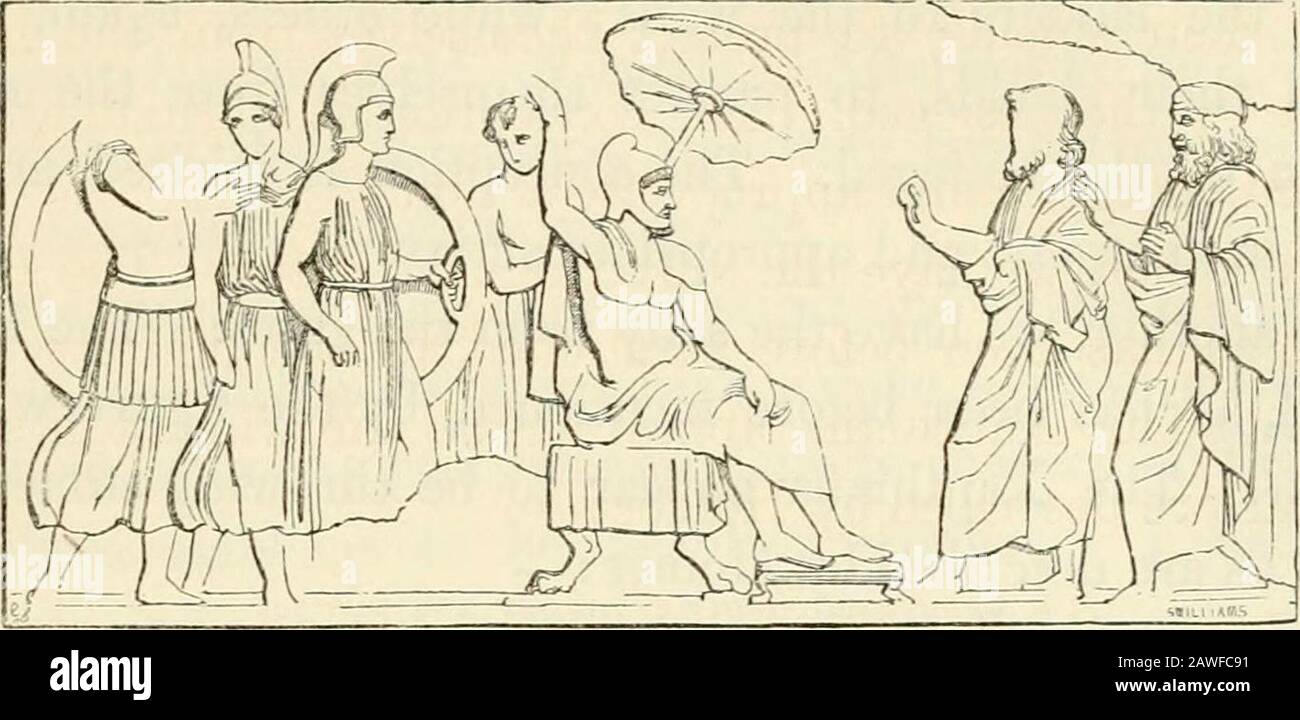 The museum of classical antiquities : being a series of essays on ancient art . al group is that of Harpagus, in the act ofdictating terms to the Lycian chiefs. He is represented seatedon his throne, with his feet reposing on a footstool. Anattendant holds an umbrella over his head, a well-knowneastern and Persian emblem of authority.J * I find that Prof. Welcker and JVIi*. Birch have identified it with the Xaimiiuv.It is mentioned by Homer, II. v. 453, and Herod., xii. v. 426. It is alwaysapplied to Barbarians or Asiatic Greeks. Cf. Muller, Arch, der Kunst., 342,n. 6. The covering is a raw Stock Photohttps://www.alamy.com/image-license-details/?v=1https://www.alamy.com/the-museum-of-classical-antiquities-being-a-series-of-essays-on-ancient-art-al-group-is-that-of-harpagus-in-the-act-ofdictating-terms-to-the-lycian-chiefs-he-is-represented-seatedon-his-throne-with-his-feet-reposing-on-a-footstool-anattendant-holds-an-umbrella-over-his-head-a-well-knowneastern-and-persian-emblem-of-authorityj-i-find-that-prof-welcker-and-jvii-birch-have-identified-it-with-the-xaimiiuvit-is-mentioned-by-homer-ii-v-453-and-herod-xii-v-426-it-is-alwaysapplied-to-barbarians-or-asiatic-greeks-cf-muller-arch-der-kunst-342n-6-the-covering-is-a-raw-image342702333.html
The museum of classical antiquities : being a series of essays on ancient art . al group is that of Harpagus, in the act ofdictating terms to the Lycian chiefs. He is represented seatedon his throne, with his feet reposing on a footstool. Anattendant holds an umbrella over his head, a well-knowneastern and Persian emblem of authority.J * I find that Prof. Welcker and JVIi*. Birch have identified it with the Xaimiiuv.It is mentioned by Homer, II. v. 453, and Herod., xii. v. 426. It is alwaysapplied to Barbarians or Asiatic Greeks. Cf. Muller, Arch, der Kunst., 342,n. 6. The covering is a raw Stock Photohttps://www.alamy.com/image-license-details/?v=1https://www.alamy.com/the-museum-of-classical-antiquities-being-a-series-of-essays-on-ancient-art-al-group-is-that-of-harpagus-in-the-act-ofdictating-terms-to-the-lycian-chiefs-he-is-represented-seatedon-his-throne-with-his-feet-reposing-on-a-footstool-anattendant-holds-an-umbrella-over-his-head-a-well-knowneastern-and-persian-emblem-of-authorityj-i-find-that-prof-welcker-and-jvii-birch-have-identified-it-with-the-xaimiiuvit-is-mentioned-by-homer-ii-v-453-and-herod-xii-v-426-it-is-alwaysapplied-to-barbarians-or-asiatic-greeks-cf-muller-arch-der-kunst-342n-6-the-covering-is-a-raw-image342702333.htmlRM2AWFC91–The museum of classical antiquities : being a series of essays on ancient art . al group is that of Harpagus, in the act ofdictating terms to the Lycian chiefs. He is represented seatedon his throne, with his feet reposing on a footstool. Anattendant holds an umbrella over his head, a well-knowneastern and Persian emblem of authority.J * I find that Prof. Welcker and JVIi*. Birch have identified it with the Xaimiiuv.It is mentioned by Homer, II. v. 453, and Herod., xii. v. 426. It is alwaysapplied to Barbarians or Asiatic Greeks. Cf. Muller, Arch, der Kunst., 342,n. 6. The covering is a raw
![A dictionary of Greek and Roman antiquities.. . colano, vol. i. p. 257.) [J. Y.] ANTOMOSIA (ai/rafioffla). [Anakrisis,p. 92, a ; Paragraphe.] ANTYX (ai/Tu|, probably allied etymologicallyto afj.nv£), the rim or border of any thing, espe-cially of a shield, or chariot. The rim of the largeround shield of the ancient Greeks was thinnerthan the part which it enclosed. Thus the orna-mental border of the shield of Achilles, fabricatedby Hephaestus, was only threefold, the shield itselfbeing sevenfold. (77. xviii. 479 ; comp. xx. 275.)See examples of the antyx of a shield in woodcutsto Antefixa, Arm Stock Photo A dictionary of Greek and Roman antiquities.. . colano, vol. i. p. 257.) [J. Y.] ANTOMOSIA (ai/rafioffla). [Anakrisis,p. 92, a ; Paragraphe.] ANTYX (ai/Tu|, probably allied etymologicallyto afj.nv£), the rim or border of any thing, espe-cially of a shield, or chariot. The rim of the largeround shield of the ancient Greeks was thinnerthan the part which it enclosed. Thus the orna-mental border of the shield of Achilles, fabricatedby Hephaestus, was only threefold, the shield itselfbeing sevenfold. (77. xviii. 479 ; comp. xx. 275.)See examples of the antyx of a shield in woodcutsto Antefixa, Arm Stock Photo](https://c8.alamy.com/comp/2AM2HM6/a-dictionary-of-greek-and-roman-antiquities-colano-vol-i-p-257-j-y-antomosia-airafioffla-anakrisisp-92-a-paragraphe-antyx-aitu-probably-allied-etymologicallyto-afjnv-the-rim-or-border-of-any-thing-espe-cially-of-a-shield-or-chariot-the-rim-of-the-largeround-shield-of-the-ancient-greeks-was-thinnerthan-the-part-which-it-enclosed-thus-the-orna-mental-border-of-the-shield-of-achilles-fabricatedby-hephaestus-was-only-threefold-the-shield-itselfbeing-sevenfold-77-xviii-479-comp-xx-275see-examples-of-the-antyx-of-a-shield-in-woodcutsto-antefixa-arm-2AM2HM6.jpg) A dictionary of Greek and Roman antiquities.. . colano, vol. i. p. 257.) [J. Y.] ANTOMOSIA (ai/rafioffla). [Anakrisis,p. 92, a ; Paragraphe.] ANTYX (ai/Tu|, probably allied etymologicallyto afj.nv£), the rim or border of any thing, espe-cially of a shield, or chariot. The rim of the largeround shield of the ancient Greeks was thinnerthan the part which it enclosed. Thus the orna-mental border of the shield of Achilles, fabricatedby Hephaestus, was only threefold, the shield itselfbeing sevenfold. (77. xviii. 479 ; comp. xx. 275.)See examples of the antyx of a shield in woodcutsto Antefixa, Arm Stock Photohttps://www.alamy.com/image-license-details/?v=1https://www.alamy.com/a-dictionary-of-greek-and-roman-antiquities-colano-vol-i-p-257-j-y-antomosia-airafioffla-anakrisisp-92-a-paragraphe-antyx-aitu-probably-allied-etymologicallyto-afjnv-the-rim-or-border-of-any-thing-espe-cially-of-a-shield-or-chariot-the-rim-of-the-largeround-shield-of-the-ancient-greeks-was-thinnerthan-the-part-which-it-enclosed-thus-the-orna-mental-border-of-the-shield-of-achilles-fabricatedby-hephaestus-was-only-threefold-the-shield-itselfbeing-sevenfold-77-xviii-479-comp-xx-275see-examples-of-the-antyx-of-a-shield-in-woodcutsto-antefixa-arm-image339347910.html
A dictionary of Greek and Roman antiquities.. . colano, vol. i. p. 257.) [J. Y.] ANTOMOSIA (ai/rafioffla). [Anakrisis,p. 92, a ; Paragraphe.] ANTYX (ai/Tu|, probably allied etymologicallyto afj.nv£), the rim or border of any thing, espe-cially of a shield, or chariot. The rim of the largeround shield of the ancient Greeks was thinnerthan the part which it enclosed. Thus the orna-mental border of the shield of Achilles, fabricatedby Hephaestus, was only threefold, the shield itselfbeing sevenfold. (77. xviii. 479 ; comp. xx. 275.)See examples of the antyx of a shield in woodcutsto Antefixa, Arm Stock Photohttps://www.alamy.com/image-license-details/?v=1https://www.alamy.com/a-dictionary-of-greek-and-roman-antiquities-colano-vol-i-p-257-j-y-antomosia-airafioffla-anakrisisp-92-a-paragraphe-antyx-aitu-probably-allied-etymologicallyto-afjnv-the-rim-or-border-of-any-thing-espe-cially-of-a-shield-or-chariot-the-rim-of-the-largeround-shield-of-the-ancient-greeks-was-thinnerthan-the-part-which-it-enclosed-thus-the-orna-mental-border-of-the-shield-of-achilles-fabricatedby-hephaestus-was-only-threefold-the-shield-itselfbeing-sevenfold-77-xviii-479-comp-xx-275see-examples-of-the-antyx-of-a-shield-in-woodcutsto-antefixa-arm-image339347910.htmlRM2AM2HM6–A dictionary of Greek and Roman antiquities.. . colano, vol. i. p. 257.) [J. Y.] ANTOMOSIA (ai/rafioffla). [Anakrisis,p. 92, a ; Paragraphe.] ANTYX (ai/Tu|, probably allied etymologicallyto afj.nv£), the rim or border of any thing, espe-cially of a shield, or chariot. The rim of the largeround shield of the ancient Greeks was thinnerthan the part which it enclosed. Thus the orna-mental border of the shield of Achilles, fabricatedby Hephaestus, was only threefold, the shield itselfbeing sevenfold. (77. xviii. 479 ; comp. xx. 275.)See examples of the antyx of a shield in woodcutsto Antefixa, Arm
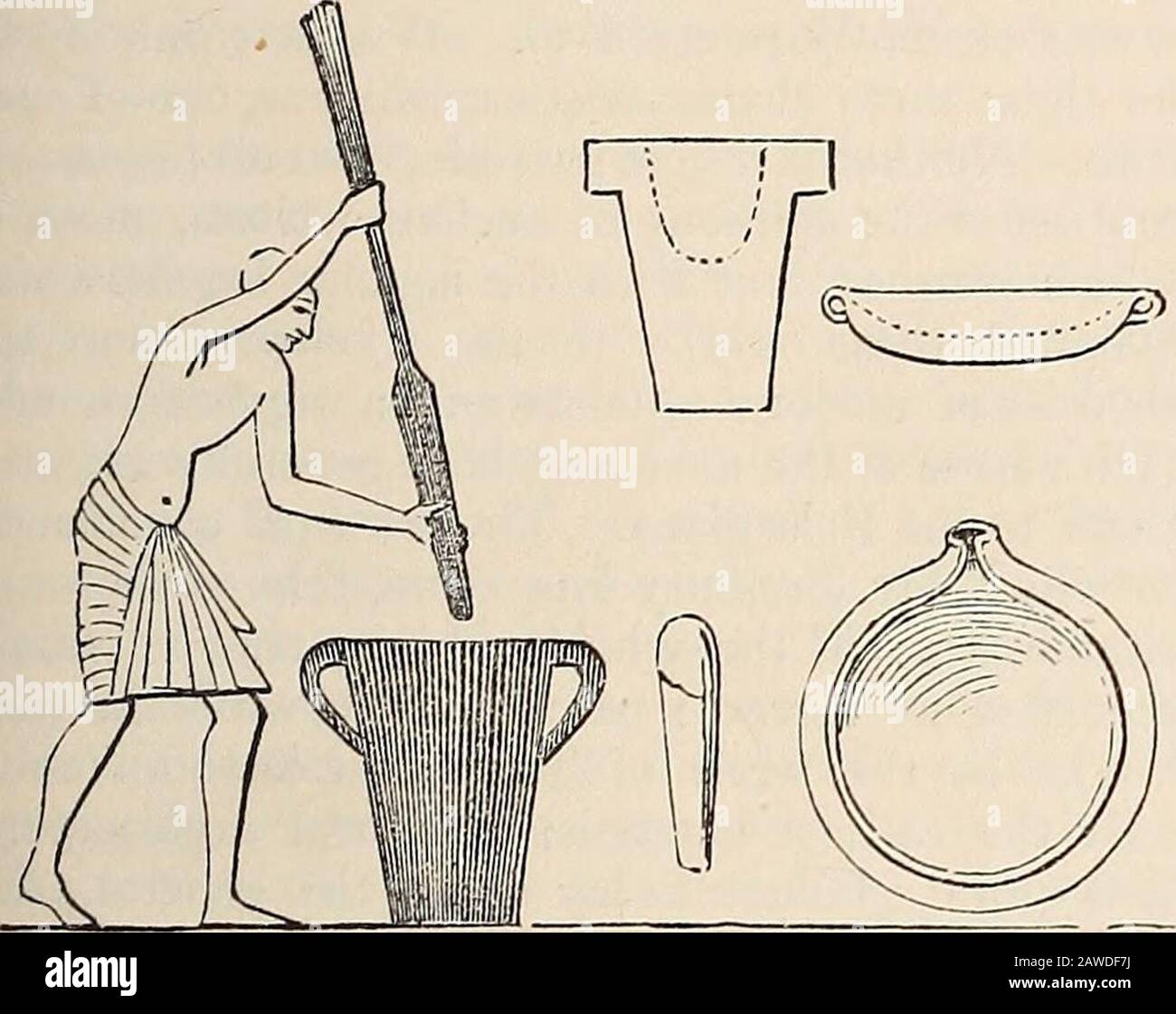 A dictionary of Greek and Roman antiquities.. . e evidently to be madefrom straight portions of the trunks or branches oftrees, and the thicker and shorter of them was tobe hollowed. They might then be used in the MUNYCHIA. MURUS. 769 manner represented in a painting on the tomb ofltemeses III. at Thebes (see woodcut, left-handfigure taken from Wilkinson, vol. ii. p. 383) ; forthere is no reason to doubt that the Egyptians andthe Greeks fashioned and used their mortars in thesame manner. (See also Wilkinson, vol. iii. p.181, showing three stone mortars with metal pes-tles.) In these paintings Stock Photohttps://www.alamy.com/image-license-details/?v=1https://www.alamy.com/a-dictionary-of-greek-and-roman-antiquities-e-evidently-to-be-madefrom-straight-portions-of-the-trunks-or-branches-oftrees-and-the-thicker-and-shorter-of-them-was-tobe-hollowed-they-might-then-be-used-in-the-munychia-murus-769-manner-represented-in-a-painting-on-the-tomb-ofltemeses-iii-at-thebes-see-woodcut-left-handfigure-taken-from-wilkinson-vol-ii-p-383-forthere-is-no-reason-to-doubt-that-the-egyptians-andthe-greeks-fashioned-and-used-their-mortars-in-thesame-manner-see-also-wilkinson-vol-iii-p181-showing-three-stone-mortars-with-metal-pes-tles-in-these-paintings-image342660742.html
A dictionary of Greek and Roman antiquities.. . e evidently to be madefrom straight portions of the trunks or branches oftrees, and the thicker and shorter of them was tobe hollowed. They might then be used in the MUNYCHIA. MURUS. 769 manner represented in a painting on the tomb ofltemeses III. at Thebes (see woodcut, left-handfigure taken from Wilkinson, vol. ii. p. 383) ; forthere is no reason to doubt that the Egyptians andthe Greeks fashioned and used their mortars in thesame manner. (See also Wilkinson, vol. iii. p.181, showing three stone mortars with metal pes-tles.) In these paintings Stock Photohttps://www.alamy.com/image-license-details/?v=1https://www.alamy.com/a-dictionary-of-greek-and-roman-antiquities-e-evidently-to-be-madefrom-straight-portions-of-the-trunks-or-branches-oftrees-and-the-thicker-and-shorter-of-them-was-tobe-hollowed-they-might-then-be-used-in-the-munychia-murus-769-manner-represented-in-a-painting-on-the-tomb-ofltemeses-iii-at-thebes-see-woodcut-left-handfigure-taken-from-wilkinson-vol-ii-p-383-forthere-is-no-reason-to-doubt-that-the-egyptians-andthe-greeks-fashioned-and-used-their-mortars-in-thesame-manner-see-also-wilkinson-vol-iii-p181-showing-three-stone-mortars-with-metal-pes-tles-in-these-paintings-image342660742.htmlRM2AWDF7J–A dictionary of Greek and Roman antiquities.. . e evidently to be madefrom straight portions of the trunks or branches oftrees, and the thicker and shorter of them was tobe hollowed. They might then be used in the MUNYCHIA. MURUS. 769 manner represented in a painting on the tomb ofltemeses III. at Thebes (see woodcut, left-handfigure taken from Wilkinson, vol. ii. p. 383) ; forthere is no reason to doubt that the Egyptians andthe Greeks fashioned and used their mortars in thesame manner. (See also Wilkinson, vol. iii. p.181, showing three stone mortars with metal pes-tles.) In these paintings
![A dictionary of Greek and Roman antiquities.. . dErcoIano, vol. i. p. 257.) [J. Y.] ANTOMOSIA (avTWfioaia). [Anakrisis,p. 92, a ; Paragraphe.] ANTYX (dvrv%, probably allied etymologicallyto cfyi7ru|), the rim or border of any thing, espe-cially of a shield, or chariot. The rim of the largeround shield of the ancient Greeks was thinnerthan the part which it enclosed. Thus the orna-mental border of the shield of Achilles, fabricatedby Hephaestus, was only threefold, the shield itselfbeing sevenfold. {II. xviii. 479 ; comp. xx. 275.)See examples of the antyx of a shield in woodcutsto Antefixa, Ar Stock Photo A dictionary of Greek and Roman antiquities.. . dErcoIano, vol. i. p. 257.) [J. Y.] ANTOMOSIA (avTWfioaia). [Anakrisis,p. 92, a ; Paragraphe.] ANTYX (dvrv%, probably allied etymologicallyto cfyi7ru|), the rim or border of any thing, espe-cially of a shield, or chariot. The rim of the largeround shield of the ancient Greeks was thinnerthan the part which it enclosed. Thus the orna-mental border of the shield of Achilles, fabricatedby Hephaestus, was only threefold, the shield itselfbeing sevenfold. {II. xviii. 479 ; comp. xx. 275.)See examples of the antyx of a shield in woodcutsto Antefixa, Ar Stock Photo](https://c8.alamy.com/comp/2AWHY4W/a-dictionary-of-greek-and-roman-antiquities-dercoiano-vol-i-p-257-j-y-antomosia-avtwfioaia-anakrisisp-92-a-paragraphe-antyx-dvrv-probably-allied-etymologicallyto-cfyi7ru-the-rim-or-border-of-any-thing-espe-cially-of-a-shield-or-chariot-the-rim-of-the-largeround-shield-of-the-ancient-greeks-was-thinnerthan-the-part-which-it-enclosed-thus-the-orna-mental-border-of-the-shield-of-achilles-fabricatedby-hephaestus-was-only-threefold-the-shield-itselfbeing-sevenfold-ii-xviii-479-comp-xx-275see-examples-of-the-antyx-of-a-shield-in-woodcutsto-antefixa-ar-2AWHY4W.jpg) A dictionary of Greek and Roman antiquities.. . dErcoIano, vol. i. p. 257.) [J. Y.] ANTOMOSIA (avTWfioaia). [Anakrisis,p. 92, a ; Paragraphe.] ANTYX (dvrv%, probably allied etymologicallyto cfyi7ru|), the rim or border of any thing, espe-cially of a shield, or chariot. The rim of the largeround shield of the ancient Greeks was thinnerthan the part which it enclosed. Thus the orna-mental border of the shield of Achilles, fabricatedby Hephaestus, was only threefold, the shield itselfbeing sevenfold. {II. xviii. 479 ; comp. xx. 275.)See examples of the antyx of a shield in woodcutsto Antefixa, Ar Stock Photohttps://www.alamy.com/image-license-details/?v=1https://www.alamy.com/a-dictionary-of-greek-and-roman-antiquities-dercoiano-vol-i-p-257-j-y-antomosia-avtwfioaia-anakrisisp-92-a-paragraphe-antyx-dvrv-probably-allied-etymologicallyto-cfyi7ru-the-rim-or-border-of-any-thing-espe-cially-of-a-shield-or-chariot-the-rim-of-the-largeround-shield-of-the-ancient-greeks-was-thinnerthan-the-part-which-it-enclosed-thus-the-orna-mental-border-of-the-shield-of-achilles-fabricatedby-hephaestus-was-only-threefold-the-shield-itselfbeing-sevenfold-ii-xviii-479-comp-xx-275see-examples-of-the-antyx-of-a-shield-in-woodcutsto-antefixa-ar-image342757881.html
A dictionary of Greek and Roman antiquities.. . dErcoIano, vol. i. p. 257.) [J. Y.] ANTOMOSIA (avTWfioaia). [Anakrisis,p. 92, a ; Paragraphe.] ANTYX (dvrv%, probably allied etymologicallyto cfyi7ru|), the rim or border of any thing, espe-cially of a shield, or chariot. The rim of the largeround shield of the ancient Greeks was thinnerthan the part which it enclosed. Thus the orna-mental border of the shield of Achilles, fabricatedby Hephaestus, was only threefold, the shield itselfbeing sevenfold. {II. xviii. 479 ; comp. xx. 275.)See examples of the antyx of a shield in woodcutsto Antefixa, Ar Stock Photohttps://www.alamy.com/image-license-details/?v=1https://www.alamy.com/a-dictionary-of-greek-and-roman-antiquities-dercoiano-vol-i-p-257-j-y-antomosia-avtwfioaia-anakrisisp-92-a-paragraphe-antyx-dvrv-probably-allied-etymologicallyto-cfyi7ru-the-rim-or-border-of-any-thing-espe-cially-of-a-shield-or-chariot-the-rim-of-the-largeround-shield-of-the-ancient-greeks-was-thinnerthan-the-part-which-it-enclosed-thus-the-orna-mental-border-of-the-shield-of-achilles-fabricatedby-hephaestus-was-only-threefold-the-shield-itselfbeing-sevenfold-ii-xviii-479-comp-xx-275see-examples-of-the-antyx-of-a-shield-in-woodcutsto-antefixa-ar-image342757881.htmlRM2AWHY4W–A dictionary of Greek and Roman antiquities.. . dErcoIano, vol. i. p. 257.) [J. Y.] ANTOMOSIA (avTWfioaia). [Anakrisis,p. 92, a ; Paragraphe.] ANTYX (dvrv%, probably allied etymologicallyto cfyi7ru|), the rim or border of any thing, espe-cially of a shield, or chariot. The rim of the largeround shield of the ancient Greeks was thinnerthan the part which it enclosed. Thus the orna-mental border of the shield of Achilles, fabricatedby Hephaestus, was only threefold, the shield itselfbeing sevenfold. {II. xviii. 479 ; comp. xx. 275.)See examples of the antyx of a shield in woodcutsto Antefixa, Ar
![The seven great monarchies of the ancient eastern world: or, The history, geography and antiquities of Chaldæa, Assyria, Babylon, Media, Persia, Parthia, and Sassanian or New Persian empire . Assyrian goat and sheep (Koyunjik). Fig. 2.. Vine trained on a lir (?), from the North Palace, Koyunjik. CH. VII.] WAR-CHARIOTS. 243 horses. They seem to have had but a single pole.i Wherethree horses were used, one must therefore have been attachedmerely by a rope or thong, like the side horses of the Greeks,and can scarcely have been of much service for drawing the ve-hicle. He seems rightly regarded as Stock Photo The seven great monarchies of the ancient eastern world: or, The history, geography and antiquities of Chaldæa, Assyria, Babylon, Media, Persia, Parthia, and Sassanian or New Persian empire . Assyrian goat and sheep (Koyunjik). Fig. 2.. Vine trained on a lir (?), from the North Palace, Koyunjik. CH. VII.] WAR-CHARIOTS. 243 horses. They seem to have had but a single pole.i Wherethree horses were used, one must therefore have been attachedmerely by a rope or thong, like the side horses of the Greeks,and can scarcely have been of much service for drawing the ve-hicle. He seems rightly regarded as Stock Photo](https://c8.alamy.com/comp/2AN0PGY/the-seven-great-monarchies-of-the-ancient-eastern-world-or-the-history-geography-and-antiquities-of-chalda-assyria-babylon-media-persia-parthia-and-sassanian-or-new-persian-empire-assyrian-goat-and-sheep-koyunjik-fig-2-vine-trained-on-a-lir-from-the-north-palace-koyunjik-ch-vii-war-chariots-243-horses-they-seem-to-have-had-but-a-single-polei-wherethree-horses-were-used-one-must-therefore-have-been-attachedmerely-by-a-rope-or-thong-like-the-side-horses-of-the-greeksand-can-scarcely-have-been-of-much-service-for-drawing-the-ve-hicle-he-seems-rightly-regarded-as-2AN0PGY.jpg) The seven great monarchies of the ancient eastern world: or, The history, geography and antiquities of Chaldæa, Assyria, Babylon, Media, Persia, Parthia, and Sassanian or New Persian empire . Assyrian goat and sheep (Koyunjik). Fig. 2.. Vine trained on a lir (?), from the North Palace, Koyunjik. CH. VII.] WAR-CHARIOTS. 243 horses. They seem to have had but a single pole.i Wherethree horses were used, one must therefore have been attachedmerely by a rope or thong, like the side horses of the Greeks,and can scarcely have been of much service for drawing the ve-hicle. He seems rightly regarded as Stock Photohttps://www.alamy.com/image-license-details/?v=1https://www.alamy.com/the-seven-great-monarchies-of-the-ancient-eastern-world-or-the-history-geography-and-antiquities-of-chalda-assyria-babylon-media-persia-parthia-and-sassanian-or-new-persian-empire-assyrian-goat-and-sheep-koyunjik-fig-2-vine-trained-on-a-lir-from-the-north-palace-koyunjik-ch-vii-war-chariots-243-horses-they-seem-to-have-had-but-a-single-polei-wherethree-horses-were-used-one-must-therefore-have-been-attachedmerely-by-a-rope-or-thong-like-the-side-horses-of-the-greeksand-can-scarcely-have-been-of-much-service-for-drawing-the-ve-hicle-he-seems-rightly-regarded-as-image339922491.html
The seven great monarchies of the ancient eastern world: or, The history, geography and antiquities of Chaldæa, Assyria, Babylon, Media, Persia, Parthia, and Sassanian or New Persian empire . Assyrian goat and sheep (Koyunjik). Fig. 2.. Vine trained on a lir (?), from the North Palace, Koyunjik. CH. VII.] WAR-CHARIOTS. 243 horses. They seem to have had but a single pole.i Wherethree horses were used, one must therefore have been attachedmerely by a rope or thong, like the side horses of the Greeks,and can scarcely have been of much service for drawing the ve-hicle. He seems rightly regarded as Stock Photohttps://www.alamy.com/image-license-details/?v=1https://www.alamy.com/the-seven-great-monarchies-of-the-ancient-eastern-world-or-the-history-geography-and-antiquities-of-chalda-assyria-babylon-media-persia-parthia-and-sassanian-or-new-persian-empire-assyrian-goat-and-sheep-koyunjik-fig-2-vine-trained-on-a-lir-from-the-north-palace-koyunjik-ch-vii-war-chariots-243-horses-they-seem-to-have-had-but-a-single-polei-wherethree-horses-were-used-one-must-therefore-have-been-attachedmerely-by-a-rope-or-thong-like-the-side-horses-of-the-greeksand-can-scarcely-have-been-of-much-service-for-drawing-the-ve-hicle-he-seems-rightly-regarded-as-image339922491.htmlRM2AN0PGY–The seven great monarchies of the ancient eastern world: or, The history, geography and antiquities of Chaldæa, Assyria, Babylon, Media, Persia, Parthia, and Sassanian or New Persian empire . Assyrian goat and sheep (Koyunjik). Fig. 2.. Vine trained on a lir (?), from the North Palace, Koyunjik. CH. VII.] WAR-CHARIOTS. 243 horses. They seem to have had but a single pole.i Wherethree horses were used, one must therefore have been attachedmerely by a rope or thong, like the side horses of the Greeks,and can scarcely have been of much service for drawing the ve-hicle. He seems rightly regarded as
![A dictionary of Greek and Roman antiquities.. . ictorious generals was like-wise in use among the Greeks, for they were pro-fusely lavished upon Alexander after his conquestof Dareius (Athen. xii. p. 539, a) ; and theRomans probably borrowed the custom from theGreeks. [Aurum CoRonarium.] VII. Corona Ova lis was another crown of lessestimation, appropriated solely t) commanders. Itwas given to those who merely deserved an ovation, which happened when the war was not duly de-clared, or was carried on against a very inferiorforce, or with persons not considered by the lawsof nations as lawful ene Stock Photo A dictionary of Greek and Roman antiquities.. . ictorious generals was like-wise in use among the Greeks, for they were pro-fusely lavished upon Alexander after his conquestof Dareius (Athen. xii. p. 539, a) ; and theRomans probably borrowed the custom from theGreeks. [Aurum CoRonarium.] VII. Corona Ova lis was another crown of lessestimation, appropriated solely t) commanders. Itwas given to those who merely deserved an ovation, which happened when the war was not duly de-clared, or was carried on against a very inferiorforce, or with persons not considered by the lawsof nations as lawful ene Stock Photo](https://c8.alamy.com/comp/2AKYPJ4/a-dictionary-of-greek-and-roman-antiquities-ictorious-generals-was-like-wise-in-use-among-the-greeks-for-they-were-pro-fusely-lavished-upon-alexander-after-his-conquestof-dareius-athen-xii-p-539-a-and-theromans-probably-borrowed-the-custom-from-thegreeks-aurum-coronarium-vii-corona-ova-lis-was-another-crown-of-lessestimation-appropriated-solely-t-commanders-itwas-given-to-those-who-merely-deserved-an-ovation-which-happened-when-the-war-was-not-duly-de-clared-or-was-carried-on-against-a-very-inferiorforce-or-with-persons-not-considered-by-the-lawsof-nations-as-lawful-ene-2AKYPJ4.jpg) A dictionary of Greek and Roman antiquities.. . ictorious generals was like-wise in use among the Greeks, for they were pro-fusely lavished upon Alexander after his conquestof Dareius (Athen. xii. p. 539, a) ; and theRomans probably borrowed the custom from theGreeks. [Aurum CoRonarium.] VII. Corona Ova lis was another crown of lessestimation, appropriated solely t) commanders. Itwas given to those who merely deserved an ovation, which happened when the war was not duly de-clared, or was carried on against a very inferiorforce, or with persons not considered by the lawsof nations as lawful ene Stock Photohttps://www.alamy.com/image-license-details/?v=1https://www.alamy.com/a-dictionary-of-greek-and-roman-antiquities-ictorious-generals-was-like-wise-in-use-among-the-greeks-for-they-were-pro-fusely-lavished-upon-alexander-after-his-conquestof-dareius-athen-xii-p-539-a-and-theromans-probably-borrowed-the-custom-from-thegreeks-aurum-coronarium-vii-corona-ova-lis-was-another-crown-of-lessestimation-appropriated-solely-t-commanders-itwas-given-to-those-who-merely-deserved-an-ovation-which-happened-when-the-war-was-not-duly-de-clared-or-was-carried-on-against-a-very-inferiorforce-or-with-persons-not-considered-by-the-lawsof-nations-as-lawful-ene-image339285916.html
A dictionary of Greek and Roman antiquities.. . ictorious generals was like-wise in use among the Greeks, for they were pro-fusely lavished upon Alexander after his conquestof Dareius (Athen. xii. p. 539, a) ; and theRomans probably borrowed the custom from theGreeks. [Aurum CoRonarium.] VII. Corona Ova lis was another crown of lessestimation, appropriated solely t) commanders. Itwas given to those who merely deserved an ovation, which happened when the war was not duly de-clared, or was carried on against a very inferiorforce, or with persons not considered by the lawsof nations as lawful ene Stock Photohttps://www.alamy.com/image-license-details/?v=1https://www.alamy.com/a-dictionary-of-greek-and-roman-antiquities-ictorious-generals-was-like-wise-in-use-among-the-greeks-for-they-were-pro-fusely-lavished-upon-alexander-after-his-conquestof-dareius-athen-xii-p-539-a-and-theromans-probably-borrowed-the-custom-from-thegreeks-aurum-coronarium-vii-corona-ova-lis-was-another-crown-of-lessestimation-appropriated-solely-t-commanders-itwas-given-to-those-who-merely-deserved-an-ovation-which-happened-when-the-war-was-not-duly-de-clared-or-was-carried-on-against-a-very-inferiorforce-or-with-persons-not-considered-by-the-lawsof-nations-as-lawful-ene-image339285916.htmlRM2AKYPJ4–A dictionary of Greek and Roman antiquities.. . ictorious generals was like-wise in use among the Greeks, for they were pro-fusely lavished upon Alexander after his conquestof Dareius (Athen. xii. p. 539, a) ; and theRomans probably borrowed the custom from theGreeks. [Aurum CoRonarium.] VII. Corona Ova lis was another crown of lessestimation, appropriated solely t) commanders. Itwas given to those who merely deserved an ovation, which happened when the war was not duly de-clared, or was carried on against a very inferiorforce, or with persons not considered by the lawsof nations as lawful ene
 A dictionary of Greek and Roman antiquities.. . l. (Comp. Aristoph. T7iesm. 257.) Some-times, at least among the Romans, a bladder wasused to answer the same purpose. (Mart. viii. 33.19.) The jj.iTpa was a broad band of cloth ofdifferent colours, which was wound round thehair, and was worn in various ways. It wasoriginally an Eastern head-dress, and may, there-fore, be compared to the modern turban. It issometimes spoken of as characteristic of the Phry-gians. (Herod, i. 195, vii. 62 ; Virg. Aen. ix.616, 617 ; Juv. iii. 66.) It was, however, alsoworn by the Greeks, and Polygnotus is said tohav Stock Photohttps://www.alamy.com/image-license-details/?v=1https://www.alamy.com/a-dictionary-of-greek-and-roman-antiquities-l-comp-aristoph-t7iesm-257-some-times-at-least-among-the-romans-a-bladder-wasused-to-answer-the-same-purpose-mart-viii-3319-the-jjitpa-was-a-broad-band-of-cloth-ofdifferent-colours-which-was-wound-round-thehair-and-was-worn-in-various-ways-it-wasoriginally-an-eastern-head-dress-and-may-there-fore-be-compared-to-the-modern-turban-it-issometimes-spoken-of-as-characteristic-of-the-phry-gians-herod-i-195-vii-62-virg-aen-ix616-617-juv-iii-66-it-was-however-alsoworn-by-the-greeks-and-polygnotus-is-said-tohav-image342711868.html
A dictionary of Greek and Roman antiquities.. . l. (Comp. Aristoph. T7iesm. 257.) Some-times, at least among the Romans, a bladder wasused to answer the same purpose. (Mart. viii. 33.19.) The jj.iTpa was a broad band of cloth ofdifferent colours, which was wound round thehair, and was worn in various ways. It wasoriginally an Eastern head-dress, and may, there-fore, be compared to the modern turban. It issometimes spoken of as characteristic of the Phry-gians. (Herod, i. 195, vii. 62 ; Virg. Aen. ix.616, 617 ; Juv. iii. 66.) It was, however, alsoworn by the Greeks, and Polygnotus is said tohav Stock Photohttps://www.alamy.com/image-license-details/?v=1https://www.alamy.com/a-dictionary-of-greek-and-roman-antiquities-l-comp-aristoph-t7iesm-257-some-times-at-least-among-the-romans-a-bladder-wasused-to-answer-the-same-purpose-mart-viii-3319-the-jjitpa-was-a-broad-band-of-cloth-ofdifferent-colours-which-was-wound-round-thehair-and-was-worn-in-various-ways-it-wasoriginally-an-eastern-head-dress-and-may-there-fore-be-compared-to-the-modern-turban-it-issometimes-spoken-of-as-characteristic-of-the-phry-gians-herod-i-195-vii-62-virg-aen-ix616-617-juv-iii-66-it-was-however-alsoworn-by-the-greeks-and-polygnotus-is-said-tohav-image342711868.htmlRM2AWFTDG–A dictionary of Greek and Roman antiquities.. . l. (Comp. Aristoph. T7iesm. 257.) Some-times, at least among the Romans, a bladder wasused to answer the same purpose. (Mart. viii. 33.19.) The jj.iTpa was a broad band of cloth ofdifferent colours, which was wound round thehair, and was worn in various ways. It wasoriginally an Eastern head-dress, and may, there-fore, be compared to the modern turban. It issometimes spoken of as characteristic of the Phry-gians. (Herod, i. 195, vii. 62 ; Virg. Aen. ix.616, 617 ; Juv. iii. 66.) It was, however, alsoworn by the Greeks, and Polygnotus is said tohav
![The antiquities of Herculaneum . itsmother, or certainly fome perfon who remarks its actions [4].We may venture to conjecture, that the Painter intended for [1] Catalogue, n. 736. [2] His right arm is covered. The tunic, which had a fleeve on one fide only,or as Kuhnius obferves, on the left fide, was called by the Greeks ST£poiuwxpi%nuv, and was proper to flaves. Pollux vii. 47. [3] This man may either be a fhepherd or fome hero. The feholiaft of Apol-lonius on Argon, iii. 324. fays : crvvrfisg rois rjpucri to $;pfjMTc(popHv. It was the cujlom ofheroes to wear the /kins of beafts. [4] It has Stock Photo The antiquities of Herculaneum . itsmother, or certainly fome perfon who remarks its actions [4].We may venture to conjecture, that the Painter intended for [1] Catalogue, n. 736. [2] His right arm is covered. The tunic, which had a fleeve on one fide only,or as Kuhnius obferves, on the left fide, was called by the Greeks ST£poiuwxpi%nuv, and was proper to flaves. Pollux vii. 47. [3] This man may either be a fhepherd or fome hero. The feholiaft of Apol-lonius on Argon, iii. 324. fays : crvvrfisg rois rjpucri to $;pfjMTc(popHv. It was the cujlom ofheroes to wear the /kins of beafts. [4] It has Stock Photo](https://c8.alamy.com/comp/2AX836E/the-antiquities-of-herculaneum-itsmother-or-certainly-fome-perfon-who-remarks-its-actions-4-we-may-venture-to-conjecture-that-the-painter-intended-for-1-catalogue-n-736-2-his-right-arm-is-covered-the-tunic-which-had-a-fleeve-on-one-fide-onlyor-as-kuhnius-obferves-on-the-left-fide-was-called-by-the-greeks-stpoiuwxpinuv-and-was-proper-to-flaves-pollux-vii-47-3-this-man-may-either-be-a-fhepherd-or-fome-hero-the-feholiaft-of-apol-lonius-on-argon-iii-324-fays-crvvrfisg-rois-rjpucri-to-pfjmtcpophv-it-was-the-cujlom-ofheroes-to-wear-the-kins-of-beafts-4-it-has-2AX836E.jpg) The antiquities of Herculaneum . itsmother, or certainly fome perfon who remarks its actions [4].We may venture to conjecture, that the Painter intended for [1] Catalogue, n. 736. [2] His right arm is covered. The tunic, which had a fleeve on one fide only,or as Kuhnius obferves, on the left fide, was called by the Greeks ST£poiuwxpi%nuv, and was proper to flaves. Pollux vii. 47. [3] This man may either be a fhepherd or fome hero. The feholiaft of Apol-lonius on Argon, iii. 324. fays : crvvrfisg rois rjpucri to $;pfjMTc(popHv. It was the cujlom ofheroes to wear the /kins of beafts. [4] It has Stock Photohttps://www.alamy.com/image-license-details/?v=1https://www.alamy.com/the-antiquities-of-herculaneum-itsmother-or-certainly-fome-perfon-who-remarks-its-actions-4-we-may-venture-to-conjecture-that-the-painter-intended-for-1-catalogue-n-736-2-his-right-arm-is-covered-the-tunic-which-had-a-fleeve-on-one-fide-onlyor-as-kuhnius-obferves-on-the-left-fide-was-called-by-the-greeks-stpoiuwxpinuv-and-was-proper-to-flaves-pollux-vii-47-3-this-man-may-either-be-a-fhepherd-or-fome-hero-the-feholiaft-of-apol-lonius-on-argon-iii-324-fays-crvvrfisg-rois-rjpucri-to-pfjmtcpophv-it-was-the-cujlom-ofheroes-to-wear-the-kins-of-beafts-4-it-has-image343156198.html
The antiquities of Herculaneum . itsmother, or certainly fome perfon who remarks its actions [4].We may venture to conjecture, that the Painter intended for [1] Catalogue, n. 736. [2] His right arm is covered. The tunic, which had a fleeve on one fide only,or as Kuhnius obferves, on the left fide, was called by the Greeks ST£poiuwxpi%nuv, and was proper to flaves. Pollux vii. 47. [3] This man may either be a fhepherd or fome hero. The feholiaft of Apol-lonius on Argon, iii. 324. fays : crvvrfisg rois rjpucri to $;pfjMTc(popHv. It was the cujlom ofheroes to wear the /kins of beafts. [4] It has Stock Photohttps://www.alamy.com/image-license-details/?v=1https://www.alamy.com/the-antiquities-of-herculaneum-itsmother-or-certainly-fome-perfon-who-remarks-its-actions-4-we-may-venture-to-conjecture-that-the-painter-intended-for-1-catalogue-n-736-2-his-right-arm-is-covered-the-tunic-which-had-a-fleeve-on-one-fide-onlyor-as-kuhnius-obferves-on-the-left-fide-was-called-by-the-greeks-stpoiuwxpinuv-and-was-proper-to-flaves-pollux-vii-47-3-this-man-may-either-be-a-fhepherd-or-fome-hero-the-feholiaft-of-apol-lonius-on-argon-iii-324-fays-crvvrfisg-rois-rjpucri-to-pfjmtcpophv-it-was-the-cujlom-ofheroes-to-wear-the-kins-of-beafts-4-it-has-image343156198.htmlRM2AX836E–The antiquities of Herculaneum . itsmother, or certainly fome perfon who remarks its actions [4].We may venture to conjecture, that the Painter intended for [1] Catalogue, n. 736. [2] His right arm is covered. The tunic, which had a fleeve on one fide only,or as Kuhnius obferves, on the left fide, was called by the Greeks ST£poiuwxpi%nuv, and was proper to flaves. Pollux vii. 47. [3] This man may either be a fhepherd or fome hero. The feholiaft of Apol-lonius on Argon, iii. 324. fays : crvvrfisg rois rjpucri to $;pfjMTc(popHv. It was the cujlom ofheroes to wear the /kins of beafts. [4] It has
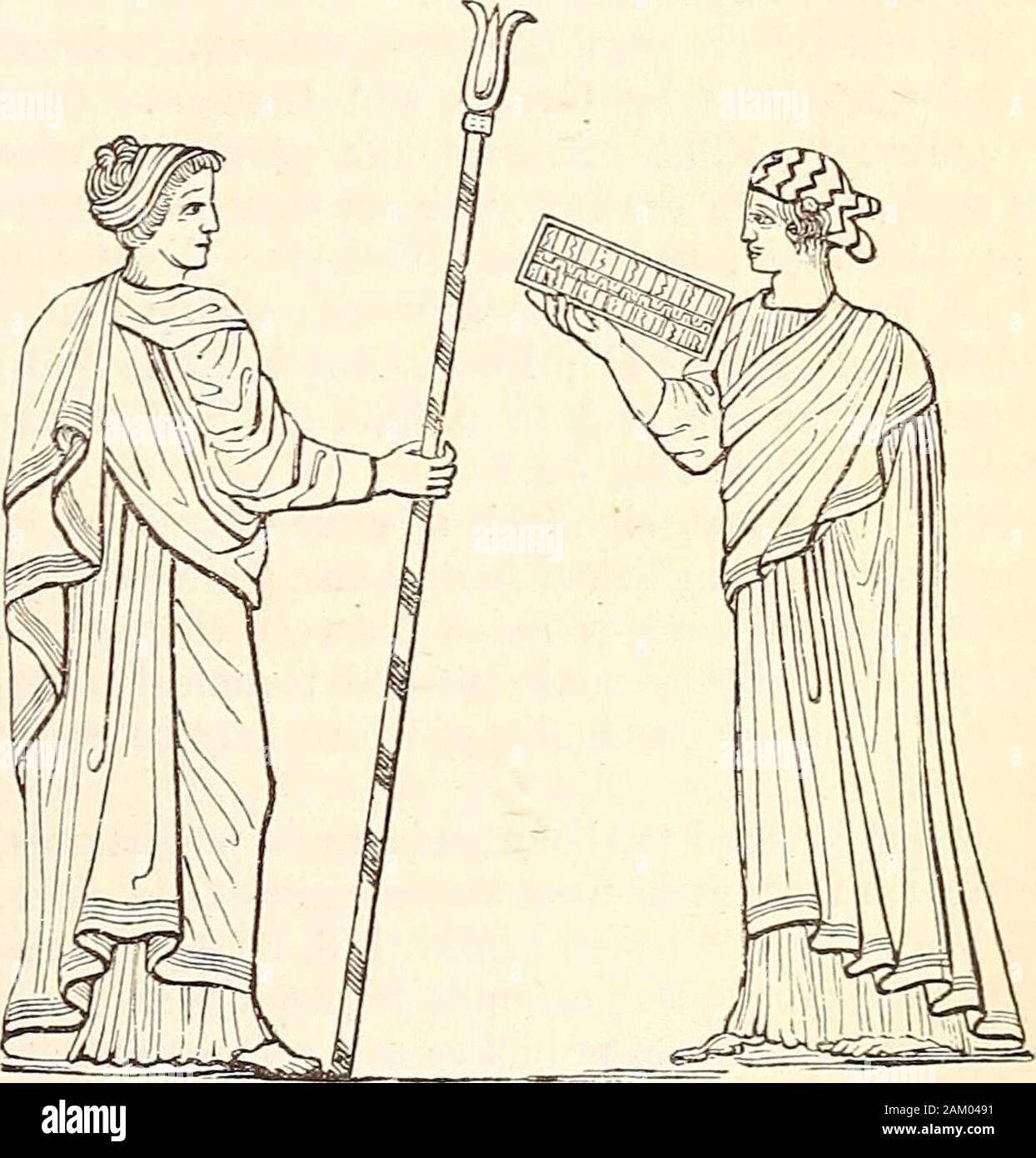 A dictionary of Greek and Roman antiquities.. . Comp. Aristoph. Thesm. 257.) Some-times, at least among the Romans, a bladder wasused to answer the same purpose. (Mart. viii. 33.19.) The jxirpa was a broad band of cloth ofdifferent colours, which was woimd round thehair, and was worn in various ways. It wasoriginally an Eastern head-dress, and may, there-fore, be compared to the modern turban. It issometimes spoken of as characteristic of the Phry-gians. (Herod, i. 195, vii. 62 ; Virg. Aen. ix.616, 617 ; Juv. iii. 66.) It was, however, alsoworn by the Greeks, and Polygnotus is said tohave been Stock Photohttps://www.alamy.com/image-license-details/?v=1https://www.alamy.com/a-dictionary-of-greek-and-roman-antiquities-comp-aristoph-thesm-257-some-times-at-least-among-the-romans-a-bladder-wasused-to-answer-the-same-purpose-mart-viii-3319-the-jxirpa-was-a-broad-band-of-cloth-ofdifferent-colours-which-was-woimd-round-thehair-and-was-worn-in-various-ways-it-wasoriginally-an-eastern-head-dress-and-may-there-fore-be-compared-to-the-modern-turban-it-issometimes-spoken-of-as-characteristic-of-the-phry-gians-herod-i-195-vii-62-virg-aen-ix616-617-juv-iii-66-it-was-however-alsoworn-by-the-greeks-and-polygnotus-is-said-tohave-been-image339293501.html
A dictionary of Greek and Roman antiquities.. . Comp. Aristoph. Thesm. 257.) Some-times, at least among the Romans, a bladder wasused to answer the same purpose. (Mart. viii. 33.19.) The jxirpa was a broad band of cloth ofdifferent colours, which was woimd round thehair, and was worn in various ways. It wasoriginally an Eastern head-dress, and may, there-fore, be compared to the modern turban. It issometimes spoken of as characteristic of the Phry-gians. (Herod, i. 195, vii. 62 ; Virg. Aen. ix.616, 617 ; Juv. iii. 66.) It was, however, alsoworn by the Greeks, and Polygnotus is said tohave been Stock Photohttps://www.alamy.com/image-license-details/?v=1https://www.alamy.com/a-dictionary-of-greek-and-roman-antiquities-comp-aristoph-thesm-257-some-times-at-least-among-the-romans-a-bladder-wasused-to-answer-the-same-purpose-mart-viii-3319-the-jxirpa-was-a-broad-band-of-cloth-ofdifferent-colours-which-was-woimd-round-thehair-and-was-worn-in-various-ways-it-wasoriginally-an-eastern-head-dress-and-may-there-fore-be-compared-to-the-modern-turban-it-issometimes-spoken-of-as-characteristic-of-the-phry-gians-herod-i-195-vii-62-virg-aen-ix616-617-juv-iii-66-it-was-however-alsoworn-by-the-greeks-and-polygnotus-is-said-tohave-been-image339293501.htmlRM2AM0491–A dictionary of Greek and Roman antiquities.. . Comp. Aristoph. Thesm. 257.) Some-times, at least among the Romans, a bladder wasused to answer the same purpose. (Mart. viii. 33.19.) The jxirpa was a broad band of cloth ofdifferent colours, which was woimd round thehair, and was worn in various ways. It wasoriginally an Eastern head-dress, and may, there-fore, be compared to the modern turban. It issometimes spoken of as characteristic of the Phry-gians. (Herod, i. 195, vii. 62 ; Virg. Aen. ix.616, 617 ; Juv. iii. 66.) It was, however, alsoworn by the Greeks, and Polygnotus is said tohave been
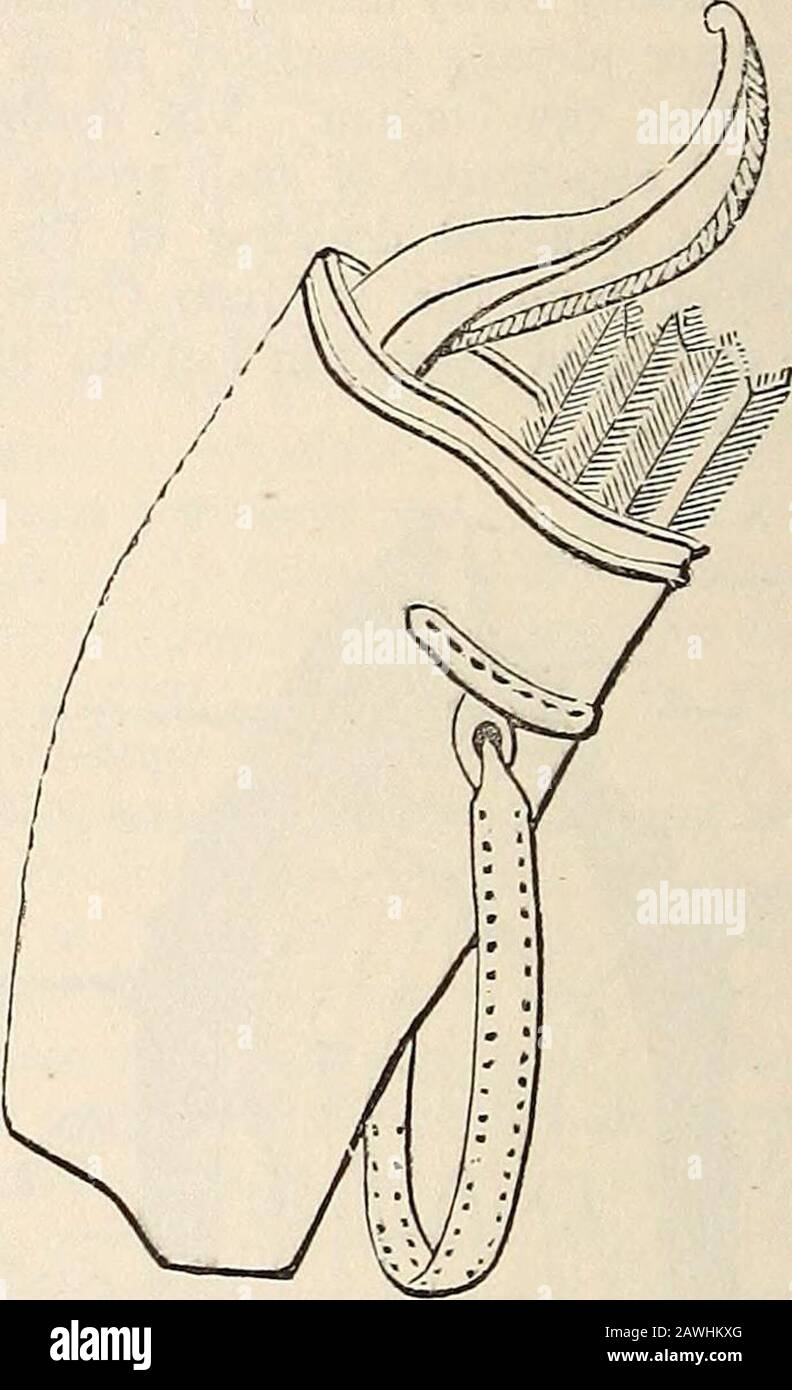 A dictionary of Greek and Roman antiquities.. . When not used, the bow was put into a case(to^oO^kyi, yoopvros, Corytus), which was made ofleather, and sometimes ornamented (<paeii/6s, Horn.Od. xxi. 54). The bow-case is very conspicuousin the sculptured bas-reliefs of Persepolis. Itfrequently held the arrows as well as the bow,and on this account is often confounded with thePharetra or quiver. Though its use was com-paratively rare among the Greeks and Romans,Ave find it exhibited in a bas-relief in the MuseoPio-Clementino (vol. iv. tav. 43), which is copiedin the annexed cut.. ARDALION (ap Stock Photohttps://www.alamy.com/image-license-details/?v=1https://www.alamy.com/a-dictionary-of-greek-and-roman-antiquities-when-not-used-the-bow-was-put-into-a-casetoookyi-yoopvros-corytus-which-was-made-ofleather-and-sometimes-ornamented-ltpaeii6s-hornod-xxi-54-the-bow-case-is-very-conspicuousin-the-sculptured-bas-reliefs-of-persepolis-itfrequently-held-the-arrows-as-well-as-the-bowand-on-this-account-is-often-confounded-with-thepharetra-or-quiver-though-its-use-was-com-paratively-rare-among-the-greeks-and-romansave-find-it-exhibited-in-a-bas-relief-in-the-museopio-clementino-vol-iv-tav-43-which-is-copiedin-the-annexed-cut-ardalion-ap-image342752216.html
A dictionary of Greek and Roman antiquities.. . When not used, the bow was put into a case(to^oO^kyi, yoopvros, Corytus), which was made ofleather, and sometimes ornamented (<paeii/6s, Horn.Od. xxi. 54). The bow-case is very conspicuousin the sculptured bas-reliefs of Persepolis. Itfrequently held the arrows as well as the bow,and on this account is often confounded with thePharetra or quiver. Though its use was com-paratively rare among the Greeks and Romans,Ave find it exhibited in a bas-relief in the MuseoPio-Clementino (vol. iv. tav. 43), which is copiedin the annexed cut.. ARDALION (ap Stock Photohttps://www.alamy.com/image-license-details/?v=1https://www.alamy.com/a-dictionary-of-greek-and-roman-antiquities-when-not-used-the-bow-was-put-into-a-casetoookyi-yoopvros-corytus-which-was-made-ofleather-and-sometimes-ornamented-ltpaeii6s-hornod-xxi-54-the-bow-case-is-very-conspicuousin-the-sculptured-bas-reliefs-of-persepolis-itfrequently-held-the-arrows-as-well-as-the-bowand-on-this-account-is-often-confounded-with-thepharetra-or-quiver-though-its-use-was-com-paratively-rare-among-the-greeks-and-romansave-find-it-exhibited-in-a-bas-relief-in-the-museopio-clementino-vol-iv-tav-43-which-is-copiedin-the-annexed-cut-ardalion-ap-image342752216.htmlRM2AWHKXG–A dictionary of Greek and Roman antiquities.. . When not used, the bow was put into a case(to^oO^kyi, yoopvros, Corytus), which was made ofleather, and sometimes ornamented (<paeii/6s, Horn.Od. xxi. 54). The bow-case is very conspicuousin the sculptured bas-reliefs of Persepolis. Itfrequently held the arrows as well as the bow,and on this account is often confounded with thePharetra or quiver. Though its use was com-paratively rare among the Greeks and Romans,Ave find it exhibited in a bas-relief in the MuseoPio-Clementino (vol. iv. tav. 43), which is copiedin the annexed cut.. ARDALION (ap
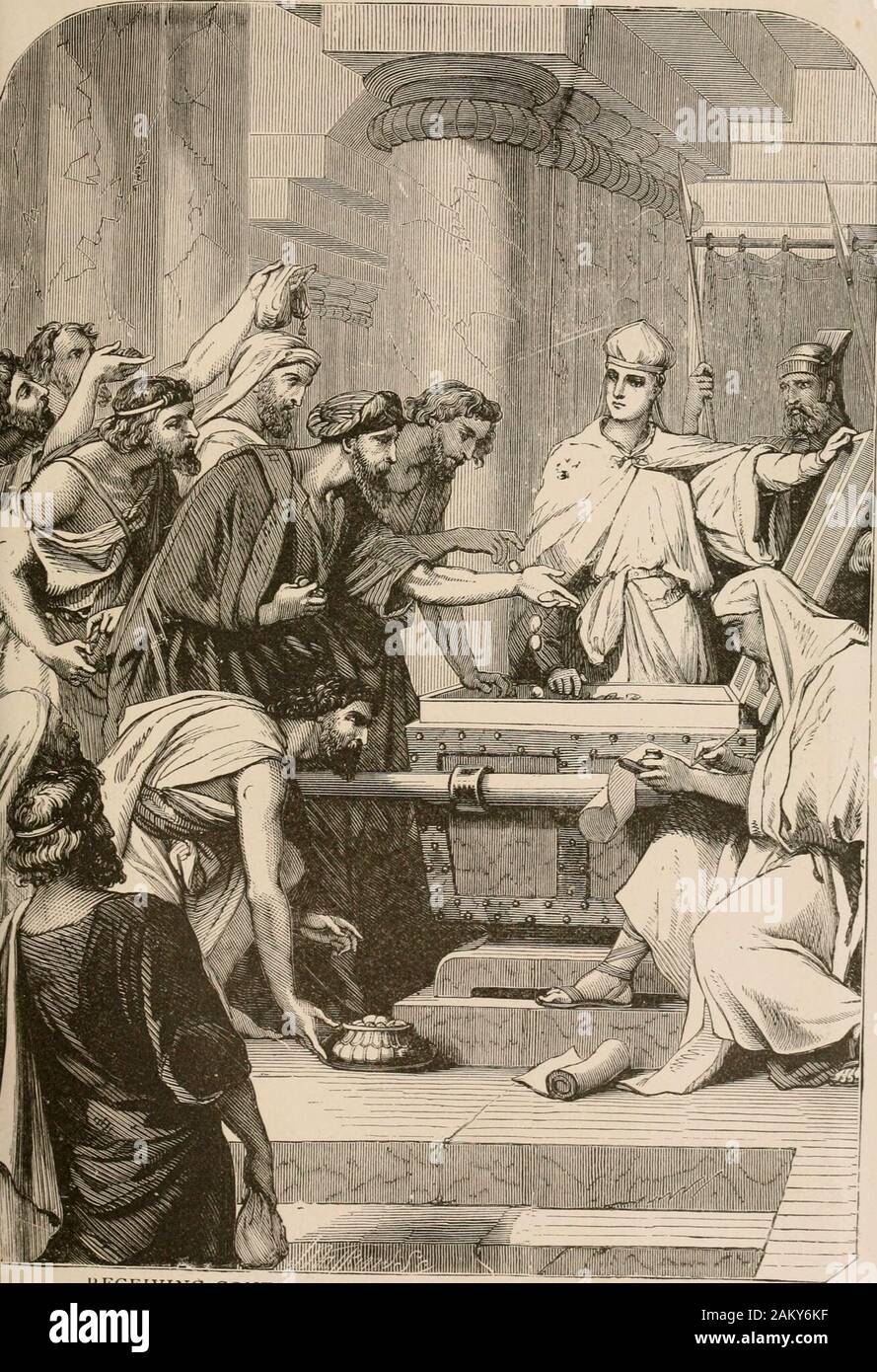 Antiquities of the Orient unveiled, containing a concise description of the remarkable ruins of King Solomon's temple, and store cities ,together with those of all the most ancient and renowned cities of the East, including Babylon, Nineveh, Damascus, and Shushan . ,JI1;: i! I ?iff ill 11, 1 :iili ^, . .; n liililil fes^ - J Vwri il?!fe- nlUI RECEIVING CONTRIBUTIONS EOR REBUILDING THE TEMPLE. , ^/>^ 1ft a *> :? ?6i recoveied by the Greeks. 637 it was taken byOmar, the second of the Kalifs, and thus passed un-der Mohammedan rule. The Mosque of Omar on theTemple site was built by this Moh Stock Photohttps://www.alamy.com/image-license-details/?v=1https://www.alamy.com/antiquities-of-the-orient-unveiled-containing-a-concise-description-of-the-remarkable-ruins-of-king-solomons-temple-and-store-cities-together-with-those-of-all-the-most-ancient-and-renowned-cities-of-the-east-including-babylon-nineveh-damascus-and-shushan-ji1-i!-i-iff-ill-11-1-iili-n-liililil-fes-j-vwri-il!fe-nlui-receiving-contributions-eor-rebuilding-the-temple-gt-1ft-a-gt-6i-recoveied-by-the-greeks-637-it-was-taken-byomar-the-second-of-the-kalifs-and-thus-passed-un-der-mohammedan-rule-the-mosque-of-omar-on-thetemple-site-was-built-by-this-moh-image339273411.html
Antiquities of the Orient unveiled, containing a concise description of the remarkable ruins of King Solomon's temple, and store cities ,together with those of all the most ancient and renowned cities of the East, including Babylon, Nineveh, Damascus, and Shushan . ,JI1;: i! I ?iff ill 11, 1 :iili ^, . .; n liililil fes^ - J Vwri il?!fe- nlUI RECEIVING CONTRIBUTIONS EOR REBUILDING THE TEMPLE. , ^/>^ 1ft a *> :? ?6i recoveied by the Greeks. 637 it was taken byOmar, the second of the Kalifs, and thus passed un-der Mohammedan rule. The Mosque of Omar on theTemple site was built by this Moh Stock Photohttps://www.alamy.com/image-license-details/?v=1https://www.alamy.com/antiquities-of-the-orient-unveiled-containing-a-concise-description-of-the-remarkable-ruins-of-king-solomons-temple-and-store-cities-together-with-those-of-all-the-most-ancient-and-renowned-cities-of-the-east-including-babylon-nineveh-damascus-and-shushan-ji1-i!-i-iff-ill-11-1-iili-n-liililil-fes-j-vwri-il!fe-nlui-receiving-contributions-eor-rebuilding-the-temple-gt-1ft-a-gt-6i-recoveied-by-the-greeks-637-it-was-taken-byomar-the-second-of-the-kalifs-and-thus-passed-un-der-mohammedan-rule-the-mosque-of-omar-on-thetemple-site-was-built-by-this-moh-image339273411.htmlRM2AKY6KF–Antiquities of the Orient unveiled, containing a concise description of the remarkable ruins of King Solomon's temple, and store cities ,together with those of all the most ancient and renowned cities of the East, including Babylon, Nineveh, Damascus, and Shushan . ,JI1;: i! I ?iff ill 11, 1 :iili ^, . .; n liililil fes^ - J Vwri il?!fe- nlUI RECEIVING CONTRIBUTIONS EOR REBUILDING THE TEMPLE. , ^/>^ 1ft a *> :? ?6i recoveied by the Greeks. 637 it was taken byOmar, the second of the Kalifs, and thus passed un-der Mohammedan rule. The Mosque of Omar on theTemple site was built by this Moh
 School dictionary of Greek and Roman antiquities . THE AEQIS AS WORN BT ATHENA iMlNEKVA), AENEATORES, were thosewho blewupon wind instruments in the Roman army ;namely, the huccinatores, cornicines, andtubicines. Tliey were also employed in thepublic games. AERA, a point of time from which sub-sequent or preceding years may be counted.The Greeks had no common aera till a com-paratively late period. The Athenians reckoned their years bythe name of the chief archon of each year,v/hence he was called archon eponymus (&px<^viirdvvfios); the Lacedaemonians by one ofthe ephors, and the Argives by Stock Photohttps://www.alamy.com/image-license-details/?v=1https://www.alamy.com/school-dictionary-of-greek-and-roman-antiquities-the-aeqis-as-worn-bt-athena-imlnekva-aeneatores-were-thosewho-blewupon-wind-instruments-in-the-roman-army-namely-the-huccinatores-cornicines-andtubicines-tliey-were-also-employed-in-thepublic-games-aera-a-point-of-time-from-which-sub-sequent-or-preceding-years-may-be-countedthe-greeks-had-no-common-aera-till-a-com-paratively-late-period-the-athenians-reckoned-their-years-bythe-name-of-the-chief-archon-of-each-yearvhence-he-was-called-archon-eponymus-pxltviirdvvfios-the-lacedaemonians-by-one-ofthe-ephors-and-the-argives-by-image338502151.html
School dictionary of Greek and Roman antiquities . THE AEQIS AS WORN BT ATHENA iMlNEKVA), AENEATORES, were thosewho blewupon wind instruments in the Roman army ;namely, the huccinatores, cornicines, andtubicines. Tliey were also employed in thepublic games. AERA, a point of time from which sub-sequent or preceding years may be counted.The Greeks had no common aera till a com-paratively late period. The Athenians reckoned their years bythe name of the chief archon of each year,v/hence he was called archon eponymus (&px<^viirdvvfios); the Lacedaemonians by one ofthe ephors, and the Argives by Stock Photohttps://www.alamy.com/image-license-details/?v=1https://www.alamy.com/school-dictionary-of-greek-and-roman-antiquities-the-aeqis-as-worn-bt-athena-imlnekva-aeneatores-were-thosewho-blewupon-wind-instruments-in-the-roman-army-namely-the-huccinatores-cornicines-andtubicines-tliey-were-also-employed-in-thepublic-games-aera-a-point-of-time-from-which-sub-sequent-or-preceding-years-may-be-countedthe-greeks-had-no-common-aera-till-a-com-paratively-late-period-the-athenians-reckoned-their-years-bythe-name-of-the-chief-archon-of-each-yearvhence-he-was-called-archon-eponymus-pxltviirdvvfios-the-lacedaemonians-by-one-ofthe-ephors-and-the-argives-by-image338502151.htmlRM2AJM2XF–School dictionary of Greek and Roman antiquities . THE AEQIS AS WORN BT ATHENA iMlNEKVA), AENEATORES, were thosewho blewupon wind instruments in the Roman army ;namely, the huccinatores, cornicines, andtubicines. Tliey were also employed in thepublic games. AERA, a point of time from which sub-sequent or preceding years may be counted.The Greeks had no common aera till a com-paratively late period. The Athenians reckoned their years bythe name of the chief archon of each year,v/hence he was called archon eponymus (&px<^viirdvvfios); the Lacedaemonians by one ofthe ephors, and the Argives by
![A dictionary of Greek and Roman antiquities.. . emark, that the comparativelyunimportant and antiquated duties of the Ephetaesufficiently explain the statement in Pollux (I. c),that their court gradually lost all respect, and be-came at last an object of ridicule. [R. W.] EPHIPPIUM (a<TTpd§ri, i<plmriov,4<piinreiova saddle. Although the Greeks occasionally rodewithout any saddle (e7rt piov l-rnrov, Xenoph. DeRe Eques. vii. 5), yet they commonly used one,and from them the name, together with the thing,was borrowed by the Romans. (Varr. De Re Rust.ii. 7 ; Caes. B. G. iv. 2; Hor. Epis Stock Photo A dictionary of Greek and Roman antiquities.. . emark, that the comparativelyunimportant and antiquated duties of the Ephetaesufficiently explain the statement in Pollux (I. c),that their court gradually lost all respect, and be-came at last an object of ridicule. [R. W.] EPHIPPIUM (a<TTpd§ri, i<plmriov,4<piinreiova saddle. Although the Greeks occasionally rodewithout any saddle (e7rt piov l-rnrov, Xenoph. DeRe Eques. vii. 5), yet they commonly used one,and from them the name, together with the thing,was borrowed by the Romans. (Varr. De Re Rust.ii. 7 ; Caes. B. G. iv. 2; Hor. Epis Stock Photo](https://c8.alamy.com/comp/2AWF6XW/a-dictionary-of-greek-and-roman-antiquities-emark-that-the-comparativelyunimportant-and-antiquated-duties-of-the-ephetaesufficiently-explain-the-statement-in-pollux-i-cthat-their-court-gradually-lost-all-respect-and-be-came-at-last-an-object-of-ridicule-r-w-ephippium-altttpdri-iltplmriov4ltpiinreiova-saddle-although-the-greeks-occasionally-rodewithout-any-saddle-e7rt-piov-l-rnrov-xenoph-dere-eques-vii-5-yet-they-commonly-used-oneand-from-them-the-name-together-with-the-thingwas-borrowed-by-the-romans-varr-de-re-rustii-7-caes-b-g-iv-2-hor-epis-2AWF6XW.jpg) A dictionary of Greek and Roman antiquities.. . emark, that the comparativelyunimportant and antiquated duties of the Ephetaesufficiently explain the statement in Pollux (I. c),that their court gradually lost all respect, and be-came at last an object of ridicule. [R. W.] EPHIPPIUM (a<TTpd§ri, i<plmriov,4<piinreiova saddle. Although the Greeks occasionally rodewithout any saddle (e7rt piov l-rnrov, Xenoph. DeRe Eques. vii. 5), yet they commonly used one,and from them the name, together with the thing,was borrowed by the Romans. (Varr. De Re Rust.ii. 7 ; Caes. B. G. iv. 2; Hor. Epis Stock Photohttps://www.alamy.com/image-license-details/?v=1https://www.alamy.com/a-dictionary-of-greek-and-roman-antiquities-emark-that-the-comparativelyunimportant-and-antiquated-duties-of-the-ephetaesufficiently-explain-the-statement-in-pollux-i-cthat-their-court-gradually-lost-all-respect-and-be-came-at-last-an-object-of-ridicule-r-w-ephippium-altttpdri-iltplmriov4ltpiinreiova-saddle-although-the-greeks-occasionally-rodewithout-any-saddle-e7rt-piov-l-rnrov-xenoph-dere-eques-vii-5-yet-they-commonly-used-oneand-from-them-the-name-together-with-the-thingwas-borrowed-by-the-romans-varr-de-re-rustii-7-caes-b-g-iv-2-hor-epis-image342698129.html
A dictionary of Greek and Roman antiquities.. . emark, that the comparativelyunimportant and antiquated duties of the Ephetaesufficiently explain the statement in Pollux (I. c),that their court gradually lost all respect, and be-came at last an object of ridicule. [R. W.] EPHIPPIUM (a<TTpd§ri, i<plmriov,4<piinreiova saddle. Although the Greeks occasionally rodewithout any saddle (e7rt piov l-rnrov, Xenoph. DeRe Eques. vii. 5), yet they commonly used one,and from them the name, together with the thing,was borrowed by the Romans. (Varr. De Re Rust.ii. 7 ; Caes. B. G. iv. 2; Hor. Epis Stock Photohttps://www.alamy.com/image-license-details/?v=1https://www.alamy.com/a-dictionary-of-greek-and-roman-antiquities-emark-that-the-comparativelyunimportant-and-antiquated-duties-of-the-ephetaesufficiently-explain-the-statement-in-pollux-i-cthat-their-court-gradually-lost-all-respect-and-be-came-at-last-an-object-of-ridicule-r-w-ephippium-altttpdri-iltplmriov4ltpiinreiova-saddle-although-the-greeks-occasionally-rodewithout-any-saddle-e7rt-piov-l-rnrov-xenoph-dere-eques-vii-5-yet-they-commonly-used-oneand-from-them-the-name-together-with-the-thingwas-borrowed-by-the-romans-varr-de-re-rustii-7-caes-b-g-iv-2-hor-epis-image342698129.htmlRM2AWF6XW–A dictionary of Greek and Roman antiquities.. . emark, that the comparativelyunimportant and antiquated duties of the Ephetaesufficiently explain the statement in Pollux (I. c),that their court gradually lost all respect, and be-came at last an object of ridicule. [R. W.] EPHIPPIUM (a<TTpd§ri, i<plmriov,4<piinreiova saddle. Although the Greeks occasionally rodewithout any saddle (e7rt piov l-rnrov, Xenoph. DeRe Eques. vii. 5), yet they commonly used one,and from them the name, together with the thing,was borrowed by the Romans. (Varr. De Re Rust.ii. 7 ; Caes. B. G. iv. 2; Hor. Epis
![A dictionary of Greek and Roman antiquities.. . raisedone knee, and upon it they placed the parchmentor tablet on which they wrote. From this kind ofoccupation the sopha was called lecticula lucubra-toria (Suet. Aug. 78), or more commonly lectulus.(Plin. Epist. v. 5 ; Ovid, TrisL i. 11. 38 ; compareAlstorph, De Lectitis Yeterum Diatriba, Amster-dam. 1704.) [L.S.] LECTICARII. [Lectica.] LECTISTERNIOI. Sacrifices being of thenature of feasts, the Greeks and Romans on occa-sion of extraordinary solemnities placed images ofthe gods reclining on couches, with tables andviands before them, as if the Stock Photo A dictionary of Greek and Roman antiquities.. . raisedone knee, and upon it they placed the parchmentor tablet on which they wrote. From this kind ofoccupation the sopha was called lecticula lucubra-toria (Suet. Aug. 78), or more commonly lectulus.(Plin. Epist. v. 5 ; Ovid, TrisL i. 11. 38 ; compareAlstorph, De Lectitis Yeterum Diatriba, Amster-dam. 1704.) [L.S.] LECTICARII. [Lectica.] LECTISTERNIOI. Sacrifices being of thenature of feasts, the Greeks and Romans on occa-sion of extraordinary solemnities placed images ofthe gods reclining on couches, with tables andviands before them, as if the Stock Photo](https://c8.alamy.com/comp/2AKWMT7/a-dictionary-of-greek-and-roman-antiquities-raisedone-knee-and-upon-it-they-placed-the-parchmentor-tablet-on-which-they-wrote-from-this-kind-ofoccupation-the-sopha-was-called-lecticula-lucubra-toria-suet-aug-78-or-more-commonly-lectulusplin-epist-v-5-ovid-trisl-i-11-38-comparealstorph-de-lectitis-yeterum-diatriba-amster-dam-1704-ls-lecticarii-lectica-lectisternioi-sacrifices-being-of-thenature-of-feasts-the-greeks-and-romans-on-occa-sion-of-extraordinary-solemnities-placed-images-ofthe-gods-reclining-on-couches-with-tables-andviands-before-them-as-if-the-2AKWMT7.jpg) A dictionary of Greek and Roman antiquities.. . raisedone knee, and upon it they placed the parchmentor tablet on which they wrote. From this kind ofoccupation the sopha was called lecticula lucubra-toria (Suet. Aug. 78), or more commonly lectulus.(Plin. Epist. v. 5 ; Ovid, TrisL i. 11. 38 ; compareAlstorph, De Lectitis Yeterum Diatriba, Amster-dam. 1704.) [L.S.] LECTICARII. [Lectica.] LECTISTERNIOI. Sacrifices being of thenature of feasts, the Greeks and Romans on occa-sion of extraordinary solemnities placed images ofthe gods reclining on couches, with tables andviands before them, as if the Stock Photohttps://www.alamy.com/image-license-details/?v=1https://www.alamy.com/a-dictionary-of-greek-and-roman-antiquities-raisedone-knee-and-upon-it-they-placed-the-parchmentor-tablet-on-which-they-wrote-from-this-kind-ofoccupation-the-sopha-was-called-lecticula-lucubra-toria-suet-aug-78-or-more-commonly-lectulusplin-epist-v-5-ovid-trisl-i-11-38-comparealstorph-de-lectitis-yeterum-diatriba-amster-dam-1704-ls-lecticarii-lectica-lectisternioi-sacrifices-being-of-thenature-of-feasts-the-greeks-and-romans-on-occa-sion-of-extraordinary-solemnities-placed-images-ofthe-gods-reclining-on-couches-with-tables-andviands-before-them-as-if-the-image339240615.html
A dictionary of Greek and Roman antiquities.. . raisedone knee, and upon it they placed the parchmentor tablet on which they wrote. From this kind ofoccupation the sopha was called lecticula lucubra-toria (Suet. Aug. 78), or more commonly lectulus.(Plin. Epist. v. 5 ; Ovid, TrisL i. 11. 38 ; compareAlstorph, De Lectitis Yeterum Diatriba, Amster-dam. 1704.) [L.S.] LECTICARII. [Lectica.] LECTISTERNIOI. Sacrifices being of thenature of feasts, the Greeks and Romans on occa-sion of extraordinary solemnities placed images ofthe gods reclining on couches, with tables andviands before them, as if the Stock Photohttps://www.alamy.com/image-license-details/?v=1https://www.alamy.com/a-dictionary-of-greek-and-roman-antiquities-raisedone-knee-and-upon-it-they-placed-the-parchmentor-tablet-on-which-they-wrote-from-this-kind-ofoccupation-the-sopha-was-called-lecticula-lucubra-toria-suet-aug-78-or-more-commonly-lectulusplin-epist-v-5-ovid-trisl-i-11-38-comparealstorph-de-lectitis-yeterum-diatriba-amster-dam-1704-ls-lecticarii-lectica-lectisternioi-sacrifices-being-of-thenature-of-feasts-the-greeks-and-romans-on-occa-sion-of-extraordinary-solemnities-placed-images-ofthe-gods-reclining-on-couches-with-tables-andviands-before-them-as-if-the-image339240615.htmlRM2AKWMT7–A dictionary of Greek and Roman antiquities.. . raisedone knee, and upon it they placed the parchmentor tablet on which they wrote. From this kind ofoccupation the sopha was called lecticula lucubra-toria (Suet. Aug. 78), or more commonly lectulus.(Plin. Epist. v. 5 ; Ovid, TrisL i. 11. 38 ; compareAlstorph, De Lectitis Yeterum Diatriba, Amster-dam. 1704.) [L.S.] LECTICARII. [Lectica.] LECTISTERNIOI. Sacrifices being of thenature of feasts, the Greeks and Romans on occa-sion of extraordinary solemnities placed images ofthe gods reclining on couches, with tables andviands before them, as if the
![A dictionary of Greek and Roman antiquities.. . raisedone knee, and upon it they placed the parchmentor tablet on which they wrote. From this kind ofoccupation the sopha was called lecticula lucubra-toria (Suet. Aug. 78), or niGre commonly lectulus.(Plin. Epist. v. 5 ; Ovid, Trist. i. 11. 38 ; compareAlstorph, De Lecticis Veterum Diatriba, Amster-dam, 1704.) [L.S.] LECTICARII. [Lectica.] LECTISTERNIUM. Sacrifices being of thenature of feasts, the Greeks and Romans on occa-sion of extraordinary solemnities placed images ofthe gods reclining on couches, with tables andviands before them, as if t Stock Photo A dictionary of Greek and Roman antiquities.. . raisedone knee, and upon it they placed the parchmentor tablet on which they wrote. From this kind ofoccupation the sopha was called lecticula lucubra-toria (Suet. Aug. 78), or niGre commonly lectulus.(Plin. Epist. v. 5 ; Ovid, Trist. i. 11. 38 ; compareAlstorph, De Lecticis Veterum Diatriba, Amster-dam, 1704.) [L.S.] LECTICARII. [Lectica.] LECTISTERNIUM. Sacrifices being of thenature of feasts, the Greeks and Romans on occa-sion of extraordinary solemnities placed images ofthe gods reclining on couches, with tables andviands before them, as if t Stock Photo](https://c8.alamy.com/comp/2AWDRWC/a-dictionary-of-greek-and-roman-antiquities-raisedone-knee-and-upon-it-they-placed-the-parchmentor-tablet-on-which-they-wrote-from-this-kind-ofoccupation-the-sopha-was-called-lecticula-lucubra-toria-suet-aug-78-or-nigre-commonly-lectulusplin-epist-v-5-ovid-trist-i-11-38-comparealstorph-de-lecticis-veterum-diatriba-amster-dam-1704-ls-lecticarii-lectica-lectisternium-sacrifices-being-of-thenature-of-feasts-the-greeks-and-romans-on-occa-sion-of-extraordinary-solemnities-placed-images-ofthe-gods-reclining-on-couches-with-tables-andviands-before-them-as-if-t-2AWDRWC.jpg) A dictionary of Greek and Roman antiquities.. . raisedone knee, and upon it they placed the parchmentor tablet on which they wrote. From this kind ofoccupation the sopha was called lecticula lucubra-toria (Suet. Aug. 78), or niGre commonly lectulus.(Plin. Epist. v. 5 ; Ovid, Trist. i. 11. 38 ; compareAlstorph, De Lecticis Veterum Diatriba, Amster-dam, 1704.) [L.S.] LECTICARII. [Lectica.] LECTISTERNIUM. Sacrifices being of thenature of feasts, the Greeks and Romans on occa-sion of extraordinary solemnities placed images ofthe gods reclining on couches, with tables andviands before them, as if t Stock Photohttps://www.alamy.com/image-license-details/?v=1https://www.alamy.com/a-dictionary-of-greek-and-roman-antiquities-raisedone-knee-and-upon-it-they-placed-the-parchmentor-tablet-on-which-they-wrote-from-this-kind-ofoccupation-the-sopha-was-called-lecticula-lucubra-toria-suet-aug-78-or-nigre-commonly-lectulusplin-epist-v-5-ovid-trist-i-11-38-comparealstorph-de-lecticis-veterum-diatriba-amster-dam-1704-ls-lecticarii-lectica-lectisternium-sacrifices-being-of-thenature-of-feasts-the-greeks-and-romans-on-occa-sion-of-extraordinary-solemnities-placed-images-ofthe-gods-reclining-on-couches-with-tables-andviands-before-them-as-if-t-image342667512.html
A dictionary of Greek and Roman antiquities.. . raisedone knee, and upon it they placed the parchmentor tablet on which they wrote. From this kind ofoccupation the sopha was called lecticula lucubra-toria (Suet. Aug. 78), or niGre commonly lectulus.(Plin. Epist. v. 5 ; Ovid, Trist. i. 11. 38 ; compareAlstorph, De Lecticis Veterum Diatriba, Amster-dam, 1704.) [L.S.] LECTICARII. [Lectica.] LECTISTERNIUM. Sacrifices being of thenature of feasts, the Greeks and Romans on occa-sion of extraordinary solemnities placed images ofthe gods reclining on couches, with tables andviands before them, as if t Stock Photohttps://www.alamy.com/image-license-details/?v=1https://www.alamy.com/a-dictionary-of-greek-and-roman-antiquities-raisedone-knee-and-upon-it-they-placed-the-parchmentor-tablet-on-which-they-wrote-from-this-kind-ofoccupation-the-sopha-was-called-lecticula-lucubra-toria-suet-aug-78-or-nigre-commonly-lectulusplin-epist-v-5-ovid-trist-i-11-38-comparealstorph-de-lecticis-veterum-diatriba-amster-dam-1704-ls-lecticarii-lectica-lectisternium-sacrifices-being-of-thenature-of-feasts-the-greeks-and-romans-on-occa-sion-of-extraordinary-solemnities-placed-images-ofthe-gods-reclining-on-couches-with-tables-andviands-before-them-as-if-t-image342667512.htmlRM2AWDRWC–A dictionary of Greek and Roman antiquities.. . raisedone knee, and upon it they placed the parchmentor tablet on which they wrote. From this kind ofoccupation the sopha was called lecticula lucubra-toria (Suet. Aug. 78), or niGre commonly lectulus.(Plin. Epist. v. 5 ; Ovid, Trist. i. 11. 38 ; compareAlstorph, De Lecticis Veterum Diatriba, Amster-dam, 1704.) [L.S.] LECTICARII. [Lectica.] LECTISTERNIUM. Sacrifices being of thenature of feasts, the Greeks and Romans on occa-sion of extraordinary solemnities placed images ofthe gods reclining on couches, with tables andviands before them, as if t
![A dictionary of Greek and Roman antiquities.. . p/xos), a necklace. Necklaces wereworn by both sexes among the most polished ofthose nations which the Greeks called barbarous,especially the Indians, the Egyptians, and the Per-sians. [Armilla.] Greek and Roman femalesadopted them more particularly as a bridal orna-ment. (Lucan, ii. 361 ; Claud, de vi. cons. Honor.527.) The simplest kind of necklace was the monilebaccatum, or bead necklace (Virg. Aen. i. 657 ;Lamprid. Al. Sev. 41), which consisted of berries,small spheres of glass, amethyst, &c, strung to-gether. This is very commonly shown in a Stock Photo A dictionary of Greek and Roman antiquities.. . p/xos), a necklace. Necklaces wereworn by both sexes among the most polished ofthose nations which the Greeks called barbarous,especially the Indians, the Egyptians, and the Per-sians. [Armilla.] Greek and Roman femalesadopted them more particularly as a bridal orna-ment. (Lucan, ii. 361 ; Claud, de vi. cons. Honor.527.) The simplest kind of necklace was the monilebaccatum, or bead necklace (Virg. Aen. i. 657 ;Lamprid. Al. Sev. 41), which consisted of berries,small spheres of glass, amethyst, &c, strung to-gether. This is very commonly shown in a Stock Photo](https://c8.alamy.com/comp/2AWDFEC/a-dictionary-of-greek-and-roman-antiquities-pxos-a-necklace-necklaces-wereworn-by-both-sexes-among-the-most-polished-ofthose-nations-which-the-greeks-called-barbarousespecially-the-indians-the-egyptians-and-the-per-sians-armilla-greek-and-roman-femalesadopted-them-more-particularly-as-a-bridal-orna-ment-lucan-ii-361-claud-de-vi-cons-honor527-the-simplest-kind-of-necklace-was-the-monilebaccatum-or-bead-necklace-virg-aen-i-657-lamprid-al-sev-41-which-consisted-of-berriessmall-spheres-of-glass-amethyst-c-strung-to-gether-this-is-very-commonly-shown-in-a-2AWDFEC.jpg) A dictionary of Greek and Roman antiquities.. . p/xos), a necklace. Necklaces wereworn by both sexes among the most polished ofthose nations which the Greeks called barbarous,especially the Indians, the Egyptians, and the Per-sians. [Armilla.] Greek and Roman femalesadopted them more particularly as a bridal orna-ment. (Lucan, ii. 361 ; Claud, de vi. cons. Honor.527.) The simplest kind of necklace was the monilebaccatum, or bead necklace (Virg. Aen. i. 657 ;Lamprid. Al. Sev. 41), which consisted of berries,small spheres of glass, amethyst, &c, strung to-gether. This is very commonly shown in a Stock Photohttps://www.alamy.com/image-license-details/?v=1https://www.alamy.com/a-dictionary-of-greek-and-roman-antiquities-pxos-a-necklace-necklaces-wereworn-by-both-sexes-among-the-most-polished-ofthose-nations-which-the-greeks-called-barbarousespecially-the-indians-the-egyptians-and-the-per-sians-armilla-greek-and-roman-femalesadopted-them-more-particularly-as-a-bridal-orna-ment-lucan-ii-361-claud-de-vi-cons-honor527-the-simplest-kind-of-necklace-was-the-monilebaccatum-or-bead-necklace-virg-aen-i-657-lamprid-al-sev-41-which-consisted-of-berriessmall-spheres-of-glass-amethyst-c-strung-to-gether-this-is-very-commonly-shown-in-a-image342660932.html
A dictionary of Greek and Roman antiquities.. . p/xos), a necklace. Necklaces wereworn by both sexes among the most polished ofthose nations which the Greeks called barbarous,especially the Indians, the Egyptians, and the Per-sians. [Armilla.] Greek and Roman femalesadopted them more particularly as a bridal orna-ment. (Lucan, ii. 361 ; Claud, de vi. cons. Honor.527.) The simplest kind of necklace was the monilebaccatum, or bead necklace (Virg. Aen. i. 657 ;Lamprid. Al. Sev. 41), which consisted of berries,small spheres of glass, amethyst, &c, strung to-gether. This is very commonly shown in a Stock Photohttps://www.alamy.com/image-license-details/?v=1https://www.alamy.com/a-dictionary-of-greek-and-roman-antiquities-pxos-a-necklace-necklaces-wereworn-by-both-sexes-among-the-most-polished-ofthose-nations-which-the-greeks-called-barbarousespecially-the-indians-the-egyptians-and-the-per-sians-armilla-greek-and-roman-femalesadopted-them-more-particularly-as-a-bridal-orna-ment-lucan-ii-361-claud-de-vi-cons-honor527-the-simplest-kind-of-necklace-was-the-monilebaccatum-or-bead-necklace-virg-aen-i-657-lamprid-al-sev-41-which-consisted-of-berriessmall-spheres-of-glass-amethyst-c-strung-to-gether-this-is-very-commonly-shown-in-a-image342660932.htmlRM2AWDFEC–A dictionary of Greek and Roman antiquities.. . p/xos), a necklace. Necklaces wereworn by both sexes among the most polished ofthose nations which the Greeks called barbarous,especially the Indians, the Egyptians, and the Per-sians. [Armilla.] Greek and Roman femalesadopted them more particularly as a bridal orna-ment. (Lucan, ii. 361 ; Claud, de vi. cons. Honor.527.) The simplest kind of necklace was the monilebaccatum, or bead necklace (Virg. Aen. i. 657 ;Lamprid. Al. Sev. 41), which consisted of berries,small spheres of glass, amethyst, &c, strung to-gether. This is very commonly shown in a
![A dictionary of Greek and Roman antiquities.. . In the Homeric times, the Greeks used a beltto support the shield ; but this custom was subse-quently discontinued in consequence of its greatinconvenience [Balteus], and the following me-thod was adopted in its stead: — A band ofmetal, wood, or leather, termed kclv&v, was placedacross the inside from rim to rim, like the diameterof a circle, to which were affixed a number of. CLIPEUS. small iron bars, crossing each other somewhat inthe form of the letter X, which met the arm belowthe inner bend of the elbow joint, and served tosteady the orb. Th Stock Photo A dictionary of Greek and Roman antiquities.. . In the Homeric times, the Greeks used a beltto support the shield ; but this custom was subse-quently discontinued in consequence of its greatinconvenience [Balteus], and the following me-thod was adopted in its stead: — A band ofmetal, wood, or leather, termed kclv&v, was placedacross the inside from rim to rim, like the diameterof a circle, to which were affixed a number of. CLIPEUS. small iron bars, crossing each other somewhat inthe form of the letter X, which met the arm belowthe inner bend of the elbow joint, and served tosteady the orb. Th Stock Photo](https://c8.alamy.com/comp/2AM0FPM/a-dictionary-of-greek-and-roman-antiquities-in-the-homeric-times-the-greeks-used-a-beltto-support-the-shield-but-this-custom-was-subse-quently-discontinued-in-consequence-of-its-greatinconvenience-balteus-and-the-following-me-thod-was-adopted-in-its-stead-a-band-ofmetal-wood-or-leather-termed-kclvv-was-placedacross-the-inside-from-rim-to-rim-like-the-diameterof-a-circle-to-which-were-affixed-a-number-of-clipeus-small-iron-bars-crossing-each-other-somewhat-inthe-form-of-the-letter-x-which-met-the-arm-belowthe-inner-bend-of-the-elbow-joint-and-served-tosteady-the-orb-th-2AM0FPM.jpg) A dictionary of Greek and Roman antiquities.. . In the Homeric times, the Greeks used a beltto support the shield ; but this custom was subse-quently discontinued in consequence of its greatinconvenience [Balteus], and the following me-thod was adopted in its stead: — A band ofmetal, wood, or leather, termed kclv&v, was placedacross the inside from rim to rim, like the diameterof a circle, to which were affixed a number of. CLIPEUS. small iron bars, crossing each other somewhat inthe form of the letter X, which met the arm belowthe inner bend of the elbow joint, and served tosteady the orb. Th Stock Photohttps://www.alamy.com/image-license-details/?v=1https://www.alamy.com/a-dictionary-of-greek-and-roman-antiquities-in-the-homeric-times-the-greeks-used-a-beltto-support-the-shield-but-this-custom-was-subse-quently-discontinued-in-consequence-of-its-greatinconvenience-balteus-and-the-following-me-thod-was-adopted-in-its-stead-a-band-ofmetal-wood-or-leather-termed-kclvv-was-placedacross-the-inside-from-rim-to-rim-like-the-diameterof-a-circle-to-which-were-affixed-a-number-of-clipeus-small-iron-bars-crossing-each-other-somewhat-inthe-form-of-the-letter-x-which-met-the-arm-belowthe-inner-bend-of-the-elbow-joint-and-served-tosteady-the-orb-th-image339302508.html
A dictionary of Greek and Roman antiquities.. . In the Homeric times, the Greeks used a beltto support the shield ; but this custom was subse-quently discontinued in consequence of its greatinconvenience [Balteus], and the following me-thod was adopted in its stead: — A band ofmetal, wood, or leather, termed kclv&v, was placedacross the inside from rim to rim, like the diameterof a circle, to which were affixed a number of. CLIPEUS. small iron bars, crossing each other somewhat inthe form of the letter X, which met the arm belowthe inner bend of the elbow joint, and served tosteady the orb. Th Stock Photohttps://www.alamy.com/image-license-details/?v=1https://www.alamy.com/a-dictionary-of-greek-and-roman-antiquities-in-the-homeric-times-the-greeks-used-a-beltto-support-the-shield-but-this-custom-was-subse-quently-discontinued-in-consequence-of-its-greatinconvenience-balteus-and-the-following-me-thod-was-adopted-in-its-stead-a-band-ofmetal-wood-or-leather-termed-kclvv-was-placedacross-the-inside-from-rim-to-rim-like-the-diameterof-a-circle-to-which-were-affixed-a-number-of-clipeus-small-iron-bars-crossing-each-other-somewhat-inthe-form-of-the-letter-x-which-met-the-arm-belowthe-inner-bend-of-the-elbow-joint-and-served-tosteady-the-orb-th-image339302508.htmlRM2AM0FPM–A dictionary of Greek and Roman antiquities.. . In the Homeric times, the Greeks used a beltto support the shield ; but this custom was subse-quently discontinued in consequence of its greatinconvenience [Balteus], and the following me-thod was adopted in its stead: — A band ofmetal, wood, or leather, termed kclv&v, was placedacross the inside from rim to rim, like the diameterof a circle, to which were affixed a number of. CLIPEUS. small iron bars, crossing each other somewhat inthe form of the letter X, which met the arm belowthe inner bend of the elbow joint, and served tosteady the orb. Th
![School dictionary of Greek and Roman antiquities . LUOERNA,LAMP. 234 LUCTA. The next woodcut represents one of themost beautiful bronze lamps which has yetbeen found. Upon it is the figure of astanding Silenus. ,. LUCERNA, LAMP. The lamps sometimes hung in chainsfrom the ceiling of the room, but they ge-nerally stood upon a stand. [Candela-brum.] LUCTA, LUCTATIO (ttc^Atj, nd-XaKTjxa, TraKaKTixoavvr], or KaTa§r}TiK7}),wrestling. The Greeks ascribed the invention ofwrestling to mythical personages, andHermes, the god of all gymnastic exercises,also presided over wrestling. In the Ho-meric age w Stock Photo School dictionary of Greek and Roman antiquities . LUOERNA,LAMP. 234 LUCTA. The next woodcut represents one of themost beautiful bronze lamps which has yetbeen found. Upon it is the figure of astanding Silenus. ,. LUCERNA, LAMP. The lamps sometimes hung in chainsfrom the ceiling of the room, but they ge-nerally stood upon a stand. [Candela-brum.] LUCTA, LUCTATIO (ttc^Atj, nd-XaKTjxa, TraKaKTixoavvr], or KaTa§r}TiK7}),wrestling. The Greeks ascribed the invention ofwrestling to mythical personages, andHermes, the god of all gymnastic exercises,also presided over wrestling. In the Ho-meric age w Stock Photo](https://c8.alamy.com/comp/2AJJRJP/school-dictionary-of-greek-and-roman-antiquities-luoernalamp-234-lucta-the-next-woodcut-represents-one-of-themost-beautiful-bronze-lamps-which-has-yetbeen-found-upon-it-is-the-figure-of-astanding-silenus-lucerna-lamp-the-lamps-sometimes-hung-in-chainsfrom-the-ceiling-of-the-room-but-they-ge-nerally-stood-upon-a-stand-candela-brum-lucta-luctatio-ttcatj-nd-xaktjxa-trakaktixoavvr-or-katartik7wrestling-the-greeks-ascribed-the-invention-ofwrestling-to-mythical-personages-andhermes-the-god-of-all-gymnastic-exercisesalso-presided-over-wrestling-in-the-ho-meric-age-w-2AJJRJP.jpg) School dictionary of Greek and Roman antiquities . LUOERNA,LAMP. 234 LUCTA. The next woodcut represents one of themost beautiful bronze lamps which has yetbeen found. Upon it is the figure of astanding Silenus. ,. LUCERNA, LAMP. The lamps sometimes hung in chainsfrom the ceiling of the room, but they ge-nerally stood upon a stand. [Candela-brum.] LUCTA, LUCTATIO (ttc^Atj, nd-XaKTjxa, TraKaKTixoavvr], or KaTa§r}TiK7}),wrestling. The Greeks ascribed the invention ofwrestling to mythical personages, andHermes, the god of all gymnastic exercises,also presided over wrestling. In the Ho-meric age w Stock Photohttps://www.alamy.com/image-license-details/?v=1https://www.alamy.com/school-dictionary-of-greek-and-roman-antiquities-luoernalamp-234-lucta-the-next-woodcut-represents-one-of-themost-beautiful-bronze-lamps-which-has-yetbeen-found-upon-it-is-the-figure-of-astanding-silenus-lucerna-lamp-the-lamps-sometimes-hung-in-chainsfrom-the-ceiling-of-the-room-but-they-ge-nerally-stood-upon-a-stand-candela-brum-lucta-luctatio-ttcatj-nd-xaktjxa-trakaktixoavvr-or-katartik7wrestling-the-greeks-ascribed-the-invention-ofwrestling-to-mythical-personages-andhermes-the-god-of-all-gymnastic-exercisesalso-presided-over-wrestling-in-the-ho-meric-age-w-image338474494.html
School dictionary of Greek and Roman antiquities . LUOERNA,LAMP. 234 LUCTA. The next woodcut represents one of themost beautiful bronze lamps which has yetbeen found. Upon it is the figure of astanding Silenus. ,. LUCERNA, LAMP. The lamps sometimes hung in chainsfrom the ceiling of the room, but they ge-nerally stood upon a stand. [Candela-brum.] LUCTA, LUCTATIO (ttc^Atj, nd-XaKTjxa, TraKaKTixoavvr], or KaTa§r}TiK7}),wrestling. The Greeks ascribed the invention ofwrestling to mythical personages, andHermes, the god of all gymnastic exercises,also presided over wrestling. In the Ho-meric age w Stock Photohttps://www.alamy.com/image-license-details/?v=1https://www.alamy.com/school-dictionary-of-greek-and-roman-antiquities-luoernalamp-234-lucta-the-next-woodcut-represents-one-of-themost-beautiful-bronze-lamps-which-has-yetbeen-found-upon-it-is-the-figure-of-astanding-silenus-lucerna-lamp-the-lamps-sometimes-hung-in-chainsfrom-the-ceiling-of-the-room-but-they-ge-nerally-stood-upon-a-stand-candela-brum-lucta-luctatio-ttcatj-nd-xaktjxa-trakaktixoavvr-or-katartik7wrestling-the-greeks-ascribed-the-invention-ofwrestling-to-mythical-personages-andhermes-the-god-of-all-gymnastic-exercisesalso-presided-over-wrestling-in-the-ho-meric-age-w-image338474494.htmlRM2AJJRJP–School dictionary of Greek and Roman antiquities . LUOERNA,LAMP. 234 LUCTA. The next woodcut represents one of themost beautiful bronze lamps which has yetbeen found. Upon it is the figure of astanding Silenus. ,. LUCERNA, LAMP. The lamps sometimes hung in chainsfrom the ceiling of the room, but they ge-nerally stood upon a stand. [Candela-brum.] LUCTA, LUCTATIO (ttc^Atj, nd-XaKTjxa, TraKaKTixoavvr], or KaTa§r}TiK7}),wrestling. The Greeks ascribed the invention ofwrestling to mythical personages, andHermes, the god of all gymnastic exercises,also presided over wrestling. In the Ho-meric age w
![Gallery of antiquities, selected from the British Museum . ^^ .t^ TorcelauL- (fuUsir.ff Fig 32.. Dcurh (rntJuZx. rAnauiaU dei^ ^M[BigT[l.g ATIIOU, OR ATHYR. 19 This will be treated of more particularly in the account of these einl)alme(l animals and theirsmall figures than at present, where it is sufficient to mention the fact; for, though tlie cat wasconsidered by the Greeks sacred to the moon,i and Bubastis, the Diana* of the Egy])tians, itmust be borne in mind that the hieroglyphics themselves ally Bubastis and her tyi)es with tliesun, and call the cat—the cat of that luminary. Fig. 33 is Stock Photo Gallery of antiquities, selected from the British Museum . ^^ .t^ TorcelauL- (fuUsir.ff Fig 32.. Dcurh (rntJuZx. rAnauiaU dei^ ^M[BigT[l.g ATIIOU, OR ATHYR. 19 This will be treated of more particularly in the account of these einl)alme(l animals and theirsmall figures than at present, where it is sufficient to mention the fact; for, though tlie cat wasconsidered by the Greeks sacred to the moon,i and Bubastis, the Diana* of the Egy])tians, itmust be borne in mind that the hieroglyphics themselves ally Bubastis and her tyi)es with tliesun, and call the cat—the cat of that luminary. Fig. 33 is Stock Photo](https://c8.alamy.com/comp/2AWHDWY/gallery-of-antiquities-selected-from-the-british-museum-t-torcelaul-fuusirff-fig-32-dcurh-rntjuzx-ranauiau-dei-m-bigt-lg-atiiou-or-athyr-19-this-will-be-treated-of-more-particularly-in-the-account-of-these-einlalmel-animals-and-theirsmall-figures-than-at-present-where-it-is-sufficient-to-mention-the-fact-for-though-tlie-cat-wasconsidered-by-the-greeks-sacred-to-the-mooni-and-bubastis-the-diana-of-the-egy-tians-itmust-be-borne-in-mind-that-the-hieroglyphics-themselves-ally-bubastis-and-her-tyies-with-tliesun-and-call-the-catthe-cat-of-that-luminary-fig-33-is-2AWHDWY.jpg) Gallery of antiquities, selected from the British Museum . ^^ .t^ TorcelauL- (fuUsir.ff Fig 32.. Dcurh (rntJuZx. rAnauiaU dei^ ^M[BigT[l.g ATIIOU, OR ATHYR. 19 This will be treated of more particularly in the account of these einl)alme(l animals and theirsmall figures than at present, where it is sufficient to mention the fact; for, though tlie cat wasconsidered by the Greeks sacred to the moon,i and Bubastis, the Diana* of the Egy])tians, itmust be borne in mind that the hieroglyphics themselves ally Bubastis and her tyi)es with tliesun, and call the cat—the cat of that luminary. Fig. 33 is Stock Photohttps://www.alamy.com/image-license-details/?v=1https://www.alamy.com/gallery-of-antiquities-selected-from-the-british-museum-t-torcelaul-fuusirff-fig-32-dcurh-rntjuzx-ranauiau-dei-m-bigt-lg-atiiou-or-athyr-19-this-will-be-treated-of-more-particularly-in-the-account-of-these-einlalmel-animals-and-theirsmall-figures-than-at-present-where-it-is-sufficient-to-mention-the-fact-for-though-tlie-cat-wasconsidered-by-the-greeks-sacred-to-the-mooni-and-bubastis-the-diana-of-the-egy-tians-itmust-be-borne-in-mind-that-the-hieroglyphics-themselves-ally-bubastis-and-her-tyies-with-tliesun-and-call-the-catthe-cat-of-that-luminary-fig-33-is-image342747495.html
Gallery of antiquities, selected from the British Museum . ^^ .t^ TorcelauL- (fuUsir.ff Fig 32.. Dcurh (rntJuZx. rAnauiaU dei^ ^M[BigT[l.g ATIIOU, OR ATHYR. 19 This will be treated of more particularly in the account of these einl)alme(l animals and theirsmall figures than at present, where it is sufficient to mention the fact; for, though tlie cat wasconsidered by the Greeks sacred to the moon,i and Bubastis, the Diana* of the Egy])tians, itmust be borne in mind that the hieroglyphics themselves ally Bubastis and her tyi)es with tliesun, and call the cat—the cat of that luminary. Fig. 33 is Stock Photohttps://www.alamy.com/image-license-details/?v=1https://www.alamy.com/gallery-of-antiquities-selected-from-the-british-museum-t-torcelaul-fuusirff-fig-32-dcurh-rntjuzx-ranauiau-dei-m-bigt-lg-atiiou-or-athyr-19-this-will-be-treated-of-more-particularly-in-the-account-of-these-einlalmel-animals-and-theirsmall-figures-than-at-present-where-it-is-sufficient-to-mention-the-fact-for-though-tlie-cat-wasconsidered-by-the-greeks-sacred-to-the-mooni-and-bubastis-the-diana-of-the-egy-tians-itmust-be-borne-in-mind-that-the-hieroglyphics-themselves-ally-bubastis-and-her-tyies-with-tliesun-and-call-the-catthe-cat-of-that-luminary-fig-33-is-image342747495.htmlRM2AWHDWY–Gallery of antiquities, selected from the British Museum . ^^ .t^ TorcelauL- (fuUsir.ff Fig 32.. Dcurh (rntJuZx. rAnauiaU dei^ ^M[BigT[l.g ATIIOU, OR ATHYR. 19 This will be treated of more particularly in the account of these einl)alme(l animals and theirsmall figures than at present, where it is sufficient to mention the fact; for, though tlie cat wasconsidered by the Greeks sacred to the moon,i and Bubastis, the Diana* of the Egy])tians, itmust be borne in mind that the hieroglyphics themselves ally Bubastis and her tyi)es with tliesun, and call the cat—the cat of that luminary. Fig. 33 is
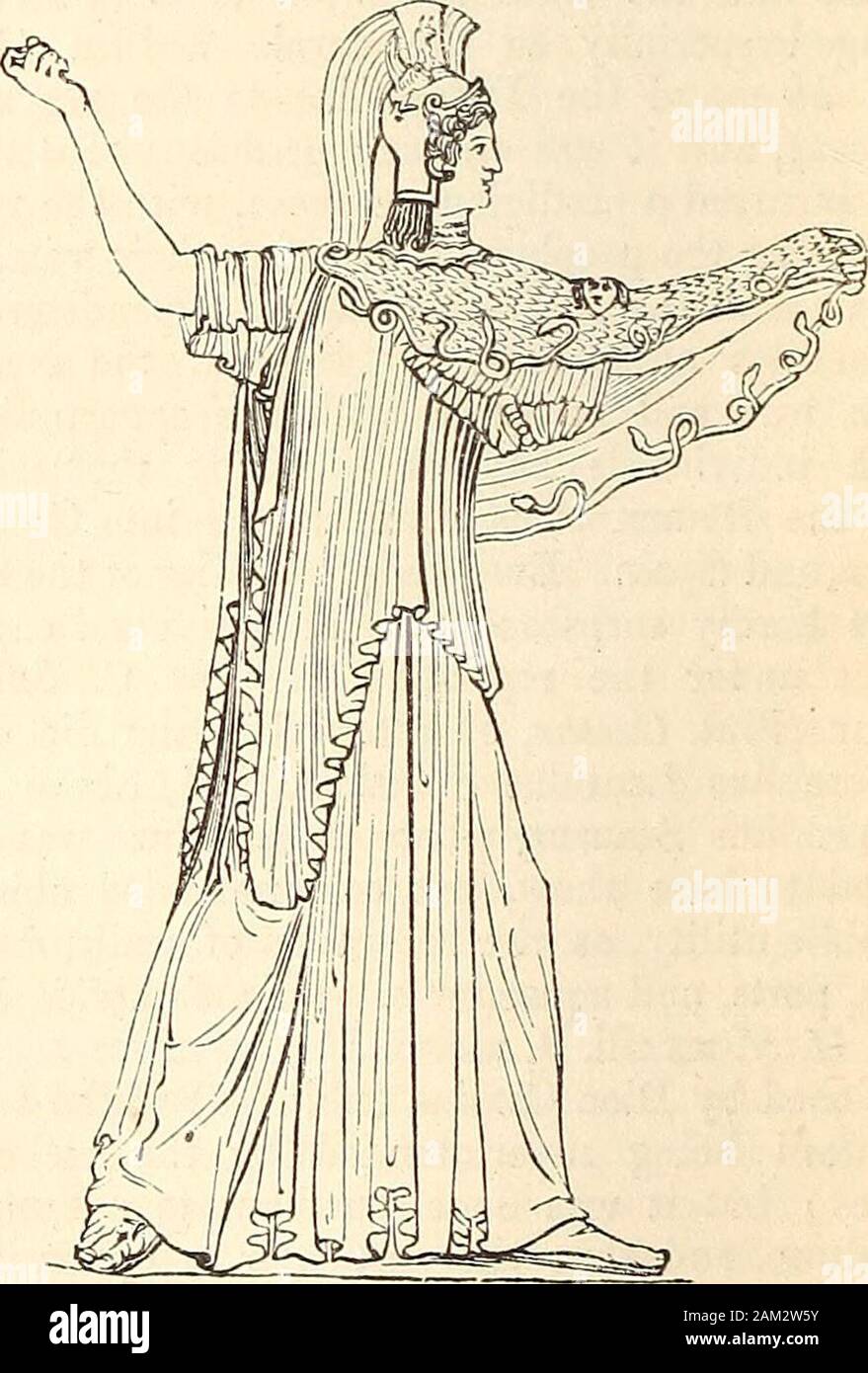 A dictionary of Greek and Roman antiquities.. . ccasions both by Apollo(II. xv. 229, 307—318, 360, xxiv. 20), and byAthena (II. ii. 447—449, xviii. 204, xxi. 400). The skins of various quadrupeds having beenused by the most ancient inhabitants of Greecefor clothing and defence, we cannot wonder thatthe goat-skin was employed in the same manner.It must also be borne in mind that the heavyshields of the ancient Greeks were in part sup-ported by a belt or strap (reXa/j-wv, balteus) passingover the right shoulder, and, when not elevatedwith the shield, descending transversely to the lefthip. In or Stock Photohttps://www.alamy.com/image-license-details/?v=1https://www.alamy.com/a-dictionary-of-greek-and-roman-antiquities-ccasions-both-by-apolloii-xv-229-307318-360-xxiv-20-and-byathena-ii-ii-447449-xviii-204-xxi-400-the-skins-of-various-quadrupeds-having-beenused-by-the-most-ancient-inhabitants-of-greecefor-clothing-and-defence-we-cannot-wonder-thatthe-goat-skin-was-employed-in-the-same-mannerit-must-also-be-borne-in-mind-that-the-heavyshields-of-the-ancient-greeks-were-in-part-sup-ported-by-a-belt-or-strap-rexaj-wv-balteus-passingover-the-right-shoulder-and-when-not-elevatedwith-the-shield-descending-transversely-to-the-lefthip-in-or-image339353783.html
A dictionary of Greek and Roman antiquities.. . ccasions both by Apollo(II. xv. 229, 307—318, 360, xxiv. 20), and byAthena (II. ii. 447—449, xviii. 204, xxi. 400). The skins of various quadrupeds having beenused by the most ancient inhabitants of Greecefor clothing and defence, we cannot wonder thatthe goat-skin was employed in the same manner.It must also be borne in mind that the heavyshields of the ancient Greeks were in part sup-ported by a belt or strap (reXa/j-wv, balteus) passingover the right shoulder, and, when not elevatedwith the shield, descending transversely to the lefthip. In or Stock Photohttps://www.alamy.com/image-license-details/?v=1https://www.alamy.com/a-dictionary-of-greek-and-roman-antiquities-ccasions-both-by-apolloii-xv-229-307318-360-xxiv-20-and-byathena-ii-ii-447449-xviii-204-xxi-400-the-skins-of-various-quadrupeds-having-beenused-by-the-most-ancient-inhabitants-of-greecefor-clothing-and-defence-we-cannot-wonder-thatthe-goat-skin-was-employed-in-the-same-mannerit-must-also-be-borne-in-mind-that-the-heavyshields-of-the-ancient-greeks-were-in-part-sup-ported-by-a-belt-or-strap-rexaj-wv-balteus-passingover-the-right-shoulder-and-when-not-elevatedwith-the-shield-descending-transversely-to-the-lefthip-in-or-image339353783.htmlRM2AM2W5Y–A dictionary of Greek and Roman antiquities.. . ccasions both by Apollo(II. xv. 229, 307—318, 360, xxiv. 20), and byAthena (II. ii. 447—449, xviii. 204, xxi. 400). The skins of various quadrupeds having beenused by the most ancient inhabitants of Greecefor clothing and defence, we cannot wonder thatthe goat-skin was employed in the same manner.It must also be borne in mind that the heavyshields of the ancient Greeks were in part sup-ported by a belt or strap (reXa/j-wv, balteus) passingover the right shoulder, and, when not elevatedwith the shield, descending transversely to the lefthip. In or
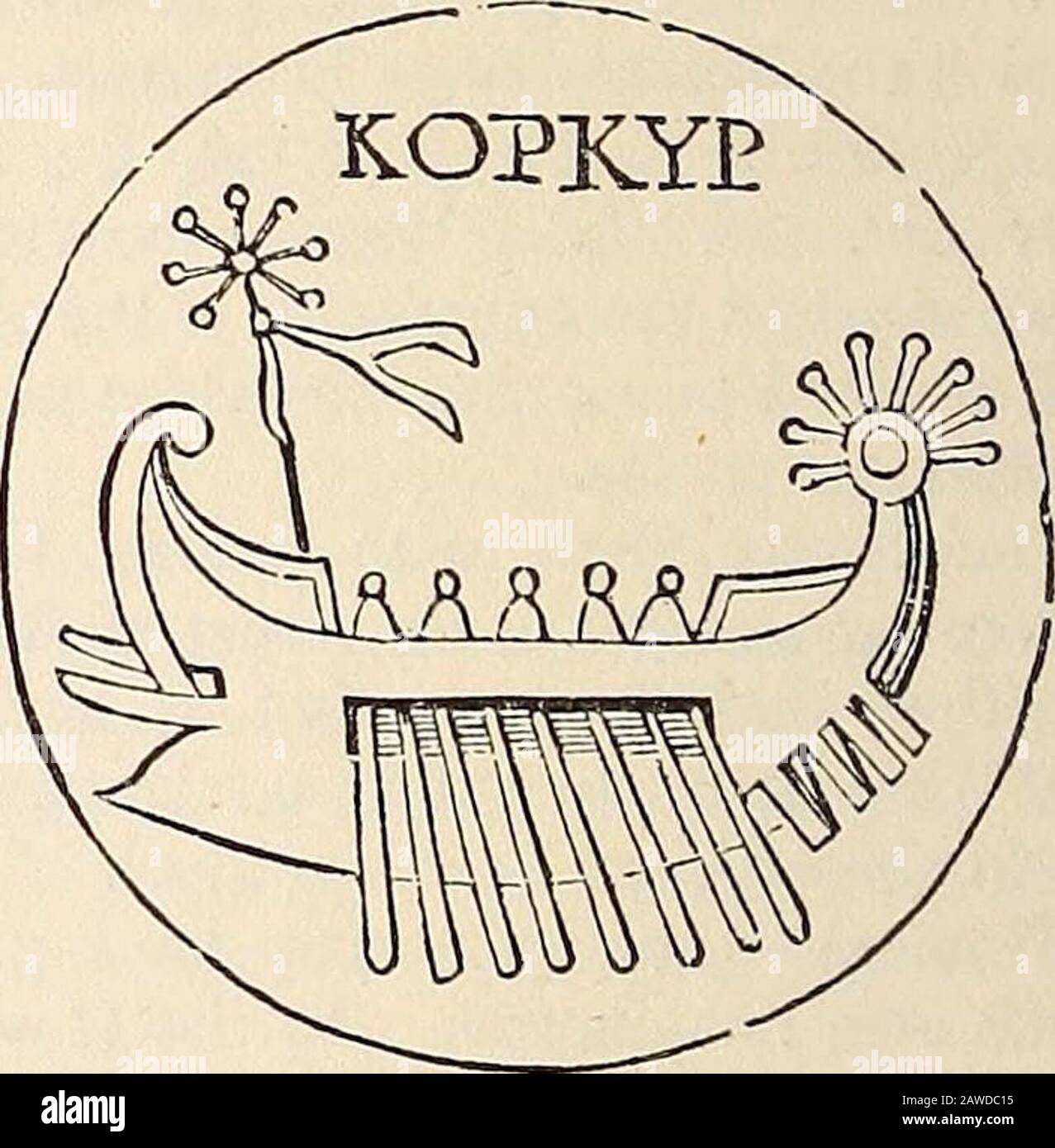 A dictionary of Greek and Roman antiquities.. . wing woodcut contains a beautiful frag-ment of a Bireme with a complete deck. (Winckel-mann, Monum. Antich. inedit. pi. 207.) Anotherspecimen of a small Bireme is given further on. The first Greek people whom we know to haveacquired a navy of importance were the Corinthians,Samians, and Phocaeans. About the time of Cyrusand Cambyses the Corinthian Triremes were gene-rally adopted by the Sicilian tyrants and by theCorcyraeans, who soon acquired the most powerfulnavies among the Greeks. In other parts of Greeceand even at Athens and in Aegina the m Stock Photohttps://www.alamy.com/image-license-details/?v=1https://www.alamy.com/a-dictionary-of-greek-and-roman-antiquities-wing-woodcut-contains-a-beautiful-frag-ment-of-a-bireme-with-a-complete-deck-winckel-mann-monum-antich-inedit-pi-207-anotherspecimen-of-a-small-bireme-is-given-further-on-the-first-greek-people-whom-we-know-to-haveacquired-a-navy-of-importance-were-the-corinthianssamians-and-phocaeans-about-the-time-of-cyrusand-cambyses-the-corinthian-triremes-were-gene-rally-adopted-by-the-sicilian-tyrants-and-by-thecorcyraeans-who-soon-acquired-the-most-powerfulnavies-among-the-greeks-in-other-parts-of-greeceand-even-at-athens-and-in-aegina-the-m-image342658209.html
A dictionary of Greek and Roman antiquities.. . wing woodcut contains a beautiful frag-ment of a Bireme with a complete deck. (Winckel-mann, Monum. Antich. inedit. pi. 207.) Anotherspecimen of a small Bireme is given further on. The first Greek people whom we know to haveacquired a navy of importance were the Corinthians,Samians, and Phocaeans. About the time of Cyrusand Cambyses the Corinthian Triremes were gene-rally adopted by the Sicilian tyrants and by theCorcyraeans, who soon acquired the most powerfulnavies among the Greeks. In other parts of Greeceand even at Athens and in Aegina the m Stock Photohttps://www.alamy.com/image-license-details/?v=1https://www.alamy.com/a-dictionary-of-greek-and-roman-antiquities-wing-woodcut-contains-a-beautiful-frag-ment-of-a-bireme-with-a-complete-deck-winckel-mann-monum-antich-inedit-pi-207-anotherspecimen-of-a-small-bireme-is-given-further-on-the-first-greek-people-whom-we-know-to-haveacquired-a-navy-of-importance-were-the-corinthianssamians-and-phocaeans-about-the-time-of-cyrusand-cambyses-the-corinthian-triremes-were-gene-rally-adopted-by-the-sicilian-tyrants-and-by-thecorcyraeans-who-soon-acquired-the-most-powerfulnavies-among-the-greeks-in-other-parts-of-greeceand-even-at-athens-and-in-aegina-the-m-image342658209.htmlRM2AWDC15–A dictionary of Greek and Roman antiquities.. . wing woodcut contains a beautiful frag-ment of a Bireme with a complete deck. (Winckel-mann, Monum. Antich. inedit. pi. 207.) Anotherspecimen of a small Bireme is given further on. The first Greek people whom we know to haveacquired a navy of importance were the Corinthians,Samians, and Phocaeans. About the time of Cyrusand Cambyses the Corinthian Triremes were gene-rally adopted by the Sicilian tyrants and by theCorcyraeans, who soon acquired the most powerfulnavies among the Greeks. In other parts of Greeceand even at Athens and in Aegina the m
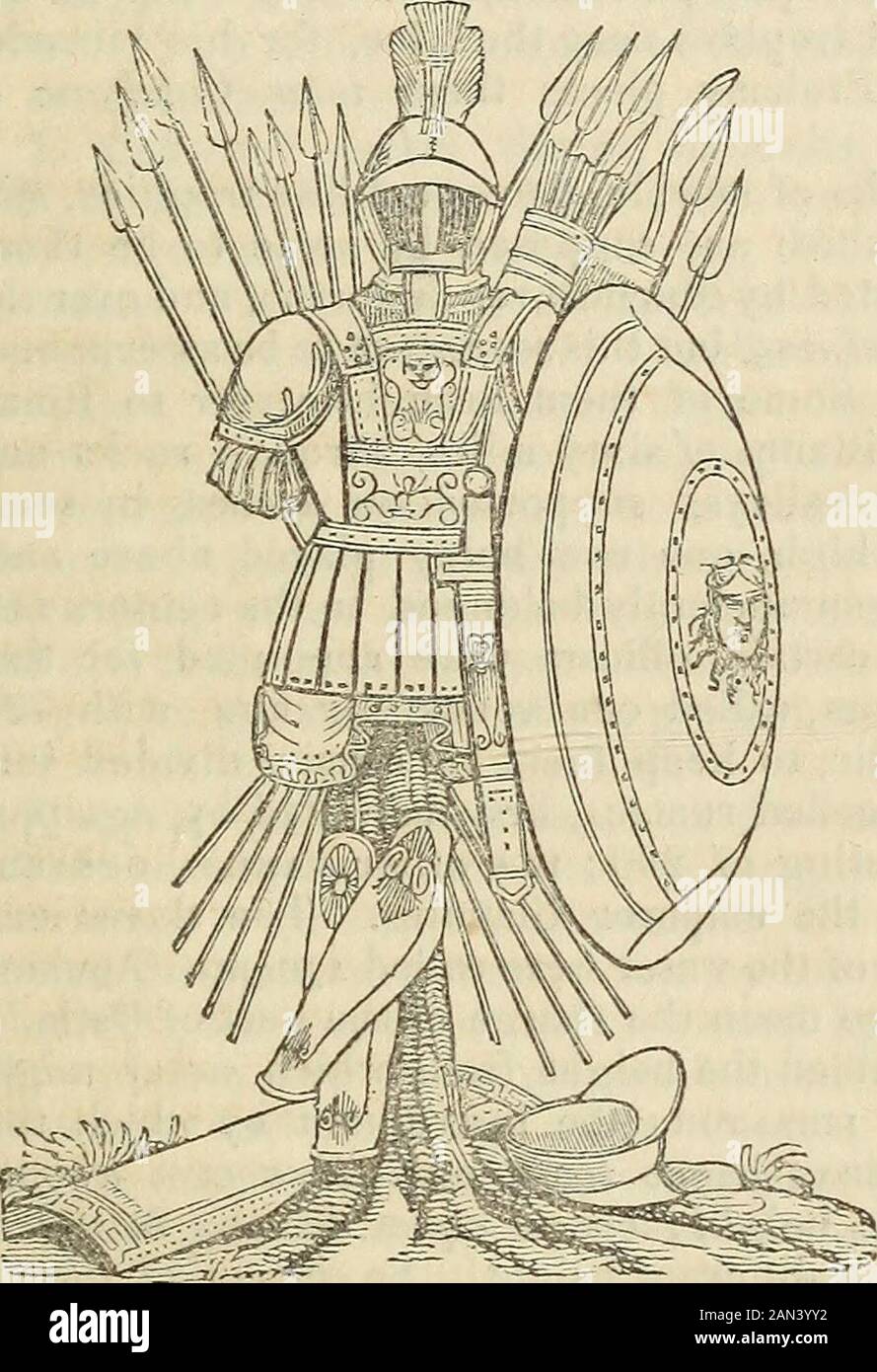 Roman antiquities: or, An account of the manners and customs of the Romans; . in triumph.This magnificence began under the first emperors; hence Pliny calls it NOVICIUM INVENTUM.^ VIII. Trop^a, tro-phies, Avere spoils ta-ken from the enemy,and fixed upon anything, as signs or mo-numents of victory ; ^erected ^ usually inthe place where it wasgained, and consecrat-ed to some divinity,with an inscription ; *used chiefly amongthe ancient Greeks,who, for a trophy,decorated the trunkof a tree with the armsand spoils of the van-quishedeneray. Thosewho erected metal orstone were held in de-testation Stock Photohttps://www.alamy.com/image-license-details/?v=1https://www.alamy.com/roman-antiquities-or-an-account-of-the-manners-and-customs-of-the-romans-in-triumphthis-magnificence-began-under-the-first-emperors-hence-pliny-calls-it-novicium-inventum-viii-tropa-tro-phies-avere-spoils-ta-ken-from-the-enemyand-fixed-upon-anything-as-signs-or-mo-numents-of-victory-erected-usually-inthe-place-where-it-wasgained-and-consecrat-ed-to-some-divinitywith-an-inscription-used-chiefly-amongthe-ancient-greekswho-for-a-trophydecorated-the-trunkof-a-tree-with-the-armsand-spoils-of-the-van-quishedeneray-thosewho-erected-metal-orstone-were-held-in-de-testation-image339992550.html
Roman antiquities: or, An account of the manners and customs of the Romans; . in triumph.This magnificence began under the first emperors; hence Pliny calls it NOVICIUM INVENTUM.^ VIII. Trop^a, tro-phies, Avere spoils ta-ken from the enemy,and fixed upon anything, as signs or mo-numents of victory ; ^erected ^ usually inthe place where it wasgained, and consecrat-ed to some divinity,with an inscription ; *used chiefly amongthe ancient Greeks,who, for a trophy,decorated the trunkof a tree with the armsand spoils of the van-quishedeneray. Thosewho erected metal orstone were held in de-testation Stock Photohttps://www.alamy.com/image-license-details/?v=1https://www.alamy.com/roman-antiquities-or-an-account-of-the-manners-and-customs-of-the-romans-in-triumphthis-magnificence-began-under-the-first-emperors-hence-pliny-calls-it-novicium-inventum-viii-tropa-tro-phies-avere-spoils-ta-ken-from-the-enemyand-fixed-upon-anything-as-signs-or-mo-numents-of-victory-erected-usually-inthe-place-where-it-wasgained-and-consecrat-ed-to-some-divinitywith-an-inscription-used-chiefly-amongthe-ancient-greekswho-for-a-trophydecorated-the-trunkof-a-tree-with-the-armsand-spoils-of-the-van-quishedeneray-thosewho-erected-metal-orstone-were-held-in-de-testation-image339992550.htmlRM2AN3YY2–Roman antiquities: or, An account of the manners and customs of the Romans; . in triumph.This magnificence began under the first emperors; hence Pliny calls it NOVICIUM INVENTUM.^ VIII. Trop^a, tro-phies, Avere spoils ta-ken from the enemy,and fixed upon anything, as signs or mo-numents of victory ; ^erected ^ usually inthe place where it wasgained, and consecrat-ed to some divinity,with an inscription ; *used chiefly amongthe ancient Greeks,who, for a trophy,decorated the trunkof a tree with the armsand spoils of the van-quishedeneray. Thosewho erected metal orstone were held in de-testation
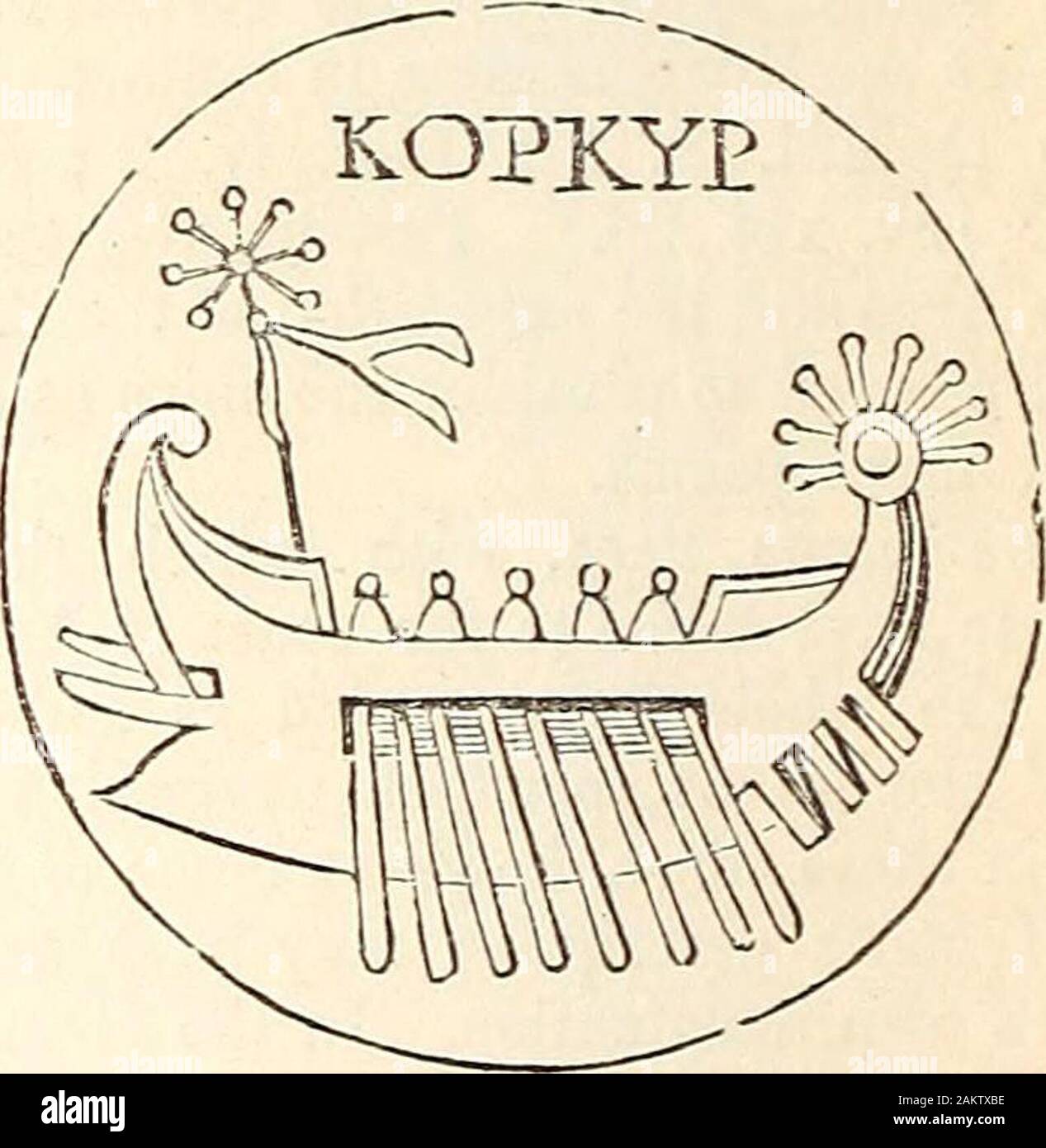 A dictionary of Greek and Roman antiquities.. . owing woodcut contains a beautiful frag-ment of a Bireme with a complete deck. (Winckel-mann, Monum. Antich. inedit. pi. 207.) Anotherspecimen of a small Bireme is given further on. The first Greek people whom we know to haveacquired a navy of importance were the Corinthians,Samians, and Phocaeans. About the time of Cyrusand Cambyses the Corinthian Triremes were gene-rally adopted by the Sicilian tyrants and by theCorcyraeans, who soon acquired the most powerfulnavies among the Greeks. In other parts of Greeceand even at Athens and in Aegina the Stock Photohttps://www.alamy.com/image-license-details/?v=1https://www.alamy.com/a-dictionary-of-greek-and-roman-antiquities-owing-woodcut-contains-a-beautiful-frag-ment-of-a-bireme-with-a-complete-deck-winckel-mann-monum-antich-inedit-pi-207-anotherspecimen-of-a-small-bireme-is-given-further-on-the-first-greek-people-whom-we-know-to-haveacquired-a-navy-of-importance-were-the-corinthianssamians-and-phocaeans-about-the-time-of-cyrusand-cambyses-the-corinthian-triremes-were-gene-rally-adopted-by-the-sicilian-tyrants-and-by-thecorcyraeans-who-soon-acquired-the-most-powerfulnavies-among-the-greeks-in-other-parts-of-greeceand-even-at-athens-and-in-aegina-the-image339223010.html
A dictionary of Greek and Roman antiquities.. . owing woodcut contains a beautiful frag-ment of a Bireme with a complete deck. (Winckel-mann, Monum. Antich. inedit. pi. 207.) Anotherspecimen of a small Bireme is given further on. The first Greek people whom we know to haveacquired a navy of importance were the Corinthians,Samians, and Phocaeans. About the time of Cyrusand Cambyses the Corinthian Triremes were gene-rally adopted by the Sicilian tyrants and by theCorcyraeans, who soon acquired the most powerfulnavies among the Greeks. In other parts of Greeceand even at Athens and in Aegina the Stock Photohttps://www.alamy.com/image-license-details/?v=1https://www.alamy.com/a-dictionary-of-greek-and-roman-antiquities-owing-woodcut-contains-a-beautiful-frag-ment-of-a-bireme-with-a-complete-deck-winckel-mann-monum-antich-inedit-pi-207-anotherspecimen-of-a-small-bireme-is-given-further-on-the-first-greek-people-whom-we-know-to-haveacquired-a-navy-of-importance-were-the-corinthianssamians-and-phocaeans-about-the-time-of-cyrusand-cambyses-the-corinthian-triremes-were-gene-rally-adopted-by-the-sicilian-tyrants-and-by-thecorcyraeans-who-soon-acquired-the-most-powerfulnavies-among-the-greeks-in-other-parts-of-greeceand-even-at-athens-and-in-aegina-the-image339223010.htmlRM2AKTXBE–A dictionary of Greek and Roman antiquities.. . owing woodcut contains a beautiful frag-ment of a Bireme with a complete deck. (Winckel-mann, Monum. Antich. inedit. pi. 207.) Anotherspecimen of a small Bireme is given further on. The first Greek people whom we know to haveacquired a navy of importance were the Corinthians,Samians, and Phocaeans. About the time of Cyrusand Cambyses the Corinthian Triremes were gene-rally adopted by the Sicilian tyrants and by theCorcyraeans, who soon acquired the most powerfulnavies among the Greeks. In other parts of Greeceand even at Athens and in Aegina the
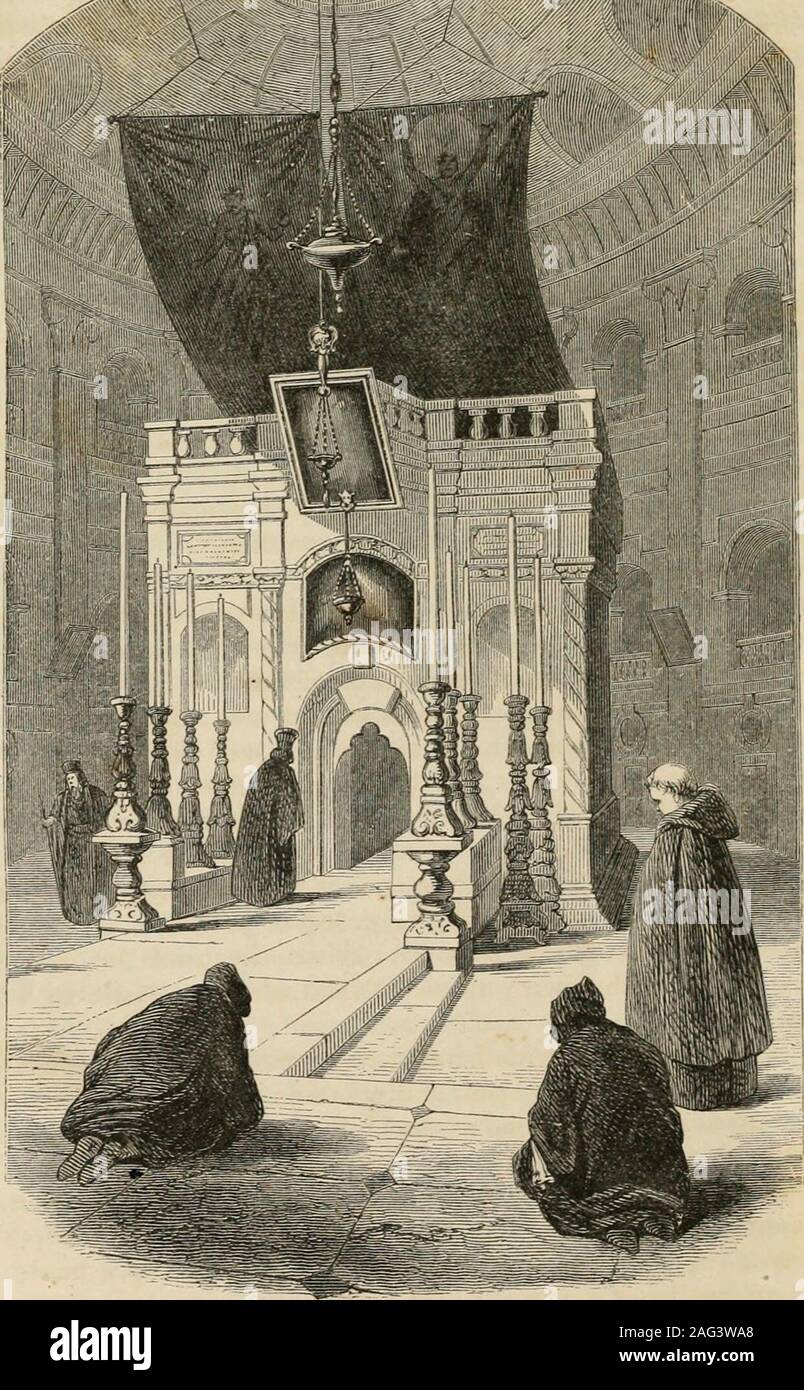 . 'From Dan to Beersheba'; or, The Land of promise as it now appears : including a description of the boundaries, topography, agriculture, antiquities, cities, and present inhabitants of that wonderful land .... 300 feet in lengtheast and west, and of a transept extending north and south180 feet. The ceiling is eighty feet high. Excepting the ro-tunda, the nave contains the magnificent chapel of the Greeks,measuring ninety-eight feet in length and forty in width, Avhichis a church within a church. The walls are of wood, carvedand gilded, reaching to the lofty ceiling above. The entranceis in t Stock Photohttps://www.alamy.com/image-license-details/?v=1https://www.alamy.com/from-dan-to-beersheba-or-the-land-of-promise-as-it-now-appears-including-a-description-of-the-boundaries-topography-agriculture-antiquities-cities-and-present-inhabitants-of-that-wonderful-land-300-feet-in-lengtheast-and-west-and-of-a-transept-extending-north-and-south180-feet-the-ceiling-is-eighty-feet-high-excepting-the-ro-tunda-the-nave-contains-the-magnificent-chapel-of-the-greeksmeasuring-ninety-eight-feet-in-length-and-forty-in-width-avhichis-a-church-within-a-church-the-walls-are-of-wood-carvedand-gilded-reaching-to-the-lofty-ceiling-above-the-entranceis-in-t-image336917232.html
. 'From Dan to Beersheba'; or, The Land of promise as it now appears : including a description of the boundaries, topography, agriculture, antiquities, cities, and present inhabitants of that wonderful land .... 300 feet in lengtheast and west, and of a transept extending north and south180 feet. The ceiling is eighty feet high. Excepting the ro-tunda, the nave contains the magnificent chapel of the Greeks,measuring ninety-eight feet in length and forty in width, Avhichis a church within a church. The walls are of wood, carvedand gilded, reaching to the lofty ceiling above. The entranceis in t Stock Photohttps://www.alamy.com/image-license-details/?v=1https://www.alamy.com/from-dan-to-beersheba-or-the-land-of-promise-as-it-now-appears-including-a-description-of-the-boundaries-topography-agriculture-antiquities-cities-and-present-inhabitants-of-that-wonderful-land-300-feet-in-lengtheast-and-west-and-of-a-transept-extending-north-and-south180-feet-the-ceiling-is-eighty-feet-high-excepting-the-ro-tunda-the-nave-contains-the-magnificent-chapel-of-the-greeksmeasuring-ninety-eight-feet-in-length-and-forty-in-width-avhichis-a-church-within-a-church-the-walls-are-of-wood-carvedand-gilded-reaching-to-the-lofty-ceiling-above-the-entranceis-in-t-image336917232.htmlRM2AG3WA8–. 'From Dan to Beersheba'; or, The Land of promise as it now appears : including a description of the boundaries, topography, agriculture, antiquities, cities, and present inhabitants of that wonderful land .... 300 feet in lengtheast and west, and of a transept extending north and south180 feet. The ceiling is eighty feet high. Excepting the ro-tunda, the nave contains the magnificent chapel of the Greeks,measuring ninety-eight feet in length and forty in width, Avhichis a church within a church. The walls are of wood, carvedand gilded, reaching to the lofty ceiling above. The entranceis in t
 A dictionary of Greek and Roman antiquities.. . ccasions both by Apollo(II. xv. 229, 307—318, 360, xxiv. 20), and byAthena (II. ii. 447—449, xviii. 204, xxi. 400). The skins of various quadrupeds having beenused by the most ancient inhabitants of Greecefor clothing and defence, we cannot wonder thatthe goat-skin was employed in the same manner.It must also be borne in mind that the heavyshields of the ancient Greeks were in part sup-ported by a belt or strap (reXa/xcov, balteus) passingover the right shoulder, and, when not elevatedwith the shield, descending transversely to the lefthip. In or Stock Photohttps://www.alamy.com/image-license-details/?v=1https://www.alamy.com/a-dictionary-of-greek-and-roman-antiquities-ccasions-both-by-apolloii-xv-229-307318-360-xxiv-20-and-byathena-ii-ii-447449-xviii-204-xxi-400-the-skins-of-various-quadrupeds-having-beenused-by-the-most-ancient-inhabitants-of-greecefor-clothing-and-defence-we-cannot-wonder-thatthe-goat-skin-was-employed-in-the-same-mannerit-must-also-be-borne-in-mind-that-the-heavyshields-of-the-ancient-greeks-were-in-part-sup-ported-by-a-belt-or-strap-rexaxcov-balteus-passingover-the-right-shoulder-and-when-not-elevatedwith-the-shield-descending-transversely-to-the-lefthip-in-or-image342763759.html
A dictionary of Greek and Roman antiquities.. . ccasions both by Apollo(II. xv. 229, 307—318, 360, xxiv. 20), and byAthena (II. ii. 447—449, xviii. 204, xxi. 400). The skins of various quadrupeds having beenused by the most ancient inhabitants of Greecefor clothing and defence, we cannot wonder thatthe goat-skin was employed in the same manner.It must also be borne in mind that the heavyshields of the ancient Greeks were in part sup-ported by a belt or strap (reXa/xcov, balteus) passingover the right shoulder, and, when not elevatedwith the shield, descending transversely to the lefthip. In or Stock Photohttps://www.alamy.com/image-license-details/?v=1https://www.alamy.com/a-dictionary-of-greek-and-roman-antiquities-ccasions-both-by-apolloii-xv-229-307318-360-xxiv-20-and-byathena-ii-ii-447449-xviii-204-xxi-400-the-skins-of-various-quadrupeds-having-beenused-by-the-most-ancient-inhabitants-of-greecefor-clothing-and-defence-we-cannot-wonder-thatthe-goat-skin-was-employed-in-the-same-mannerit-must-also-be-borne-in-mind-that-the-heavyshields-of-the-ancient-greeks-were-in-part-sup-ported-by-a-belt-or-strap-rexaxcov-balteus-passingover-the-right-shoulder-and-when-not-elevatedwith-the-shield-descending-transversely-to-the-lefthip-in-or-image342763759.htmlRM2AWJ6JR–A dictionary of Greek and Roman antiquities.. . ccasions both by Apollo(II. xv. 229, 307—318, 360, xxiv. 20), and byAthena (II. ii. 447—449, xviii. 204, xxi. 400). The skins of various quadrupeds having beenused by the most ancient inhabitants of Greecefor clothing and defence, we cannot wonder thatthe goat-skin was employed in the same manner.It must also be borne in mind that the heavyshields of the ancient Greeks were in part sup-ported by a belt or strap (reXa/xcov, balteus) passingover the right shoulder, and, when not elevatedwith the shield, descending transversely to the lefthip. In or
![A dictionary of Greek and Roman antiquities.. . ay remark, that the comparativelyunimportant and antiquated duties of the Ephetaesufficiently explain the statement in Pollux (I. c),that their court gradually lost all respect, and be-came at last an object of ridicule. [R. W.] EPHIPPIUM (a<TTpd§Ti, i<pnnrioi,i(pLinreioi),a saddle. Although the Greeks occasionally rodewithout any saddle (ewl /iov Ittttov, Xenoph. DeRe Eques. vii. 5), yet they commonly used one,and from them the name, together with the thing,was borrowed by the Romans. (Varr. De Re Rust.ii. 7; Caes. B. G. iv. 2; Hor. Epi Stock Photo A dictionary of Greek and Roman antiquities.. . ay remark, that the comparativelyunimportant and antiquated duties of the Ephetaesufficiently explain the statement in Pollux (I. c),that their court gradually lost all respect, and be-came at last an object of ridicule. [R. W.] EPHIPPIUM (a<TTpd§Ti, i<pnnrioi,i(pLinreioi),a saddle. Although the Greeks occasionally rodewithout any saddle (ewl /iov Ittttov, Xenoph. DeRe Eques. vii. 5), yet they commonly used one,and from them the name, together with the thing,was borrowed by the Romans. (Varr. De Re Rust.ii. 7; Caes. B. G. iv. 2; Hor. Epi Stock Photo](https://c8.alamy.com/comp/2AKY4M6/a-dictionary-of-greek-and-roman-antiquities-ay-remark-that-the-comparativelyunimportant-and-antiquated-duties-of-the-ephetaesufficiently-explain-the-statement-in-pollux-i-cthat-their-court-gradually-lost-all-respect-and-be-came-at-last-an-object-of-ridicule-r-w-ephippium-altttpdti-iltpnnrioiiplinreioia-saddle-although-the-greeks-occasionally-rodewithout-any-saddle-ewl-iov-ittttov-xenoph-dere-eques-vii-5-yet-they-commonly-used-oneand-from-them-the-name-together-with-the-thingwas-borrowed-by-the-romans-varr-de-re-rustii-7-caes-b-g-iv-2-hor-epi-2AKY4M6.jpg) A dictionary of Greek and Roman antiquities.. . ay remark, that the comparativelyunimportant and antiquated duties of the Ephetaesufficiently explain the statement in Pollux (I. c),that their court gradually lost all respect, and be-came at last an object of ridicule. [R. W.] EPHIPPIUM (a<TTpd§Ti, i<pnnrioi,i(pLinreioi),a saddle. Although the Greeks occasionally rodewithout any saddle (ewl /iov Ittttov, Xenoph. DeRe Eques. vii. 5), yet they commonly used one,and from them the name, together with the thing,was borrowed by the Romans. (Varr. De Re Rust.ii. 7; Caes. B. G. iv. 2; Hor. Epi Stock Photohttps://www.alamy.com/image-license-details/?v=1https://www.alamy.com/a-dictionary-of-greek-and-roman-antiquities-ay-remark-that-the-comparativelyunimportant-and-antiquated-duties-of-the-ephetaesufficiently-explain-the-statement-in-pollux-i-cthat-their-court-gradually-lost-all-respect-and-be-came-at-last-an-object-of-ridicule-r-w-ephippium-altttpdti-iltpnnrioiiplinreioia-saddle-although-the-greeks-occasionally-rodewithout-any-saddle-ewl-iov-ittttov-xenoph-dere-eques-vii-5-yet-they-commonly-used-oneand-from-them-the-name-together-with-the-thingwas-borrowed-by-the-romans-varr-de-re-rustii-7-caes-b-g-iv-2-hor-epi-image339271862.html
A dictionary of Greek and Roman antiquities.. . ay remark, that the comparativelyunimportant and antiquated duties of the Ephetaesufficiently explain the statement in Pollux (I. c),that their court gradually lost all respect, and be-came at last an object of ridicule. [R. W.] EPHIPPIUM (a<TTpd§Ti, i<pnnrioi,i(pLinreioi),a saddle. Although the Greeks occasionally rodewithout any saddle (ewl /iov Ittttov, Xenoph. DeRe Eques. vii. 5), yet they commonly used one,and from them the name, together with the thing,was borrowed by the Romans. (Varr. De Re Rust.ii. 7; Caes. B. G. iv. 2; Hor. Epi Stock Photohttps://www.alamy.com/image-license-details/?v=1https://www.alamy.com/a-dictionary-of-greek-and-roman-antiquities-ay-remark-that-the-comparativelyunimportant-and-antiquated-duties-of-the-ephetaesufficiently-explain-the-statement-in-pollux-i-cthat-their-court-gradually-lost-all-respect-and-be-came-at-last-an-object-of-ridicule-r-w-ephippium-altttpdti-iltpnnrioiiplinreioia-saddle-although-the-greeks-occasionally-rodewithout-any-saddle-ewl-iov-ittttov-xenoph-dere-eques-vii-5-yet-they-commonly-used-oneand-from-them-the-name-together-with-the-thingwas-borrowed-by-the-romans-varr-de-re-rustii-7-caes-b-g-iv-2-hor-epi-image339271862.htmlRM2AKY4M6–A dictionary of Greek and Roman antiquities.. . ay remark, that the comparativelyunimportant and antiquated duties of the Ephetaesufficiently explain the statement in Pollux (I. c),that their court gradually lost all respect, and be-came at last an object of ridicule. [R. W.] EPHIPPIUM (a<TTpd§Ti, i<pnnrioi,i(pLinreioi),a saddle. Although the Greeks occasionally rodewithout any saddle (ewl /iov Ittttov, Xenoph. DeRe Eques. vii. 5), yet they commonly used one,and from them the name, together with the thing,was borrowed by the Romans. (Varr. De Re Rust.ii. 7; Caes. B. G. iv. 2; Hor. Epi
![A dictionary of Greek and Roman antiquities.. . p/xos), a necklace. Necklaces wereworn by both sexes among the most polished ofthose nations which the Greeks called barbarous,especially the Indians, the Egyptians, and the Per-sians. [Armilla.] Greek and Roman femalesadopted them more particularly as a bridal orna-ment. (Lucan, ii. 361 ; Claud, de vi. cons. Honor.527.) The simplest kind of necklace was the monilebaccatum, or bead necklace (Virg. Aen. i. 657 ;Lamprid. Al. Sev. 41), which consisted of berries,small spheres of glass, amethyst, &c, strung to-gether. This is very commonly shown in a Stock Photo A dictionary of Greek and Roman antiquities.. . p/xos), a necklace. Necklaces wereworn by both sexes among the most polished ofthose nations which the Greeks called barbarous,especially the Indians, the Egyptians, and the Per-sians. [Armilla.] Greek and Roman femalesadopted them more particularly as a bridal orna-ment. (Lucan, ii. 361 ; Claud, de vi. cons. Honor.527.) The simplest kind of necklace was the monilebaccatum, or bead necklace (Virg. Aen. i. 657 ;Lamprid. Al. Sev. 41), which consisted of berries,small spheres of glass, amethyst, &c, strung to-gether. This is very commonly shown in a Stock Photo](https://c8.alamy.com/comp/2AKW11K/a-dictionary-of-greek-and-roman-antiquities-pxos-a-necklace-necklaces-wereworn-by-both-sexes-among-the-most-polished-ofthose-nations-which-the-greeks-called-barbarousespecially-the-indians-the-egyptians-and-the-per-sians-armilla-greek-and-roman-femalesadopted-them-more-particularly-as-a-bridal-orna-ment-lucan-ii-361-claud-de-vi-cons-honor527-the-simplest-kind-of-necklace-was-the-monilebaccatum-or-bead-necklace-virg-aen-i-657-lamprid-al-sev-41-which-consisted-of-berriessmall-spheres-of-glass-amethyst-c-strung-to-gether-this-is-very-commonly-shown-in-a-2AKW11K.jpg) A dictionary of Greek and Roman antiquities.. . p/xos), a necklace. Necklaces wereworn by both sexes among the most polished ofthose nations which the Greeks called barbarous,especially the Indians, the Egyptians, and the Per-sians. [Armilla.] Greek and Roman femalesadopted them more particularly as a bridal orna-ment. (Lucan, ii. 361 ; Claud, de vi. cons. Honor.527.) The simplest kind of necklace was the monilebaccatum, or bead necklace (Virg. Aen. i. 657 ;Lamprid. Al. Sev. 41), which consisted of berries,small spheres of glass, amethyst, &c, strung to-gether. This is very commonly shown in a Stock Photohttps://www.alamy.com/image-license-details/?v=1https://www.alamy.com/a-dictionary-of-greek-and-roman-antiquities-pxos-a-necklace-necklaces-wereworn-by-both-sexes-among-the-most-polished-ofthose-nations-which-the-greeks-called-barbarousespecially-the-indians-the-egyptians-and-the-per-sians-armilla-greek-and-roman-femalesadopted-them-more-particularly-as-a-bridal-orna-ment-lucan-ii-361-claud-de-vi-cons-honor527-the-simplest-kind-of-necklace-was-the-monilebaccatum-or-bead-necklace-virg-aen-i-657-lamprid-al-sev-41-which-consisted-of-berriessmall-spheres-of-glass-amethyst-c-strung-to-gether-this-is-very-commonly-shown-in-a-image339225087.html
A dictionary of Greek and Roman antiquities.. . p/xos), a necklace. Necklaces wereworn by both sexes among the most polished ofthose nations which the Greeks called barbarous,especially the Indians, the Egyptians, and the Per-sians. [Armilla.] Greek and Roman femalesadopted them more particularly as a bridal orna-ment. (Lucan, ii. 361 ; Claud, de vi. cons. Honor.527.) The simplest kind of necklace was the monilebaccatum, or bead necklace (Virg. Aen. i. 657 ;Lamprid. Al. Sev. 41), which consisted of berries,small spheres of glass, amethyst, &c, strung to-gether. This is very commonly shown in a Stock Photohttps://www.alamy.com/image-license-details/?v=1https://www.alamy.com/a-dictionary-of-greek-and-roman-antiquities-pxos-a-necklace-necklaces-wereworn-by-both-sexes-among-the-most-polished-ofthose-nations-which-the-greeks-called-barbarousespecially-the-indians-the-egyptians-and-the-per-sians-armilla-greek-and-roman-femalesadopted-them-more-particularly-as-a-bridal-orna-ment-lucan-ii-361-claud-de-vi-cons-honor527-the-simplest-kind-of-necklace-was-the-monilebaccatum-or-bead-necklace-virg-aen-i-657-lamprid-al-sev-41-which-consisted-of-berriessmall-spheres-of-glass-amethyst-c-strung-to-gether-this-is-very-commonly-shown-in-a-image339225087.htmlRM2AKW11K–A dictionary of Greek and Roman antiquities.. . p/xos), a necklace. Necklaces wereworn by both sexes among the most polished ofthose nations which the Greeks called barbarous,especially the Indians, the Egyptians, and the Per-sians. [Armilla.] Greek and Roman femalesadopted them more particularly as a bridal orna-ment. (Lucan, ii. 361 ; Claud, de vi. cons. Honor.527.) The simplest kind of necklace was the monilebaccatum, or bead necklace (Virg. Aen. i. 657 ;Lamprid. Al. Sev. 41), which consisted of berries,small spheres of glass, amethyst, &c, strung to-gether. This is very commonly shown in a
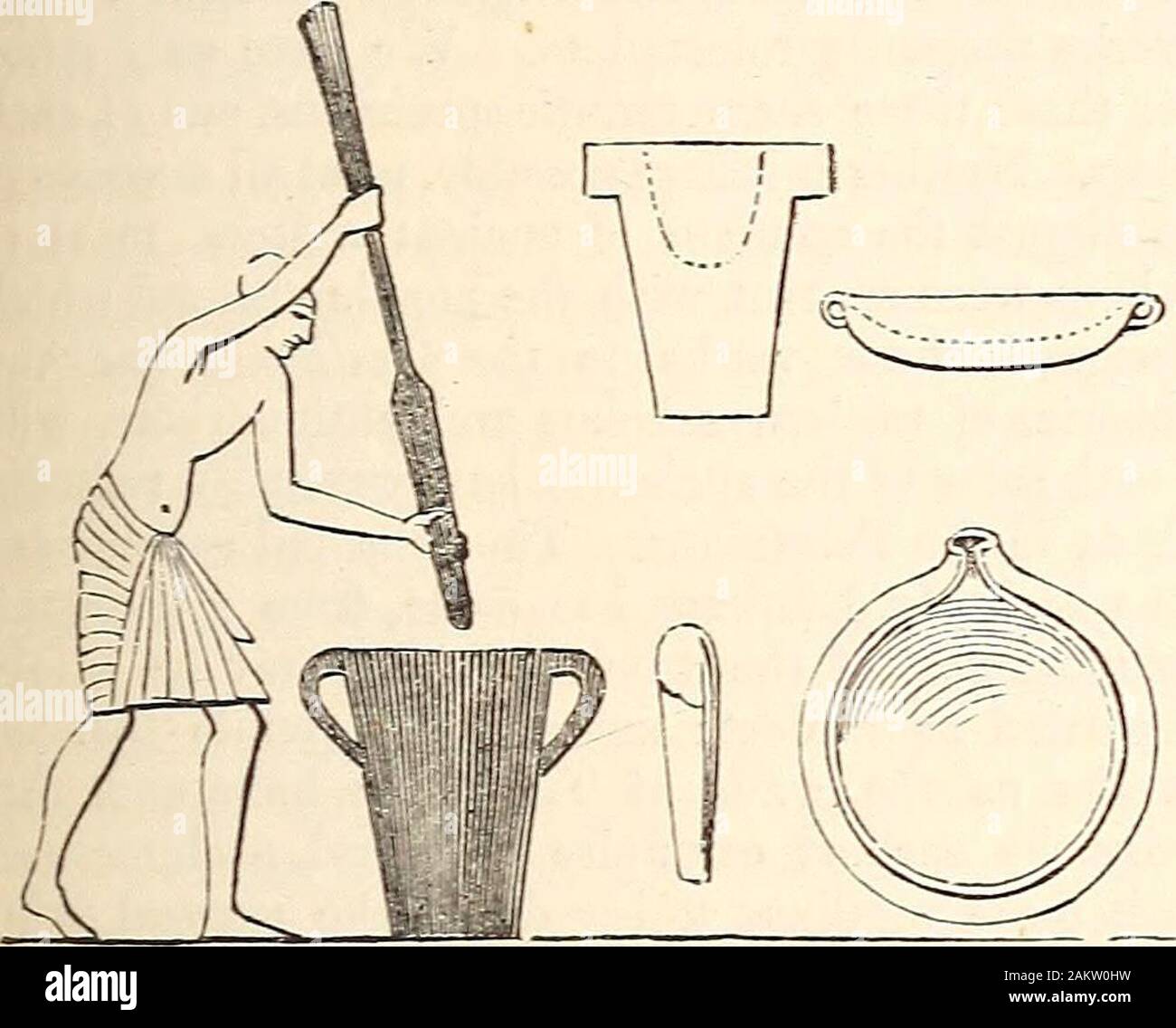 A dictionary of Greek and Roman antiquities.. . re evidently to be madefrom straight portions of the trunks or branches oftrees, and the thicker and shorter of them was tobe hollowed. They might then be used in the MUXYCHIA. MURUS. 769 manner represented in a painting on the tomb ofRemeses III. at Thebes (see woodcut, left-handfigure taken from Wilkinson, vol. ii. p. 383) ; forthere is no reason to doubt that the Egyptians andthe Greeks fashioned and used their mortars in thesame manner. (See also Wilkinson, vol. iii. p.181, showing three stone mortars with metal pes-tles.) In these paintings Stock Photohttps://www.alamy.com/image-license-details/?v=1https://www.alamy.com/a-dictionary-of-greek-and-roman-antiquities-re-evidently-to-be-madefrom-straight-portions-of-the-trunks-or-branches-oftrees-and-the-thicker-and-shorter-of-them-was-tobe-hollowed-they-might-then-be-used-in-the-muxychia-murus-769-manner-represented-in-a-painting-on-the-tomb-ofremeses-iii-at-thebes-see-woodcut-left-handfigure-taken-from-wilkinson-vol-ii-p-383-forthere-is-no-reason-to-doubt-that-the-egyptians-andthe-greeks-fashioned-and-used-their-mortars-in-thesame-manner-see-also-wilkinson-vol-iii-p181-showing-three-stone-mortars-with-metal-pes-tles-in-these-paintings-image339224757.html
A dictionary of Greek and Roman antiquities.. . re evidently to be madefrom straight portions of the trunks or branches oftrees, and the thicker and shorter of them was tobe hollowed. They might then be used in the MUXYCHIA. MURUS. 769 manner represented in a painting on the tomb ofRemeses III. at Thebes (see woodcut, left-handfigure taken from Wilkinson, vol. ii. p. 383) ; forthere is no reason to doubt that the Egyptians andthe Greeks fashioned and used their mortars in thesame manner. (See also Wilkinson, vol. iii. p.181, showing three stone mortars with metal pes-tles.) In these paintings Stock Photohttps://www.alamy.com/image-license-details/?v=1https://www.alamy.com/a-dictionary-of-greek-and-roman-antiquities-re-evidently-to-be-madefrom-straight-portions-of-the-trunks-or-branches-oftrees-and-the-thicker-and-shorter-of-them-was-tobe-hollowed-they-might-then-be-used-in-the-muxychia-murus-769-manner-represented-in-a-painting-on-the-tomb-ofremeses-iii-at-thebes-see-woodcut-left-handfigure-taken-from-wilkinson-vol-ii-p-383-forthere-is-no-reason-to-doubt-that-the-egyptians-andthe-greeks-fashioned-and-used-their-mortars-in-thesame-manner-see-also-wilkinson-vol-iii-p181-showing-three-stone-mortars-with-metal-pes-tles-in-these-paintings-image339224757.htmlRM2AKW0HW–A dictionary of Greek and Roman antiquities.. . re evidently to be madefrom straight portions of the trunks or branches oftrees, and the thicker and shorter of them was tobe hollowed. They might then be used in the MUXYCHIA. MURUS. 769 manner represented in a painting on the tomb ofRemeses III. at Thebes (see woodcut, left-handfigure taken from Wilkinson, vol. ii. p. 383) ; forthere is no reason to doubt that the Egyptians andthe Greeks fashioned and used their mortars in thesame manner. (See also Wilkinson, vol. iii. p.181, showing three stone mortars with metal pes-tles.) In these paintings
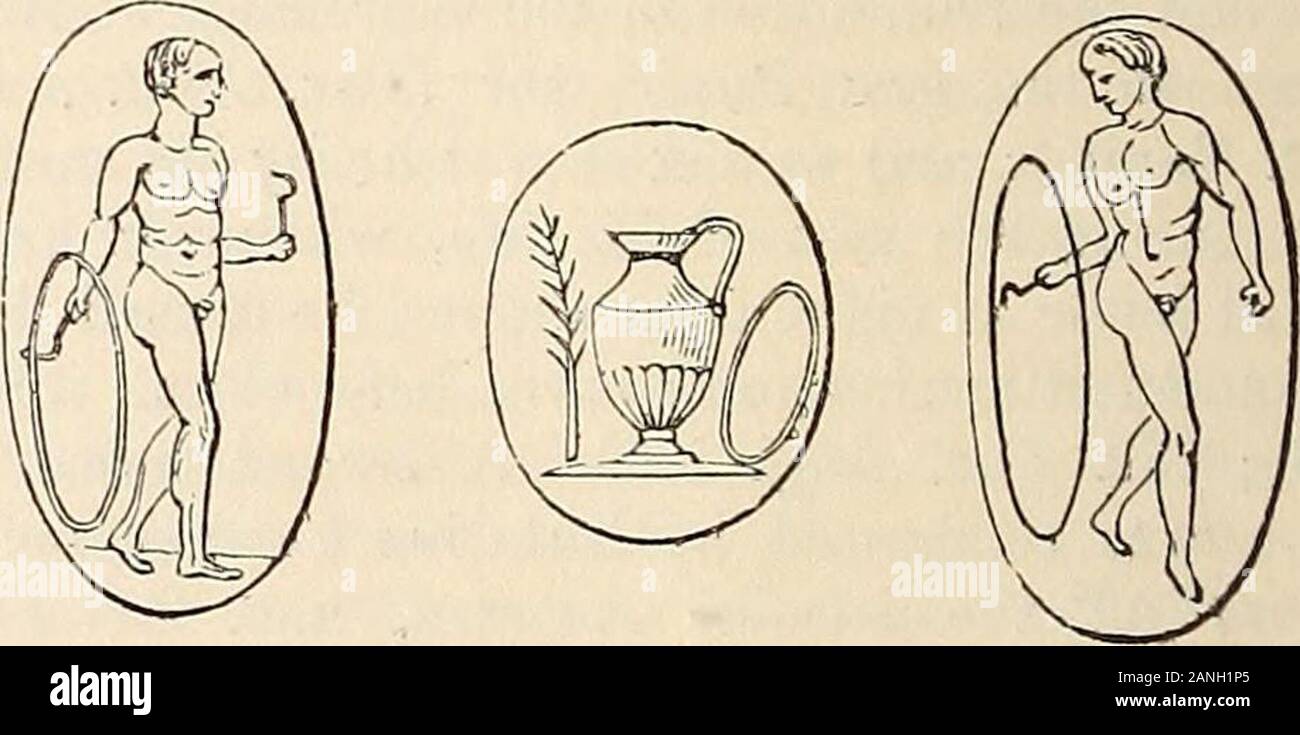 A dictionary of Greek and Roman antiquities.. . oop. The Greekboys used to exercise themselves like ours withtrundling a hoop. It was a bronze ring, and hadsometimes bells attached to it. (Mart. xi. 22. 2,xiv. 168, 169.) It was impelled by means of ahook with a wooden handle, called clavis (Propertiii. 12), and iAar-qp. From the Greeks thiscustom passed to the Romans, who consequentlyadopted the Greek term. (Hor. Carm. iii. 24. 57.)The hoop was used at the Gymnasium (Propert.I. c. ; Ovid. Trist. ii. 485) ; and, therefore, on oneof the gems in the Stosch collection at Berlin,which is engraved i Stock Photohttps://www.alamy.com/image-license-details/?v=1https://www.alamy.com/a-dictionary-of-greek-and-roman-antiquities-oop-the-greekboys-used-to-exercise-themselves-like-ours-withtrundling-a-hoop-it-was-a-bronze-ring-and-hadsometimes-bells-attached-to-it-mart-xi-22-2xiv-168-169-it-was-impelled-by-means-of-ahook-with-a-wooden-handle-called-clavis-propertiii-12-and-iaar-qp-from-the-greeks-thiscustom-passed-to-the-romans-who-consequentlyadopted-the-greek-term-hor-carm-iii-24-57the-hoop-was-used-at-the-gymnasium-properti-c-ovid-trist-ii-485-and-therefore-on-oneof-the-gems-in-the-stosch-collection-at-berlinwhich-is-engraved-i-image340279357.html
A dictionary of Greek and Roman antiquities.. . oop. The Greekboys used to exercise themselves like ours withtrundling a hoop. It was a bronze ring, and hadsometimes bells attached to it. (Mart. xi. 22. 2,xiv. 168, 169.) It was impelled by means of ahook with a wooden handle, called clavis (Propertiii. 12), and iAar-qp. From the Greeks thiscustom passed to the Romans, who consequentlyadopted the Greek term. (Hor. Carm. iii. 24. 57.)The hoop was used at the Gymnasium (Propert.I. c. ; Ovid. Trist. ii. 485) ; and, therefore, on oneof the gems in the Stosch collection at Berlin,which is engraved i Stock Photohttps://www.alamy.com/image-license-details/?v=1https://www.alamy.com/a-dictionary-of-greek-and-roman-antiquities-oop-the-greekboys-used-to-exercise-themselves-like-ours-withtrundling-a-hoop-it-was-a-bronze-ring-and-hadsometimes-bells-attached-to-it-mart-xi-22-2xiv-168-169-it-was-impelled-by-means-of-ahook-with-a-wooden-handle-called-clavis-propertiii-12-and-iaar-qp-from-the-greeks-thiscustom-passed-to-the-romans-who-consequentlyadopted-the-greek-term-hor-carm-iii-24-57the-hoop-was-used-at-the-gymnasium-properti-c-ovid-trist-ii-485-and-therefore-on-oneof-the-gems-in-the-stosch-collection-at-berlinwhich-is-engraved-i-image340279357.htmlRM2ANH1P5–A dictionary of Greek and Roman antiquities.. . oop. The Greekboys used to exercise themselves like ours withtrundling a hoop. It was a bronze ring, and hadsometimes bells attached to it. (Mart. xi. 22. 2,xiv. 168, 169.) It was impelled by means of ahook with a wooden handle, called clavis (Propertiii. 12), and iAar-qp. From the Greeks thiscustom passed to the Romans, who consequentlyadopted the Greek term. (Hor. Carm. iii. 24. 57.)The hoop was used at the Gymnasium (Propert.I. c. ; Ovid. Trist. ii. 485) ; and, therefore, on oneof the gems in the Stosch collection at Berlin,which is engraved i
![A dictionary of Greek and Roman antiquities.. . spoken of as a place of execution in the followingpassages:—In robore et tenebris exspirare (Liv.xxxviii. 59 ; Sallust, I. c). Robur et saocum (sc.Tarpeium) minitari (Tacit. Ann. iv. 29). So alsowe read of the catenas — et Italum robur. (Hor.Carm. ii. 13. 18.) [R. W.] CARCERES. [Circus.] CARCHESIUM (Kapxfaiov). 1. A beakeror drinking-cup, which was used by the Greeks invery early times, so that one is said to have beengiven by Jupiter to Alcmena on the night of hisvisit to her. (Pherecydes, p. 97—100, ed. Sturtz.)It was slightly contracted in the Stock Photo A dictionary of Greek and Roman antiquities.. . spoken of as a place of execution in the followingpassages:—In robore et tenebris exspirare (Liv.xxxviii. 59 ; Sallust, I. c). Robur et saocum (sc.Tarpeium) minitari (Tacit. Ann. iv. 29). So alsowe read of the catenas — et Italum robur. (Hor.Carm. ii. 13. 18.) [R. W.] CARCERES. [Circus.] CARCHESIUM (Kapxfaiov). 1. A beakeror drinking-cup, which was used by the Greeks invery early times, so that one is said to have beengiven by Jupiter to Alcmena on the night of hisvisit to her. (Pherecydes, p. 97—100, ed. Sturtz.)It was slightly contracted in the Stock Photo](https://c8.alamy.com/comp/2AM10TW/a-dictionary-of-greek-and-roman-antiquities-spoken-of-as-a-place-of-execution-in-the-followingpassagesin-robore-et-tenebris-exspirare-livxxxviii-59-sallust-i-c-robur-et-saocum-sctarpeium-minitari-tacit-ann-iv-29-so-alsowe-read-of-the-catenas-et-italum-robur-horcarm-ii-13-18-r-w-carceres-circus-carchesium-kapxfaiov-1-a-beakeror-drinking-cup-which-was-used-by-the-greeks-invery-early-times-so-that-one-is-said-to-have-beengiven-by-jupiter-to-alcmena-on-the-night-of-hisvisit-to-her-pherecydes-p-97100-ed-sturtzit-was-slightly-contracted-in-the-2AM10TW.jpg) A dictionary of Greek and Roman antiquities.. . spoken of as a place of execution in the followingpassages:—In robore et tenebris exspirare (Liv.xxxviii. 59 ; Sallust, I. c). Robur et saocum (sc.Tarpeium) minitari (Tacit. Ann. iv. 29). So alsowe read of the catenas — et Italum robur. (Hor.Carm. ii. 13. 18.) [R. W.] CARCERES. [Circus.] CARCHESIUM (Kapxfaiov). 1. A beakeror drinking-cup, which was used by the Greeks invery early times, so that one is said to have beengiven by Jupiter to Alcmena on the night of hisvisit to her. (Pherecydes, p. 97—100, ed. Sturtz.)It was slightly contracted in the Stock Photohttps://www.alamy.com/image-license-details/?v=1https://www.alamy.com/a-dictionary-of-greek-and-roman-antiquities-spoken-of-as-a-place-of-execution-in-the-followingpassagesin-robore-et-tenebris-exspirare-livxxxviii-59-sallust-i-c-robur-et-saocum-sctarpeium-minitari-tacit-ann-iv-29-so-alsowe-read-of-the-catenas-et-italum-robur-horcarm-ii-13-18-r-w-carceres-circus-carchesium-kapxfaiov-1-a-beakeror-drinking-cup-which-was-used-by-the-greeks-invery-early-times-so-that-one-is-said-to-have-beengiven-by-jupiter-to-alcmena-on-the-night-of-hisvisit-to-her-pherecydes-p-97100-ed-sturtzit-was-slightly-contracted-in-the-image339312761.html
A dictionary of Greek and Roman antiquities.. . spoken of as a place of execution in the followingpassages:—In robore et tenebris exspirare (Liv.xxxviii. 59 ; Sallust, I. c). Robur et saocum (sc.Tarpeium) minitari (Tacit. Ann. iv. 29). So alsowe read of the catenas — et Italum robur. (Hor.Carm. ii. 13. 18.) [R. W.] CARCERES. [Circus.] CARCHESIUM (Kapxfaiov). 1. A beakeror drinking-cup, which was used by the Greeks invery early times, so that one is said to have beengiven by Jupiter to Alcmena on the night of hisvisit to her. (Pherecydes, p. 97—100, ed. Sturtz.)It was slightly contracted in the Stock Photohttps://www.alamy.com/image-license-details/?v=1https://www.alamy.com/a-dictionary-of-greek-and-roman-antiquities-spoken-of-as-a-place-of-execution-in-the-followingpassagesin-robore-et-tenebris-exspirare-livxxxviii-59-sallust-i-c-robur-et-saocum-sctarpeium-minitari-tacit-ann-iv-29-so-alsowe-read-of-the-catenas-et-italum-robur-horcarm-ii-13-18-r-w-carceres-circus-carchesium-kapxfaiov-1-a-beakeror-drinking-cup-which-was-used-by-the-greeks-invery-early-times-so-that-one-is-said-to-have-beengiven-by-jupiter-to-alcmena-on-the-night-of-hisvisit-to-her-pherecydes-p-97100-ed-sturtzit-was-slightly-contracted-in-the-image339312761.htmlRM2AM10TW–A dictionary of Greek and Roman antiquities.. . spoken of as a place of execution in the followingpassages:—In robore et tenebris exspirare (Liv.xxxviii. 59 ; Sallust, I. c). Robur et saocum (sc.Tarpeium) minitari (Tacit. Ann. iv. 29). So alsowe read of the catenas — et Italum robur. (Hor.Carm. ii. 13. 18.) [R. W.] CARCERES. [Circus.] CARCHESIUM (Kapxfaiov). 1. A beakeror drinking-cup, which was used by the Greeks invery early times, so that one is said to have beengiven by Jupiter to Alcmena on the night of hisvisit to her. (Pherecydes, p. 97—100, ed. Sturtz.)It was slightly contracted in the
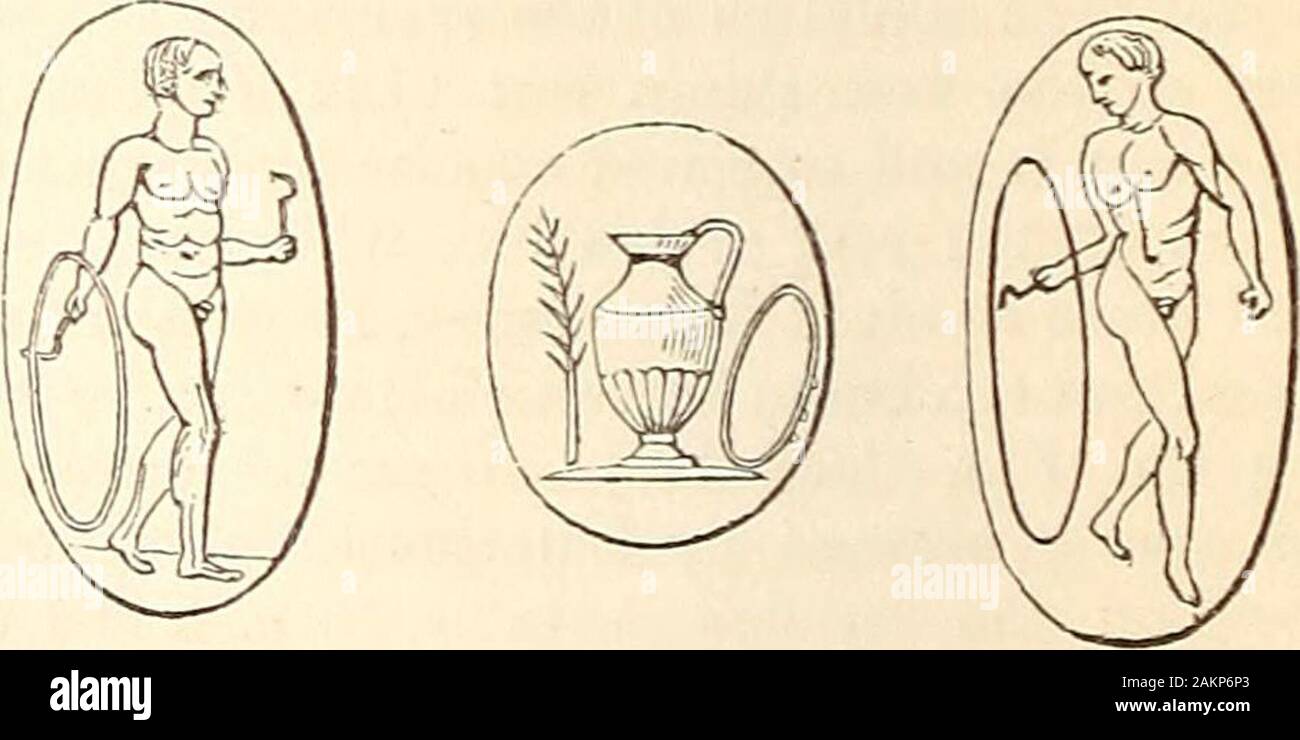 A dictionary of Greek and Roman antiquities.. . hoop. The Greekboys used to exercise themselves like ours withtrundling a hoop. It was a bronze ring, and hadsometimes bells attached to it. (Mart. xi. 22. 2,xiv. 168, 169.) It was impelled by means of ahook with a wooden handle, called clavis (Propertiii. 12), and 4arrip. From the Greeks thiscustom passed to the Romans, who consequentlyadopted the Greek term. (Hor. Carm. iii. 24. 57.)The hoop was used at the Gymnasium (Propert.I. c. ; Ovid. Trist. ii. 485) ; and, therefore, on oneof the gems in the Stosch collection at Berlin,which is engraved Stock Photohttps://www.alamy.com/image-license-details/?v=1https://www.alamy.com/a-dictionary-of-greek-and-roman-antiquities-hoop-the-greekboys-used-to-exercise-themselves-like-ours-withtrundling-a-hoop-it-was-a-bronze-ring-and-hadsometimes-bells-attached-to-it-mart-xi-22-2xiv-168-169-it-was-impelled-by-means-of-ahook-with-a-wooden-handle-called-clavis-propertiii-12-and-4arrip-from-the-greeks-thiscustom-passed-to-the-romans-who-consequentlyadopted-the-greek-term-hor-carm-iii-24-57the-hoop-was-used-at-the-gymnasium-properti-c-ovid-trist-ii-485-and-therefore-on-oneof-the-gems-in-the-stosch-collection-at-berlinwhich-is-engraved-image339163723.html
A dictionary of Greek and Roman antiquities.. . hoop. The Greekboys used to exercise themselves like ours withtrundling a hoop. It was a bronze ring, and hadsometimes bells attached to it. (Mart. xi. 22. 2,xiv. 168, 169.) It was impelled by means of ahook with a wooden handle, called clavis (Propertiii. 12), and 4arrip. From the Greeks thiscustom passed to the Romans, who consequentlyadopted the Greek term. (Hor. Carm. iii. 24. 57.)The hoop was used at the Gymnasium (Propert.I. c. ; Ovid. Trist. ii. 485) ; and, therefore, on oneof the gems in the Stosch collection at Berlin,which is engraved Stock Photohttps://www.alamy.com/image-license-details/?v=1https://www.alamy.com/a-dictionary-of-greek-and-roman-antiquities-hoop-the-greekboys-used-to-exercise-themselves-like-ours-withtrundling-a-hoop-it-was-a-bronze-ring-and-hadsometimes-bells-attached-to-it-mart-xi-22-2xiv-168-169-it-was-impelled-by-means-of-ahook-with-a-wooden-handle-called-clavis-propertiii-12-and-4arrip-from-the-greeks-thiscustom-passed-to-the-romans-who-consequentlyadopted-the-greek-term-hor-carm-iii-24-57the-hoop-was-used-at-the-gymnasium-properti-c-ovid-trist-ii-485-and-therefore-on-oneof-the-gems-in-the-stosch-collection-at-berlinwhich-is-engraved-image339163723.htmlRM2AKP6P3–A dictionary of Greek and Roman antiquities.. . hoop. The Greekboys used to exercise themselves like ours withtrundling a hoop. It was a bronze ring, and hadsometimes bells attached to it. (Mart. xi. 22. 2,xiv. 168, 169.) It was impelled by means of ahook with a wooden handle, called clavis (Propertiii. 12), and 4arrip. From the Greeks thiscustom passed to the Romans, who consequentlyadopted the Greek term. (Hor. Carm. iii. 24. 57.)The hoop was used at the Gymnasium (Propert.I. c. ; Ovid. Trist. ii. 485) ; and, therefore, on oneof the gems in the Stosch collection at Berlin,which is engraved
 A dictionary of Greek and Roman antiquities.. . ed that nothing should be sold inthem but different kinds of cooked pulse or vege-tables (Suet. Ner. 16 ; Dion Cass. lxii. 14) ; andan edict to the same effect was also published byVespasian. (Dion Cass. lxvi. 10.) Persons who kept inns or houses of public enter-tainment of any kind, were held in low estimationboth among the Greeks and Romans (Theophr.Char. 6 ; Plat. Leg. xi. pp. 918, 919) ; and thoughthe epithets of perfidi and maligni, which Horacegives to them (Sat. i. 1. 29, i. 5. 4), may referonly to particular innkeepers, yet they seem to e Stock Photohttps://www.alamy.com/image-license-details/?v=1https://www.alamy.com/a-dictionary-of-greek-and-roman-antiquities-ed-that-nothing-should-be-sold-inthem-but-different-kinds-of-cooked-pulse-or-vege-tables-suet-ner-16-dion-cass-lxii-14-andan-edict-to-the-same-effect-was-also-published-byvespasian-dion-cass-lxvi-10-persons-who-kept-inns-or-houses-of-public-enter-tainment-of-any-kind-were-held-in-low-estimationboth-among-the-greeks-and-romans-theophrchar-6-plat-leg-xi-pp-918-919-and-thoughthe-epithets-of-perfidi-and-maligni-which-horacegives-to-them-sat-i-1-29-i-5-4-may-referonly-to-particular-innkeepers-yet-they-seem-to-e-image339310500.html
A dictionary of Greek and Roman antiquities.. . ed that nothing should be sold inthem but different kinds of cooked pulse or vege-tables (Suet. Ner. 16 ; Dion Cass. lxii. 14) ; andan edict to the same effect was also published byVespasian. (Dion Cass. lxvi. 10.) Persons who kept inns or houses of public enter-tainment of any kind, were held in low estimationboth among the Greeks and Romans (Theophr.Char. 6 ; Plat. Leg. xi. pp. 918, 919) ; and thoughthe epithets of perfidi and maligni, which Horacegives to them (Sat. i. 1. 29, i. 5. 4), may referonly to particular innkeepers, yet they seem to e Stock Photohttps://www.alamy.com/image-license-details/?v=1https://www.alamy.com/a-dictionary-of-greek-and-roman-antiquities-ed-that-nothing-should-be-sold-inthem-but-different-kinds-of-cooked-pulse-or-vege-tables-suet-ner-16-dion-cass-lxii-14-andan-edict-to-the-same-effect-was-also-published-byvespasian-dion-cass-lxvi-10-persons-who-kept-inns-or-houses-of-public-enter-tainment-of-any-kind-were-held-in-low-estimationboth-among-the-greeks-and-romans-theophrchar-6-plat-leg-xi-pp-918-919-and-thoughthe-epithets-of-perfidi-and-maligni-which-horacegives-to-them-sat-i-1-29-i-5-4-may-referonly-to-particular-innkeepers-yet-they-seem-to-e-image339310500.htmlRM2AM0X04–A dictionary of Greek and Roman antiquities.. . ed that nothing should be sold inthem but different kinds of cooked pulse or vege-tables (Suet. Ner. 16 ; Dion Cass. lxii. 14) ; andan edict to the same effect was also published byVespasian. (Dion Cass. lxvi. 10.) Persons who kept inns or houses of public enter-tainment of any kind, were held in low estimationboth among the Greeks and Romans (Theophr.Char. 6 ; Plat. Leg. xi. pp. 918, 919) ; and thoughthe epithets of perfidi and maligni, which Horacegives to them (Sat. i. 1. 29, i. 5. 4), may referonly to particular innkeepers, yet they seem to e
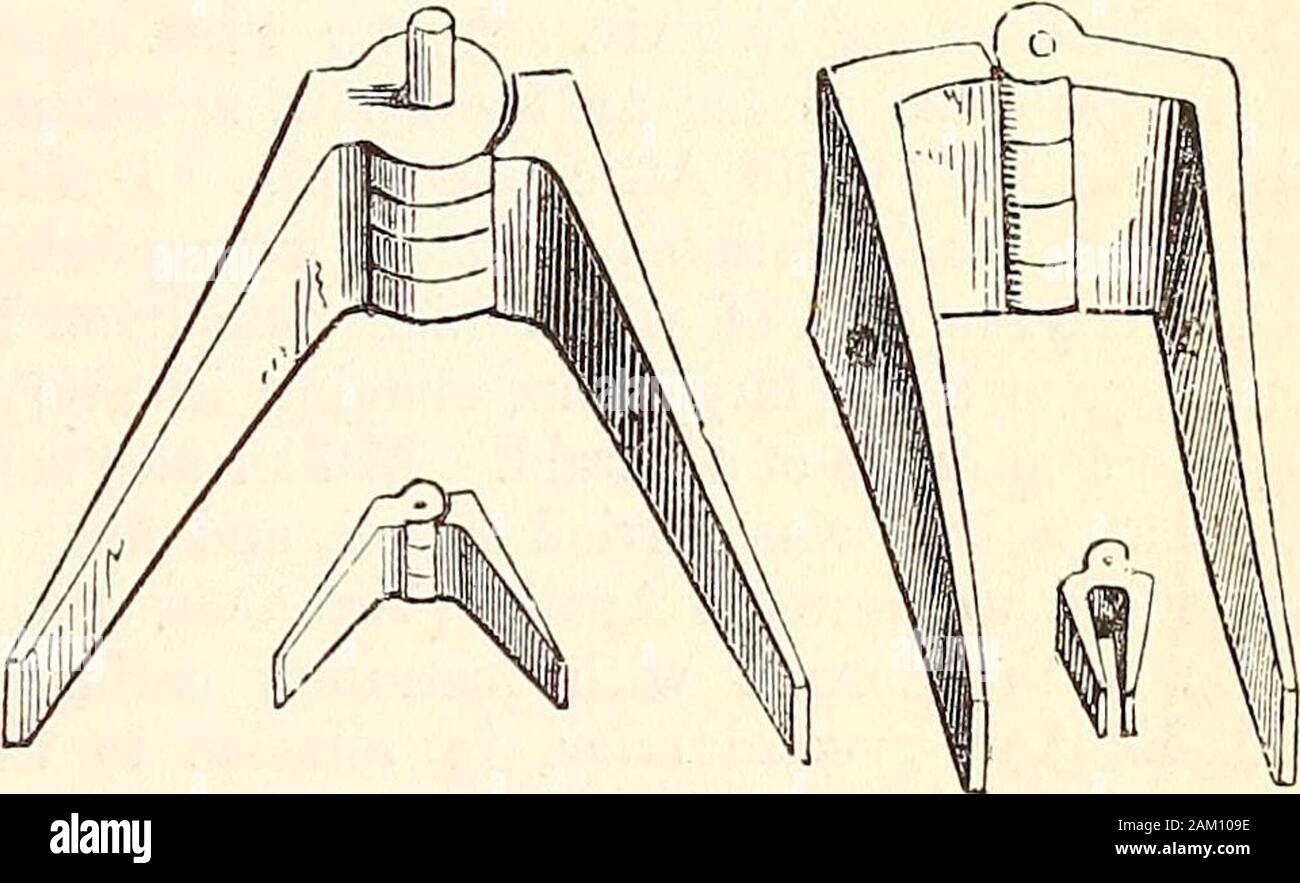 A dictionary of Greek and Roman antiquities.. . stridens in limine cardo, Virg. Cms, 222; Eurip.Plioen. 114—116, Schol. ad foe). The Greeks and Romans also used hinges ex-actly like those now in common use. Four Romanhinges of bronze, preserved in the British Museum,are here shown.. The form of the door above delineated makes itmanifest why the principal line laid down in sur-veying land was called cardo (Festus, s. v. De-cumanus ; Isid. Orig. xv. 14) ; and it further ex-plains the application of the same term to theNorth Pole, the supposed pivot on which theheavens revolved. (Varr. De Re Rust Stock Photohttps://www.alamy.com/image-license-details/?v=1https://www.alamy.com/a-dictionary-of-greek-and-roman-antiquities-stridens-in-limine-cardo-virg-cms-222-euripplioen-114116-schol-ad-foe-the-greeks-and-romans-also-used-hinges-ex-actly-like-those-now-in-common-use-four-romanhinges-of-bronze-preserved-in-the-british-museumare-here-shown-the-form-of-the-door-above-delineated-makes-itmanifest-why-the-principal-line-laid-down-in-sur-veying-land-was-called-cardo-festus-s-v-de-cumanus-isid-orig-xv-14-and-it-further-ex-plains-the-application-of-the-same-term-to-thenorth-pole-the-supposed-pivot-on-which-theheavens-revolved-varr-de-re-rust-image339312330.html
A dictionary of Greek and Roman antiquities.. . stridens in limine cardo, Virg. Cms, 222; Eurip.Plioen. 114—116, Schol. ad foe). The Greeks and Romans also used hinges ex-actly like those now in common use. Four Romanhinges of bronze, preserved in the British Museum,are here shown.. The form of the door above delineated makes itmanifest why the principal line laid down in sur-veying land was called cardo (Festus, s. v. De-cumanus ; Isid. Orig. xv. 14) ; and it further ex-plains the application of the same term to theNorth Pole, the supposed pivot on which theheavens revolved. (Varr. De Re Rust Stock Photohttps://www.alamy.com/image-license-details/?v=1https://www.alamy.com/a-dictionary-of-greek-and-roman-antiquities-stridens-in-limine-cardo-virg-cms-222-euripplioen-114116-schol-ad-foe-the-greeks-and-romans-also-used-hinges-ex-actly-like-those-now-in-common-use-four-romanhinges-of-bronze-preserved-in-the-british-museumare-here-shown-the-form-of-the-door-above-delineated-makes-itmanifest-why-the-principal-line-laid-down-in-sur-veying-land-was-called-cardo-festus-s-v-de-cumanus-isid-orig-xv-14-and-it-further-ex-plains-the-application-of-the-same-term-to-thenorth-pole-the-supposed-pivot-on-which-theheavens-revolved-varr-de-re-rust-image339312330.htmlRM2AM109E–A dictionary of Greek and Roman antiquities.. . stridens in limine cardo, Virg. Cms, 222; Eurip.Plioen. 114—116, Schol. ad foe). The Greeks and Romans also used hinges ex-actly like those now in common use. Four Romanhinges of bronze, preserved in the British Museum,are here shown.. The form of the door above delineated makes itmanifest why the principal line laid down in sur-veying land was called cardo (Festus, s. v. De-cumanus ; Isid. Orig. xv. 14) ; and it further ex-plains the application of the same term to theNorth Pole, the supposed pivot on which theheavens revolved. (Varr. De Re Rust
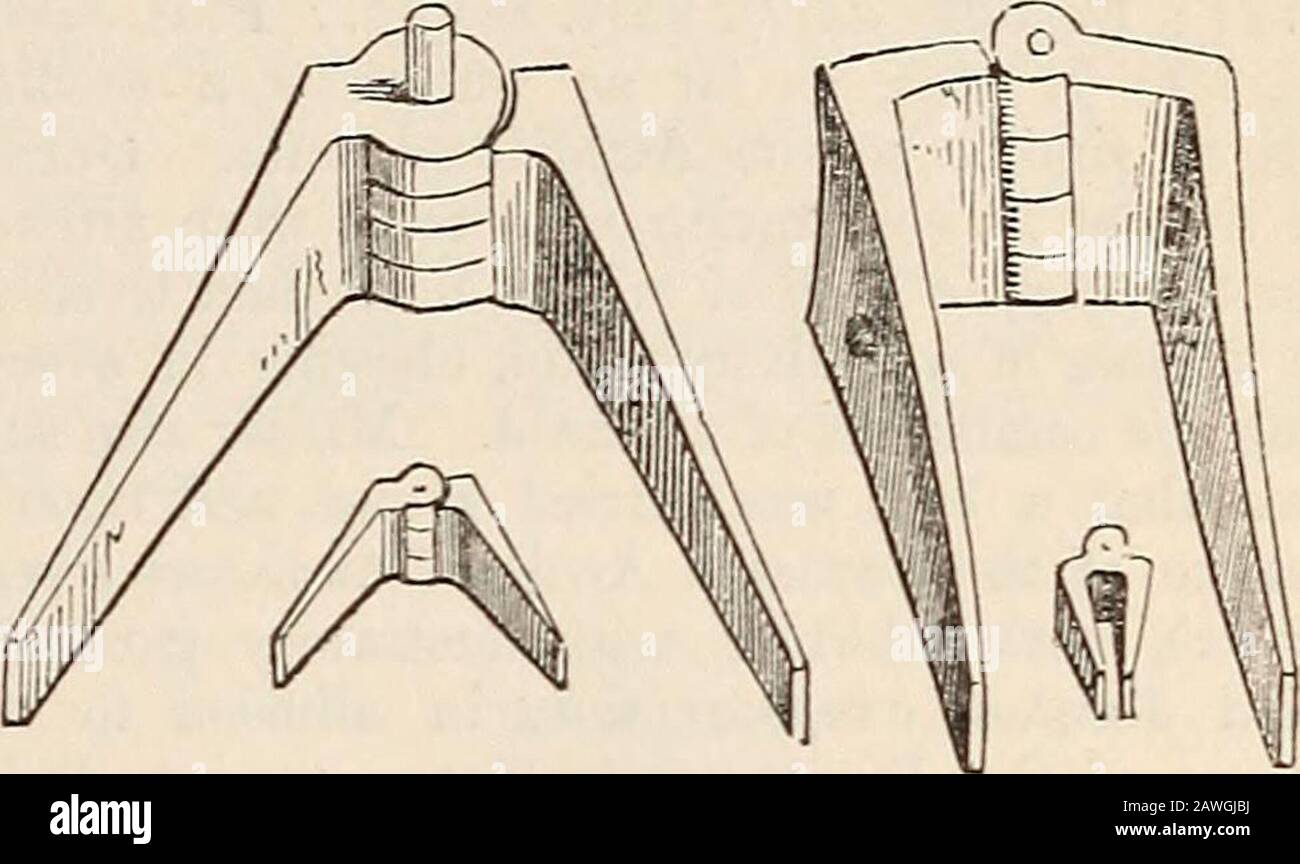 A dictionary of Greek and Roman antiquities.. . stridens i?i limine cardo, Virg. Ciris, 222; Eurip.Phoen. 114—116, Schol. ad loc.). The Greeks and Romans also used hinges ex-actly like those now in common use. Four Romanhinges of bronze, preserved in the British Museum,are here shown.. The form of the door above delineated makes itmanifest why the principal line laid down in sur-veying land was called * cardo (Festus, s. v. De-cumanus ; Isid. Orig. xv. 14) ; and it further ex-plains the application of the same term to theNorth Pole, the supposed pivot on which theheavens revolved. (Varr. De Re Stock Photohttps://www.alamy.com/image-license-details/?v=1https://www.alamy.com/a-dictionary-of-greek-and-roman-antiquities-stridens-ii-limine-cardo-virg-ciris-222-euripphoen-114116-schol-ad-loc-the-greeks-and-romans-also-used-hinges-ex-actly-like-those-now-in-common-use-four-romanhinges-of-bronze-preserved-in-the-british-museumare-here-shown-the-form-of-the-door-above-delineated-makes-itmanifest-why-the-principal-line-laid-down-in-sur-veying-land-was-called-cardo-festus-s-v-de-cumanus-isid-orig-xv-14-and-it-further-ex-plains-the-application-of-the-same-term-to-thenorth-pole-the-supposed-pivot-on-which-theheavens-revolved-varr-de-re-image342729062.html
A dictionary of Greek and Roman antiquities.. . stridens i?i limine cardo, Virg. Ciris, 222; Eurip.Phoen. 114—116, Schol. ad loc.). The Greeks and Romans also used hinges ex-actly like those now in common use. Four Romanhinges of bronze, preserved in the British Museum,are here shown.. The form of the door above delineated makes itmanifest why the principal line laid down in sur-veying land was called * cardo (Festus, s. v. De-cumanus ; Isid. Orig. xv. 14) ; and it further ex-plains the application of the same term to theNorth Pole, the supposed pivot on which theheavens revolved. (Varr. De Re Stock Photohttps://www.alamy.com/image-license-details/?v=1https://www.alamy.com/a-dictionary-of-greek-and-roman-antiquities-stridens-ii-limine-cardo-virg-ciris-222-euripphoen-114116-schol-ad-loc-the-greeks-and-romans-also-used-hinges-ex-actly-like-those-now-in-common-use-four-romanhinges-of-bronze-preserved-in-the-british-museumare-here-shown-the-form-of-the-door-above-delineated-makes-itmanifest-why-the-principal-line-laid-down-in-sur-veying-land-was-called-cardo-festus-s-v-de-cumanus-isid-orig-xv-14-and-it-further-ex-plains-the-application-of-the-same-term-to-thenorth-pole-the-supposed-pivot-on-which-theheavens-revolved-varr-de-re-image342729062.htmlRM2AWGJBJ–A dictionary of Greek and Roman antiquities.. . stridens i?i limine cardo, Virg. Ciris, 222; Eurip.Phoen. 114—116, Schol. ad loc.). The Greeks and Romans also used hinges ex-actly like those now in common use. Four Romanhinges of bronze, preserved in the British Museum,are here shown.. The form of the door above delineated makes itmanifest why the principal line laid down in sur-veying land was called * cardo (Festus, s. v. De-cumanus ; Isid. Orig. xv. 14) ; and it further ex-plains the application of the same term to theNorth Pole, the supposed pivot on which theheavens revolved. (Varr. De Re
 A dictionary of Greek and Roman antiquities.. . othing should be sold inthem but different kinds of cooked pulse or vege-tables (Suet. Ner. 16; Dion Cass. lxii. 14); andan edict to the same effect was also published byVespasian. (Dion Cass. lxvi. 10.) Persons who kept imis or houses of public enter-tainment of any kind, were held in low estimationboth among the Greeks and Romans (Theophr.Char. 6 ; Plat. Leg. xi. pp. 918, 919) ; and thoughthe epithets of perfidi and maligni, which Horacegives to them (Sat. i. 1. 29, i. 5. 4), may referonly to particular innkeepers, yet they seem to ex-press the Stock Photohttps://www.alamy.com/image-license-details/?v=1https://www.alamy.com/a-dictionary-of-greek-and-roman-antiquities-othing-should-be-sold-inthem-but-different-kinds-of-cooked-pulse-or-vege-tables-suet-ner-16-dion-cass-lxii-14-andan-edict-to-the-same-effect-was-also-published-byvespasian-dion-cass-lxvi-10-persons-who-kept-imis-or-houses-of-public-enter-tainment-of-any-kind-were-held-in-low-estimationboth-among-the-greeks-and-romans-theophrchar-6-plat-leg-xi-pp-918-919-and-thoughthe-epithets-of-perfidi-and-maligni-which-horacegives-to-them-sat-i-1-29-i-5-4-may-referonly-to-particular-innkeepers-yet-they-seem-to-ex-press-the-image342726693.html
A dictionary of Greek and Roman antiquities.. . othing should be sold inthem but different kinds of cooked pulse or vege-tables (Suet. Ner. 16; Dion Cass. lxii. 14); andan edict to the same effect was also published byVespasian. (Dion Cass. lxvi. 10.) Persons who kept imis or houses of public enter-tainment of any kind, were held in low estimationboth among the Greeks and Romans (Theophr.Char. 6 ; Plat. Leg. xi. pp. 918, 919) ; and thoughthe epithets of perfidi and maligni, which Horacegives to them (Sat. i. 1. 29, i. 5. 4), may referonly to particular innkeepers, yet they seem to ex-press the Stock Photohttps://www.alamy.com/image-license-details/?v=1https://www.alamy.com/a-dictionary-of-greek-and-roman-antiquities-othing-should-be-sold-inthem-but-different-kinds-of-cooked-pulse-or-vege-tables-suet-ner-16-dion-cass-lxii-14-andan-edict-to-the-same-effect-was-also-published-byvespasian-dion-cass-lxvi-10-persons-who-kept-imis-or-houses-of-public-enter-tainment-of-any-kind-were-held-in-low-estimationboth-among-the-greeks-and-romans-theophrchar-6-plat-leg-xi-pp-918-919-and-thoughthe-epithets-of-perfidi-and-maligni-which-horacegives-to-them-sat-i-1-29-i-5-4-may-referonly-to-particular-innkeepers-yet-they-seem-to-ex-press-the-image342726693.htmlRM2AWGFB1–A dictionary of Greek and Roman antiquities.. . othing should be sold inthem but different kinds of cooked pulse or vege-tables (Suet. Ner. 16; Dion Cass. lxii. 14); andan edict to the same effect was also published byVespasian. (Dion Cass. lxvi. 10.) Persons who kept imis or houses of public enter-tainment of any kind, were held in low estimationboth among the Greeks and Romans (Theophr.Char. 6 ; Plat. Leg. xi. pp. 918, 919) ; and thoughthe epithets of perfidi and maligni, which Horacegives to them (Sat. i. 1. 29, i. 5. 4), may referonly to particular innkeepers, yet they seem to ex-press the
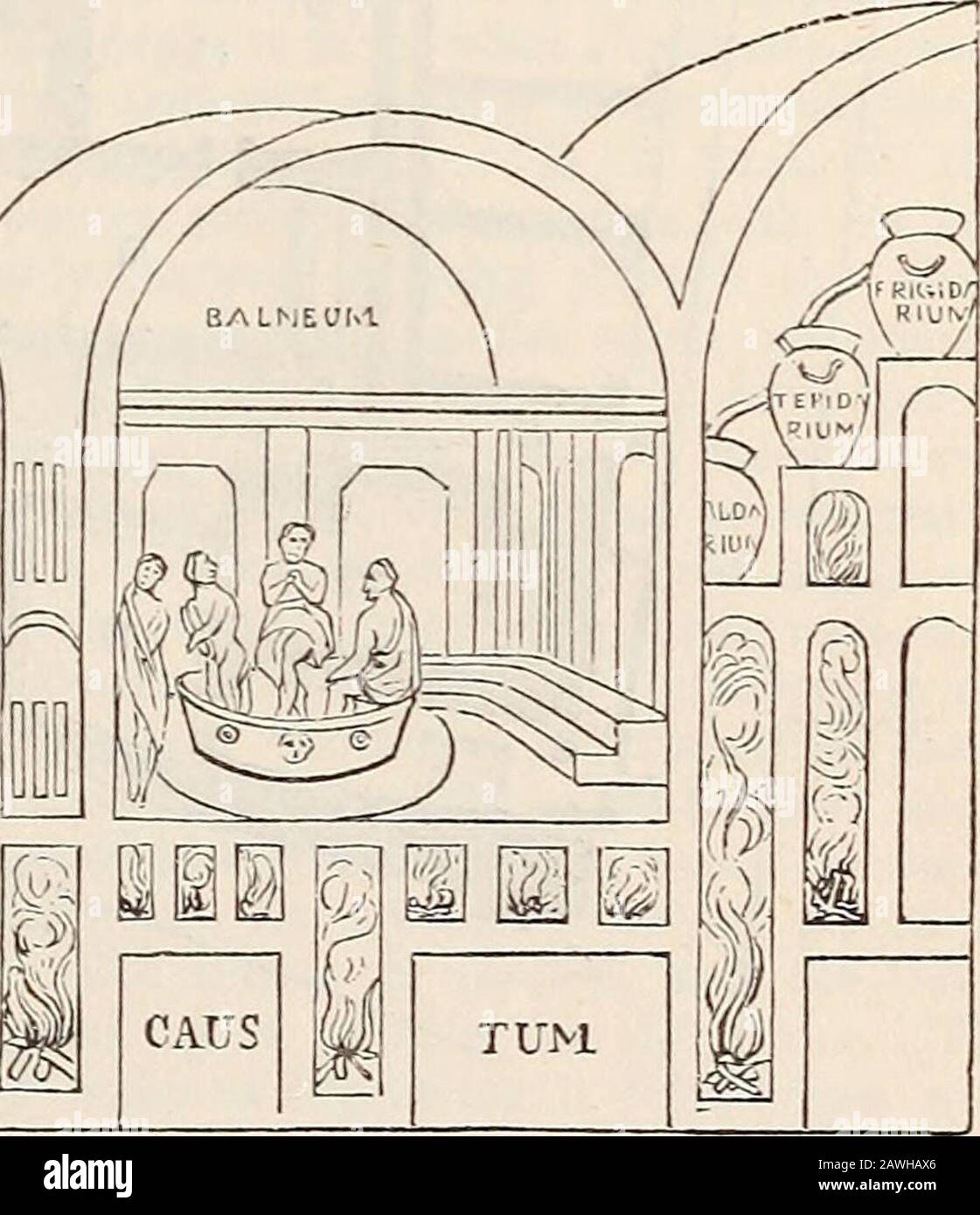 A dictionary of Greek and Roman antiquities.. . s M HR Q lira. III S@SHI CAUS some respects as to the order in which the bathsshould be taken ; the former recommending first thehot air of the Laconicum (aepi &ep/j.cp), next thebath of warm water (vdcop ^ep/j.bv and Xovrpov*),afterwards the cold, and finally to be well rubbed * Aovrpov. In this passage it is plain that theword Kovrpov is used for a warm bath, in whichsense it also occurs in the same author. Vitruvius(v. 11), on the contrary, says that the Greeks usedthe same word to signify a cold bath (frigidalavatio, quann Graeci Aovrpov voci Stock Photohttps://www.alamy.com/image-license-details/?v=1https://www.alamy.com/a-dictionary-of-greek-and-roman-antiquities-s-m-hr-q-lira-iii-s@shi-caus-some-respects-as-to-the-order-in-which-the-bathsshould-be-taken-the-former-recommending-first-thehot-air-of-the-laconicum-aepi-epjcp-next-thebath-of-warm-water-vdcop-epjbv-and-xovrpovafterwards-the-cold-and-finally-to-be-well-rubbed-aovrpov-in-this-passage-it-is-plain-that-theword-kovrpov-is-used-for-a-warm-bath-in-whichsense-it-also-occurs-in-the-same-author-vitruviusv-11-on-the-contrary-says-that-the-greeks-usedthe-same-word-to-signify-a-cold-bath-frigidalavatio-quann-graeci-aovrpov-voci-image342745150.html
A dictionary of Greek and Roman antiquities.. . s M HR Q lira. III S@SHI CAUS some respects as to the order in which the bathsshould be taken ; the former recommending first thehot air of the Laconicum (aepi &ep/j.cp), next thebath of warm water (vdcop ^ep/j.bv and Xovrpov*),afterwards the cold, and finally to be well rubbed * Aovrpov. In this passage it is plain that theword Kovrpov is used for a warm bath, in whichsense it also occurs in the same author. Vitruvius(v. 11), on the contrary, says that the Greeks usedthe same word to signify a cold bath (frigidalavatio, quann Graeci Aovrpov voci Stock Photohttps://www.alamy.com/image-license-details/?v=1https://www.alamy.com/a-dictionary-of-greek-and-roman-antiquities-s-m-hr-q-lira-iii-s@shi-caus-some-respects-as-to-the-order-in-which-the-bathsshould-be-taken-the-former-recommending-first-thehot-air-of-the-laconicum-aepi-epjcp-next-thebath-of-warm-water-vdcop-epjbv-and-xovrpovafterwards-the-cold-and-finally-to-be-well-rubbed-aovrpov-in-this-passage-it-is-plain-that-theword-kovrpov-is-used-for-a-warm-bath-in-whichsense-it-also-occurs-in-the-same-author-vitruviusv-11-on-the-contrary-says-that-the-greeks-usedthe-same-word-to-signify-a-cold-bath-frigidalavatio-quann-graeci-aovrpov-voci-image342745150.htmlRM2AWHAX6–A dictionary of Greek and Roman antiquities.. . s M HR Q lira. III S@SHI CAUS some respects as to the order in which the bathsshould be taken ; the former recommending first thehot air of the Laconicum (aepi &ep/j.cp), next thebath of warm water (vdcop ^ep/j.bv and Xovrpov*),afterwards the cold, and finally to be well rubbed * Aovrpov. In this passage it is plain that theword Kovrpov is used for a warm bath, in whichsense it also occurs in the same author. Vitruvius(v. 11), on the contrary, says that the Greeks usedthe same word to signify a cold bath (frigidalavatio, quann Graeci Aovrpov voci
 A dictionary of Greek and Roman antiquities.. . 428 ; Varr. De Ling. Lot.v. 19, ed. Muller ; Festus, s. v.) According toother accounts, however, the Greeks obtained the shield, as well as the helmet, from the Egyptians(Herod, iv. 180 ; Plat. Tim. p. 24, b.) The shield used by the Homeric heroes waslarge enough to cover the whole man. It wassometimes made of osiers twisted together, calledtVecc, or of wood: the wood or wicker was thencovered over with ox hides of several folds deep,and finally bound round the edge with metal.(Horn. //. xii. 295.) The outer rim is termed&vtvZ {II. xviii. 479), i Stock Photohttps://www.alamy.com/image-license-details/?v=1https://www.alamy.com/a-dictionary-of-greek-and-roman-antiquities-428-varr-de-ling-lotv-19-ed-muller-festus-s-v-according-toother-accounts-however-the-greeks-obtained-the-shield-as-well-as-the-helmet-from-the-egyptiansherod-iv-180-plat-tim-p-24-b-the-shield-used-by-the-homeric-heroes-waslarge-enough-to-cover-the-whole-man-it-wassometimes-made-of-osiers-twisted-together-calledtvecc-or-of-wood-the-wood-or-wicker-was-thencovered-over-with-ox-hides-of-several-folds-deepand-finally-bound-round-the-edge-with-metalhorn-xii-295-the-outer-rim-is-termedvtvz-ii-xviii-479-i-image342721462.html
A dictionary of Greek and Roman antiquities.. . 428 ; Varr. De Ling. Lot.v. 19, ed. Muller ; Festus, s. v.) According toother accounts, however, the Greeks obtained the shield, as well as the helmet, from the Egyptians(Herod, iv. 180 ; Plat. Tim. p. 24, b.) The shield used by the Homeric heroes waslarge enough to cover the whole man. It wassometimes made of osiers twisted together, calledtVecc, or of wood: the wood or wicker was thencovered over with ox hides of several folds deep,and finally bound round the edge with metal.(Horn. //. xii. 295.) The outer rim is termed&vtvZ {II. xviii. 479), i Stock Photohttps://www.alamy.com/image-license-details/?v=1https://www.alamy.com/a-dictionary-of-greek-and-roman-antiquities-428-varr-de-ling-lotv-19-ed-muller-festus-s-v-according-toother-accounts-however-the-greeks-obtained-the-shield-as-well-as-the-helmet-from-the-egyptiansherod-iv-180-plat-tim-p-24-b-the-shield-used-by-the-homeric-heroes-waslarge-enough-to-cover-the-whole-man-it-wassometimes-made-of-osiers-twisted-together-calledtvecc-or-of-wood-the-wood-or-wicker-was-thencovered-over-with-ox-hides-of-several-folds-deepand-finally-bound-round-the-edge-with-metalhorn-xii-295-the-outer-rim-is-termedvtvz-ii-xviii-479-i-image342721462.htmlRM2AWG8M6–A dictionary of Greek and Roman antiquities.. . 428 ; Varr. De Ling. Lot.v. 19, ed. Muller ; Festus, s. v.) According toother accounts, however, the Greeks obtained the shield, as well as the helmet, from the Egyptians(Herod, iv. 180 ; Plat. Tim. p. 24, b.) The shield used by the Homeric heroes waslarge enough to cover the whole man. It wassometimes made of osiers twisted together, calledtVecc, or of wood: the wood or wicker was thencovered over with ox hides of several folds deep,and finally bound round the edge with metal.(Horn. //. xii. 295.) The outer rim is termed&vtvZ {II. xviii. 479), i
 A dictionary of Greek and Roman antiquities.. . 423 ; Varr. De Ling. Lot.v. 19, ed. Midler ; Festus, s. v.) According toother accounts, however, the Greeks obtained the shield, as well as the helmet, from the Eg)-ptians(Herod, iv. 180 ; Plat. Tim. p. 24, b.) The shield used by the Homeric heroes waslarge enough to cover the whole man. It wassometimes made of osiers twisted together, calledtVea, or of wood: the wood or wicker was thencovered over with ox hides of several folds deep,and finally bound round the edge with metal.(Horn. II. xii. 295.) The outer rim is termed&/tv| (//. xviii. 479), f Stock Photohttps://www.alamy.com/image-license-details/?v=1https://www.alamy.com/a-dictionary-of-greek-and-roman-antiquities-423-varr-de-ling-lotv-19-ed-midler-festus-s-v-according-toother-accounts-however-the-greeks-obtained-the-shield-as-well-as-the-helmet-from-the-eg-ptiansherod-iv-180-plat-tim-p-24-b-the-shield-used-by-the-homeric-heroes-waslarge-enough-to-cover-the-whole-man-it-wassometimes-made-of-osiers-twisted-together-calledtvea-or-of-wood-the-wood-or-wicker-was-thencovered-over-with-ox-hides-of-several-folds-deepand-finally-bound-round-the-edge-with-metalhorn-ii-xii-295-the-outer-rim-is-termedtv-xviii-479-f-image339302943.html
A dictionary of Greek and Roman antiquities.. . 423 ; Varr. De Ling. Lot.v. 19, ed. Midler ; Festus, s. v.) According toother accounts, however, the Greeks obtained the shield, as well as the helmet, from the Eg)-ptians(Herod, iv. 180 ; Plat. Tim. p. 24, b.) The shield used by the Homeric heroes waslarge enough to cover the whole man. It wassometimes made of osiers twisted together, calledtVea, or of wood: the wood or wicker was thencovered over with ox hides of several folds deep,and finally bound round the edge with metal.(Horn. II. xii. 295.) The outer rim is termed&/tv| (//. xviii. 479), f Stock Photohttps://www.alamy.com/image-license-details/?v=1https://www.alamy.com/a-dictionary-of-greek-and-roman-antiquities-423-varr-de-ling-lotv-19-ed-midler-festus-s-v-according-toother-accounts-however-the-greeks-obtained-the-shield-as-well-as-the-helmet-from-the-eg-ptiansherod-iv-180-plat-tim-p-24-b-the-shield-used-by-the-homeric-heroes-waslarge-enough-to-cover-the-whole-man-it-wassometimes-made-of-osiers-twisted-together-calledtvea-or-of-wood-the-wood-or-wicker-was-thencovered-over-with-ox-hides-of-several-folds-deepand-finally-bound-round-the-edge-with-metalhorn-ii-xii-295-the-outer-rim-is-termedtv-xviii-479-f-image339302943.htmlRM2AM0GA7–A dictionary of Greek and Roman antiquities.. . 423 ; Varr. De Ling. Lot.v. 19, ed. Midler ; Festus, s. v.) According toother accounts, however, the Greeks obtained the shield, as well as the helmet, from the Eg)-ptians(Herod, iv. 180 ; Plat. Tim. p. 24, b.) The shield used by the Homeric heroes waslarge enough to cover the whole man. It wassometimes made of osiers twisted together, calledtVea, or of wood: the wood or wicker was thencovered over with ox hides of several folds deep,and finally bound round the edge with metal.(Horn. II. xii. 295.) The outer rim is termed&/tv| (//. xviii. 479), f
![A dictionary of Greek and Roman antiquities.. . ken of as a place of execution in the followingpassages:—In robore et tenebris exspirare (Liv.xxxviii. 59 ; Sallust, I. c.).. Robur et saacum (sc.Tarpeium) minitari (Tacit. Ann. iv. 29). So alsowe read of the catenas — et Ralum robur. (Hor.Carm. ii. 13. 18.) [R. W.] CARCERES. [Circus.] CARCHESIUM (icapxvo-iov). 1. A beakeror drinking-cup, which was used by the Greeks invery early times, so that one is said to have beengiven by Jupiter to Alcmena on the night of hisvisit to her. (Pherccydes, p. 97—100, ed. Sturtz.)It was slightly contracted in the Stock Photo A dictionary of Greek and Roman antiquities.. . ken of as a place of execution in the followingpassages:—In robore et tenebris exspirare (Liv.xxxviii. 59 ; Sallust, I. c.).. Robur et saacum (sc.Tarpeium) minitari (Tacit. Ann. iv. 29). So alsowe read of the catenas — et Ralum robur. (Hor.Carm. ii. 13. 18.) [R. W.] CARCERES. [Circus.] CARCHESIUM (icapxvo-iov). 1. A beakeror drinking-cup, which was used by the Greeks invery early times, so that one is said to have beengiven by Jupiter to Alcmena on the night of hisvisit to her. (Pherccydes, p. 97—100, ed. Sturtz.)It was slightly contracted in the Stock Photo](https://c8.alamy.com/comp/2AWGJYX/a-dictionary-of-greek-and-roman-antiquities-ken-of-as-a-place-of-execution-in-the-followingpassagesin-robore-et-tenebris-exspirare-livxxxviii-59-sallust-i-c-robur-et-saacum-sctarpeium-minitari-tacit-ann-iv-29-so-alsowe-read-of-the-catenas-et-ralum-robur-horcarm-ii-13-18-r-w-carceres-circus-carchesium-icapxvo-iov-1-a-beakeror-drinking-cup-which-was-used-by-the-greeks-invery-early-times-so-that-one-is-said-to-have-beengiven-by-jupiter-to-alcmena-on-the-night-of-hisvisit-to-her-pherccydes-p-97100-ed-sturtzit-was-slightly-contracted-in-the-2AWGJYX.jpg) A dictionary of Greek and Roman antiquities.. . ken of as a place of execution in the followingpassages:—In robore et tenebris exspirare (Liv.xxxviii. 59 ; Sallust, I. c.).. Robur et saacum (sc.Tarpeium) minitari (Tacit. Ann. iv. 29). So alsowe read of the catenas — et Ralum robur. (Hor.Carm. ii. 13. 18.) [R. W.] CARCERES. [Circus.] CARCHESIUM (icapxvo-iov). 1. A beakeror drinking-cup, which was used by the Greeks invery early times, so that one is said to have beengiven by Jupiter to Alcmena on the night of hisvisit to her. (Pherccydes, p. 97—100, ed. Sturtz.)It was slightly contracted in the Stock Photohttps://www.alamy.com/image-license-details/?v=1https://www.alamy.com/a-dictionary-of-greek-and-roman-antiquities-ken-of-as-a-place-of-execution-in-the-followingpassagesin-robore-et-tenebris-exspirare-livxxxviii-59-sallust-i-c-robur-et-saacum-sctarpeium-minitari-tacit-ann-iv-29-so-alsowe-read-of-the-catenas-et-ralum-robur-horcarm-ii-13-18-r-w-carceres-circus-carchesium-icapxvo-iov-1-a-beakeror-drinking-cup-which-was-used-by-the-greeks-invery-early-times-so-that-one-is-said-to-have-beengiven-by-jupiter-to-alcmena-on-the-night-of-hisvisit-to-her-pherccydes-p-97100-ed-sturtzit-was-slightly-contracted-in-the-image342729518.html
A dictionary of Greek and Roman antiquities.. . ken of as a place of execution in the followingpassages:—In robore et tenebris exspirare (Liv.xxxviii. 59 ; Sallust, I. c.).. Robur et saacum (sc.Tarpeium) minitari (Tacit. Ann. iv. 29). So alsowe read of the catenas — et Ralum robur. (Hor.Carm. ii. 13. 18.) [R. W.] CARCERES. [Circus.] CARCHESIUM (icapxvo-iov). 1. A beakeror drinking-cup, which was used by the Greeks invery early times, so that one is said to have beengiven by Jupiter to Alcmena on the night of hisvisit to her. (Pherccydes, p. 97—100, ed. Sturtz.)It was slightly contracted in the Stock Photohttps://www.alamy.com/image-license-details/?v=1https://www.alamy.com/a-dictionary-of-greek-and-roman-antiquities-ken-of-as-a-place-of-execution-in-the-followingpassagesin-robore-et-tenebris-exspirare-livxxxviii-59-sallust-i-c-robur-et-saacum-sctarpeium-minitari-tacit-ann-iv-29-so-alsowe-read-of-the-catenas-et-ralum-robur-horcarm-ii-13-18-r-w-carceres-circus-carchesium-icapxvo-iov-1-a-beakeror-drinking-cup-which-was-used-by-the-greeks-invery-early-times-so-that-one-is-said-to-have-beengiven-by-jupiter-to-alcmena-on-the-night-of-hisvisit-to-her-pherccydes-p-97100-ed-sturtzit-was-slightly-contracted-in-the-image342729518.htmlRM2AWGJYX–A dictionary of Greek and Roman antiquities.. . ken of as a place of execution in the followingpassages:—In robore et tenebris exspirare (Liv.xxxviii. 59 ; Sallust, I. c.).. Robur et saacum (sc.Tarpeium) minitari (Tacit. Ann. iv. 29). So alsowe read of the catenas — et Ralum robur. (Hor.Carm. ii. 13. 18.) [R. W.] CARCERES. [Circus.] CARCHESIUM (icapxvo-iov). 1. A beakeror drinking-cup, which was used by the Greeks invery early times, so that one is said to have beengiven by Jupiter to Alcmena on the night of hisvisit to her. (Pherccydes, p. 97—100, ed. Sturtz.)It was slightly contracted in the
![A dictionary of Greek and Roman antiquities.. . his was the head-dress which character-ized the north-western Asiatics, and more especiallythe Armenians (Xen. Cyr. 1. § 13; Sueton. Nero,13), the Parthians, and the Persians (Herod, iii.12 ; Philost. Sen. Imag. ii. 31 ; Plaut. Pers. iv.2. 2), as distinguished from the Greeks and Ro-mans, whose hats fitted the head or had only alow crown. The Mysian hat, or Phrygian bon-net, as it is now called [Pileus, p. 919, b.], wasa kind of tiara (Virg. A en. vii. 247; Servius, in loc;Sen. Thyest. iv. L 40, 41 ; Philostr. Jun. Imag.8), formed with lappets to Stock Photo A dictionary of Greek and Roman antiquities.. . his was the head-dress which character-ized the north-western Asiatics, and more especiallythe Armenians (Xen. Cyr. 1. § 13; Sueton. Nero,13), the Parthians, and the Persians (Herod, iii.12 ; Philost. Sen. Imag. ii. 31 ; Plaut. Pers. iv.2. 2), as distinguished from the Greeks and Ro-mans, whose hats fitted the head or had only alow crown. The Mysian hat, or Phrygian bon-net, as it is now called [Pileus, p. 919, b.], wasa kind of tiara (Virg. A en. vii. 247; Servius, in loc;Sen. Thyest. iv. L 40, 41 ; Philostr. Jun. Imag.8), formed with lappets to Stock Photo](https://c8.alamy.com/comp/2ANH7DN/a-dictionary-of-greek-and-roman-antiquities-his-was-the-head-dress-which-character-ized-the-north-western-asiatics-and-more-especiallythe-armenians-xen-cyr-1-13-sueton-nero13-the-parthians-and-the-persians-herod-iii12-philost-sen-imag-ii-31-plaut-pers-iv2-2-as-distinguished-from-the-greeks-and-ro-mans-whose-hats-fitted-the-head-or-had-only-alow-crown-the-mysian-hat-or-phrygian-bon-net-as-it-is-now-called-pileus-p-919-b-wasa-kind-of-tiara-virg-a-en-vii-247-servius-in-locsen-thyest-iv-l-40-41-philostr-jun-imag8-formed-with-lappets-to-2ANH7DN.jpg) A dictionary of Greek and Roman antiquities.. . his was the head-dress which character-ized the north-western Asiatics, and more especiallythe Armenians (Xen. Cyr. 1. § 13; Sueton. Nero,13), the Parthians, and the Persians (Herod, iii.12 ; Philost. Sen. Imag. ii. 31 ; Plaut. Pers. iv.2. 2), as distinguished from the Greeks and Ro-mans, whose hats fitted the head or had only alow crown. The Mysian hat, or Phrygian bon-net, as it is now called [Pileus, p. 919, b.], wasa kind of tiara (Virg. A en. vii. 247; Servius, in loc;Sen. Thyest. iv. L 40, 41 ; Philostr. Jun. Imag.8), formed with lappets to Stock Photohttps://www.alamy.com/image-license-details/?v=1https://www.alamy.com/a-dictionary-of-greek-and-roman-antiquities-his-was-the-head-dress-which-character-ized-the-north-western-asiatics-and-more-especiallythe-armenians-xen-cyr-1-13-sueton-nero13-the-parthians-and-the-persians-herod-iii12-philost-sen-imag-ii-31-plaut-pers-iv2-2-as-distinguished-from-the-greeks-and-ro-mans-whose-hats-fitted-the-head-or-had-only-alow-crown-the-mysian-hat-or-phrygian-bon-net-as-it-is-now-called-pileus-p-919-b-wasa-kind-of-tiara-virg-a-en-vii-247-servius-in-locsen-thyest-iv-l-40-41-philostr-jun-imag8-formed-with-lappets-to-image340283825.html
A dictionary of Greek and Roman antiquities.. . his was the head-dress which character-ized the north-western Asiatics, and more especiallythe Armenians (Xen. Cyr. 1. § 13; Sueton. Nero,13), the Parthians, and the Persians (Herod, iii.12 ; Philost. Sen. Imag. ii. 31 ; Plaut. Pers. iv.2. 2), as distinguished from the Greeks and Ro-mans, whose hats fitted the head or had only alow crown. The Mysian hat, or Phrygian bon-net, as it is now called [Pileus, p. 919, b.], wasa kind of tiara (Virg. A en. vii. 247; Servius, in loc;Sen. Thyest. iv. L 40, 41 ; Philostr. Jun. Imag.8), formed with lappets to Stock Photohttps://www.alamy.com/image-license-details/?v=1https://www.alamy.com/a-dictionary-of-greek-and-roman-antiquities-his-was-the-head-dress-which-character-ized-the-north-western-asiatics-and-more-especiallythe-armenians-xen-cyr-1-13-sueton-nero13-the-parthians-and-the-persians-herod-iii12-philost-sen-imag-ii-31-plaut-pers-iv2-2-as-distinguished-from-the-greeks-and-ro-mans-whose-hats-fitted-the-head-or-had-only-alow-crown-the-mysian-hat-or-phrygian-bon-net-as-it-is-now-called-pileus-p-919-b-wasa-kind-of-tiara-virg-a-en-vii-247-servius-in-locsen-thyest-iv-l-40-41-philostr-jun-imag8-formed-with-lappets-to-image340283825.htmlRM2ANH7DN–A dictionary of Greek and Roman antiquities.. . his was the head-dress which character-ized the north-western Asiatics, and more especiallythe Armenians (Xen. Cyr. 1. § 13; Sueton. Nero,13), the Parthians, and the Persians (Herod, iii.12 ; Philost. Sen. Imag. ii. 31 ; Plaut. Pers. iv.2. 2), as distinguished from the Greeks and Ro-mans, whose hats fitted the head or had only alow crown. The Mysian hat, or Phrygian bon-net, as it is now called [Pileus, p. 919, b.], wasa kind of tiara (Virg. A en. vii. 247; Servius, in loc;Sen. Thyest. iv. L 40, 41 ; Philostr. Jun. Imag.8), formed with lappets to
![A dictionary of Greek and Roman antiquities.. . ad Aristoph. Acharn. 108, 109 ; Suid.s. v.) According to Hesychius a Boeotian axavqwas equal to one Attic medimnus. [P. S.] ACIES. [Exercitus.] ACINACES (aKLvdicris), a Persian sword,whence Horace {Carm. i. 27. 5) speaks of theMedus acinaces. It was a short and straight wea-pon, and thus differed from the Roman sica, whichwas curved. (Pollux, i. 138 ; Joseph. Ant. Jud.xx. 7. § 10. [Sica.] It was worn on the rightside of the body (insignis acinace dextro, VaL Flacc.Argon, vi. 701), whereas the Greeks and Romansusually had their swords suspended on Stock Photo A dictionary of Greek and Roman antiquities.. . ad Aristoph. Acharn. 108, 109 ; Suid.s. v.) According to Hesychius a Boeotian axavqwas equal to one Attic medimnus. [P. S.] ACIES. [Exercitus.] ACINACES (aKLvdicris), a Persian sword,whence Horace {Carm. i. 27. 5) speaks of theMedus acinaces. It was a short and straight wea-pon, and thus differed from the Roman sica, whichwas curved. (Pollux, i. 138 ; Joseph. Ant. Jud.xx. 7. § 10. [Sica.] It was worn on the rightside of the body (insignis acinace dextro, VaL Flacc.Argon, vi. 701), whereas the Greeks and Romansusually had their swords suspended on Stock Photo](https://c8.alamy.com/comp/2AM2X97/a-dictionary-of-greek-and-roman-antiquities-ad-aristoph-acharn-108-109-suids-v-according-to-hesychius-a-boeotian-axavqwas-equal-to-one-attic-medimnus-p-s-acies-exercitus-acinaces-aklvdicris-a-persian-swordwhence-horace-carm-i-27-5-speaks-of-themedus-acinaces-it-was-a-short-and-straight-wea-pon-and-thus-differed-from-the-roman-sica-whichwas-curved-pollux-i-138-joseph-ant-judxx-7-10-sica-it-was-worn-on-the-rightside-of-the-body-insignis-acinace-dextro-val-flaccargon-vi-701-whereas-the-greeks-and-romansusually-had-their-swords-suspended-on-2AM2X97.jpg) A dictionary of Greek and Roman antiquities.. . ad Aristoph. Acharn. 108, 109 ; Suid.s. v.) According to Hesychius a Boeotian axavqwas equal to one Attic medimnus. [P. S.] ACIES. [Exercitus.] ACINACES (aKLvdicris), a Persian sword,whence Horace {Carm. i. 27. 5) speaks of theMedus acinaces. It was a short and straight wea-pon, and thus differed from the Roman sica, whichwas curved. (Pollux, i. 138 ; Joseph. Ant. Jud.xx. 7. § 10. [Sica.] It was worn on the rightside of the body (insignis acinace dextro, VaL Flacc.Argon, vi. 701), whereas the Greeks and Romansusually had their swords suspended on Stock Photohttps://www.alamy.com/image-license-details/?v=1https://www.alamy.com/a-dictionary-of-greek-and-roman-antiquities-ad-aristoph-acharn-108-109-suids-v-according-to-hesychius-a-boeotian-axavqwas-equal-to-one-attic-medimnus-p-s-acies-exercitus-acinaces-aklvdicris-a-persian-swordwhence-horace-carm-i-27-5-speaks-of-themedus-acinaces-it-was-a-short-and-straight-wea-pon-and-thus-differed-from-the-roman-sica-whichwas-curved-pollux-i-138-joseph-ant-judxx-7-10-sica-it-was-worn-on-the-rightside-of-the-body-insignis-acinace-dextro-val-flaccargon-vi-701-whereas-the-greeks-and-romansusually-had-their-swords-suspended-on-image339354659.html
A dictionary of Greek and Roman antiquities.. . ad Aristoph. Acharn. 108, 109 ; Suid.s. v.) According to Hesychius a Boeotian axavqwas equal to one Attic medimnus. [P. S.] ACIES. [Exercitus.] ACINACES (aKLvdicris), a Persian sword,whence Horace {Carm. i. 27. 5) speaks of theMedus acinaces. It was a short and straight wea-pon, and thus differed from the Roman sica, whichwas curved. (Pollux, i. 138 ; Joseph. Ant. Jud.xx. 7. § 10. [Sica.] It was worn on the rightside of the body (insignis acinace dextro, VaL Flacc.Argon, vi. 701), whereas the Greeks and Romansusually had their swords suspended on Stock Photohttps://www.alamy.com/image-license-details/?v=1https://www.alamy.com/a-dictionary-of-greek-and-roman-antiquities-ad-aristoph-acharn-108-109-suids-v-according-to-hesychius-a-boeotian-axavqwas-equal-to-one-attic-medimnus-p-s-acies-exercitus-acinaces-aklvdicris-a-persian-swordwhence-horace-carm-i-27-5-speaks-of-themedus-acinaces-it-was-a-short-and-straight-wea-pon-and-thus-differed-from-the-roman-sica-whichwas-curved-pollux-i-138-joseph-ant-judxx-7-10-sica-it-was-worn-on-the-rightside-of-the-body-insignis-acinace-dextro-val-flaccargon-vi-701-whereas-the-greeks-and-romansusually-had-their-swords-suspended-on-image339354659.htmlRM2AM2X97–A dictionary of Greek and Roman antiquities.. . ad Aristoph. Acharn. 108, 109 ; Suid.s. v.) According to Hesychius a Boeotian axavqwas equal to one Attic medimnus. [P. S.] ACIES. [Exercitus.] ACINACES (aKLvdicris), a Persian sword,whence Horace {Carm. i. 27. 5) speaks of theMedus acinaces. It was a short and straight wea-pon, and thus differed from the Roman sica, whichwas curved. (Pollux, i. 138 ; Joseph. Ant. Jud.xx. 7. § 10. [Sica.] It was worn on the rightside of the body (insignis acinace dextro, VaL Flacc.Argon, vi. 701), whereas the Greeks and Romansusually had their swords suspended on
![A dictionary of Greek and Roman antiquities.. . is was the head-dress which character-ized the north-western Asiatics, and more especiallythe Armenians (Xen. Cyr. 1. § 13; Sueton. Nero,13), the Parthians, and the Persians (Herod, iii.12 ; Philost. Sen. Imag. ii. 31 ; Plaut. Pers. iv.2. 2), as distinguished from the Greeks and Ro-mans, whose hats fitted the head or had only alow crown. The Mysian hat, or Phrygian bon-net, as it is now called [Pileus, p. 919, b.], wasa kind of tiara (Virg. A en. vii. 247; Servius, in loc;Sen. Thyest. iv. 1. 40, 41 ; Philostr. Jun. Imag.8), formed with lappets to Stock Photo A dictionary of Greek and Roman antiquities.. . is was the head-dress which character-ized the north-western Asiatics, and more especiallythe Armenians (Xen. Cyr. 1. § 13; Sueton. Nero,13), the Parthians, and the Persians (Herod, iii.12 ; Philost. Sen. Imag. ii. 31 ; Plaut. Pers. iv.2. 2), as distinguished from the Greeks and Ro-mans, whose hats fitted the head or had only alow crown. The Mysian hat, or Phrygian bon-net, as it is now called [Pileus, p. 919, b.], wasa kind of tiara (Virg. A en. vii. 247; Servius, in loc;Sen. Thyest. iv. 1. 40, 41 ; Philostr. Jun. Imag.8), formed with lappets to Stock Photo](https://c8.alamy.com/comp/2AKPBFP/a-dictionary-of-greek-and-roman-antiquities-is-was-the-head-dress-which-character-ized-the-north-western-asiatics-and-more-especiallythe-armenians-xen-cyr-1-13-sueton-nero13-the-parthians-and-the-persians-herod-iii12-philost-sen-imag-ii-31-plaut-pers-iv2-2-as-distinguished-from-the-greeks-and-ro-mans-whose-hats-fitted-the-head-or-had-only-alow-crown-the-mysian-hat-or-phrygian-bon-net-as-it-is-now-called-pileus-p-919-b-wasa-kind-of-tiara-virg-a-en-vii-247-servius-in-locsen-thyest-iv-1-40-41-philostr-jun-imag8-formed-with-lappets-to-2AKPBFP.jpg) A dictionary of Greek and Roman antiquities.. . is was the head-dress which character-ized the north-western Asiatics, and more especiallythe Armenians (Xen. Cyr. 1. § 13; Sueton. Nero,13), the Parthians, and the Persians (Herod, iii.12 ; Philost. Sen. Imag. ii. 31 ; Plaut. Pers. iv.2. 2), as distinguished from the Greeks and Ro-mans, whose hats fitted the head or had only alow crown. The Mysian hat, or Phrygian bon-net, as it is now called [Pileus, p. 919, b.], wasa kind of tiara (Virg. A en. vii. 247; Servius, in loc;Sen. Thyest. iv. 1. 40, 41 ; Philostr. Jun. Imag.8), formed with lappets to Stock Photohttps://www.alamy.com/image-license-details/?v=1https://www.alamy.com/a-dictionary-of-greek-and-roman-antiquities-is-was-the-head-dress-which-character-ized-the-north-western-asiatics-and-more-especiallythe-armenians-xen-cyr-1-13-sueton-nero13-the-parthians-and-the-persians-herod-iii12-philost-sen-imag-ii-31-plaut-pers-iv2-2-as-distinguished-from-the-greeks-and-ro-mans-whose-hats-fitted-the-head-or-had-only-alow-crown-the-mysian-hat-or-phrygian-bon-net-as-it-is-now-called-pileus-p-919-b-wasa-kind-of-tiara-virg-a-en-vii-247-servius-in-locsen-thyest-iv-1-40-41-philostr-jun-imag8-formed-with-lappets-to-image339167466.html
A dictionary of Greek and Roman antiquities.. . is was the head-dress which character-ized the north-western Asiatics, and more especiallythe Armenians (Xen. Cyr. 1. § 13; Sueton. Nero,13), the Parthians, and the Persians (Herod, iii.12 ; Philost. Sen. Imag. ii. 31 ; Plaut. Pers. iv.2. 2), as distinguished from the Greeks and Ro-mans, whose hats fitted the head or had only alow crown. The Mysian hat, or Phrygian bon-net, as it is now called [Pileus, p. 919, b.], wasa kind of tiara (Virg. A en. vii. 247; Servius, in loc;Sen. Thyest. iv. 1. 40, 41 ; Philostr. Jun. Imag.8), formed with lappets to Stock Photohttps://www.alamy.com/image-license-details/?v=1https://www.alamy.com/a-dictionary-of-greek-and-roman-antiquities-is-was-the-head-dress-which-character-ized-the-north-western-asiatics-and-more-especiallythe-armenians-xen-cyr-1-13-sueton-nero13-the-parthians-and-the-persians-herod-iii12-philost-sen-imag-ii-31-plaut-pers-iv2-2-as-distinguished-from-the-greeks-and-ro-mans-whose-hats-fitted-the-head-or-had-only-alow-crown-the-mysian-hat-or-phrygian-bon-net-as-it-is-now-called-pileus-p-919-b-wasa-kind-of-tiara-virg-a-en-vii-247-servius-in-locsen-thyest-iv-1-40-41-philostr-jun-imag8-formed-with-lappets-to-image339167466.htmlRM2AKPBFP–A dictionary of Greek and Roman antiquities.. . is was the head-dress which character-ized the north-western Asiatics, and more especiallythe Armenians (Xen. Cyr. 1. § 13; Sueton. Nero,13), the Parthians, and the Persians (Herod, iii.12 ; Philost. Sen. Imag. ii. 31 ; Plaut. Pers. iv.2. 2), as distinguished from the Greeks and Ro-mans, whose hats fitted the head or had only alow crown. The Mysian hat, or Phrygian bon-net, as it is now called [Pileus, p. 919, b.], wasa kind of tiara (Virg. A en. vii. 247; Servius, in loc;Sen. Thyest. iv. 1. 40, 41 ; Philostr. Jun. Imag.8), formed with lappets to
![A dictionary of Greek and Roman antiquities.. . ad Aristoph. Acharn. 108, 109 ; Suid.s. v.) According to Hesychius a Boeotian axdv7]was equal to one Attic medimnus. [P. S.] ACIES. [Exercitus.] ACFNACES (aKivan-qs), a Persian sword,whence Horace (Carm. i. 27. 5) speaks of theMedus acinaces. It was a short and straight wea-pon, and thus differed from the Roman sica, whichwas curved. (Pollux, i. 138 ; Joseph. Ant. Jud.xx. 7. § 10. [Sica.] It was worn on the rightside of the body (insignis acinace dextro, Val. Flacc.Argon, vi. 701), whereas the Greeks and Romansusually had their swords suspended o Stock Photo A dictionary of Greek and Roman antiquities.. . ad Aristoph. Acharn. 108, 109 ; Suid.s. v.) According to Hesychius a Boeotian axdv7]was equal to one Attic medimnus. [P. S.] ACIES. [Exercitus.] ACFNACES (aKivan-qs), a Persian sword,whence Horace (Carm. i. 27. 5) speaks of theMedus acinaces. It was a short and straight wea-pon, and thus differed from the Roman sica, whichwas curved. (Pollux, i. 138 ; Joseph. Ant. Jud.xx. 7. § 10. [Sica.] It was worn on the rightside of the body (insignis acinace dextro, Val. Flacc.Argon, vi. 701), whereas the Greeks and Romansusually had their swords suspended o Stock Photo](https://c8.alamy.com/comp/2AWJ814/a-dictionary-of-greek-and-roman-antiquities-ad-aristoph-acharn-108-109-suids-v-according-to-hesychius-a-boeotian-axdv7-was-equal-to-one-attic-medimnus-p-s-acies-exercitus-acfnaces-akivan-qs-a-persian-swordwhence-horace-carm-i-27-5-speaks-of-themedus-acinaces-it-was-a-short-and-straight-wea-pon-and-thus-differed-from-the-roman-sica-whichwas-curved-pollux-i-138-joseph-ant-judxx-7-10-sica-it-was-worn-on-the-rightside-of-the-body-insignis-acinace-dextro-val-flaccargon-vi-701-whereas-the-greeks-and-romansusually-had-their-swords-suspended-o-2AWJ814.jpg) A dictionary of Greek and Roman antiquities.. . ad Aristoph. Acharn. 108, 109 ; Suid.s. v.) According to Hesychius a Boeotian axdv7]was equal to one Attic medimnus. [P. S.] ACIES. [Exercitus.] ACFNACES (aKivan-qs), a Persian sword,whence Horace (Carm. i. 27. 5) speaks of theMedus acinaces. It was a short and straight wea-pon, and thus differed from the Roman sica, whichwas curved. (Pollux, i. 138 ; Joseph. Ant. Jud.xx. 7. § 10. [Sica.] It was worn on the rightside of the body (insignis acinace dextro, Val. Flacc.Argon, vi. 701), whereas the Greeks and Romansusually had their swords suspended o Stock Photohttps://www.alamy.com/image-license-details/?v=1https://www.alamy.com/a-dictionary-of-greek-and-roman-antiquities-ad-aristoph-acharn-108-109-suids-v-according-to-hesychius-a-boeotian-axdv7-was-equal-to-one-attic-medimnus-p-s-acies-exercitus-acfnaces-akivan-qs-a-persian-swordwhence-horace-carm-i-27-5-speaks-of-themedus-acinaces-it-was-a-short-and-straight-wea-pon-and-thus-differed-from-the-roman-sica-whichwas-curved-pollux-i-138-joseph-ant-judxx-7-10-sica-it-was-worn-on-the-rightside-of-the-body-insignis-acinace-dextro-val-flaccargon-vi-701-whereas-the-greeks-and-romansusually-had-their-swords-suspended-o-image342764832.html
A dictionary of Greek and Roman antiquities.. . ad Aristoph. Acharn. 108, 109 ; Suid.s. v.) According to Hesychius a Boeotian axdv7]was equal to one Attic medimnus. [P. S.] ACIES. [Exercitus.] ACFNACES (aKivan-qs), a Persian sword,whence Horace (Carm. i. 27. 5) speaks of theMedus acinaces. It was a short and straight wea-pon, and thus differed from the Roman sica, whichwas curved. (Pollux, i. 138 ; Joseph. Ant. Jud.xx. 7. § 10. [Sica.] It was worn on the rightside of the body (insignis acinace dextro, Val. Flacc.Argon, vi. 701), whereas the Greeks and Romansusually had their swords suspended o Stock Photohttps://www.alamy.com/image-license-details/?v=1https://www.alamy.com/a-dictionary-of-greek-and-roman-antiquities-ad-aristoph-acharn-108-109-suids-v-according-to-hesychius-a-boeotian-axdv7-was-equal-to-one-attic-medimnus-p-s-acies-exercitus-acfnaces-akivan-qs-a-persian-swordwhence-horace-carm-i-27-5-speaks-of-themedus-acinaces-it-was-a-short-and-straight-wea-pon-and-thus-differed-from-the-roman-sica-whichwas-curved-pollux-i-138-joseph-ant-judxx-7-10-sica-it-was-worn-on-the-rightside-of-the-body-insignis-acinace-dextro-val-flaccargon-vi-701-whereas-the-greeks-and-romansusually-had-their-swords-suspended-o-image342764832.htmlRM2AWJ814–A dictionary of Greek and Roman antiquities.. . ad Aristoph. Acharn. 108, 109 ; Suid.s. v.) According to Hesychius a Boeotian axdv7]was equal to one Attic medimnus. [P. S.] ACIES. [Exercitus.] ACFNACES (aKivan-qs), a Persian sword,whence Horace (Carm. i. 27. 5) speaks of theMedus acinaces. It was a short and straight wea-pon, and thus differed from the Roman sica, whichwas curved. (Pollux, i. 138 ; Joseph. Ant. Jud.xx. 7. § 10. [Sica.] It was worn on the rightside of the body (insignis acinace dextro, Val. Flacc.Argon, vi. 701), whereas the Greeks and Romansusually had their swords suspended o
 A dictionary of Greek and Roman antiquities.. . orn. II. xiv. 182, Hymn. ii. in Ven. 9 ; Plin.H. N. xii. 1.) Ear-rings were worn by both sexes in orientalcountries (Plin. H. N. xi. 50) ; especially by theLydians (Xen. Anab. iii. 1. § 31), the Persians(Diod. Sic. v. 45), the Babylonians (Juv. i. 104),and also by the Libyans (Macrob. Sat. vii. 3), andthe Carthaginians (Plaut. Poen. v. 2. 21). Amongthe Greeks and Romans they were worn only byfemales. This ornament consisted of the ring (kpikos,Diod. Sic. I.e.) and of the drops (stalagmia, Festus,s. v. ; Plaut. Men. iii. 3. 18.) The ring was gene- Stock Photohttps://www.alamy.com/image-license-details/?v=1https://www.alamy.com/a-dictionary-of-greek-and-roman-antiquities-orn-ii-xiv-182-hymn-ii-in-ven-9-plinh-n-xii-1-ear-rings-were-worn-by-both-sexes-in-orientalcountries-plin-h-n-xi-50-especially-by-thelydians-xen-anab-iii-1-31-the-persiansdiod-sic-v-45-the-babylonians-juv-i-104and-also-by-the-libyans-macrob-sat-vii-3-andthe-carthaginians-plaut-poen-v-2-21-amongthe-greeks-and-romans-they-were-worn-only-byfemales-this-ornament-consisted-of-the-ring-kpikosdiod-sic-ie-and-of-the-drops-stalagmia-festuss-v-plaut-men-iii-3-18-the-ring-was-gene-image339244411.html
A dictionary of Greek and Roman antiquities.. . orn. II. xiv. 182, Hymn. ii. in Ven. 9 ; Plin.H. N. xii. 1.) Ear-rings were worn by both sexes in orientalcountries (Plin. H. N. xi. 50) ; especially by theLydians (Xen. Anab. iii. 1. § 31), the Persians(Diod. Sic. v. 45), the Babylonians (Juv. i. 104),and also by the Libyans (Macrob. Sat. vii. 3), andthe Carthaginians (Plaut. Poen. v. 2. 21). Amongthe Greeks and Romans they were worn only byfemales. This ornament consisted of the ring (kpikos,Diod. Sic. I.e.) and of the drops (stalagmia, Festus,s. v. ; Plaut. Men. iii. 3. 18.) The ring was gene- Stock Photohttps://www.alamy.com/image-license-details/?v=1https://www.alamy.com/a-dictionary-of-greek-and-roman-antiquities-orn-ii-xiv-182-hymn-ii-in-ven-9-plinh-n-xii-1-ear-rings-were-worn-by-both-sexes-in-orientalcountries-plin-h-n-xi-50-especially-by-thelydians-xen-anab-iii-1-31-the-persiansdiod-sic-v-45-the-babylonians-juv-i-104and-also-by-the-libyans-macrob-sat-vii-3-andthe-carthaginians-plaut-poen-v-2-21-amongthe-greeks-and-romans-they-were-worn-only-byfemales-this-ornament-consisted-of-the-ring-kpikosdiod-sic-ie-and-of-the-drops-stalagmia-festuss-v-plaut-men-iii-3-18-the-ring-was-gene-image339244411.htmlRM2AKWWKR–A dictionary of Greek and Roman antiquities.. . orn. II. xiv. 182, Hymn. ii. in Ven. 9 ; Plin.H. N. xii. 1.) Ear-rings were worn by both sexes in orientalcountries (Plin. H. N. xi. 50) ; especially by theLydians (Xen. Anab. iii. 1. § 31), the Persians(Diod. Sic. v. 45), the Babylonians (Juv. i. 104),and also by the Libyans (Macrob. Sat. vii. 3), andthe Carthaginians (Plaut. Poen. v. 2. 21). Amongthe Greeks and Romans they were worn only byfemales. This ornament consisted of the ring (kpikos,Diod. Sic. I.e.) and of the drops (stalagmia, Festus,s. v. ; Plaut. Men. iii. 3. 18.) The ring was gene-
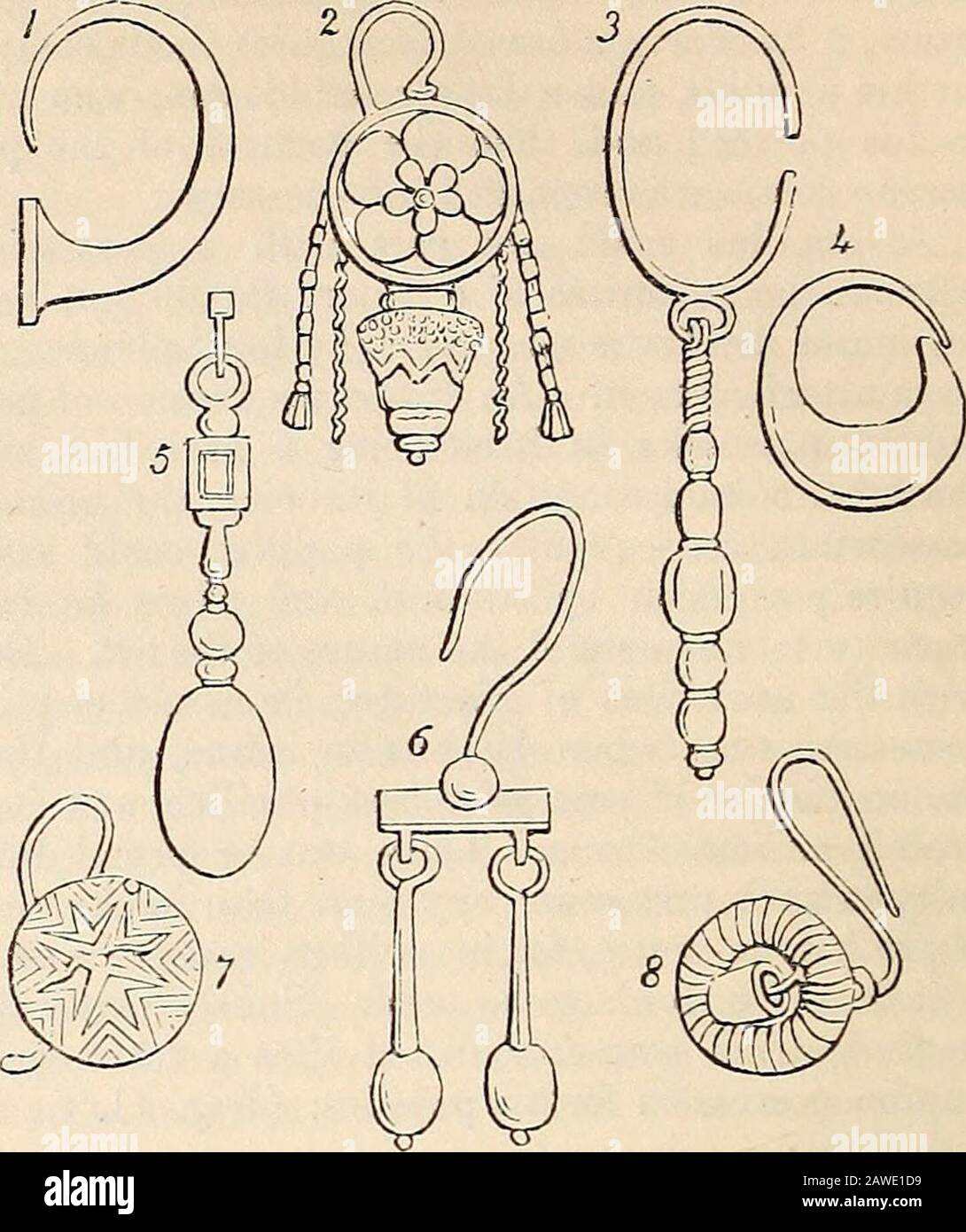 A dictionary of Greek and Roman antiquities.. . urpose.(Horn. II. xiv. 182, Hymn. ii. in Ven. 9 ; Plin.//. N. xii. 1.) Ear-rings were worn by both sexes in orientalcountries (Plin. H. N. xi. 50) ; especially by theLydians (Xen. Anab. iii. 1. § 31), the Persians(Diod. Sic. v. 45), the Babylonians (Juv. i. 104),and also by the Libyans (Macrob. Sat. vii. 3), andthe Carthaginians (Plaut. Poen. v. 2. 21). Amongthe Greeks and Romans they were worn only byfemales. This ornament consisted of the ring (k/hkos,Diod. Sic. I. c.) and of the drops {stalagmia, Fcstus,s. v. ; Plaut. Men. iii. 3. 18.) The rin Stock Photohttps://www.alamy.com/image-license-details/?v=1https://www.alamy.com/a-dictionary-of-greek-and-roman-antiquities-urposehorn-ii-xiv-182-hymn-ii-in-ven-9-plin-n-xii-1-ear-rings-were-worn-by-both-sexes-in-orientalcountries-plin-h-n-xi-50-especially-by-thelydians-xen-anab-iii-1-31-the-persiansdiod-sic-v-45-the-babylonians-juv-i-104and-also-by-the-libyans-macrob-sat-vii-3-andthe-carthaginians-plaut-poen-v-2-21-amongthe-greeks-and-romans-they-were-worn-only-byfemales-this-ornament-consisted-of-the-ring-khkosdiod-sic-i-c-and-of-the-drops-stalagmia-fcstuss-v-plaut-men-iii-3-18-the-rin-image342671877.html
A dictionary of Greek and Roman antiquities.. . urpose.(Horn. II. xiv. 182, Hymn. ii. in Ven. 9 ; Plin.//. N. xii. 1.) Ear-rings were worn by both sexes in orientalcountries (Plin. H. N. xi. 50) ; especially by theLydians (Xen. Anab. iii. 1. § 31), the Persians(Diod. Sic. v. 45), the Babylonians (Juv. i. 104),and also by the Libyans (Macrob. Sat. vii. 3), andthe Carthaginians (Plaut. Poen. v. 2. 21). Amongthe Greeks and Romans they were worn only byfemales. This ornament consisted of the ring (k/hkos,Diod. Sic. I. c.) and of the drops {stalagmia, Fcstus,s. v. ; Plaut. Men. iii. 3. 18.) The rin Stock Photohttps://www.alamy.com/image-license-details/?v=1https://www.alamy.com/a-dictionary-of-greek-and-roman-antiquities-urposehorn-ii-xiv-182-hymn-ii-in-ven-9-plin-n-xii-1-ear-rings-were-worn-by-both-sexes-in-orientalcountries-plin-h-n-xi-50-especially-by-thelydians-xen-anab-iii-1-31-the-persiansdiod-sic-v-45-the-babylonians-juv-i-104and-also-by-the-libyans-macrob-sat-vii-3-andthe-carthaginians-plaut-poen-v-2-21-amongthe-greeks-and-romans-they-were-worn-only-byfemales-this-ornament-consisted-of-the-ring-khkosdiod-sic-i-c-and-of-the-drops-stalagmia-fcstuss-v-plaut-men-iii-3-18-the-rin-image342671877.htmlRM2AWE1D9–A dictionary of Greek and Roman antiquities.. . urpose.(Horn. II. xiv. 182, Hymn. ii. in Ven. 9 ; Plin.//. N. xii. 1.) Ear-rings were worn by both sexes in orientalcountries (Plin. H. N. xi. 50) ; especially by theLydians (Xen. Anab. iii. 1. § 31), the Persians(Diod. Sic. v. 45), the Babylonians (Juv. i. 104),and also by the Libyans (Macrob. Sat. vii. 3), andthe Carthaginians (Plaut. Poen. v. 2. 21). Amongthe Greeks and Romans they were worn only byfemales. This ornament consisted of the ring (k/hkos,Diod. Sic. I. c.) and of the drops {stalagmia, Fcstus,s. v. ; Plaut. Men. iii. 3. 18.) The rin
![A dictionary of Greek and Roman antiquities.. . who saw him. (Lelyveld, De Infamia ex Jure Attico, Amstelod.1835 ; Wachsmuth, Hellen. Alterth. Sec. vol. ii. p.195, &c, 2d edit.; Meier, De Bonis Damnat. p.101, &c. ; Schbmann, De Comit. Ath. p. 67, &c.transl. ; Hermann, Polit. Ant. of Greece, § 124;Meier und Schomann, Att. Proc. p. 563. On theSpartan atimia in particular, see Wachsmuth, &c,vol. ii. p. 155, &c, 2d ed. ; Miiller, Dor. iii. 10.§ 3.) [L. S.] ATLANTES (SrWres) and TELAMONES(reafj.S>ves), are terms used in architecture, theformer by the Greeks, the latter by the Romans,to designat Stock Photo A dictionary of Greek and Roman antiquities.. . who saw him. (Lelyveld, De Infamia ex Jure Attico, Amstelod.1835 ; Wachsmuth, Hellen. Alterth. Sec. vol. ii. p.195, &c, 2d edit.; Meier, De Bonis Damnat. p.101, &c. ; Schbmann, De Comit. Ath. p. 67, &c.transl. ; Hermann, Polit. Ant. of Greece, § 124;Meier und Schomann, Att. Proc. p. 563. On theSpartan atimia in particular, see Wachsmuth, &c,vol. ii. p. 155, &c, 2d ed. ; Miiller, Dor. iii. 10.§ 3.) [L. S.] ATLANTES (SrWres) and TELAMONES(reafj.S>ves), are terms used in architecture, theformer by the Greeks, the latter by the Romans,to designat Stock Photo](https://c8.alamy.com/comp/2AM1WPE/a-dictionary-of-greek-and-roman-antiquities-who-saw-him-lelyveld-de-infamia-ex-jure-attico-amstelod1835-wachsmuth-hellen-alterth-sec-vol-ii-p195-c-2d-edit-meier-de-bonis-damnat-p101-c-schbmann-de-comit-ath-p-67-ctransl-hermann-polit-ant-of-greece-124meier-und-schomann-att-proc-p-563-on-thespartan-atimia-in-particular-see-wachsmuth-cvol-ii-p-155-c-2d-ed-miiller-dor-iii-10-3-l-s-atlantes-srwres-and-telamonesreafjsgtves-are-terms-used-in-architecture-theformer-by-the-greeks-the-latter-by-the-romansto-designat-2AM1WPE.jpg) A dictionary of Greek and Roman antiquities.. . who saw him. (Lelyveld, De Infamia ex Jure Attico, Amstelod.1835 ; Wachsmuth, Hellen. Alterth. Sec. vol. ii. p.195, &c, 2d edit.; Meier, De Bonis Damnat. p.101, &c. ; Schbmann, De Comit. Ath. p. 67, &c.transl. ; Hermann, Polit. Ant. of Greece, § 124;Meier und Schomann, Att. Proc. p. 563. On theSpartan atimia in particular, see Wachsmuth, &c,vol. ii. p. 155, &c, 2d ed. ; Miiller, Dor. iii. 10.§ 3.) [L. S.] ATLANTES (SrWres) and TELAMONES(reafj.S>ves), are terms used in architecture, theformer by the Greeks, the latter by the Romans,to designat Stock Photohttps://www.alamy.com/image-license-details/?v=1https://www.alamy.com/a-dictionary-of-greek-and-roman-antiquities-who-saw-him-lelyveld-de-infamia-ex-jure-attico-amstelod1835-wachsmuth-hellen-alterth-sec-vol-ii-p195-c-2d-edit-meier-de-bonis-damnat-p101-c-schbmann-de-comit-ath-p-67-ctransl-hermann-polit-ant-of-greece-124meier-und-schomann-att-proc-p-563-on-thespartan-atimia-in-particular-see-wachsmuth-cvol-ii-p-155-c-2d-ed-miiller-dor-iii-10-3-l-s-atlantes-srwres-and-telamonesreafjsgtves-are-terms-used-in-architecture-theformer-by-the-greeks-the-latter-by-the-romansto-designat-image339332294.html
A dictionary of Greek and Roman antiquities.. . who saw him. (Lelyveld, De Infamia ex Jure Attico, Amstelod.1835 ; Wachsmuth, Hellen. Alterth. Sec. vol. ii. p.195, &c, 2d edit.; Meier, De Bonis Damnat. p.101, &c. ; Schbmann, De Comit. Ath. p. 67, &c.transl. ; Hermann, Polit. Ant. of Greece, § 124;Meier und Schomann, Att. Proc. p. 563. On theSpartan atimia in particular, see Wachsmuth, &c,vol. ii. p. 155, &c, 2d ed. ; Miiller, Dor. iii. 10.§ 3.) [L. S.] ATLANTES (SrWres) and TELAMONES(reafj.S>ves), are terms used in architecture, theformer by the Greeks, the latter by the Romans,to designat Stock Photohttps://www.alamy.com/image-license-details/?v=1https://www.alamy.com/a-dictionary-of-greek-and-roman-antiquities-who-saw-him-lelyveld-de-infamia-ex-jure-attico-amstelod1835-wachsmuth-hellen-alterth-sec-vol-ii-p195-c-2d-edit-meier-de-bonis-damnat-p101-c-schbmann-de-comit-ath-p-67-ctransl-hermann-polit-ant-of-greece-124meier-und-schomann-att-proc-p-563-on-thespartan-atimia-in-particular-see-wachsmuth-cvol-ii-p-155-c-2d-ed-miiller-dor-iii-10-3-l-s-atlantes-srwres-and-telamonesreafjsgtves-are-terms-used-in-architecture-theformer-by-the-greeks-the-latter-by-the-romansto-designat-image339332294.htmlRM2AM1WPE–A dictionary of Greek and Roman antiquities.. . who saw him. (Lelyveld, De Infamia ex Jure Attico, Amstelod.1835 ; Wachsmuth, Hellen. Alterth. Sec. vol. ii. p.195, &c, 2d edit.; Meier, De Bonis Damnat. p.101, &c. ; Schbmann, De Comit. Ath. p. 67, &c.transl. ; Hermann, Polit. Ant. of Greece, § 124;Meier und Schomann, Att. Proc. p. 563. On theSpartan atimia in particular, see Wachsmuth, &c,vol. ii. p. 155, &c, 2d ed. ; Miiller, Dor. iii. 10.§ 3.) [L. S.] ATLANTES (SrWres) and TELAMONES(reafj.S>ves), are terms used in architecture, theformer by the Greeks, the latter by the Romans,to designat
![A dictionary of Greek and Roman antiquities.. . who saw him. (Lelyveld, De Infamia ex Jure Attico, Amstelod.1835 ; Wachsmuth, Hellen. Alterth. &c. vol. ii. p.195, &c, 2d edit.; Meier, De Bonis Damnat. p.101, &c. ; Schomann, De Comit. Ath. p. 67, &c.transl. ; Hermann, Polit. Ant. of Greece, § 124 ;Meier und Schomann, Att. Proc. p. 563. On theSpartan atimia in particular, see Wachsmuth, &c,vol. ii. p. 155, &c, 2d ed. ; Miiller, Dor. iii. 10.§ 3.) [L. S.] ATLANTES {arXavres) and TELAMONES(reActficSi/es), are terms used in architecture, theformer by the Greeks, the latter by the Romans,to designat Stock Photo A dictionary of Greek and Roman antiquities.. . who saw him. (Lelyveld, De Infamia ex Jure Attico, Amstelod.1835 ; Wachsmuth, Hellen. Alterth. &c. vol. ii. p.195, &c, 2d edit.; Meier, De Bonis Damnat. p.101, &c. ; Schomann, De Comit. Ath. p. 67, &c.transl. ; Hermann, Polit. Ant. of Greece, § 124 ;Meier und Schomann, Att. Proc. p. 563. On theSpartan atimia in particular, see Wachsmuth, &c,vol. ii. p. 155, &c, 2d ed. ; Miiller, Dor. iii. 10.§ 3.) [L. S.] ATLANTES {arXavres) and TELAMONES(reActficSi/es), are terms used in architecture, theformer by the Greeks, the latter by the Romans,to designat Stock Photo](https://c8.alamy.com/comp/2AWHCY3/a-dictionary-of-greek-and-roman-antiquities-who-saw-him-lelyveld-de-infamia-ex-jure-attico-amstelod1835-wachsmuth-hellen-alterth-c-vol-ii-p195-c-2d-edit-meier-de-bonis-damnat-p101-c-schomann-de-comit-ath-p-67-ctransl-hermann-polit-ant-of-greece-124-meier-und-schomann-att-proc-p-563-on-thespartan-atimia-in-particular-see-wachsmuth-cvol-ii-p-155-c-2d-ed-miiller-dor-iii-10-3-l-s-atlantes-arxavres-and-telamonesreactficsies-are-terms-used-in-architecture-theformer-by-the-greeks-the-latter-by-the-romansto-designat-2AWHCY3.jpg) A dictionary of Greek and Roman antiquities.. . who saw him. (Lelyveld, De Infamia ex Jure Attico, Amstelod.1835 ; Wachsmuth, Hellen. Alterth. &c. vol. ii. p.195, &c, 2d edit.; Meier, De Bonis Damnat. p.101, &c. ; Schomann, De Comit. Ath. p. 67, &c.transl. ; Hermann, Polit. Ant. of Greece, § 124 ;Meier und Schomann, Att. Proc. p. 563. On theSpartan atimia in particular, see Wachsmuth, &c,vol. ii. p. 155, &c, 2d ed. ; Miiller, Dor. iii. 10.§ 3.) [L. S.] ATLANTES {arXavres) and TELAMONES(reActficSi/es), are terms used in architecture, theformer by the Greeks, the latter by the Romans,to designat Stock Photohttps://www.alamy.com/image-license-details/?v=1https://www.alamy.com/a-dictionary-of-greek-and-roman-antiquities-who-saw-him-lelyveld-de-infamia-ex-jure-attico-amstelod1835-wachsmuth-hellen-alterth-c-vol-ii-p195-c-2d-edit-meier-de-bonis-damnat-p101-c-schomann-de-comit-ath-p-67-ctransl-hermann-polit-ant-of-greece-124-meier-und-schomann-att-proc-p-563-on-thespartan-atimia-in-particular-see-wachsmuth-cvol-ii-p-155-c-2d-ed-miiller-dor-iii-10-3-l-s-atlantes-arxavres-and-telamonesreactficsies-are-terms-used-in-architecture-theformer-by-the-greeks-the-latter-by-the-romansto-designat-image342746743.html
A dictionary of Greek and Roman antiquities.. . who saw him. (Lelyveld, De Infamia ex Jure Attico, Amstelod.1835 ; Wachsmuth, Hellen. Alterth. &c. vol. ii. p.195, &c, 2d edit.; Meier, De Bonis Damnat. p.101, &c. ; Schomann, De Comit. Ath. p. 67, &c.transl. ; Hermann, Polit. Ant. of Greece, § 124 ;Meier und Schomann, Att. Proc. p. 563. On theSpartan atimia in particular, see Wachsmuth, &c,vol. ii. p. 155, &c, 2d ed. ; Miiller, Dor. iii. 10.§ 3.) [L. S.] ATLANTES {arXavres) and TELAMONES(reActficSi/es), are terms used in architecture, theformer by the Greeks, the latter by the Romans,to designat Stock Photohttps://www.alamy.com/image-license-details/?v=1https://www.alamy.com/a-dictionary-of-greek-and-roman-antiquities-who-saw-him-lelyveld-de-infamia-ex-jure-attico-amstelod1835-wachsmuth-hellen-alterth-c-vol-ii-p195-c-2d-edit-meier-de-bonis-damnat-p101-c-schomann-de-comit-ath-p-67-ctransl-hermann-polit-ant-of-greece-124-meier-und-schomann-att-proc-p-563-on-thespartan-atimia-in-particular-see-wachsmuth-cvol-ii-p-155-c-2d-ed-miiller-dor-iii-10-3-l-s-atlantes-arxavres-and-telamonesreactficsies-are-terms-used-in-architecture-theformer-by-the-greeks-the-latter-by-the-romansto-designat-image342746743.htmlRM2AWHCY3–A dictionary of Greek and Roman antiquities.. . who saw him. (Lelyveld, De Infamia ex Jure Attico, Amstelod.1835 ; Wachsmuth, Hellen. Alterth. &c. vol. ii. p.195, &c, 2d edit.; Meier, De Bonis Damnat. p.101, &c. ; Schomann, De Comit. Ath. p. 67, &c.transl. ; Hermann, Polit. Ant. of Greece, § 124 ;Meier und Schomann, Att. Proc. p. 563. On theSpartan atimia in particular, see Wachsmuth, &c,vol. ii. p. 155, &c, 2d ed. ; Miiller, Dor. iii. 10.§ 3.) [L. S.] ATLANTES {arXavres) and TELAMONES(reActficSi/es), are terms used in architecture, theformer by the Greeks, the latter by the Romans,to designat